Overview of Sardinia
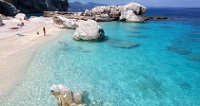
Photo credit: Roberto Cossu
The capital is Cagliari, a good base from which to explore other parts of the island. The National Archaeological Museum of Cagliari contains prehistoric tombs and other significant artefacts from the Punic and Roman periods. The resort of Costa Smeralda is a place of luxury and opulence, not suited to budget tourists but interesting for a brief stop.
The Spanish-flavoured port of Alghero is the favoured package destination, especially among British holidaymakers. The inland town of Nuoro is a good station from which to explore the Gennargentu mountain range and enjoy the traditional village festivals. The Sardinian landscape is peppered with constructions from the ancient Nuragic civilisation, the UNESCO-listed stone structures being unique to Sardinia and are must-see sites. However, they aren't easily accessible as they lie in isolated spots throughout the island.
Key Facts
- Language:
- The official language of Italy is Italian. English is understood in the larger cities but not in the more remote parts of the country.
- Passport/Visa:
The borderless region known as the Schengen Area includes the following countries: Austria, Belgium, Czech Republic, Denmark, Estonia, Finland, France, Germany, Greece, Hungary, Iceland, Italy, Latvia, Lithuania, Luxembourg, Malta, The Netherlands, Norway, Poland, Portugal, Slovakia, Slovenia, Spain, Sweden and Switzerland. All these countries issue a standard Schengen visa that has a multiple entry option, and which allows the holder to travel freely within the borders of all the aforementioned countries. All foreign passengers to Italy must also hold visible proof of financial means to support themselves while in the country, return or onward tickets, and the necessary travel documentation for their next destination. Visitors may be refused entry, either for public security, tranquillity, order or health reasons. Extensions of stay in Italy are possible by applying to local authorities. It is highly recommended that travellers' passport have at least six months' validity remaining after the intended date of departure from their travel destination. Immigration officials often apply different rules to those stated by travel agents and official sources.
- Currency:
The euro (EUR) is the official currency, which is divided into 100 cents. Those arriving in Italy with foreign currency can obtain euros through any bank, ATM or bureau de change. ATMs are widespread; credit cards are accepted in upmarket establishments and shops around the cities. Banks are closed on weekends but tend to have better rates than foreign exchange houses.
- Electricity:
- Electrical current in Italy is 230 volts, 50Hz. A variety of plugs are in use, including the European-style two-pin plug.
Travel Advisories
Travel to Sardinia
Climate for Sardinia
Sardinia has a typically Mediterranean climate, but the south is generally much drier than the northwestern region, which receives a lot of rain in winter. The wettest months are November and December, while July and August are the hottest and the driest, with an average temperature of around 95F (35C), sometimes reaching 104F (40C). In winter, temperatures average about 50F (10C) along the coast. Spring and early autumn are the best times to visit Sardinia.
Health Notes when travelling to Italy
There are no specific health risks associated with travel to Italy and visitors should be able to travel without special vaccinations and medications. Medical facilities in Italy are good but travel insurance is still recommended for non-EU citizens, as medical attention can be expensive. EU citizens can make use of Italy's health services provided they have a European Health Insurance Card (EHIC), with UK citizens using their Global Health Insurance Card (GHIC). The GHIC replaced the EHIC for UK citizens and allows UK citizens access to state healthcare during visits to the EU. The GHIC is not valid in Norway, Iceland, Liechtenstein or Switzerland, nor is it an alternative to travel insurance. Although it should be possible to get most medication in Italy, travel authorities always suggest taking any prescribed medication in its original packaging with a signed and dated letter from a doctor.
Safety Notes when travelling to Italy
Tourists are vulnerable to pickpocketing in the bigger cities, particularly on public transport, in crowded areas and around tourist sites. It's advisable to be careful when carrying large amounts of cash and valuables. Travellers should be particularly careful around Termini, which is the main train station in Rome. Visitors should be wary of groups of children, some of whom will distract attention while the others try to steal what they can. Strikes by transport workers take place regularly throughout Italy and delays are possible.
Customs in Italy
In Italy, it's an offence to sit on steps and in courtyards near public buildings, including the main churches in Florence; eating and drinking in the vicinity should also be avoided. Shorts, vests or any other immodest clothing should not be worn inside churches.
Duty Free in Italy
Travellers over 17 years from non-EU countries do not have to pay duty on 200 cigarettes, 50 cigars or 250g of tobacco. Nor do they have to pay duty on 4 litres of wine, 16 lires of beer or 1 litre of spirits over 22 percent volume, or 2 litres of alcoholic beverages less than 22 percent volume. Other goods up to the value of €430 are also permitted (reduced to €175 for children under 15).
Travellers from EU countries travelling within the EU are limited to 110 litres of beer, 90 litres of wine, 10 litres of fortified wine, 10 litres of spirits and 1kg of tobacco, 800 cigarettes, 200 cigars or 400 cigarellos. Prohibited items include narcotic drugs, medicinal products, arms and weapons, explosives and protected animal and plant species.
Doing Business in Italy
Italians can be very formal and old fashioned, but are also warm and welcoming. Face to face communication is best and often a third party introduction can speed initial negotiations. Business attire is formal and stylish, and handshakes are the norm, with first impressions counting a lot in Italy. Business cards are used. Visiting business people should also expect plenty of gesticulating, interruptions or people talking over each other. Unfortunately the bureaucracy in Italy can slow down deal-making. Business hours are usually 9am to 5pm Monday to Friday, but can vary according to season and region.
Communication in Italy
The international access code for Italy is +39. Hotels, cafes and restaurants offering free WiFi are widely available; as international roaming costs can be high, purchasing a local prepaid SIM card can be a cheaper option.
Tipping in Italy
Tipping is customary in Italy and 10 to 15 percent of the bill is acceptable in restaurants, unless a 15 percent service charge has already been added to the bill. Hotels add a service charge of 15 to 18 percent, but it is customary to tip the service staff extra. Italians rarely tip taxi drivers but a 5 to 10 percent tip is always appreciated.
Passport/Visa Note
The borderless region known as the Schengen Area includes the following countries: Austria, Belgium, Czech Republic, Denmark, Estonia, Finland, France, Germany, Greece, Hungary, Iceland, Italy, Latvia, Lithuania, Luxembourg, Malta, The Netherlands, Norway, Poland, Portugal, Slovakia, Slovenia, Spain, Sweden and Switzerland. All these countries issue a standard Schengen visa that has a multiple entry option, and which allows the holder to travel freely within the borders of all the aforementioned countries. All foreign passengers to Italy must also hold visible proof of financial means to support themselves while in the country, return or onward tickets, and the necessary travel documentation for their next destination. Visitors may be refused entry, either for public security, tranquillity, order or health reasons. Extensions of stay in Italy are possible by applying to local authorities. It is highly recommended that travellers' passport have at least six months' validity remaining after the intended date of departure from their travel destination. Immigration officials often apply different rules to those stated by travel agents and official sources.
Entry Requirements
- Entry requirements for Americans:
US citizens must have a passport that is valid for at least three months beyond their intended stay in Italy. No visa is required for stays of up to 90 days within a 180 day period.
- Entry requirements for Canadians:
Canadian citizens must have a passport that is valid for at least three months beyond their intended stay in Italy. No visa is required for stays of up to 90 days within a 180 day period.
- Entry requirements for UK nationals:
UK citizens must have a passport that is valid for at least three months beyond their intended stay in Italy. No visa is required for stays of up to 90 days within a 180 day period.
- Entry requirements for Australians:
Australian citizens must have a passport that is valid for three months beyond their intended stay in Italy. No visa is required for stays of up to 90 days within a 180 day period.
- Entry requirements for Irish nationals:
Irish citizens must have a passport that is valid upon their arrival in Italy. No visa is required.
- Entry requirements for New Zealanders:
New Zealand citizens must have a passports valid for three months beyond period of intended stay in Italy. No visa is required for stays of up to 90 days within a 180 day period.
- Entry requirements for South Africans:
South African citizens must have a passport that is valid for three months beyond their intended stay, and a valid Schengen visa, to enter Italy.
Travel Advisories
Attractions in Sardinia, Italy
The second largest island in the Mediterranean sea, Sardinia is mainly touted for its lovely beaches and hiking trails and draws windsurfers and boaters to its shores in droves. The coastal regions can get very busy in the summer, especially August. Apart from the wonderful landscapes and outdoor activities, Sardinia offers the remnants of mysterious ancient settlements: the ancient Nuragic civilisation of Sardinia, which predates the mainland Etruscan civilisation by several centuries, left stone monuments dotting the island.
La Maddalena Archipelago National Park (Parco Nazionale dell'Arcipelago di La Maddalena) is an almost uninhabited group of islands in a protected marine area, attracting visitors with its natural splendour and pristine beaches. Other gorgeous beaches in Sardinia include Cala Mariolu and Cala Goloritze in Baunei, which are regularly lauded as the most beautiful beaches in Italy, and are a must for sun-seekers looking for the perfect Mediterranean setting. Costa Smeralda boasts the most glamorous beaches in Sardinia and attracts the jet-set with its luxurious villas and upmarket resorts. The city of Alghero, on the northwest coast, is also a tourist hub and has some great beaches.
Those interested in the ancient Nuragic inhabitants of Sardinia can explore the thousands of fortified circular structures still remaining on the island. The complex of Nuraghe in Barumini has been added to UNESCO's World Heritage List and is the finest and most complete example of this intriguing prehistoric architecture. Another interesting cultural diversion is provided by the home of Garibaldi, one of Italy's great revolutionary leaders, which has been turned into a museum. Cagliari, the capital of Sardinia, has some cultural treasures, most notably in the Citadel of Museums complex, which includes the National Archaeological Museum.
Cagliari
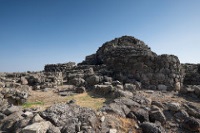
Photo credit: Michal Kosacky
The suburb of Poetto has a four mile (6km) stretch of sandy beach with some small bars nearby. The famous archaeological site of Su Nuraxi near Barumini is also within easy reach of the town.
Sardinia's history and culture are found in the Citadel of Museums complex: the Archaeological Museum houses artefacts from all the ancient cultures of the island, such as ceramics from Phoenician tombs, Punic jewellery and Nuragic bronzes; the Picture Gallery boasts contemporary art and sculpture; the Siamese Museum exhibits fascinating items from the East; and the university houses sculptures by wax artist Clemente Susini.
Nuraghe
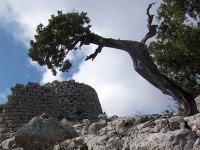
Photo credit: Roberto Cossu
Trenino Verde
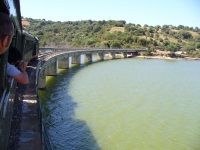
Photo credit: jeffwarder
Neptune's Grotto (Grotta di Nettuno)
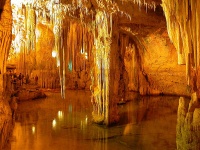
Photo credit: Tobias Helfrich
Garibaldi's House
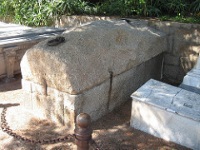
Photo credit: Daniel
Website: http://www.compendiogaribaldino.it
Costa Smeralda
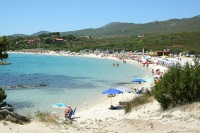
Photo credit: Evgeny Zhukov
Another favourite retreat for celebrities is the town of Porto Rotondo, which offers a wealth of beaches, nightclubs and restaurants, most clustered around its Piazza San Marco and the marina. The main attractions are the many sequestered beaches, among the most scenic being Cappriccioli, Rena Bianca and Liscia Ruja.
Alghero
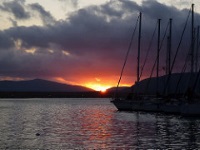
Photo credit: Ivonne
The narrow cobbled streets are lined with ornate churches, wrought-iron balconies and a number of boutiques and cafes, as well as the workshops of craftsmen working the famed coral of Alghero. The local cuisine has a taste of Spain, with Alghero renowned for its authentic Spanish paella, lobster Catalan and tasty fish soups, along with delicious sea urchin and aromatic wines.
The coast offers many secluded bays, small inlets bordered by pine forests and high, jagged cliffs. Nightlife is sedate, tending more toward sipping cocktails at a sidewalk cafe and watching the sunset.
Events in Sardinia, Italy
Nightlife in Sardinia, Italy
Shopping in Sardinia, Italy
Dining in Sardinia, Italy
Airports in Sardinia
Olbia Airport (OLB)
Olbia Costa Smeralda Airport
http://www.olbia-airport.com
Location: Sardinia The airport is located 2 miles (about 3km) southeast of the city of Olbia.
Time: Local time is GMT +1 (GMT +2 between the last Sunday in March and the Saturday before the last Sunday in September).
Contacts: Tel: +39 0789 563 400
Getting to the city: Public bus lines 2 and 10 connect Olbia airport to the city. The journey takes 10-20 minutes.
Car rental: Car rental companies include Auto Europa, Avis, Budget, Ellepì Autonoleggio, Europcar, Hertz, Maggiore Rent and Sixt.
Airport Taxis: Taxis are available outside the arrivals area. It should take about 10-15 minutes to reach the city.
Facilities: Facilities include ATMs, bureaux de change, snack shops, Internet access, and luggage storage.
Parking: Short- and long-term parking is available.
Currency
The euro (EUR) is the official currency, which is divided into 100 cents. Those arriving in Italy with foreign currency can obtain euros through any bank, ATM or bureau de change. ATMs are widespread; credit cards are accepted in upmarket establishments and shops around the cities. Banks are closed on weekends but tend to have better rates than foreign exchange houses.
| Exchange rate for 1 EUR - Euro | |||||
|---|---|---|---|---|---|
|
0.00 BMD Bermudan Dollar |
1.07 USD U.S. Dollar |
0.86 GBP U.K. Pound Sterling |
164.39 JPY Japanese Yen |
1.47 CAD Canadian Dollar |
0.97 CHF Swiss Franc |
|
1.63 AUD Australian Dollar |
42.33 UAH Ukrainian Hryvnia |
476.99 KZT Kazakhstani Tenge |
100,010.53 LBP Lebanese Pound |
5.22 LYD Libyan Dinar |
7.37 BOB Bolivian Boliviano |
|
0.00 NPR Nepalese Rupee |
0.00 OMR Omani Rial |
0.00 QAR Qatari Rial |
1.45 SGD Singapore Dollar |
11.63 SEK Swedish Krona |
0.00 TTD Trinidad Tobago Dollar |
|
0.00 VEF Venezuelan Bolivar |
62.44 DOP Dominican Peso |
0.00 HRK Croatian Kuna |
18.22 MXN Mexican Peso |
656.03 XOF West African CFA Franc |
0.00 PGK Papua New Guinean kina |
|
0.00 BSD Bahamian Dollar |
0.00 FJD Fiji Dollar |
0.00 HNL Honduran Lempira |
143.84 DZD Algerian Dinar |
0.00 MMK Myanma Kyat |
0.00 BWP Botswana Pula |
|
4.00 PEN Peruvian Nuevo Sol |
1,008.37 CLP Chilean Peso |
415.67 AMD Armenia Dram |
25.03 CZK Czech Koruna |
18.94 MDL Moldova Lei |
150.32 ISK Icelandic Krona |
|
13,519.98 UZS Uzbekistan Sum |
4.00 ILS Israeli New Sheqel |
0.76 JOD Jordanian Dinar |
0.00 KWD Kuwaiti Dinar |
41.00 UYU Uruguayan Peso |
0.00 MUR Mauritian Rupee |
|
0.00 NIO Nicaraguan Córdoba |
11.69 NOK Norwegian Krone |
4.33 PLN Polish Zloty |
4.03 SAR Saudi Riyal |
0.00 LKR Sri Lanka Rupee |
39.53 THB Thai Baht |
|
3.94 AED U.A.E Dirham |
5.47 BRL Brazilian Real |
4.98 RON Romanian New Leu |
8.40 HKD Hong Kong Dollar |
656.03 XAF Central African CFA Franc |
27,298.82 VND Vietnamese Dong |
|
943.81 ARS Argentine Peso |
0.00 XCD East Caribbean Dollar |
0.00 GTQ Guatemalan Quetzal |
10.81 MAD Moroccan Dirham |
0.00 BHD Bahrain Dinar |
1.07 PAB Panamanian Balboa |
|
1.83 AZN Azerbaijan Manat |
4,212.10 COP Colombian Peso |
95.01 KGS Kyrgyzstan Som |
388.98 HUF Hungarian Forint |
11.70 TJS Tajikistan Ruble |
17,271.44 IDR Indonesian Rupiah |
|
51.52 EGP Egyptian Pound |
1,460.09 KRW South Korean Won |
8,012.15 PYG Paraguayan Guaraní |
5.09 MYR Malaysian Ringgit |
546.19 CRC Costa Rican Colón |
1.79 NZD New Zealand Dollar |
|
298.58 PKR Pakistani Rupee |
98.20 RUB Russian Rouble |
19.89 ZAR South African Rand |
3.37 TND Tunisian Dinar |
0.00 BBD Barbadian Dollar |
1.96 BGN Bulgarian Lev |
|
34.74 TRY Turkish Lira |
61.55 PHP Philippine Peso |
34.72 TWD New Taiwan Dollar |
1,251.64 NGN Nigerian Naira |
0.00 XPF CFP Franc |
0.00 GHS Ghanaian Cedi |
|
0.00 JMD Jamaican Dollar |
0.00 ANG Neth. Antillean Guilder |
0.00 BND Brunei Dollar |
117.02 RSD Serbian Dinar |
7.78 CNY Chinese Yuan |
7.46 DKK Danish Krone |
|
3.75 TMT New Turkmenistan Manat |
89.63 INR Indian Rupee |
||||
U.S. Dollar to Euro
1 USD = 0.93 EUR
Canadian Dollar to Euro
1 CAD = 0.68 EUR
U.K. Pound Sterling to Euro
1 GBP = 1.17 EUR
Australian Dollar to Euro
1 AUD = 0.61 EUR
New Zealand Dollar to Euro
1 NZD = 0.56 EUR
South African Rand to Euro
1 ZAR = 0.05 EUR
Kitzbuhel
Overview
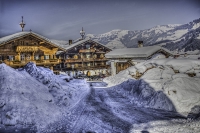
Photo credit: Valerii Tkachenko
Shopping in Kitzbuhel
Kitzbuhel is a shopper's paradise, with dozens of upmarket shops displaying their appealing wares in the quaint Tyrolean village stores. Ski shops dominate, but there are plenty of designer boutiques, jewellery stores, and souvenir shops in Kitzbuhel too. Prices are steep but discounts are sometimes offered to those carrying guest cards from Kitzbuhel hotels. Visitors can also enquire at their hotels about shopping excursions into Italy.
Dining in Kitzbuhel
Kitzbuhel has a wide choice of excellent restaurants, both on the ski slopes and in the town. Some of the best restaurants include the Neuwirt in the Schwarzer Adler, the Tenne Restaurant in Hotel Zur and with its young and international crowd and fantastic Italian food. For those on more of a budget, the Centro Cafe Bar Restaurant in the town centre is popular.
Activities in Kitzbuhel
Kitzbuhel is a lively ski resort with plenty of bars and nightclubs to suit all pockets and preferences. For many Brits and locals alike, the evening begins early at the Londoner: the famous apres-ski bar renowned for its lethal cocktails. Take Five is a nightclub in the town square that stays open until dawn. Visitors wishing to try their luck on the tables will find the Casino Kitzbuhel at the Hotel Goldener Greif. New Year is a great time for a skiing trip to Kitzbuhel with one of the best fireworks displays in the Alps. Nightlife in Kitzbuhel goes on very late, often not getting busy until nearly 2am.
Things to be aware of in Kitzbuhel
With its sprawling layout and fragmented ski-area, Kitzbuhel is not an ideal choice for families. The low altitude means that the lower slopes get slushy in warmer weather.
Skiing in Kitzbuhel
Kitzbuhel hosts The Hahnenkahm, one of the most treacherous and famous of all of the downhill ski races, and the publicity has made it one of the world's most famous ski resorts. The Kitzbuhel ski pass includes the neighbouring but lesser known holiday resorts of Kirchberg, Aurach, Jochberg, and Pass Thurn, and offers one of the largest and most diverse ski areas in the Alps, with almost 100 miles (161km) of groomed slopes, a large cross-country ski area, and plenty of off-piste. Kitzbuhel's problem is snow reliability, as the holiday resort is under 800m and the highest skiing is at 2,000m, so skiing to a chalet or hotel door is rarely possible and the season is short. The resort attracts a large number of tourists from nearby countries, as well as throngs of holiday skiers and ski bums from the UK and Australia.
Sa Coma
Overview
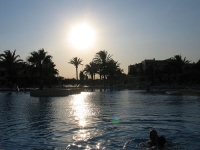
Photo credit: cgt
Shopping in Sa Coma
Self-catering holidaymakers will find a good selection of food at the Caprabo hypermarket on the Avinguda de les Palmeres in Sa Coma. The resort and its neighbours have numerous shops and boutiques selling souvenirs and goods attractive to tourists. For a traditional market take the bus to the nearby town of Son Servera on Friday mornings, or to Manacor on Monday mornings.
Dining in Sa Coma
Sa Coma offers a varied selection of good quality restaurants for holidaying visitors to enjoy, and just across the footbridge on the S'Illot seafront even more options are available. Hearty British food is the popular staple served at JJs. BiBaBo café and music bar on the S'Illot front mixes the best of British with some Spanish dishes for families wanting the best of both worlds. The top restaurant in town for Spanish and local cuisine is Lago, but this is expensive. A good alternative is the tapas bar next door, or Es Cuerot, which has excellent traditional food and a cellar or terrace venue to choose from. The frito mallorquin, lamb and vegetable stir-fry, is a speciality here.
Activities in Sa Coma
Being a family holiday resort, the nightlife in Sa Coma is not wild, entertainment being mainly hotel based. Neighbouring Cala Millor offers a more lively after-dark scene for those interested. One of the most popular evening spots nearby is Crazy Monkey, a relaxed Spanish-style cocktail bar, in S'Illot, where 'happy hour' lasts from 8pm to 11pm and then again from midnight to 2am. Other popular spots include Chaplins and La Havana.
Things to be aware of in Sa Coma
Sa Coma is not a good choice for holidaymakers who are seeking bright lights and hectic nightlife, nor for those who find concentrations of children annoying. The beach can become rather crowded in the height of summer.
Ixia
Overview
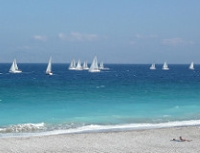
Photo credit: Paul Stephenson
Shopping in Ixia
Visitors will find groceries and souvenirs in Ixia. Those who travel the short distance to markets in Rhodes or range further to traditional villages will find a more authentically Greek shopping experience.
Dining in Ixia
Ixia has loads of bars, cafes and restaurants, with menus ranging from traditional Greek meals, to pizza or Chinese food.
Activities in Ixia
Rhodes Town and Faliraki have vibrant club scenes and are close to Ixia.
Things to be aware of in Ixia
Ixia is dominated by foreign visitors and is tailored to their needs. Its 'touristy' character has advantages but some travellers may feel the area lacks authentic Greek spirit and has been over-commercialised.
Rethymnon
Overview
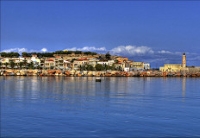
Photo credit: Romtomtom
Shopping in Rethymnon
Rethymnon's many gift shops have a beautiful selection of baskets, woodcarvings, pottery and woven goods. Cretan embroidery at Haroula Spridaki and various items carved from olive wood at the aptly named Olive Wood Corner make especially good souvenirs.
Palaiopoleiou has genuine antiques and old textiles, while shoppers interested in modern ceramics and Greek pottery should try Omodamos. Many general stores and mini supermarkets are around to service self-caterers.
Dining in Rethymnon
Rethymnon's inner harbour sports an array of restaurants and fish tavernas; pricing varies. Visitors will find some old-fashioned cafes around Rimondi Fountain.
Activities in Rethymnon
Rethymnon's nightlife ranges from noisy pubs and bars to more relaxed establishments, where holidaymakers can listen to the sea while sipping on their favourite drinks.
Things to be aware of in Rethymnon
Rethymnon doesn't have the ruins and archaeological sites many holidaymakers expect in such an old city.
Santa Ponsa
Overview
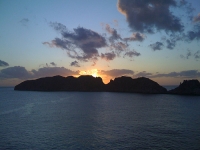
Photo credit: macgerry
Shopping in Santa Ponsa
Santa Ponsa has a number of supermarkets (including one large one), a good choice of souvenir shops, stalls, some designer goods, jewellery stores and other essential amenities such as banks for holiday visitors to make use of. A better shopping selection is available in Palma and the closest weekly market takes place on Wednesdays in Andratx.
Dining in Santa Ponsa
There are a large number of different restaurants in Santa Ponsa, offering visitors plenty of variety and options for all budgets. Some restaurants and tapas bars offer traditional Spanish cuisine, and there is Indian, Chinese, Italian and more to sample. International staples such as burgers and pizzas are always easy to find.
Activities in Santa Ponsa
There is a varied nightlife at the holiday resort of Santa Ponsa, with karaoke bars, theme pubs, live music venues, and several clubs and discos. Although not on the same scale as Palma or Magaluf, there is still a lot on offer besides hotel entertainment. Those intent on partying can always make the short trip to Palma, which boasts the best nightlife on the island.
Things to be aware of in Santa Ponsa
The beaches can get very crowded in season and parking can be hard to come by. This is not the place to come for peace and quiet.
Mojacar
Overview
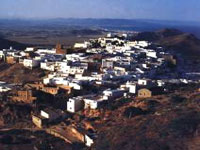
Photo credit:
Shopping in Mojacar
The Commercial Centre is a large mall complex in the centre of town with every modern convenience. Adventurous and inquisitive tourists prepared to wander through the small alleyways of Mojacar will be richly rewarded. Many of the narrow streets have hidden treasures for dedicated shoppers, including small boutiques as well as a variety of holiday souvenir shops.
Dining in Mojacar
Mojacar's restaurant scene consists of a varied selection of international eateries that complement its excellent Spanish tapas bars and local seafood restaurants. Restaurante El Antler in Calle Enmedio has been getting great reviews for over 25 years. Children are always welcome in Mojacar restaurants. Famous local dishes include caldo de pescado (fish stew) and pelotas (meatballs wrapped in dark green cabbage leaves). Visit the nearby town of Garuccho to sample their locally caught red shrimp.
Activities in Mojacar
The area on Mojacar beach known as the Brit Strip has numerous pubs and British themed eateries. The best selection of Mojacar bars can be found along the sea front, which is lined with good beach bars, offering happy hours, free tapas and splendid beach views. The larger hotels have lively bars and are worth visiting on weekends for those seeking a big night out.
Things to be aware of in Mojacar
This is a laid-back resort town with limited entertainment options for those wanting to spend their holiday in the town itself. The old town is accessible only by steep and narrow roads and is therefore unsuitable for people with mobility issues.
Serre-Chevalier
Overview
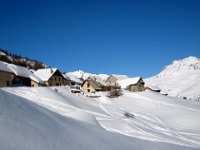
Photo credit: Frederique Voisin-Demery
Shopping in Serre-Chevalier
There isn't much in the way of shopping in Serre-Chevalier other than the usual tourist shops and ski equipment stores. There are supermarkets and basic amenities like a post office, bureau de change and ATMs available.
Dining in Serre-Chevalier
There are roughly 100 restaurants to choose from in Serre-Chevalier, ranging from fine dining to pizza and burgers.
Activities in Serre-Chevalier
Serre-Chevalier has a relaxed and low-key nightlife, with a number of bars and one or two discos in Villeneuve and Chantemerle. Like many ski resorts, there is a much livelier atmosphere in the winter ski season.
Things to be aware of in Serre-Chevalier
Despite its size, Serre-Chevalier has a relatively quiet nightlife, so those looking for a wild party may be disappointed.
Skiing in Serre-Chevalier
Serre-Chevalier is a very large resort, with more than 155 miles (250km) of connected pistes. There are a number of runs that will suit all levels of experience, with 23 green, 30 blue, 43 red and 15 black runs. There are an additional 28 miles (45km) of cross country trails. There is also a snowboard park in Monètier.
Kusadasi
Overview
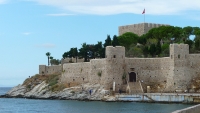
Photo credit: Neil Thompson
Shopping in Kusadasi
The Grand Bazaar in Kusadasi, near the harbour, is one of Turkey's largest shopping treasure troves for holidaymakers to rummage through, crammed with 1,000 or more stores and stalls open seven days a week from 9am until midnight. Bargaining for a variety of attractive items, such as leather jackets, sandals, carpets, and hand-made jewellery, is a fun experience, usually accompanied by a glass of tea. Despite the traditional trading atmosphere, most merchants accept credit cards, travellers cheques, and even some foreign currency for purchases. Visitors should be prepared to bargain their way to a good price, however.
Dining in Kusadasi
All holidaymakers' budgets and tastes are amply catered for among Kusadasi's dozens of restaurants, cafes, and lokantas (local bars). Most visitors opt for sampling Turkish cuisine or enjoying the sumptuous seafood on offer, but there are numerous alternatives, which range from curry and Chinese to burgers. For top-class Turkish specialities, the Konyali Restaurant, opposite the marina, and the Erzincan, near the post office, are hard to beat, while the Avlu Restaurant and Cafe is also decent and well-priced. Kalyon is popular with expats for their western menu, which includes full English breakfasts.
Activities in Kusadasi
Nights in Kusadasi throb with action, particularly along the town's pulsating Bar Street in the old town centre, lined with pubs and clubs. One of the hottest spots is the huge open air club, Ecstasy Bar, featuring top European DJs. Jimmy's Irish Bar at the start of Bar Street is a favourite gathering place for young British holidaymakers. Those looking for something more sedate will find cabaret bars, Turkish folk taverns, or cosy jazz clubs tucked away.
Things to be aware of in Kusadasi
Kusadasi's beaches become extremely crowded during the height of the summer season. Touts outside restaurants and bars can be annoying.
Hurghada
Overview
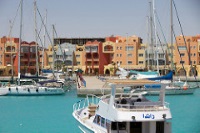
Photo credit: Konstantin Zamkov
South of the town is the resort strip with hotels packed along a 12-mile (20km) stretch of beach, while within the town there are many bars, restaurants, shops and a variety of accommodation to suit all types of budget. The town's central location on Egypt's coast provides a gateway to prime diving sites throughout the Red Sea.
Shopping in Hurghada
El Dahar, the old part of Hurghada town, has a traditional Egyptian bazaar with a variety of shops selling tourist souvenirs and holidaymakers can splurge to their hearts' content. Bargaining is expected and prices will generally be better than in the resort village shops. The best buys are papyrus scrolls or traditional 'shisha pipes'.
Dining in Hurghada
Hurghada has a variety of restaurants for those on holiday to enjoy, serving food from around the world including Indian, French, Thai, Mexican and Japanese. El Dahar (downtown) offers a wide choice of authentic Egyptian eateries, including street stalls and inexpensive restaurants. Fast food chains such as KFC, Pizza Hut and McDonalds are also available. Most local places don't serve alcohol. Hotels all have their own restaurants, which serve up a variety of local and international cuisine.
Activities in Hurghada
With its growing reputation as a holiday party town 'par excellence', Hurghada hosts a lively nightlife with numerous clubs, discos, pubs and trendy lounges, and a variety of entertainment that includes beach barbeques, karaoke evenings and foam parties. Popular places include Papas Beach Club and Calypso, while Alf Leila Wa Leila is famous for belly dancing and Arabic folklore.
Things to be aware of in Hurghada
The beach in Hurghada is made of dark red grainy sand interspersed with rocks and boulders; sandals should be worn. Although the resort is considered safe there are areas of the Sinai region that have become dangerous for foreigners, so visitors are advised to be careful on excursions into the desert.
Cala d'Or
Overview
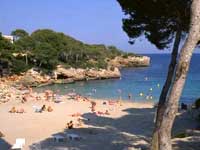
Photo credit: Spanish Tourist Board
There are numerous adjacent smaller resorts and quaint villages clustered around the calasall along the southeast coastline, connected by a good bus service, which means visitors can make excursions to explore the delights of places like Cala Egos, Puerto Petro, Cala Mondrago, Cala Figuera, Cala Santanyi and Cala Llombarts. The Cala d'Or marina is the heart of the east coast resort area, attracting the fashionable yachting set.
Shopping in Cala d'Or
Cala d'Or is known as the best shopping district on Mallorca; its main shopping street, Avinguda Tagomago, is filled with chic boutiques, leather shops and galleries that appeal to locals and holidaymakers alike. Designer clothes and shoes, in particular, are available at reasonable prices. Souvenir shopping is fun with a wide variety of local crafts, traditional pottery and glass, and olive wood carvings available at several stores, and at the Sunday morning flea market in Felanitx. Visitors can also find bargains in designer sunglasses, jewellery and perfume. Those in self-catering apartments who need sustenance will find all they require at the resort's biggest supermarket, Caprabo, near the resort entrance. The supermarket opens until 9pm every night (except Sundays, when it closes at 2pm).
Dining in Cala d'Or
Cala d'Or's upmarket restaurants are mostly situated around the marina, which is usually abuzz with a lively international crowd enjoying a variety of cuisines. The centre of town offers fast food outlets, tapas bars, pizza parlours, burger joints and several British pub 'n grub type establishments. Eateries that come highly recommended in Cala d'Or include Acuarius, Shangrila, Restaurante Vicente and Casablanca.
Activities in Cala d'Or
Nightlife in Cala d'Or is tasteful and stylish, rather than frenetic, centred around the many cocktail bars and discos. Don Ron Heroes Bar is one of the places to go for a good night out in Cala d'Or. The latest music rocks Linekers, and the most popular nightclubs in town are Disco Alfa and Farrahs Planet Ibiza. Hollywoods is the local karaoke bar, while the Dirty Duck pub is known as the gay-friendly establishment.
Things to be aware of in Cala d'Or
Cala d'Or is definitely a family-oriented holiday resort, not really catering for the 18 to 30 single set, particularly those who enjoy a wild nightlife. The music bars and discos are usually quiet by 2am. The main resort beaches can become enormously crowded, particularly during July and August, and holiday-makers have to be up and about early if they hope to secure a sunbed for the day.
Overview
Klosters
Overview
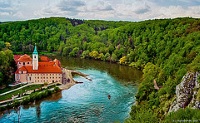
Photo credit: Heribert Pohl > 3 million
Klosters, its two pretty neighbourhoods filled with picturesque chalets, also has its own ski area, the Madrisa, ensuring the resort offers skiing for all abilities in a discreetly charming Alpine setting, away from the madding crowd of the tourist mass market. Exclusivity is expensive, however, and Klosters has become known as the holiday haunt of the rich and famous, and is particularly favoured by the British Royal family as a winter sports getaway with first-class off-piste skiing.
Shopping in Klosters
Klosters is permeated with small speciality stores, with sports outlets predominating, though there are also some boutiques and art galleries. Those who want to become really involved in a shopping expedition prefer to take the short trip to neighbouring Davos, which has more than 100 stores, art galleries and boutiques selling all manner of goods from souvenir cow bells to designer clothing. The shops in Davos are centred along the two main streets around the Davos Platz.
Dining in Klosters
For its size the little village of Klosters has an abundance of restaurants, both on and off the slopes. The atmospheric Chesa Grischuna has been an institution in the town since 1938, its history as enthralling as the quality of its cuisine. Another dining treat is the Walserhof Hotel's Michelin-starred restaurant, where famed Swiss chef Beat Bolliger conjures up imaginative delights using mainly local produce. Other excellent hotel restaurants open to non-residents in Klosters are The Alpina and Alte Post. Booking is essential at most restaurants, and vistors should expect to pay a high price at the best places. For delicious pizzas, travellers should try Al Berto. Klosters is also famed for its wonderful mountain restaurants, known as Schwendis, which are rustic timber Alpine huts, most with terraces to take advantage of sunny days.
Activities in Klosters
Apres-ski on a Klosters holiday is merry but low-key. As the skiers and snowboarders come down from the slopes they gather at the Schwendis (mountain chalet bars) or a few favourite spots such as Gaudi's for a warming glass of beer or schnapps. Cocktails and before-dinner drinks are sipped in hotel bars. The Piano Bar at Chesa Grischuna is the most stylish. The late-night club in Klosters is the Casa Antica, with a disco on the ground floor, and classy cocktail bars on the two upper floors.
Things to be aware of in Klosters
Klosters' attraction to many is also a drawback to some, who consider it to be too swanky and rather expensive. The nightlife is also relatively limited, as many guests entertain in their chalets. The ski area itself, while wide and varied, is spread out over a number of separate areas.
Skiing in Klosters
Combined with the Davos area, Klosters is part of the Rega Pass Ski Area, and offers skiers direct access to 190 miles (307km) of downhill piste, the 97 individual pistes served by 52 ski lifts. The Parsenn is the best-known area and is reached by the Gotschna cable car. The longest run in the area is over seven miles (12km). The resort is renowned for its powder snow, the altitude ensuring coverage throughout the season, and offers skiing to suit all ages and stages. Snowboarders are catered for with two terrain parks and one halfpipe.
Javea
Overview
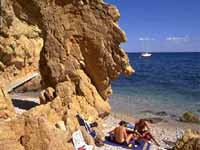
Photo credit: Spanish National Tourist Board
The old town is situated a mile or so inland because its inhabitants feared the incursions of pirates in days of yore. The waterfront of Javea centres around the working fishing port of Aduanas de Mar and the adjacent busy marina. The promenade is lined with good seafood restaurants, boutiques and pavement cafes. The most popular beach, Arenal, is a long, sandy stretch with safe bathing, and it is just one of the many sandy bays and coves to be enjoyed along the coastline.
Several times a year Javea lets its hair down with a lively fiesta. The best known, and most enjoyed by visitors, is the 'Moors and Christians' celebration, when locals re-enact the Moorish landings on the coast and the recapture of the peninsula by Christian defenders. During the second half of July the town is enveloped in an orgy of feasting, street parades, dancing, music and fireworks.
Shopping in Javea
The port area offers some interesting boutique shopping opportunities for holidaymakers, while along Arenal Beach holidaymakers are well catered for with kiosks and shops selling all the trappings from sunscreen to souvenirs. In Javea's old town there is a daily indoor covered market, mostly stocking fresh produce, and on Thursdays the weekly outdoor market on the Place de la Constitution is an entertaining experience, with street performers spicing up the variety of wares on offer on hundreds of stalls. Browse for all manner of things from fresh fish to leather sandals, toys and juicy Valencia oranges and 'churros' (similar to donuts). The sprawling suburban area around Javea, which connects to other resorts along the Costa Blanca, is well supplied with shopping malls and modern supermarkets. Smaller shops tend to close for siesta from around 2pm to 5pm, but stay open late in the evenings. Larger chain stores and supermarkets remain open all day until late at night.
Dining in Javea
The holiday destination of Javea offers some fantastic eateries including Karma Lounge Restaurant, Pizzeria Pepa, Restaurante Masena and La Boheme. The port area of Javea is a popular dining spot, with a host of restaurants offering a variety of cuisines situated along the waterfront, where it is possible to enjoy anything from pizza to paella with a view of the harbour or beach. The old town is less well supplied with restaurants, but those that do inhabit its narrow streets are cheaper than the more touristy areas. The area fronting Arenal Beach is where most tourists congregate to dine out, and the choice is vast, ranging from Burger King to Chinese food. The majority of establishments cater for all tastes, offering an international selection on their menus.
Activities in Javea
Holiday visitors in pursuit of a hectic holiday nightlife may well be disappointed with Javea, where activity after dark is limited to the strumming of Spanish guitars in a few restaurants and bars, or the odd flamenco show, even during the height of the summer season. A few British bars offer football, pool tables and sometimes karaoke nights. There are one or two discreet discotheques open during summer in the Arenal area. For a rollicking night out visitors will have to travel to the larger, more frenetic resorts nearby, particularly Benidorm.
Things to be aware of in Javea
Javea is a sedate resort with limited nightlife and entertainment options.
Antalya
Overview
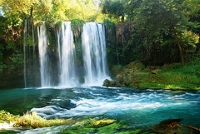
Photo credit: zolakoma
Known as the Turkish Riviera, a holiday on the Antalya shoreline offers secluded coves, ancient cities and harbours, seaside towns, sparkling seas, and soaring cliffs. The city provides an excellent base for exploring the small towns nearby, as well as caves, waterfalls, and Roman ruins, including Perge and the mountain-top remains of Termessos.
A 30-minute drive east of Antalya is Aspendos, which boasts the finest example of a Roman theatre in the world. Built in the 2nd century AD, it is remarkably intact. In addition to the vast number of archaeological wonders, the area also has a wealth of outdoor activities. Antalya, lying at the foot of the Taurus Mountain range, is host to numerous sporting events throughout the year, including international beach volleyball, triathlons, and canoeing competitions.
Shopping in Antalya
Shopping in Antalya can be an exhausting but exhilarating experience, with everything up for grabs from the famous local jams and jellies, made from a variety of fruits and vegetables, to antique jewellery, kilims, prayer rugs, leather ware, cotton clothing, traditional pottery, and wood carvings. Haggling is expected and bargains can be had. The best shopping is in the Kaleici district near the city walls, along winding side streets in the old quarter and along the avenues of Ataturk, Cumhuriyet, and Isiklar. Shopping is not only entertaining in Antalya but offers plenty of picturesque photo opportunities too. There are also several large modern shopping malls around the old town, one of the largest and most popular being Migros. Visitors should be wary of those who try to sell them antiques, as it is illegal to export such items.
Dining in Antalya
Although most tourists will head for one of the numerous restaurants in the Kaleici (old town) when on holiday in Antalya, the more adventurous gourmets would be better advised (for quality as well as price) to steer off the beaten track and try one of the restaurants favoured by locals. Although, the Kaleici restaurants are certainly atmospheric, with some even built into the ancient Roman walls. A good bet for Turkish food in Antalya, offering a delightful courtyard planted with lemon trees, is Restaurant Kirk Merdiven. Other recommendations are the Coco Bar, renowned for the tastiest lamb shish kebabs; Kismet Balikcisi, the local's choice for top seafood dishes; and the Develi Restaurant, where travellers may be forgiven for thinking the starter is the main meal as they wade through copious delicious Turkish specialities.
Activities in Antalya
Antalya pulses after dark with what is undeniably the Turkish east coast's liveliest nightlife, centred on a wide variety of clubs and bars. Most bars double as discos, and most of the hotels offer floor shows, usually with belly-dancing, that are open to non-guests. Club 29 in Kaleici is among the hottest spots for all-night dancing, but those who just want a quiet, cool drink gravitate to the waterfront bars to catch a sea breeze, or relax at one of the city's nargile (water pipe) bars.
Things to be aware of in Antalya
As in most Turkish holiday resort towns, touts for Antalya's shops, stalls, restaurants, and bars can be bothersome.
Koh Samui
Overview
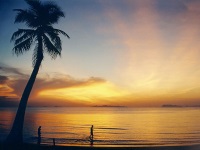
Photo credit: Manfred Werner
Shopping in Koh Samui
There are three main areas for shopping on Koh Samui: Nathon, Chaweng and Lamai, but all towns on the island offer shopping. Nathon is the main shopping centre, and the town where the ferries arrive. Goods from all over Thailand are available, as well as traditional souvenirs such as silk scarves. Chaweng and Nathon are excellent places to have clothes made by local tailors, while Chaweng and Lamai are the towns to find good quality western-style shops. Most towns have night and day markets, always intriguing regardless of whether one buys anything or not.
Dining in Koh Samui
Koh Samui is highly regarded for its superb and abundant dining options, from excellent Thai cuisine to seafood, and a growing number of restaurants around the island offer a wide variety of international food and other specialities. Many restaurants have begun serving customers right on the beach for a truly scenic and tropical experience. Chaweng Beach has a large concentration of good international restaurants, while many of the best Thai restaurants are found in Lamai.
Activities in Koh Samui
The nightlife on Koh Samui is rated among some of the best in Thailand and has discos, cabaret shows, clubs and pubs, many of which are open till sunrise, and are located mainly in Chaweng and Lamai. Chaweng is the most popular area for nightlife, featuring everything from outdoor music bands to stylish nightclubs. Lamai caters for a slightly older crowd, but also has numerous music venues and bars. The top discos on the island are the Green Mango and Reggae Pub (Chaweng), and the Swing Bar (Lamai). There are also opportunities to watch classical Thai dancing, mud wrestling and Thai boxing. Beach parties with fireworks displays also occur regularly.
Things to be aware of in Koh Samui
Koh Samui's popularity as a holiday destination has resulted in overcrowding, and some might say an over-abundance of bars and street sellers.
St Francis Bay
Overview
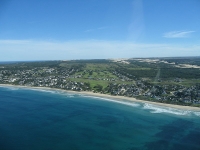
Photo credit:
The Kromme River borders the one side of St Francis Bay, and is navigable for six miles (10km) upstream from the river mouth. The river and river mouth are popular with fishermen, boaters, canoeists, windsurfers, kite surfers and marine creatures which shelter in its waters. Linked to the river is a magnificent marina lined with white, thatched homes, some of which offer bed and breakfast accommodation. Canal cruises at sunset are popular here or else one can enjoy drinks or a meal at a restaurant overlooking the canals.
Port St Francis, a small harbour resort village, lies in a sheltered nook of the bay and provides a colourful setting and safe anchorage for calamari boats, pleasure craft, and ocean going yachts.
Cape St Francis, a rustic fishing village, sits adjacent to St Francis Bay. Cape St Francis is popular for surfing at Seal Point, its beautiful long stretch of beach, and the historic lighthouse built in 1878. Walking trails wind along the rocky coast, through the Irma Booysen Floral Reserve, and along the Cape St Francis Point, linking it to the village of St Francis Bay.
Shopping in St Francis Bay
The village has several small shops and art galleries that will cater to almost all your needs and ensure that you find some souvenirs to take back home. There are at least two fair sized supermarkets which will provide all your basic requirements. In high season most of the shops are open seven days a week.
Dining in St Francis Bay
St Francis Bay has a wide variety of restaurants and coffee shops that offer a reasonable selection of meals. Most restaurants in South Africa have a reputation for good food at affordable prices and St Francis Bay is no different. Most of the restaurants focus on seafood, with local calamari being a menu highlight.
Activities in St Francis Bay
Eating out is popular and the restaurants and bars offer an opportunity to sample the large range of South African wines, which are very affordable in comparison with other countries. Nearby Jeffrey's Bay provides a much bigger range of nightlife options for those truly determined to party. During the December summer holiday season St Francis hosts a few big outdoor live music events and parties which are very popular with youngsters.
Things to be aware of in St Francis Bay
Outside of the peak summer season, St Francis doesn't have much of a nightlife. St Francis can be windy, so a windbreaker is essential.
Lagos
Overview
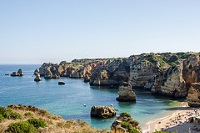
Photo credit: Jaime Pérez
The southern peninsula features some sheltered cove beaches, many of which are close to some of the best hotels in Lagos. Praia de Dona Ana is very picturesque but usually overcrowded in summer. There is much to do other than relaxing on the beaches or in the hotels in Lagos, such as a visit to the old town which has a fascinating history dating back to the Carthaginians. During the great Portuguese age of discovery the port became a caravel shipyard and was the jumping-off point for many a voyage to the East. Although much of the town was destroyed in the earthquake of 1755, there are still some ruins of interest remaining among the many restaurants, bars and hotels in Lagos.
Cheap holidays in Lagos have something for the whole family and hotels in Lagos can be booked through major travel agencies. Self catering apartments in Lagos may often be the cheapest option.
Shopping in Lagos
Besides an ongoing flea market that sprawls through the streets, Lagos boasts numerous fascinating shops and boutiques, especially in the pedestrianised old city. Browsing is as pleasurable as buying in the well-stocked shops that are bristling with attractive local wares, from wickerwork to filigree jewellery, copperware and leather goods to wine and pastries.
Dining in Lagos
Eating out is part of the pleasure of a holiday on the Algarve, and Lagos offers the best choice of establishments in which to indulge. Seafood lovers will be ecstatic, but no one, even vegetarians, will be disappointed or go hungry. A good choice would be to visit the marina, where restaurants serve waterfront breakfasts, lunches and dinners seven days a week. For creative international cuisine, visit some of the establishments in town, which cater to almost everyone, including vegetarians. Truly gourmet local specialities like pork chops with figs, savoury shrimp, and succulent shellfish are enjoyed at upper class spots all around Lagos, with many having big wine cellars to boast as well.
Activities in Lagos
The centre of Lagos comes alive in the evenings with buskers and street entertainers, and the nightlife in Lagos can compete with any holiday resort in the Algarve, with several energetic dance clubs and character-filled bars strewn through the main part of town. Most establishments have live music, darts, pool tables and Sky TV sports channels, and stay open late until 2 or 4am.
Things to be aware of in Lagos
There is not a lot for children to do in Lagos but there is a zoo and an excellent water park not too far away.
Lloret de Mar
Overview
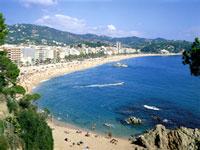
Photo credit:
Shopping in Lloret de Mar
There are a multitude of shops and markets to choose from in Lloret de Mar, and plenty of time for holidaymakers to browse, provided they can bear to leave the beach. The main shopping enclaves, from malls to small kiosks, are centred in the streets behind the waterfront. Wares tend to be touristy items, from souvenirs to bathing suits, and prices are generally reasonable although quality may be lacking. Some of the smaller shops close in the early afternoon hours and on Sundays, but in general visitors can shop happily from around 9am until late at night any day of the week during the busy summer season. The traditional local market is held every Tuesday on the Carrer dels Mestres, and there is a municipal market every weekday in the Carrer Senia del Rabic and Carrer Verge de Loreto.
Dining in Lloret de Mar
There is a wide variety of cuisine available in a plethora of restaurants and fast-food outlets at Lloret de Mar, from the best of British to traditional tapas, at very reasonable prices and generally good quality. Favourites with holiday-makers are strawberries and cream, Sangria (fruited sparkling wine) and delicious dishes of paella (seafood risotto). Many of the local restaurants in the old town offer a 'menu of the day' deal including two courses, dessert, bread and even wine for a few Euros. There are also Tex-Mex, Chinese and various other flavours to indulge in.
Activities in Lloret de Mar
The nightlife in the holiday resort of Lloret de Mar is exhilarating, with its hundreds of bars and 30-odd nightclubs pulsating all night, particularly along the Avinguda Just Marles I Vilarrodona strip of the old town. Night owls who stroll along here in the late evening are accosted by touts offering free tickets and drinks vouchers for the clubs, and partying here can be as cheap as it is lively. Among the more popular clubs and pubs are Bumpers, renowned for its Caribbean cocktails and glass dance floor; Moby's, where karaoke is the popular entertainment; and Tropics, the biggest and best nightclub in town where guest DJs rock the night with a mix of house, rock and trance music enhanced with laser lights and foam. Families opt for friendly 'home-style' pubs in the suburb of Fenals, where kids are entertained and the favourite English soap operas are screened.
Things to be aware of in Lloret de Mar
The beach is comparatively small and becomes very over-crowded in the height of the season.
Costa Teguise
Overview
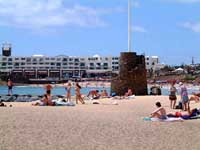
Photo credit: canaryforum
Shopping in Costa Teguise
Costa Teguise has a variety of shops around the resort and in the La Cucharas Shopping Complex, selling all the usual tourist tat for holiday makers, as well as offering a few electrical duty-free stores. The busy Sunday market at Teguise is well worth a visit, selling a variety of locally produced goods from pottery to tablecloths along with the inevitable 'I've been to Lanzarote' t-shirts. Although visitors should be able to find souvenirs and anything they may need on holiday, Costa Teguise is not suited to big shopping sprees.
Dining in Costa Teguise
There is a good range of restaurants in Costa Teguise catering for all tastes and pockets. For dining out, visitors should try Coffee and Cream Bistro Bar, Vesubio Restaurant, Restaurant Montmatre or El Bocadito, which specialises in traditional Spanish tapas. Besides a number of local establishments, there are plenty of Italian, Indian, Thai, Chinese and seafood restaurants. For British visitors longing for home, there are several fish and chip shops that offer traditional cod and freshly made chips, and other places that serve up English breakfasts and screen Premier League football on big screen TVs.
Activities in Costa Teguise
The nightlife in Costa Teguise is not legendary. Party animals generally take a taxi to Puerto del Carmen, a larger holiday resort ten miles (16km) to the west. Costa Teguise's Mo vita Disco Bar is its best-known party venue and there are some nice bars around the marketplace to start the evening off. Travellers can try the Fiddler's Bar and the Sunburnt Arms, or Hennessy's Irish Bar if they're craving a refreshing pint of Guinness. For something different, they can try Legends Bar, which provides entertainment such as a hypnotist or an Abba tribute band. There is also a casino in the Hotel Oasis.
Things to be aware of in Costa Teguise
It is possible to get good bargains in the electrical duty-free stores when on holiday in Costa Teguise, but visitors should remember that they can't take purchases back to the shop once they have left the island. They should check everything works and that all batteries, cables and plugs are included; that they receive a European guarantee, not an Asian one; and that all electrical items have a CE stamp. While water is safe for cleaning teeth and washing food, it is very high in mineral content and can cause bad stomach problems. Bottled water should be used for drinking.
Puerto Pollensa
Overview
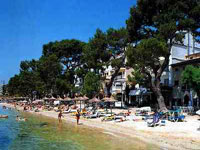
Photo credit:
Shopping in Puerto Pollensa
While Puerto Pollensa may not be a shopping paradise as such, it is very adequately supplied with shops and boutiques catering to the tourist trade and holidaymakers should enjoy a spot of souvenir shopping. It is the local markets, mainly, that delight shoppers in Mallorca, and one of the liveliest and biggest takes place every Sunday in the church square in the Pollensa old town. Stalls extend down the side streets, filled with a variety of goods from fresh fruits and vegetables to local crafts and carvings, leather goods, ceramics and lace. Market day in Puerto Pollensa itself is Wednesdays, when stalls are set up in the Church Square. The port is connected to the old town by a regular and frequent bus service.
Dining in Puerto Pollensa
Clivia, Giardino, Ca'n Costa and Little Italy come highly recommended for holidaymakers dining out in Puerto Pollensa. The resort is known to have some of the best seafood restaurants on Mallorca. While this is undoubtedly so, there is also a wide selection of restaurants catering to all tastes, including British pub food, pizza, Chinese, local tapas and even a Kashmiri restaurant.
Activities in Puerto Pollensa
Like everything else in Puerto Pollensa, the scene after dark remains laid-back and quiet, with tourists and locals alike taking time for the traditional 'paseo' or stroll from the marina along the Pine Walk, as far as the elegant Illa D'Or hotel. After lingering over a delicious dinner most are content to watch the world go by from a pavement café or bar. There is entertainment offered by most of the hotels, but the main resort of Puerto Pollensa is not designed for the young clubbing set. Those wanting a party should travel to the nightclubs in neighbouring Alcudia, a few miles to the south. The old town and resort host plenty of festivals, when things get lively, like in January when bonfires are lit in honour of St Anthony, and in July when the patron saint is honoured with parades, concerts and plenty of dancing in the streets. In February an annual carnival is held, and during the second week of November celebrations centre on the annual trade fair.
Things to be aware of in Puerto Pollensa
Negatives about Puerto Pollensa are expressed only by those who go anticipating bright lights and wild nightlife. The resort is quiet and the beaches uncrowded, even in the height of the season; most visitors are families with young children or older couples. Entertainment in most hotels is geared primarily towards children. Restaurants can be very pricey.
San Antonio
Overview
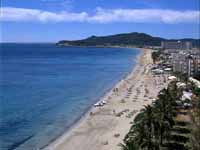
Photo credit: Spanish National Tourist Board
Shopping in San Antonio
There is a selection of shops in and around San Antonio catering for holidaymakers, from the inevitable bucket and spade stores to designer boutiques. Good buys include the local porcelain and leather goods. The local supermarkets are great and stock all the well-known brands (particularly British brands); alcohol and cigarettes are particularly cheap. Ibiza Town is the best place to find the latest fashion accessories; the shops don't close until well after midnight during the high season and in the evenings the port area takes on the ambience of a hippy market of street vendors and stalls.
Dining in San Antonio
The resort has a huge variety of restaurants and fast food joints. San Antonio has three areas: 'The West End', which is packed with lots of small bars, fast food restaurants and pavement cafes; the more upmarket 'Sunset Strip', where the better restaurants are found; and 'The Bay', which has an eclectic mix of bars, restaurants, clubs and hotels. Some restaurants offer good local Spanish fare and excellent locally caught seafood but the majority cater for more British tastes with international staples such as hamburgers and chips, full English breakfasts and Sunday roasts. Chinese, Indian and Italian food is also readily available.
Activities in San Antonio
San An is a joy for party animals! Cafe Del Mar is San Antonio's most celebrated social venue and a must for all visitors and holidaymakers looking for a good night out. Ibiza is synonymous with clubbing and the nightclubs in and around San Antonio attracts the best DJs from around the world. A great place to start off the evening is in one of the bars along the Sunset Strip. Privilege is said to be the world's largest club, located on the long straight road to the Ibiza Town.
Things to be aware of in San Antonio
San Antonio's beaches aren't great, but the spectacular beaches of Cala Conta, Cala Bassa and Cala Tarida are easy to get to. The West End is very noisy and at night is packed with sales reps and 'looky-looky' men trying to sell watches, jewellery, sun glasses and drugs. Those looking for a less hectic evening should stick to the San Antonio Bay end of town. The big clubs can be expensive.
Chamonix
Overview
Photo credit: Simo Rasanen
Shopping in Chamonix
Chamonix is a year-round holiday destination and offers a range of shops aimed at skiers, snowboarders and mountain climbers. There are plenty of supermarkets and delicatessens for those on a self-caterering holiday.
Dining in Chamonix
Chamonix is alive with restaurants, ranging from first-class French restaurants to Indian, Chinese, Italian and Japanese eateries and holidaymakers will not be disappointed. Both Chez Constant and Le Panier des 4 Saisons offer delicious traditional menus in cosy settings. For some French-Asian food fusion, try either Le Cap Horn or Munchie. Poco Loco is famous for it's burgers. Argentiere has some good local restaurants but much less choice than Chamonix. There are some fine restaurants on the slopes too, including Le 3842, one of the highest restaurants in Europe. Tables at the more popular restaurants should be booked in advance, particularly over Christmas, New Year and Easter weeks.
Activities in Chamonix
Chamonix is known for its ski-hard-party-hard atmosphere and the nightlife won't disappoint. There are a selection of bars near the station in Chamonix, on Avenue Michel Croz, offering beer, cocktails and live music. Elevation 1904 and La Folie Douce in Chamonix, and the Office Bar in Argentiere are popular choices for apres-ski drinks. Amnesia is the biggest club in Chamonix, with resident and guest DJs performing every night until 4am. There is a casino for those wishing to try their luck on the tables.
Things to be aware of in Chamonix
The ski areas in Chamonix do not inter-connect and the base lift stations are far apart, so a car is essential in Chamonix unless visitors are happy to wait for the erratic shuttle buses. The beginner slopes are separated from the main skiing areas making lunch meetings hard to organise. Chamonix has its own microclimate and the weather can be bad when neighbouring resorts are fine. If it is clouded over, it's worth checking out the weather in Courmayeur in Italy, a short trip away through the Mont Blanc tunnel.
Skiing in Chamonix
Chamonix and Argentiere are renowned worldwide for their wide variety of challenging skiing, but there are also plenty of options for beginners, particularly at Le Tour at the top end of the valley. There are nursery slopes nearer town at La Vormaine, Les Chosalets and Les Planards. Intermediates and advanced skiers can enjoy up to 300 miles (500km) of slopes available with the full lift pass, ranging from Le Brevent and La Flegere to Les Grands-Montets. Les Grands-Montets is the major attraction for advanced skiers with some massive mogul fields and endless off-piste skiing. The Vallée Blanche is probably the best-known ski trail in the Alps, a 13-mile (21km) glacier running along the Mer de Glace back to Chamonix. It's often closed due to bad weather, but is an wonderful adventure for competent skiers. Skiers should take a guide and be prepared for bad weather.
S'Illot
Overview
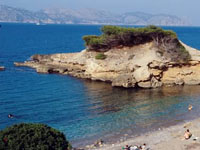
Photo credit:
Shopping in S'Illot
The town centre in S'Illot offers some shopping opportunities, but apart from a few souvenir and gift stores the resort's shops mainly just deal in essentials. Several supermarkets provide all that self-caterers may need. Visitors will find more shopping variety in nearby areas such as Sa Coma. There is a sprawling Monday morning market a short drive away at Manacor, with many stalls radiating out from the central church.
Dining in S'Illot
S'Illot has some great restaurants to enjoy while on holiday, the best of which include Bar Restaurante Espas, Can Ronpes, Lago Restaurante and Playa Azul. BiBaBo café and music bar on the waterfront mixes the best of British with some Spanish dishes for families wanting the best of both worlds.
Activities in S'Illot
S'Illot has little in the way of nightlife. Most community bars and restaurants, though lively and fun, close early, and there are no real nightclubs. Most nightlife is centred around hotel bars, and those looking for a wilder experience should travel to nearby Cala Millor, which is five minutes away be car or taxi, and has a more energetic party scene. The most popular nighttime entertainment venue in S'Illot is probably the Crazy Monkey.
Things to be aware of in S'Illot
S'Illot is not a true resort; it is a traditional fishing village that has only recently begun to adapt to the growing demand for tourism on Mallorca. There can be a lack of infrastructure, including spotty public transport. The town has a limited nightlife that is mainly restricted to hotel bars.
Cerro Catedral
Overview
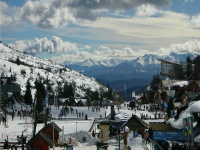
Photo credit: guillebot
No other Argentinean ski area rivals Bariloche in nightlife, dining out or entertainment. With 600 hectares (1,482 acres) of skiable snow area, 57 runs of varying difficulties and 27 chairlifts, Cerro Catedral offers some of the best skiing facilities in South America. Bariloche features a great airport, making getting to Cerro Catedral a quick and easy process, which is perfect for families travelling with kids.
Shopping in Cerro Catedral
Travellers should head to Las Terrazas, the largest shopping centre in Cerro Catedral, which boasts around 50 shops that sell everything from ski wear and sporting goods to jewellery and fashionable clothing. The Amancay Paseo Plaza is also a good place to pick up a few souvenirs, while those wanting a little more variety should take the bus, which runs every 30 minutes, into Bariloche for a shopping experience that is second to none. Visitors should be sure to swing past a few of the chocolate stores while in Bariloche, as it's considered the chocolate capital of Argentina.
Dining in Cerro Catedral
There are a few restaurants and coffee shops around Cerro Catedral and the Amancay Paseo Plaza houses a large restaurant, but foodies looking for a larger variety of dining out options should head into Bariloche, where everything from fast food outlets to nouveau cuisine eateries can be found. Visitors should try Familia Weiss, a popular eatery serving a little bit of everything and even featuring a children's menu, while Cerveceria Blest features a great dinner accompanied by local beers.
Activities in Cerro Catedral
Lively holidaymakers have come to the right place as Cerro Catedral and nearby Bariloche offer plenty in the way of nightlife to suit all ages and tastes. Most of the apres-ski is centred around Bariloche, but this is easily reached from the base of Cerro Catedral. Visitors should head to the central plaza in Bariloche for a few drinks, where they'll find plenty of English-speaking tourists, or watch the sun set over the mountains and enjoy some of the local brew. Party animals can dance the night away on one of six storeys of dance floors at Grisu, while big spenders can put their poker face on for a night of gambling at the Club Hotel Catedral.
Things to be aware of in Cerro Catedral
Being the most popular and famous ski area in South America, Bariloche can become extremely crowded during the winter months.
Bansko
Overview
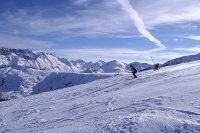
Photo credit: Amorphisman
Shopping in Bansko
Holidaymakers shopping in Bansko will find plenty of souvenirs in the form of local crafts, especially embroidered goods. Many shops focus on skiing equipment, but on Sundays there is a market that offers fresh produce and a variety of locally-made goods.
Dining in Bansko
Bansko is not short on cosy eateries, with dozens of taverns in the town serving up hearty traditional Bulgarian cuisine, and holidaymakers will not go hungry. Restaurants and pubs selling international staples are also readily available.
Activities in Bansko
The nightlife in Bansko is not as wild as in some of Bulgaria's other popular holiday resorts, like Borovets and Pamporovo. This small, old-fashioned town takes its tone from the quiet locals, who prefer to while away the evenings in the large selection of low-ceilinged taverns and pubs before a roaring fire. Most offer entertainment in the form of local musicians or folk orchestras, particularly during the winter ski season. There are some low-key discotheques offering dancing, frequented by the local youth as well as visiting foreigners.
Things to be aware of in Bansko
Bansko is quiet and not suited to 'party animals'. Expert skiiers may not find enough challenge on the skiing slopes, which are best suited to beginners and intermediates.
Skiing in Bansko
Skiing in Bansko is particularly well-suited to beginners and intermediates. The slopes of Todorin Vruh are best for novices, with gentle slopes and long runs from the chair lift. The slopes also give access to some good off-piste skiing and snowboarding. Intermediates can take the triple chair lift to the top of the peak and try one of the downhill runs. Expert skiers can go to the nearby resort of Shiligarnika for more challenging slopes. There are skiing and snowboarding classes available for adults and children. Snow conditions in Bansko are good and there are seldom queues even in the height of the season. In recent years a lot of money has gone into improving and replacing ski lifts at Bansko, vastly improving the amenities. Bansko has the best snow record and the longest ski season (December to May) of all Bulgarian ski resorts, and is one of the best-value ski destinations in Europe.
Courmayeur
Overview
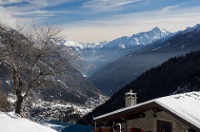
Photo credit: Ivan Borisov
The village was once known as a spa town and base for climbing, but became recognised as a ski resort with the opening of the Mont Blanc Tunnel, which provides easy access from Chamonix and Geneva International Airport. The town's proximity to both Geneva and Turin's airports makes it a popular destination for weekenders. A transfer from Geneva takes just over an hour and Turin is 1 hour 45 minutes away. Milan is a little over two-hours' drive away.
Shopping in Courmayeur
The shopping in Courmayeur is centred on the pedestrianised Via Roma, which is lined with stylish boutiques, cafes, restaurants and delicatessens, as well as many ski and mountain shops. The streets are alive with immaculately dressed Italians, many who come to Courmayeur to party and shop rather than ski.
Dining in Courmayeur
Like most Italian ski resorts, evenings begin with the passeggiata, a stroll down the main street before a late dinner. The holiday destination of Courmayeur has numerous restaurants, cafes, pizzerias and trattorias to suit all tastes and budgets, and eating out is almost as popular as time spent on the slopes. Most establishments are fairly informal and relaxed, but there are upmarket fine-dining options for more romantic and exclusive dining.
Activities in Courmayeur
Visitors on holiday will find that the après-ski in Courmayeur is a drawn out, rather laid back affair with fire-warmed bars spilling out onto the main street. The bars are numerous, including cozy traditional pubs, lively bars with dance floors and theme nights, as well as stylish venues for the more fashion-conscious.
Things to be aware of in Courmayeur
On weekends, there can be a long wait at the main cable car in Courmayeur. To avoid the queues, visitors should head to the nearby Dolonne gondola or the cable-car up the valley at Entrèves. The weather in Courmayeur is sunnier than nearby Chamonix, meaning the slopes can get slushy in the afternoons.
Skiing in Courmayeur
By European standards, the ski area in Courmayeur is small, though is does include 63 miles (100km) of its own pistes and short but numerous runs that cater to mainly intermediate and beginner skiers, and snowboarders.
Access is provided to the other resorts in the Aosta Valley, and a combined area of almost 497 miles (800km) of runs and 32 miles (51km) of cross-country trails is available. Chamonix is just across the border and is lift-linked to one of the resort's ski areas, offering a wide range of skiing options and off-piste routes on both sides of the border.
Courmayeur offers skiing and boarding for all standards, but the groomed slopes are best suited for intermediates, while advanced skiers will find plenty of off-piste opportunities and high mountain ski areas.
There are two main ski areas at Courmayeur. Checrouit-Val Veny, directly above the resort, is mostly suited to intermediates and beginners, although the nursery slopes lower down are limited and can be crowded. Absolute beginners can also ski at Dolonne in the village. The most famous run is the 13-mile (20km) descent of the Vallée Blanche from Helbronner Point at 11,053ft (3,369m) down to Chamonix, which is daunting and demanding, but can be undertaken by intermediate skiers and snowboarders.
The skiing from Cresta Youla at 8,700ft (2,652m) is excellent, but higher up at Cresta Arp the terrain is for experts only and should be undertaken with a guide. The second ski area is Mont Blanc and is for advanced skiers and boarders; a guide should accompany skiers on the high mountain terrain and the glacier. Snow is reliable and there are widespread snowmaking facilities.
Heavenly
Overview
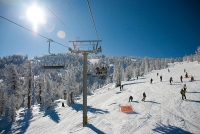
Photo credit: Lukasz
Shopping in Heavenly
With a number of top brand outlets, such as Patagonia, Burton, and North Face, there is enough variety for every ski and snowboarding holiday requirement. There are plenty of factory stores including several top brands. The South Shore has a number of shops selling everything needed for a ski holiday.
Dining in Heavenly
There is a massive choice of restaurants on the South Shore, offering everything from pizza and pasta, steaks and grills, Mexican, and more. Evan's American Gourmet Cafe is one of the most popular serving a variety of Californian cuisine. Friday's Station has magnificent views, a fabulous wine selection and great service. For seafood head to the Naked Fish, for mouth-watering burgers, including buffalo, elk or salmon burgers, visit the Sky Deck Burger Bar. The casinos mostly have great value restaurants and all-you-can-eat buffets. There are also plenty of mountain restaurants, offering anything from hot dogs and salads to burgers and pizzas.
Activities in Heavenly
Heavenly Village, in South Lake Tahoe, has a very lively apres ski scene, centred on the pedestrian plaza around the base of the gondola where there are plenty of lively bars with DJs and live bands. The resort comes to life during the spring, when temperatures soar and the Californian sunshine takes hold. The nightlife is centred around the huge casinos in the Stateline suburb on Nevada territory, which mostly include restaurants, bars and nightclubs. Travellers should note that the minimum legal age to buy or consume alcohol in both California and Nevada is 21.
Things to be aware of in Heavenly
Heavenly can get quite crowded and lift lines tend to be long over Christmas, the Spring Break period and weekends. The lifts to the upper lifts can close in high winds and the roads accessing Lake Tahoe are often closed in snowstorms. With all the casinos, some visitors find Heavenly a little brash but the apres ski scene is what draws many skiers to the resort.
Skiing in Heavenly
Heavenly boasts 350 inches (889cm) of snow a year and one of the largest snowmaking systems in North America. The size of Heavenly's terrain means it will have a lot to offer all levels of skiers. The California side is preferred by beginners and intermediate skiers and riders, whereas the slopes on the Nevada side are far more interesting. The most advanced skiers will want to head to the far eastern end of this sprawling resort where they'll find fewer people and an extreme skier's playground including fantastic steep runs in the Mott and Killebrew Canyons. The parks at Heavenly have something for beginners and advanced tricksters and is the home of the South Shore Soldiers Camp every spring.
Las Lenas
Overview
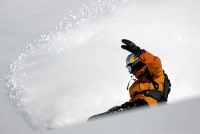
Photo credit: Siegfried Josef Grabner
Its isolated location means the nearest towns, San Rafael and Malargue, are several hours' drive away. The village of Las Lenas is mostly self-contained, with a number of shops, bars, restaurants and a few hotels, while the nightlife is nearly as famous as the skiing!
Shopping in Las Lenas
The shopping in Las Lenas is concentrated in La Piramide shopping centre, which has stores providing basics such as skiing equipment, clothing and film, as well as delicious Patagonian chocolate, which is a popular souvenir from Argentina.
Dining in Las Lenas
The resort is small and isolated, so most of the restaurants in Las Lenas are located in the hotels. Escorpio has an excellent restaurant serving French and Mediterranean cuisine, while Piscis' two eateries specialise in pizza and Italian food.
Activities in Las Lenas
Las Lenas is nearly as famous for its buzzing nightlife as its skiing. There are a number of bars, pubs, nightclubs and discos in town, while the Casino Las Lenas is also quite a draw.
Things to be aware of in Las Lenas
Las Lenas is isolated and not easy or cheap to reach. The expert and intermediate slopes become unavailable in bad weather, which can last for two to three days at a time.
Skiing in Las Lenas
Advanced skiers will be in paradise at Las Lenas. There are many extreme slopes towards the top of the peaks, and a total absence of trees leaves plenty of room for creative detours. There are plenty of intermediate and beginner runs as well lower down. It should be noted that all but the beginner slopes shut down completely when the snow and wind picks up. There are several skiing and snowboarding schools that offer great family and kids' classes.
Tofino
Overview
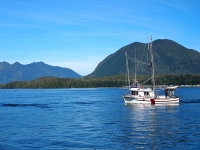
Photo credit: theforeignflash
Tofino is home to only about 2,000 locals who enjoy year-round access to its mild climate and resplendent natural beauty. The area boasts plenty of activities for visitors, including kayaking, whale watching, surfing and fishing.
Accessible by air or sea, Hot Springs Cove is open year round and visitors can have a soak in its naturally hot rock pools. Other popular sights include the 800-year-old Eik Cedar; the Tofino Botanical Gardens with acres of forest, shoreline and gardens; and the Whale Centre Maritime Museum housing fascinating artefacts.
The Wickaninnish Interpretive Centre, containing interesting information about the region and the Nuu-chah-nulth First Nations (the area's original inhabitants), is well worth a visit. Tofino offers visitors the perfect combination of a range of activities, as well as a chance to relax and put their feet up surrounded by unparalleled beauty.
Shopping in Tofino
There are plenty of shops for holidaymakers in Tofino, with many specialising in First Nations art and crafts.
Dining in Tofino
Holidaymakers can find a number of restaurant styles in Tofino, ranging from pizza, sushi, regional produce, organic foods, to fresh seafood, deli-style offerings, classic Italian, and Nuu-Chah-Nulth First Nations cuisine. There are also a number of catering services available.
Activities in Tofino
Tofino is not celebrated for its nightlife, with only a handful of bars and pubs and not much of a nightclub scene.
Things to be aware of in Tofino
The lack of an energetic nightlife may disappoint some visitors.
Pattaya
Overview
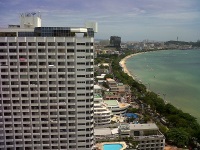
Photo credit: StarryVortex
Shopping in Pattaya
Holidaymakers will find that shopping in Pattaya is fun and interesting, and that there are many bargains to be had, as is the case in most major centres in Thailand. The main shopping area is in the south around the large seaside hotels. Congregated here is a selection of jewellery stores, tailors, boutiques selling silk and cotton goods, and handcraft shops. The largest shopping complex is on North Pattaya Road, designed like a traditional night market and home to a bazaar, handcraft centre, and several bars and restaurants to complement the shops.
Dining in Pattaya
Whether their tastes run to English fry-ups or enchiladas, holidaymakers will find it in Pattaya, where a range of eateries from street vendors to top-notch gourmet restaurants cover an international gamut of cuisines. Not only is the choice vast, but the budget range is too. For a pittance it is possible to dine on chicken fried rice or noodles from a streetside stall or, for a few hundred baht, visitors can go really upscale and dine in air-conditioned luxury at an elegant hotel restaurant, like the The Peak on the top floor of the Dusit Resort Pattaya. An unusual but fun spot is Cabbages and Condoms, a colourful restaurant serving vegetables grown from its own garden. Those intent on sticking to local cuisine will find plenty of mouth-watering Thai options everywhere they look; the fresh seafood is particularly good and is often available straight from a seawater tank.
Activities in Pattaya
Holidaymakers will note that much of Pattaya's nightlife revolves around the notorious local sex-oriented industry, particularly along famed Walking Street in the party zone between Soi 14 and Soi 16 in south Pattaya. This area is closed to traffic at night, and buzzes with dozens of beer-bars, go-go clubs, discos, Thai boxing matches and massage parlours, lit with brilliant neon. Around the beach road the scene is almost as hectic. Extravagant and flamboyant cabarets and drag shows are extremely popular all over the city. Gay-only bars are centred on an area known as Boyz Town. Those looking for some more traditional evening entertainment can kick up their heels at an Irish pub, such as Kilkenny's, or soak up some jazz at the Hopf Brew House on Beach Road.
Things to be aware of in Pattaya
Pattaya is not the ideal destination for families, as it has a reputation for sex tourism and many older male travellers come here searching for prostitutes and go-go girls.
Malia
Overview
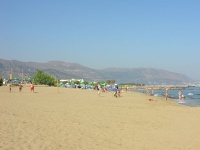
Photo credit: phileole
Shopping in Malia
This is resort shopping at its finest. Visitors can purchase flip-flops, sunscreen, jewellery and leather goods, as well as ceramics, embroidery and other handcrafts. The local wines and cheeses are very good.
Dining in Malia
Visitors can enjoy anything from traditional Greek food to a quick pasta or take-out burger.
Activities in Malia
Malia's nightlife has a reputation for being one of the Mediterranean's hottest for young clubbers, and is on a par with Ibiza and Mallorca. The main strip along the beach is thick with touts luring visitors into their establishments, promising free admission and a variety of drinks offers.
Things to be aware of in Malia
Although Malia has a long, wide stretch of beach, it becomes heavily crowded during the peak holiday season. The resort's popularity among young party goers means it isn't the best option for a family holiday.
Molyvos
Overview
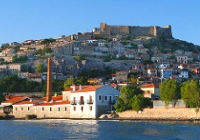
Photo credit: Jean-Francois Renaud
Shopping in Molyvos
Holidaymakers usually enjoy Molyvos' market. Set along cobble-stoned alleys, it's a good place to buy local crafts and produce.
Dining in Molyvos
Molyvos has many traditional tavernas around the harbour and market areas. As it's a fishing village, seafood is naturally the pride of most local menus.
Activities in Molyvos
Though Molyvos isn't top-of-mind among party goers, it does have some clubs and lively bars. The open-air cinema is worth attending and performances at the Castle are always a must.
Things to be aware of in Molyvos
Some holidaymakers have been disappointed to find pebbles instead of sand on Molyvos' beach. Also, summer weekends can see a lot of motorbike traffic, which can be unpleasantly noisy.
Blue Bay
Overview
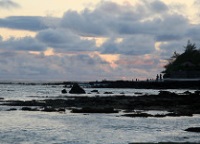
Photo credit: caccamo
Shopping in Blue Bay
Apart from the usual hotel shops and local stores, visitors to Blue Bay can go shopping in the nearby town of Mahebourg which has a wonderful traditional market. Local merchants sell fresh fish, fruit and vegetables, spices, clothes and arts and crafts.
Dining in Blue Bay
Blue Bay is a melting pot of cultures and cuisines and the restaurant scene has benefitted massively from this diversity. French, Indian, Chinese, and African restaurants can be found near the beach and the various hotels provide numerous fabulous dining opportunities.
Activities in Blue Bay
Many of the big hotels provide their own clubs and bars for evening entertainment, but Blue Bay's main nightlife venue is the C Beach Club which regularly features international DJs on Friday and Saturday nights between October and June. This nightclub, right on the beach, is a favourite with locals and tourists and often stays open until 4am in season.
Cozumel
Overview
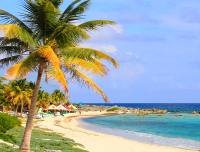
Photo credit: Ricraider
Shopping in Cozumel
San Miguel is a duty-free zone, and there are hundreds of stores selling most things imaginable and certainly anything tourists might desire. The cruise ship passenger terminal at Punta Langosta Pier has a variety of shops, but these are among the island's most expensive, catering to day-visitors with little time and lots of money. Prices decrease the further away from the docks one ventures. The waterfront shopping zone stretches to La Plaza behind which there is a craft market. For groceries, there are a few food stores, as well as the Cozumel Market on Adolfo Rosado Salas where holidaymakers can buy fresh seafood, spices and fruit and vegetables. In the markets travellers should be prepared to bargain, but some wonderful arts and crafts can be found.
Dining in Cozumel
Cozumel offers food of every kind from authentic Mexican, to international and fast food franchises. Holidaymakers will not be disappointed. Casa Denis is one of the oldest and most popular restaurants in town, featuring a variety of traditional Mexican cuisine, and La Choza Restaurant and Casa Mission are other authentic Mexican food favourites. For seafood try La Conchita del Caribe, or Guido's for Italian. Fresh and tasty fusion food can be had at New Especias Restaurant. For an unassuming local experience try Del Sur Argentina Empanadas, which offers a delectable range of sweet and savoury empanadas including a bacon and plum option which is surprisingly wonderful.
Activities in Cozumel
Although there is a wide variety of night time entertainment for holidaymakers to enjoy, things tend to begin and end earlier in Cozumel compared to the rest of the famous Mexican beach resorts, and those expecting a night scene comparable to Cancun or Acapulco may be disappointed. The most popular disco venue is Neptuno, while Carlos´n Charlie's is also very popular. No Name Cigar Bar is also a popular night spot and is located close to Hotel Barracuda. Those who prefer a resort which doesn't host hordes of young party animals will prefer Cozumel's slightly more sedate and stylish nightlife, although this is not the case over Spring Break (March) when US teenagers descend on the island.
Things to be aware of in Cozumel
Cozumel is a cruise ship destination, and is popular with wealthy day visitors, which has driven the prices of shops, restaurants and bars to among the highest on the Yucatan Peninsula. The island becomes swamped daily by cruise visitors from passing ships and San Miguel can be quite crowded.
Fethiye
Overview
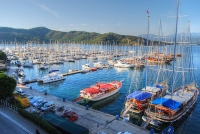
Photo credit: Natalie Sayin
The town absorbs the tourist traffic and still retains a sense of its old-fashioned rural character, with herds of goats and sheep blocking the roads on market days and the smell of herbs and spices in the air. Around Fethiye are numerous unspoiled rocky coves and beaches, crystalline seas, offshore islands, cliffs, and pine-covered mountains affording as much holiday relaxation or activity as one chooses.
Shopping in Fethiye
The Tuesday bazaar is the biggest in the area and is a must for bargain hunters. In the town centre there are craft shops making everything from carpets and kilims to lace and leather goods. The gold shopping presents opportunities for good deals. Visitors should be prepared to haggle, but be wary of touts who try to sell them antiques, which are illegal to export.
Dining in Fethiye
There is a good selection of restaurants on the harbour front and in the narrow streets of the old town, and there is an emphasis on local cuisine, though visitors will find plenty of English-style eateries as well. Cafe Genis is a great spot for people-watching. There are several good wine houses that offer a selection of local varietals.
Activities in Fethiye
Much of the nightlife in Fethiye is hosted by resorts and hotels. The Paspatir old town has a number of bars and clubs ranging from traditional Turkish music to live cabaret and discos, while the Belcegiz Beach promenade has a few loud clubs. There are also two cinemas in town.
Things to be aware of in Fethiye
A lack of signs in the city makes it difficult to find points of interest.
Conil de la Frontera
Overview
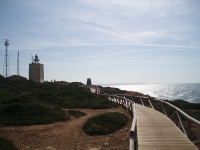
Photo credit: amiro
Shopping in Conil de la Frontera
There are a number of popular shops in Conil de la Frontera, including some chic fashion boutiques, souvenir shops, and supermarkets. If you don't find what you want in the village, the San Fernando mall is a short drive away in the direction of Cadiz.
Dining in Conil de la Frontera
There are many good tapas bars in town, along with pizzerias and seafood restaurants. Tuna is a local speciality, as it is caught nearby. Holidaymakers should visit the best restaurants in Conil de la Frontera, which include Casa Francisco, Restaurant El Olivo, La Fontanilla and the fantastic pizzeria La Gaviota.
Activities in Conil de la Frontera
Conil de la Frontera has a bustling nightlife compared to some other Spanish resort towns. There are many bars, clubs and cafes in the centre of town that stay open late, including popular venues like Club La Luna, Cafe La Habana and Bar Palo Palo. Other clubs offering pumping beats that offer a decent night out or that will keep you on the dance floor until the early hours include Pub Levante, Disco Carpa Keops, Pubs Makoki and Disco Pub La Villa. Traditional Spanish house turned bar, La Mulata, is great for those looking for something different and La Tertulia is also a hip and happening spot.
Things to be aware of in Conil de la Frontera
Strong winds can occasionally disrupt beach activities.
Sintra
Overview
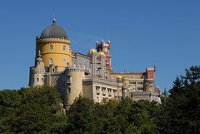
Photo credit: F Mira
No wonder it was once chosen by royalty and nobility as the place to build their summer holiday retreats and, in more modern times, has been accorded the status of a UNESCO World Heritage Site.
Sintra is actually an amalgamation of three villages, sprawling down a steep granite hillside, so the layout is a little confusing for visitors on holiday. The huge Palacio Nacional, with its tall, conical chimneys serves as a landmark in the centre of Sintra, and makes a good starting point for walking tours of the key attractions of this fascinating fairy-tale town, captured by Christian Crusaders from the Moors in 1147.
A fun way to see the town and surrounds is aboard the historic 100-year-old Sintra Tram, which connects Estefanea to Praia das Macas. It is open for rides for the public on Friday, Saturday and Sunday for a couple of Euros.
Shopping in Sintra
Shopping in Sintra becomes a tour of traditional Portuguese folk art and crafts. Do not expect a frenetic spending spree in glitzy modern malls. Sintra's shops are tucked away in narrow cobblestone streets, waiting to be ferreted out by those who appreciate fine holiday souvenirs, like hand-painted ceramics, lace, beaten copper and bronze, embroidered linen and jewellery. Goods come from all over the country, including the Azores. Prices can be steep, but most merchants are open to a little bargaining. Best place to shop is the Praca da Republica and Sao Pedro Square. Those who are seeking modern designer clothing and houseware will have to travel out of town to the huge Cascais Shopping Centre, the area's largest shopping mall.
Dining in Sintra
The best Sintra restaurants tend to keep their offerings local, often with international overtones. Some delicious specialities of the region to look out for are Negrais suckling pig, Merces pork, roast kid, bass and shellfish of all sorts. Then there are the pastries, particularly Sintra queijadas, which are like mini-cheesecakes, made to an age-old recipe. Cream cakes and local jams complete the temptations, all of which should be accompanied by some excellent Portuguese wines.
Activities in Sintra
Sintra is certainly not a party town, but as one appreciative visitor remarked: 'When there are so many marvels to enjoy during the day, who needs nightlife?' Evenings tend to be spent sedately, wining and dining. There are, of course, several bars in the town, some of which occasionally offer live music and can work up quite a buzz. The liveliest bars and cafes are on the Rua das Padarias, Rua Fonte da Pipa and Rua da Ferraria. Late night owls should enjoy the Adega das Caves bodega, which is open until the wee hours on the Praca da Republica, drawing an international crowd.
Things to be aware of in Sintra
Sintra has little to offer the young clubbing and party set, being more of a sightseeing or beach holiday destination. Its close proximity to Lisbon means that it is often crowded at weekends in summer.
Overview
Playa del Carmen
Overview
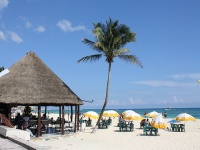
Photo credit: Carolyn Coles
Shopping in Playa del Carmen
Comfortable footwear is vital for holidaymakers intent on a shopping spree in Playa del Carmen, where everything you need in the dozens of enticing shops can be easily accessed on foot. The place to tog yourself out in designer-wear, from head to toe, is 5th Avenue, and to complement the look there are plenty of speciality stores to browse around for jewellery, Mayan-inspired arts and crafts, handbags and the like. Souvenirs range from tacky ashtrays to bright and beautiful sarongs, Mexican blankets and sombreros, and even genuine Cuban cigars from La Casa del Habano (US citizens may not purchase these). Playa del Carmen boasts a Wal-Mart on 30th Avenue, and several American style supermarkets like Chedraui on the corner of Juarez and Highway 307, and Super San Francisco on 30th Avenue. There are also numerous mini-marts selling essentials for holidaymakers, and plenty of pharmacies. The resort's main shopping malls are Plaza Pelicano on 10th Avenue and the Paseo del Carmen close to the ferry pier.
Dining in Playa del Carmen
No one need go hungry in Playa del Carmen because wherever you are in this holiday resort, there will be a great restaurant a stone's throw away. Cuisine ranges from traditional Mexican through all the international favourites, including sushi and vegetarian establishments. For a top Mexican taste treat steer a little off the beaten track behind 5th Avenue and look out for a small taqueria where it is possible to pick up a tempting taco or two for a pittance. Street vendors in the main square (Zocalo) are also a good budget option, especially for fresh fruit and tasty tamales. When it comes to restaurant dining it is difficult to make recommendations from the dozens of good establishments available, but some of the more popular eateries are The Blue Lobster, its speciality obviously the eponymous crustacean; and Season Bistro, which serves upscale Mexican with an international twist.
Activities in Playa del Carmen
Whether it is dancing cheek-to-cheek under the stars, sipping margaritas on a rooftop, soaking up some live jazz, people-watching from a street side bar, learning to salsa, or downing shots and raving it up on a flashing dance-floor, holiday visitors will find that Playa del Carmen after dark has something to fit the bill. One of the most popular hotspots is the huge Palazzo. You can find live music at Kitxen if the club scene is not your style. Numerous open-air bars are in operation until the early hours. Some offer live music or DJs and dancing as the night wears on; others serve up drinks under the stars or palapa (woven palm frond) roofs.
Things to be aware of in Playa del Carmen
There are plenty of topless and nude beaches around Playa del Carmen and families travelling with young children should take this into account.
Playa del Cura
Overview
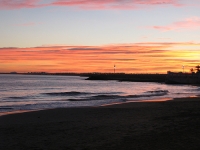
Photo credit: JF Quilis
Shopping in Playa del Cura
The commercial centre of Playa Del Cura is a few hundred yards from the beach, its anchor store being a large Spar supermarket with an in-store bakery which stocks all requirements for vacationers. There are also a few gift and souvenir stores. For more serious shopping, however, visitors can take a bus or taxi to nearby Puerto Rico where it is possible to buy literally anything and everything at three huge shopping malls, including the sought after duty-free electrical goods, photographic equipment and perfumes.
Dining in Playa del Cura
Playa del Cura offers a fairly good choice of restaurants, mostly situated in the commercial centre. There are seafood restaurants with excellent fish dishes, as well as other food styles on offer. Bistro 22 is perhaps the best known restaurant in Playa del Cura, and the Guantanamo Canarian restaurant is also popular.
Activities in Playa del Cura
Those in search of all-night clubbing and pubbing will have to take the 10-minute bus or taxi drive across to Puerto Rico to satisfy their craving, but those looking for more relaxed evenings will be well catered for in one of Playa del Cura's bars. There are several fun pubs, such as Pio Pio on Tauro beach, which offers open house jam sessions on Sunday evenings, or the Irish bar, Old Brouge, and its counterpart Welsh bar, Fleur de Lys, both on the upper level of the commercial centre. Several of the larger hotels offer their own entertainment, which is open to non-guests.
Things to be aware of in Playa del Cura
As Playa del Cura is built on steep cliffs, it is not suited to the elderly or those with difficulty walking. Families with teenagers may find entertainment is limited for this age group. Swimmers should be wary of the strong currents off both of Playa del Cura's beaches.
Overview
Los Cristianos
Overview
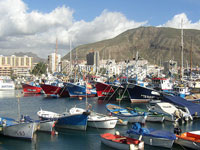
Photo credit:
Shopping in Los Cristianos
One of the joys of holidaying in Tenerife is indulging in duty-free (or low-duty) shopping, and Los Cristianos and surrounds boasts a multitude of shops where it is easy to spend liberally on perfumes, tobacco, electrical goods, cameras and designer clothing. Handcrafts and cultured pearls are also popular buys for souvenir hunters, but these are best sought in reputable stores rather than from seafront hawkers. Local supermarkets stock familiar British brands, particularly those in the large San Eugene Centre. A tourist street market is held in Los Cristianos every Sunday near the Hotel Arona Gran, where most of the merchandise consists of cheap and cheerful Spanish tourist souvenirs, but there is fun to be had in haggling.
Dining in Los Cristianos
Los Cristianos has several top-rated eateries for holidaymakers, its trendiest being Piccolo, Bar El Cine, Plan B and Chill Out. Los Cristianos cannot be beaten for the quality and variety of eating establishments available throughout the day and night, from the ubiquitous English breakfast through midday fast-food snacks, to dinner from China, India, Mexico or anywhere else one cares to mention. There are also more traditional Spanish eateries and tapas bars.
Activities in Los Cristianos
Los Cristianos is very well supplied with fun pubs, some discos and a few nightclubs, but holidaymakers will notice that the nightlife here is nowhere near as wild and exciting as it is next door in Playa de las Americas. Taxis are plentiful and available round the clock, however, so there is no problem popping off to join in the unadulterated partying in nearby lively spots like Veronicas and The Patch, which are usually jumping and pumping until 6am or so. Those who prefer a more sedate evening will be happy to sit back and unwind at a waterfront bar in Los Cristianos, watching the world go by and perhaps enjoying some live music.
Things to be aware of in Los Cristianos
Older visitors might have problems walking up the steep hills.
Overview
Overview
Marmaris
Overview
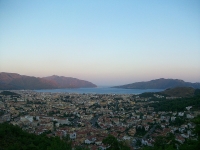
Photo credit: Annahme der Existenz
Shopping in Marmaris
To enjoy shopping in Marmaris, holiday visitors need to be clued up and prepared. Vendors can be annoying, particularly in the bazaars, while there are a large number of fake designer goods on sale and many counterfeit products are of surprisingly good quality. Prices are low and haggling is expected, except in the larger stores. It's possible to knock about 30 percent off the asking price. Bearing all this in mind, Marmaris can be a shopper's delight, particularly for items such as leather, ceramics, jewellery, and carpets. Best value goods are to be found in the Carsi Market in the Ottoman Castle, where 200-odd shops and a flea market are open seven days a week. The Thursday market is a colourful experience where locals sell fruit, vegetables, fabric, and clothing. Netsel Marina is a good place to find original designer clothing. 'Cam Bali' is a locally produced pine-scented honey and is a popular souvenir. Duty free goods are also on offer.
Dining in Marmaris
Whether travellers want to go international, or try local fare at a lokanta (Turkish restaurant), Marmaris' hundreds of dining establishments will have something to suit any holidaymakers' appetite and any pocket. Travellers will find fish 'n chips, good Chinese, satisfying German, or the ubiquitous Italian. Visitors should not balk at sampling Turkish cuisine, particularly, popular doner kebabs and seafood meze platters.
Activities in Marmaris
Marmaris' wild nights are centred on Bar Street around the waterfront, packed with nearly one hundred nightclubs and bars that rock until about 4am, attracting hundreds of holidaymakers. Although the atmosphere is fun, travellers should be aware that the price of drinks in Bar Street is significantly higher than other parts of town. Many restaurants stay open all night to cater for early morning revellers.
Things to be aware of in Marmaris
Touts for everything from restaurants to excursions and souvenir stalls can be annoying in Marmaris. Many have also reported on various tourist rip-offs, and visitors should be alert. The summer months can be incredibly crowded, swelling the town population from around 28,000 to nearly 250,000.
Agios Nikolaos
Overview
Photo credit: ArtemiyPavlov
Ideal for couples of all ages, Agios Nikolaos is an excellent base from which to explore the eastern part of Crete. The town itself doesn't boast any major historical or archaeological sites, but it does have one major curiosity: the harbour area's deep pool. Called Lake Voulismeni, it has many tales and legends attached to it, and was once believed to be bottomless. The lake is very beautiful and attracts visitors from all over the world, with its dramatic red cliffs.
Agios Nikolaos also has a fine Archaeological Museum, worth visiting for its growing collection of Minoan artefacts. The museum houses finds from the cemetery of Aghia Photia, dating back to 2300 BC. Besides the Minoan finds, the museum exhibits the skull of a young Roman athlete wearing a gold olive-leaf wreath, dated to the 1st century AD. Many visitors travel to the fortified islet of Spinalonga. The ruins once held Europe's last leper colony.
Shopping in Agios Nikolaos
Good clothing and shoe shops, as well as high-quality jewellery stores are available in Agios Nikolaos. The street market is a good place to find clothes, plus traditional foodstuffs, local thyme, honey, herbs, fruit and vegetables. The resort is fashion-forward in many ways, with visitors and locals often dressing up in designer labels for a night out.
Dining in Agios Nikolaos
The Agios Nikolaos lake area is full of tourist-orientated tavernas that charge more for the location than the quality of the food. Aggressive waiters try to pull tourists into the restaurants, and a firm 'no' is sometimes required. That said, some of these 'advertisers' can be charming. The most fashionable places to dine out are along the harbour.
Activities in Agios Nikolaos
Agios Nikolaos used to be famous for its bar culture, when thousands of holidaymakers would flock over every year for a good party. Today, it still maintains a few 'touristy' bars serving up the traditional mix of 80s disco music, and a couple of British-style pubs and sports bars. The more modern and relaxed cafe-bars on the south side of the harbour tend to attract more customers, and are popular with locals as well as tourists, which makes them feel more authentic.
Things to be aware of in Agios Nikolaos
Restaurants and tavernas down by the harbour tend to be pricey and party animals may be disappointed with the limited nightlife options in Agios Nikolaos.
Les Arcs
Overview
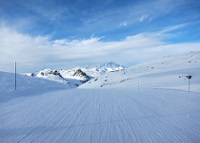
Photo credit: Su-May
The large and diverse network of well-groomed pistes more than makes up for any lack of charm, however, and the highest station at Aiguille Rouge Peak (10,584 ft/3,226m) guarantees excellent snow conditions from December to April. Its vast trail system has been linked to that of La Plagne, making the combined Paradiski area one of the largest interconnected ski and snowboard areas in the world.
Arc 1800 is the biggest and most popular of the four villages that make up Les Arcs, and is the most conveniently situated for all levels of skiers and non-skiers on holiday, while just below, Arc 1600 is smaller and suited to young families, although it can get busy on weekends due to the direct funicular link from the town of Bourg Saint Maurice.
More devoted snow enthusiasts prefer to head to the highest resort, Arc 2000, situated at the foot of Aiguille Rouge in the next valley, where the emphasis is on skiing and snowboarding rather than apres-ski holiday facilities. It has easy access to the glacier and is linked to Arc 1950 by a free cable car. Both 1950 and 2000 are invariably ski-in/ski-out all season.
There are a few other villages in the area that, while not officially part of the resort, are seamlessly connected and offer their own accommodation and ski areas as well. These include Vallandry, Peisey, Plan-Peisey, Le Pre and Villaroger.
Shopping in Les Arcs
Visitors on holiday in Les Arcs will find there are supermarkets and ski shops in all the villages, although Arc 1800 has the most choice. Arc 1950 also offers a wide range of shops, from clothes and souvenirs to sport equipment and rental. Arc 2000 has the least variety, but it's easy to get down to 1950 for more options. Most of the accommodation in Les Arcs is self-catering, and those who driving to resort can bring pre-prepared meals with them, or stock up in a supermarket en route where they'll find better prices and more choice.
Dining in Les Arcs
All the Les Arcs villages offer a variety of dining options to suit all tastes and budgets, from local specialities, pizzas, creperies and haute cuisine. Les Arcs 1800 has the biggest variety, and there is a good selection in 1950 too, while Arc 1600 and Arc 2000 have only a handful of restaurants to choose from. L'Arpette is one of the best mountain restaurants, situated just above 2000, although La Folie Douce now puts up still competition. Those staying in Les Arcs 1950 should consider booking Chalet du Luigi or Nonna Lisa, while Le 2134 Restaurant is a good option in 2000, and Chez Boubou and L'Escale Gourmande are popular choices in Arc 1800.
Activities in Les Arcs
There's loads of options for those who want a well-earned drink after a hard day on the slopes. L'Arpette Restaurant, just above 2000, has good music and a great deck for those who want to soak up the last of the sun, and La Folie Douce recently opened its doors just above 1800, bringing its legendary dancing-in-ski-boots apres ski vibe to Les Arcs. It's open until 7pm daily. 1800 has the most apres-ski options, while the other resorts are more family orientated and have a relatively low-key nightlife, although all the villages have plenty of bars and late-night watering holes.
Things to be aware of in Les Arcs
Other than in 1800, the Les Arcs village have limited nightlife and après-ski options, so those looking for a more hip and happening party scene might consider heading to another resort.
Skiing in Les Arcs
The vast terrain of Les Arcs offers good skiing for all levels of skiers and snowboarders, with easy access to the excellent nursery slopes from all the villages for beginners. Intermediates are the most spoilt for choice, with abundant blue and red runs throughout the area, while advanced skiers should head to the high pistes above Arc 2000 and the black runs on the Aiguille Rouge peak. Off-piste opportunities are also available in Les Arcs, although there's less choice than in some other resorts. Snow conditions on the higher pistes are generally good, and snow cannons keep the sunnier, lower slopes covered. There is also a good snowboard park with jumps and a half pipe at Arc 2000.
Overview
Sousse
Overview
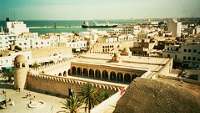
Photo credit: Stephen Thomas
Sousse is also favoured by Tunisians as a getaway destination, and locals enjoy mingling with visitors on the sandy beaches and busy promenade. Thankfully, the proliferation of modern resort hotels along the beachfront has not detracted from the charms of the inner city.
Sousse is still regarded as having probably the finest old city in Tunisia, even if is fairly small. A warren of narrow covered alleyways nestling below the ribat(fort) hides hundreds of colourful shops selling a myriad of local goods from carpets and porcelain to leather bags and olive oil. Outside the medina, there is also a vast modern shopping complex.
However, Sousse is not all just shopping and beach bathing. The town's museum, situated in the old kasbah(castle), is renowned for its collection of mosaics, masks, statues, and other relics of the Roman occupation. There are also several miles of well-preserved ancient Christian catacombs and marble tombs in the town.
Sousse offers its many package-tour visitors all the facilities and surroundings of a relaxing seaside holiday, overlaid with the undeniably foreign and exotic atmosphere of North Africa, all at extremely affordable prices.
Shopping in Sousse
There are bargains to be had in the alleyways of the Sousse old city for holidaymakers who can haggle successfully. Carpets and leatherware are favourite buys for tourists, but there is also a vast stock of cheap souvenirs on which to fritter away the holiday budget.
Some visitors are intimidated and do not enjoy bargaining with the souk shopkeepers, who usually begin negotiations with inflated prices. These visitors would be better advised to do their shopping in the adjacent modern shopping mall, which is crammed with shops offering local goods and wares from all over North Africa at fixed prices.
Dining in Sousse
Visitors to Sousse are spoilt for choice when it comes to dining out, with a variety of options available such as pizza, tapas, and French cuisine. Couscous is a local staple. Most of the better restaurants are located inside the luxury hotels; others are within walking distance of wherever visitors are staying.
Activities in Sousse
Nightlife for tourists is generally confined to the apartment resorts and hotels, and offers dancing and entertainment. Young Tunisians tend to gather on the beach promenade after dark.
Things to be aware of in Sousse
Many visitors have complained that shopkeepers in the medina are overbearing, and even frightening, in their persistence. There have also been reports of pickpockets being active in the alleyways.
Kardamena
Overview
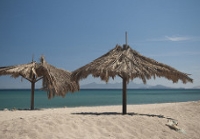
Photo credit: Anna & Michal
Shopping in Kardamena
Kardamena is packed with shops that offer everything from designer clothes to tacky holiday souvenirs. Most are located around the main square. Travellers who choose to stay in self-catering apartments can shop for well-known brands at good supermarkets or venture to some interesting local markets, including one across the water in Bodrum, Turkey.
Dining in Kardamena
Kardamena's restaurants range from Indian and traditional Greek, to fast-food establishments offering full English breakfasts. Many of the best Greek restaurants are clustered on the seafront.
Activities in Kardamena
Kardamena's fairly intense nightlife has dozens of bars and clubs that cater to a variety of musical tastes. Though not quite Ibiza, the scene is fun, vibrant and dominated by tourists.
Things to be aware of in Kardamena
All bars along the main strip of Kardamena's seafront have loads of touts working for them. Their efforts to turn tourists into patrons can become annoying after a few nights. Drinks can be expensive by Greek standards.
Kefalos
Overview
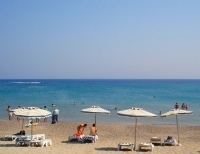
Photo credit: Kevin Gibbons
Shopping in Kefalos
The usual souvenir shops and grocery stores dot Kefalos. Seasoned shoppers usually find themselves heading to Kardamena or Kos Town, where there are more shops, markets and boutiques to choose from. Visitors can buy anything from homemade jams and honey to expensive, hand-crafted jewellery.
Dining in Kefalos
Kefalos boasts some of Kos' best restaurants. Travellers will find familiar international staples and exciting local options.
Activities in Kefalos
Though its nightlife isn't as well-known as some other Greek resorts, Kefalos is by no means boring. A number of low-key bars offer cocktails and live music.
Things to be aware of in Kefalos
The shingle beach in Kefalos can be very hard on feet. Visitors should wear good sandals.
Val Thorens
Overview
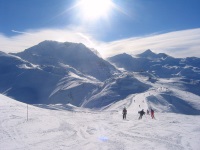
Photo credit: Elementerre
Shopping in Val Thorens
While not exactly a major shopping destination, Val Thorens does offer holidaymakers a variety of good ski shops and plenty of provisions are available for self-caterers.
Dining in Val Thorens
There is a wide choice of restaurants in Val Thorens catering for most wallets and holidaymakers' tastes. There are also some good mountain restaurants and it's easy to ski over to Meribel for lunch. As always it's best to take local advice and book ahead for the better restaurants.
Activities in Val Thorens
The nightlife in Val Thorens is more limited than in the larger resorts, but there are still a few discos and plenty of lively bars. The clientele are less likely to be English than in neighbouring Meribel.
Things to be aware of in Val Thorens
Due to its height and north-facing location, Val Thorens can be cold and bleak and has less off-slope activities on offer than many resorts.
Skiing in Val Thorens
The Trois Vallées ski area is one of the best and most extensive in the world (10 times larger than Vail, the largest ski resort in the States), and Val Thorens offers some of the best skiing in the area. It's possible to ski through Meribel to Courchevel for lunch and back within a day, but visitors should check the lift times before setting off. The Funitel des 3 Vallées is a lift designed to transport skiers between Val Thorens and the rest of Les Trois Vallées.
The slopes are high and mostly north facing, so there's likely to be a good covering of snow well into spring. There are a wide variety of slopes for beginners and intermediates and some challenging slopes for more advanced skiers higher up, including the Cime de Caron, a steep descent from the top cable car.
Val Thorens also offers access to some excellent off-piste options, the descents towards Lac du Lou being the most famous. Even the most experienced skiers and snowboarders should hire a guide when going off-piste, both for safety and to find the best snow.
Cancun
Overview
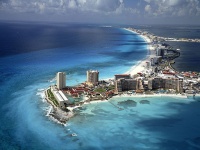
Photo credit: safainla
The hotel zone, situated on a thin strip of land (Isla Cancun) in the shape of a figure '7', is what people imagine when they talk about Cancun. It is a vision of Caribbean paradise with soft white sand beaches and clear blue-green waters. There is plenty of high quality holiday accommodation available, a wide choice of restaurants and shops, a notoriously energetic nightlife, and an array of activities, including both land and water sports. Cancun is also a good base from which to explore some of the nearby attractions, particularly the ancient Mayan site of Chichén Itzá on the mainland, which is the best restored and most famous of the archaeological sites on the Yucatán Peninsula.
Shopping in Cancun
Shoppers can rejoice in Cancun, with a choice of seemingly endless shopping facilities, from ultra-modern malls with chic boutiques to street vendors, open-air markets and department stores. The Plaza la Fiesta is a favourite shopping venue in the Hotel Zone, and there is also a popular handicraft bazaar, El Zocalo, opposite the Convention Centre. Numerous malls line the main drag of Paseo Kukulkan that runs down the eight-mile (13km) hotel strip. Prices, however, are better in Cancun City itself, also known as Centro, on the mainland. There are some good shops along Yaxchilan Avenue, and the market on Tulum Avenue is recommended for buying silverware and Mexican handcrafts.
Credit cards are accepted almost everywhere in Cancun. If you use cash you may have the 15 percent sales tax deducted if the shopkeeper is willing. Expect to bargain in the markets. If offered black coral, refuse, because it is an endangered species and you could run into problems taking it back home. Shops in Cancun are generally open between 10am and 2pm, and 4pm and 7pm on week days. Many stores choose to stay open during the 'siesta' hours from 2pm to 4pm, but some may close. On Saturdays most shops only open for the morning. A few open on Sunday until 1pm. Shops in malls tend to open weekdays only from 10am to 8pm.
Dining in Cancun
Cancun's wide variety restaurants will be able satisfy every palate, with high-class eateries and familiar franchises, to taco stands and fast-food joints. Those who wish to eat like the locals can be assured that Yucatan cuisine is regarded as the finest in all Mexico, combining Mayan and Spanish influences. Local dishes worth sampling include cochinita pibil (suckling pig baked in banana leaves with annatto sauce) and panuchos (tortillas with fried black beans, chicken and pickled onions). Seafood is also plentiful. A popular romantic option is to book for one of the numerous dinner cruises offered.
For a true taste of Mexico visitors can pay a visit to one of the many cantinas, traditional bar-restaurants, which are situated mainly around the downtown bullring. The atmosphere at the cantinas is particularly lively on Wednesday afternoons after the weekly bullfights, but the food and drink is good quality and good value for money every day of the week.
Activities in Cancun
Cancun's nightlife is legendary, with its huge choice of nightclubs, discos and bars to suit every mood, from romantic to raunchy, funky to frenetic, rock to reggae and salsa to techno. After dark the city, particularly the Hotel Zone, comes alive, with most clubs opening around 10pm and pumping out the music until sunrise, or later, the next morning.
Most clubs and pubs offer a continual variety of promotional or theme evenings, with foam parties, mini-skirt and bikini contests being hot favourites. Most offer ladies nights with free drinks for women. Hip and happening parties can be found at Dady Rock, Bulldog, The City, Dady O and Coco Bongo's nightclubs, all offering massive dance floors and pumping beats. The Party Hopper tour is a popular way to enjoy a number of Cancun's top nightlife venues; visitors pay about US$75 for free drinks and entry into three of Cancun's top clubs and bars.
Those seeking some more cultural entertainment should not miss the internationally renowned Ballet Folklorico, which holds performances in various venues around Cancun, featuring lavish costumes and traditional dances.
Things to be aware of in Cancun
Cancun is a fantastic vacation destination, even during peak season, and perhaps it has been justifiably called 'vacation utopia'. The resort is expensive, but most hotels offer all-inclusive rates which are generally good value. Petty crime is common, but sensible precautions should ensure there are no problems. Some visitors are afflicted by cases of diarrhea and fever, known colloquially as 'Montezuma's revenge', caused by unfamiliar bacteria in water and food. This can be avoided by drinking bottled water and taking care about over-indulgence in spicy Mexican foods, margaritas or Mexican beer.
Cancun's beaches are extensive and spread out enough to never become too overcrowded even in peak season. The resort is exceptionally busy during America's Spring Break in March, when it is the favoured destination of thousands of college students from North America; those wanting a more relaxing and less frenetic holiday should visit Cancun outside this season.
Courchevel
Overview
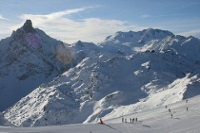
Photo credit: Ian Gratton
Shopping in Courchevel
Courchevel 1850 offers the best shopping, ranging from ski shops to expensive designer boutiques. The lower resorts all have ski shops and mini-supermarkets as well as a fine selection of bakeries and delicatessens.
Dining in Courchevel
Courchevel 1850 has the best and most expensive restaurants in the holiday resort; however, all the resorts have a good choice of reasonably priced, good quality restaurants.
Activities in Courchevel
All the villages have their own nightlife to offer holidaymakers, although most visitors make the trip to Courchevel 1850 for the liveliest clubs and bars.
Things to be aware of in Courchevel
Courchevel 1850 is very expensive and no longer feels particularly French. As a rule, it is cheaper the lower visitors go; Moriond and Courcheval Villiage cost no more than other well-known resorts. During school holidays some slopes can get very crowded although the lift queues are rarely bad.
Skiing in Courchevel
The Trois Vallées ski area is one of the best and most extensive in the world (10 times larger than Vail, the largest ski resort in the United States), and Courchevel offers arguably the best skiing within the area - the snow is more reliable than Meribel, which gets more sun. There are lots of easy slopes for beginners beneath the Saulire cable car base station, and there is lots of choice for intermediates in both Courchevel and neighbouring Meribel. Advanced skiers will enjoy the reds and blacks above La Saulire; there are also some challenging north-facing slopes above Val Thorens, which can be reached within a day's skiing. Snowboarders will find some great slopes for cruising and some exciting couloirs for experts. When the snow is fresh there is some good off-piste, but it is advisable to go with a knowledgeable guide. There are several good ski schools in Courcheval, in addition to the state-run ESF, such as New Generation, which has offices in both Moriond and Courchevel 1850.
Albufeira
Overview

Photo credit: all4u+
Albufeira, Portugal's most popular holiday resort, has been described as a stretch of 'holiday-land suburbia', spreading from the old town both east and west along the coast, its sandy coves and golden beaches drawing an assorted crowd from retired couples to wild teens, and plenty of families with young children. Satellite resort developments provide every imaginable type and grade of accommodation.
Everyone finds something to enjoy in this sprawling, low-rise holiday destination, which retains its old world charm in narrow alleyways behind the new hip and happening "Strip". The Strip, to the east of town, runs from the Montechoro Hotel down to the Praia da Oura, lined with dozens of cafés, restaurants and bars that keep pumping from breakfast time to the small hours. On the long stretch of beach below Albufeira's central square, accessed through a tunnel, craggy fishermen mend their nets, unperturbed by the languishing topless sunbathers around them.
While the chief holiday attraction of Albufeira is its numerous enchanting beaches, most protected by ochre-tinted cliffs, there are some interesting sightseeing possibilities too, like the new Virtual Archaeological Museum, the Municipal Art Gallery and a small museum showcasing Ming ceramics. Those who venture inland will find a tranquil green countryside to explore, replete with almond, fig, orange and pine trees, where little villages stand timelessly in the sun.
Shopping in Albufeira
From seafront kiosks full of fun-in-the-sun odds and ends to a full on shopping mall experience, Albufeira can keep most shoppers reaching for their wallets with a tantalising array of merchandise. The town's main shopping plaza is the Modelo Centre in Rua de Municipio, north of downtown. Not far away is the lively Algarve Shopping Complex in Guia, where brand name shoes and clothes are on offer in a high street mall type complex, along with restaurants, an English-language cinema and bowling alley. Those seeking genuine local souvenirs should look out for mats made from rush or cornhusks in the villages of Almeijoafras and Monte Novo, woven baskets, woodcarvings and some glazed terracotta ceramics. These are to be found in numerous independent shops in the town centre as well as local markets.
Dining in Albufeira
Like everywhere in Portugal, seafood is the speciality of the house in most of the dozens of restaurants in and around Albufeira. The catch of the day is guaranteed to be fresh in this traditional fishing town, particularly in the eateries clustered at Fisherman's Beach, below the main town square. Specialities to seek out are sardines, flounder and bass, lobster and prawns. A true local dish is Caldeirada, a stew made up of several types of fish, cooked up with potatoes, peppers and parsley. Steamed clams, cuttlefish cooked in their ink and octopus salad are other indigenous culinary adventures. The local wine is a worthy accompaniment.
Activities in Albufeira
After a day in the sun most holidaymakers enjoy sipping a drink at one of Albufeira's many outdoor cafés, watching the world go by, before adjourning to one of the lively bars that surround the town square or line The Strip. Bars keep hopping until three or four in the morning, but those who want to dance the night away can keep going until sunrise at one of the nightclubs or discotheques that are ten a penny in the town.
Things to be aware of in Albufeira
During the height of summer Albufeira is a favoured holiday destination for young singles, and it can become a bit rowdy at night.
Altinkum
Overview
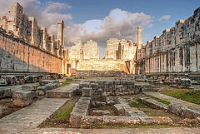
Photo credit: Natalie Sayin
The resort town's main attraction are its three long sandy beaches that stretch from the small harbour at one end of a gently shelving bay to a rocky cliff at the other end. Little wonder that the name Altinkum means 'golden sands'.
In this resort devoted to leisure and lazy days on the beach, visitors can also indulge in water sports. Alternatively, evenings are spent trying out the laidback restaurants and bars, many of them serving British fair. Those yearning for sightseeing will find Altinkum perfectly placed to visit two major ancient sites, the Temple of Apollo at Didyama and the vast Roman ruins at Ephesus.
Shopping in Altinkum
Holidaymakers should brush up on their haggling skills as shopping opportunities abound along the pedestrianised seafront of Altinkum, which is packed with souvenir shops, jewellery stores. and boutiques selling copies of designer clothing.
The main centre is Dolphin Square, and there is a modern shopping complex called the Didyma Shopping Mall not far away. Self-caterers will find all the provisions they need at the two main supermarkets, Gima and Migros, between the seafront and town centre.
Dining in Altinkum
Altinkum is bursting with good restaurants serving most forms of international cuisine, although Turkish and traditional English predominates to cater to the demand of holidaymakers. With such a feast of eateries it is difficult to single out any particular establishment, but for the best of British it is hard to beat Ali Baba's for friendliness, price, and quality. Barney's Restaurant prides itself in introducing visitors to the delights of Turkish cuisine.
Activities in Altinkum
While it is not as rowdy as the major Turkish holiday resorts, those who wish to indulge will find plenty of after-dark entertainment and fun in Altinkum, where nightlife is centred mainly in Dolphin Square and in the bars along the sea front promenade. Everything from disco dancing, karaoke, and belly-dancing to bingo and pool is on offer, the entertainment fuelled by cheap drinks and cocktails. Clubbers are catered for during the height of the summer season at Medusa, an open-air night club that is regarded as Altinkum's best party. Another hot favourite for young people is the Dolphin Bar.
Things to be aware of in Altinkum
During the local Turkish summer break in August, Altinkum is a favourite destination and can become rather overcrowded. Visitors should also be aware that temperatures can be extremely high in summer.
La Paz
Overview
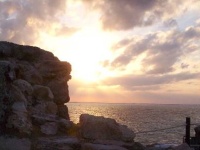
Photo credit: Rick McCharles
La Paz is the eco-tourism capital of the country, surrounded by desert and situated in a large bay on the Sea of Cortez, with a variety of outdoor tour guides offering excellent trips. The region boasts astonishing plant and animal life, the varied and dramatic geology of the inland deserts, mountains and oases, and the Sierra de la Laguna Biosphere Reserve. Beautiful unspoilt offshore islands offer naturalist hiking, as well as amazing diving and snorkelling from pristine beaches with hammerhead sharks, dolphins, sea lions and gigantic whale sharks. The islands are the destination of kayakers, sailors and boat cruises, and the bay is a popular yachting stopover. La Paz is a fisherman's paradise and its international fishing competitions are world famous. To the north of the city, along the Pichilingue Peninsula, are some magnificent beaches, backed by mangroves and the cactus-studded mountains of the desert.
Besides the eco-tourist activities on offer, La Paz boasts plentiful shopping, a varied nightlife, excellent fish and seafood, and comfortable accommodation, offering visitors everything they need for a relaxing and stimulating holiday.
Shopping in La Paz
From small, exclusive boutiques lining the Malecon, to the department stores of busy downtown La Paz, known as 'El Centro', the city offers plenty of options for lightening the pocket, with high fashion and upmarket branded goods aplenty. There are also numerous stores selling locally produced Mexican arts and crafts to delight souvenir hunters on holiday, and supermarkets on just about every street corner for self-caterers.
Dining in La Paz
There are delicious treats to suit all tastes available in the many restaurants of La Paz, from the highly rated street corner hotdog and chocolate clam stands, to mouth-watering lobsters from the Sea of Cortez served up in classy seafront restaurants. The cuisine of most nationalities is available, including Chinese, Italian, French and Korean, but traditional Mexican naturally remains the holiday favourite.
Activities in La Paz
La Paz has no shortage of lively nightspots, with the most popular located along the Malecon. This brightly lit promenade and adjacent pier is abuzz with strollers and party-animals after dark, entertained by groups of street musicians known as mariachis. Shops stay open late to cater for evening browsers. Like in most Mexican cities, the party action doesn't start hotting up until late in the evening, from around 10pm, but continues until the early hours of the morning. Discos offer all kinds of music, from traditional Latino to American rock, and many of the bars and restaurants offer live music. La Caliente and Las Varitas are great night spots and live music venues. Culture vultures will probably find a play or concert to their taste at the Teatro de Ciuidad or Teatro Juarez, and there are several movie theatres showing American films with Spanish subtitles.
Things to be aware of in La Paz
La Paz can be expensive during peak season.
Hammamet
Overview
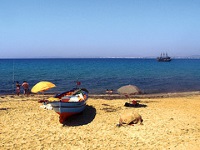
Photo credit: Marcin Grabski
Once a sleepy fishing village, Hammamet (meaning 'the baths') was awakened to its tourist potential back in the 1920s when a flock of wealthy American and Europeans decided to make it their playground.
Today it has become a destination mainly for middle-to-upper range package tours from Europe, the streets abuzz with holidaymakers speaking Swedish, German, English and French. Despite its modern architecture, Hammamet retains its sense of exotic history. It is dominated by its 15th-century medina and souk(bazaar), where visitors can purchase items such as carpets, brass ornaments, jewellery, traditional kaftans, pottery, and leather goods.
The narrow winding alleys also conceal bright, whitewashed windowless houses behind splendid ornate doors. The town's baths, famed since Roman times, are also situated in the crowded medina, alongside ancient mosques and over-shadowed by the medieval castle or kasbah.
The big attraction of this seaside town, though, is its six-mile (10km) stretch of palm-fringed shore, boasting beautiful sandy clean beaches, decorated with colourful fishing boats. South of the old town along the beach, a plethora of attractive Moorish-style low-rise hotels set in stunning lush gardens has mushroomed, offering visitors luxury accommodations, watersports, entertainment, gourmet restaurants, and all the trappings of a perfect holiday.
Shopping in Hammamet
Shopping in the medieval souk (bazaar) in Hammamet is one of the most memorable holiday experiences for visitors. They often go home laden with attractive souvenirs. A treasure-trove of irresistible goods such as exotic carpets, embroidered kaftans, glittering hookah pipes, brassware, jewellery, leather goods, and pottery are on offer to delight avid shoppers. It is expected to haggle over price. Those needing to buy more practical goods will find what they require in the modern shopping centre.
Dining in Hammamet
Most hotels catering for holidaymakers in Hammamet have their own restaurants, but the town itself overflows with a variety of eateries and pavement cafes where it is possible to find anything from fish and chips to pizza. However, no visit to Tunisia is complete without sampling the renowned local dishes, though they can be overly spicy.
Among the specialities to sample are couscous (steamed semolina grains mixed with vegetables, fish, chicken, or meat), brik (pastry filled with egg, herbs and tuna), choba (thick, creamy tomato soup), and makroudh (a syrup-soaked honey cake stuffed with dates).
Activities in Hammamet
Nightlife in Hammamet is low-key, with no all-night clubbing experiences on offer. Most hotels offer dancing and entertainment, and there are numerous bars and discos catering for visitors, most closing by midnight however.
Things to be aware of in Hammamet
Care is required when swimming in the sea, as there are some unexpected deep patches near the shore. Vendors of souvenirs in Hammamet can be irritating and an annoyance to holidaymakers on the beach, and some find shopkeepers in the medina a little too pushy and overbearing.
El Gouna
Overview
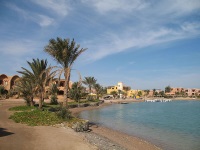
Photo credit: Marc Ryckaert
Linked by lagoons, this luxurious resort has an air of fantasy about it. El Gouna is not only an exquisite holiday resort but also a residential area with a vast range of villas, designed by world-renowned architects, all boasting breath-taking views of the sea and the surrounding mountains. Its infrastructure caters to an active, yet relaxed and friendly lifestyle.
Shopping in El Gouna
Shoppers can pick up a wide variety of items in El Gouna, ranging from typical Egyptian souvenirs, antiques and art to exotic oriental furniture and hand-made Turkish lamps. There is also a selection of chic shops for clothing and furniture. Along the marina boardwalk there are international brands and boutiques offering a taste of Europe.
Dining in El Gouna
El Gouna has two prominent tourist districts, namely Kafr El Gouna and Abu Tig Marina, as well as many prominent hotel chains, all offering a wide variety of some of the world's finest cuisines, from Indian to Thai, French, Belgian, Chinese, German, Italian and much more. Not all local restaurants serve alcohol, but the food is excellent. El Gouna offers everything from relaxed marina-side bistros, seafood buffets and poolside eateries to five-star restaurants.
Activities in El Gouna
Holidaymakers will find that El Gouna's nightlife is pulsing with variety and entertainment. The two main hubs of Kafr el Gouna and Abu Tig Marina offer the trendiest bars, alongside cosy pubs, billiard bars, beach bars, karaoke cafes, and the infamous open-air disco. There are often live concerts and social events, including Barbeque Beach parties.
Things to be aware of in El Gouna
The beach is far from the resort and can only be reached by a bus ride or a ferry trip across the lagoon. Luckily these transport services run very regularly.
Kas
Overview
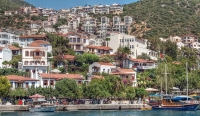
Photo credit: Natalie Sayin
It is the centre for glass-bottomed boat trips to the sunken cities around Kekova Island, where remains of mysterious civilisations can be viewed just below the surface of the water. Visits can also be arranged to the surrounding archaeological sites at Demre, Myra, and the Xanthos Valley. The town is built around the remains of ancient Antiphellos, and there are ruins of a Hellenistic theatre, the monumental Lion Tomb, and some hillside rock tombs in and around the town.
Despite attracting thousands of holidaymakers every year and the tourist development of what was once a simple fishing village, Kas still preserves its small-town charm with narrow cobbled streets and novel boutique shops.
Shopping in Kas
With plenty of good shopping available, travellers will have to sift through the dozens of carpet shops, souvenir stalls, and counterfeit sportswear to find the true gems. The best places to shop in Kas are the little boutiques that sell tools, hand-carved artefacts, local silver and gold jewellery, and plenty of Turkish kilims (handwoven rugs).
Dining in Kas
Kas is home to a growing number of cafes, restaurants, and patisseries. Visitors will be spoilt for choice when it comes to dining out. Boasting all kinds of cuisine from around the Mediterranean, including fresh local seafood to meze (similar to Spanish tapas). Eating out in Kas is a culinary experience to remember and one that will linger on visitors' taste buds for hours afterwards.
Activities in Kas
When the sun sets on the fishing town of Kas, the streets come to life with bars and cafes emitting warm glows of light, laughter, and local music. The romantic feel to the town makes it a popular choice for couples, meaning there are not as many trendy dance clubs as other Turkish resorts and young singles should head elsewhere if looking for a lively night out.
Things to be aware of in Kas
The two main beaches in Kas, Buyuk Cakil (Big Pebble Beach) and Kucuk Cakil (Little Pebble Beach) are both shingled, so many visitors tend to visit the nearby beach of Patara.
Steamboat
Overview
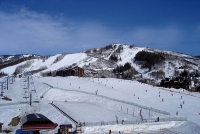
Photo credit: CarTick
Shopping in Steamboat
There are plenty of shops throughout Steamboat selling everything one could possibly want for a skiing and snowboarding holiday. Apart from regular groceries and food supply stores and the ubiquitous outdoor apparel shops, determined shoppers will find a variety of speciality stores selling things such as collectibles, arts and crafts and high-quality clothing.
Dining in Steamboat
There are more than 75 bars and restaurants in the Steamboat area, ensuring a broad offering for visitors. Live country music is the order of the day in many bars, enhancing the traditional cowboy appeal of Steamboat.
Activities in Steamboat
There is something for all tastes in Steamboat, with numerous bars and restaurants staying open late when the beer, wine and tequila flows a lot freer. Happy hours, live music and beer on tap is never hard to find, but travellers shouldn't expect a large variety of nightclubs.
Things to be aware of in Steamboat
In recent years the big reputation has left some advanced skiers disappointed with the over-hyped terrain.
Skiing in Steamboat
Steamboat gets reliable dumps of some of the finest 'Champagne Powder' (a term coined in Steamboat) in the world. There are about 165 named trails spread out over 2965 acres (1200km) across five mountains. There is something for every level of skier but most runs fall in the intermediate and advanced categories. There are 18 lifts in total, ensuring a rapid delivery of skiers to the top of the runs. Steamboat also has the longest Superpipe in North America, an absolute dream for freeriders.
Kuta
Overview
Photo credit: Rudolph Furtado
A holiday must for every visitor in Kuta is a visit to the nearby Temple of Tanah Lot, Bali's most holy place and a magical experience when viewed at sunset.
Shopping in Kuta
Kuta is swarming with shops and holiday shoppers, with clusters of stores and stalls all selling much the same goods, waiting for customers to barter on the prices. Accessed either from the beach or Kuta Square is the vast, fun market area where you can buy things like CDs, kites, sarongs, shoes and lots of fake brand name clothing. Local handcrafts, jewellery and custom-made leather goods are good buys. Visitors are usually assailed by pushy street hawkers selling goods like fake watches, and are expected to haggle on prices, which are often quoted in US Dollars.
Kuta is also well supplied with department stores and shopping centres where prices are fixed, like the new Discovery Mall on Jalan Kartika Plaza. Around Kuta Square you can have a spending spree at dozens of brand name stores where goods (the real thing) are sold at amazingly low prices.
Those who are keen to buy local crafts, hand-made jewellery or traditional wood and stone carvings will do well to take excursions into surrounding villages where these arts are practised; some handcrafts are available in Kuta, but better examples can be found a bit further afield.
Dining in Kuta
On holiday in Kuta, you can find anything from Japanese sushi to Wiener schnitzel, pizza to paella, and enchiladas to burgers. Sometimes the taste is not quite as expected because these international favourites have been adapted to suit local tastes and ingredients. If you want to play it safe stick to McDonald's or Pizza Hut! On the other hand, travellers yearning for more authentic local food can brave the rather primitive little roadside food stalls, warungs, to sample local cuisine like Bakso soup, or pick a padang, which is a 24-hour diner displaying a dozen or so different dishes in a glass box at the door where you can sample them all for just a few US dollars. Be warned that wherever you dine wine and beer is very expensive; try locally produced versions which are better value than the familiar imports often enjoyed by tourists.
Activities in Kuta
Whatever your choice for after-dark entertainment you will find it in Kuta, which is the main party district of Bali. Evenings usually start with witnessing spectacular sunsets over cocktails, progress through a leisurely dinner and then around midnight the partying starts, either with a pub crawl, club rave, a rhythmic Balinese dance show or a Wayang Kulit shadow puppet performance. Cafés, pubs and discos line the streets of Kuta, but nothing gets going very early, with the serious party venues often only starting to peak at about 2am. There are also often special events, like beach full moon parties, or body-painting parties, which are announced by way of flyers handed out around town.
Things to be aware of in Kuta
Currents and a strong undertow make Kuta's beach dangerous for swimming. The beach can also be over-crowded and flooded with vendors hawking all manner of goods. The roads can be dangerous after dark, with a number of potholes on the streets and more than a few drunken drivers.
Branson
Overview
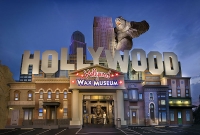
Photo credit: momwriter
In fact, more than seven million visitors holiday in Branson annually. At night, the main road called the Strip is filled with visitors to the mass of theatres and theme parks. Branson's best-known attraction is Silver Dollar City, a combination of craft village and theme park. Branson Landing offers world-class shopping and dining options along the waterfront and features a nightly water show.
The beautiful area around the lakes, particularly Table Rock Lake, and the hills and valleys of the Ozark Mountains, allows for a peaceful escape from the town, providing excellent opportunities for fishing, hiking, camping, and water-based activities.
Shopping in Branson
Branson is a paradise of outlet malls and factory shops, but the most popular place to shop is Branson Landing, a pedestrian waterfront on Lake Taneycomo with more than 100 shops and restaurants. There's even a 'town square' with synchronised fountain and fire shows. Apple Tree Mall is a huge flea market with plenty of antiques. For the biggest bargains though, head to the Tanger Outlet Center or Factory Merchants Branson.
Dining in Branson
There is no shortage of family-friendly restaurants in Branson, ranging from steakhouses and barbecue joints to Mexican cantinas and seafood restaurants. A good budget option for families with picky eaters is the Grand Country Buffet, while Dolly Parton's Dixie Stampede Dinner and Show is great for a special night out. Another popular restaurant is the White River Fish House, a seafood and steak restaurant with good views and interesting local foods like alligator and catfish.
Activities in Branson
While Branson is primarily a family-friendly resort, there are a few bars and nightclubs in town. A number of restaurants, including the perennially popular Outback, offer pub and bar sections with live music in the evenings that become party hotspots for adult visitors to Branson, and The Club at Lodge of the Ozarks is popular with younger crowds, with entertainment like comedy shows accompanying supper.
Things to be aware of in Branson
Branson can get uncomfortably crowded in peak season, and travellers without children looking for nightlife may be disappointed.
Mammoth Mountain
Overview
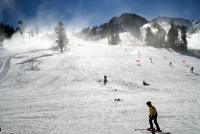
Photo credit: Plane777
Shopping in Mammoth Mountain
Mammoth Mountain has an interesting and varied selection of stores that will keep holidaymakers enthralled. There are several art galleries, a souvenir shop called 'Mammoth Memories' selling branded items, sports equipment outlets, designer boutiques and even a store that sells Christmas decorations and goodies all year round.
Dining in Mammoth Mountain
The village of Mammoth Mountain itself has plenty of dining options, and holidaymakers who are able to reach further afield will find the surrounding area has dozens of restaurants to choose from, whether they're craving a quick burger or are inclined to have a full course dining experience. Some of the favourite spots are John's Pizza Works and Roberto's Mexican Cafe. Travellers should try the Lakefront Restaurant at Tamarack Lodge for delicious California French cuisine, and Shea Schat's Bakery for terrific pastries, freshly baked bread and moreish apple fritters.
Activities in Mammoth Mountain
Apres-ski in Mammoth Mountain begins around 3pm each day when the first thirsty skiers and holidaymakers run straight to the door of the Yodler Restaurant and Bar. Later, visitors head to local bars such as the Hawaiian flavoured Lakanuki bar and Mammoth Tavern. The Clocktower Cellar Pub and the Side Door Cafe are also popular nightspots.
Skiing in Mammoth Mountain
Mammoth Mountain caters to all levels of skiers and snowboarders, from steep chutes, moguls, tree skiing, wide open bowls, beginner trails and wide well groomed slopes. Mammoth Mountain is as big as its name implies with 3,500 acres of terrain and a vertical drop of 3,100 feet (945m), 150 named trails and 27 lifts. Snowboarders can also enjoy three unbound terrain parks with halfpipes, a quarter pipe and jib park.
Overview
Heraklion
Overview
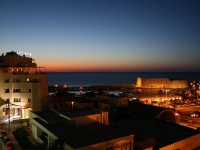
Photo credit: bongo vongo
The main square, Plateia Venizelou, is a pedestrian mall sporting cafes and restaurants, and some fascinating shops in the surrounding streets. History buffs should visit the archaeological museum, which contains the world's most comprehensive collection of Minoan artefacts, dating back to around 1600 BC. Heraklion is also close to the major archaeological site associated with the Minoans at Knossos.
Shopping in Heraklion
Heraklion is Crete's commercial centre and has a great many shops with top designer labels and original jewellery for reasonable prices. Antiques, leather goods, folk art, olive oil and a variety of interesting cheeses are on offer as well. Some shops may have reduced operating hours during the winter off-season.
Dining in Heraklion
Crete offers traditional Greek food in its cafes, local tavernas and elegant restaurants. The island is also home to many ouzeri bars that specialise in the aniseed-flavoured liqueur called ouzo. Many of the destinations fast-food outlets and restaurants serve international favourites such as pasta, pizza, Indian and Mexican food.
Activities in Heraklion
People-watching from a sidewalk cafe is a favourite evening pastime among locals in Heraklion. The city also has many clubs and bars.
Things to be aware of in Heraklion
Heraklion is a busy, overcrowded city that can be claustrophobic and noisy. Hotel standards do not always live up to expectations and visitors are often harassed by touts outside the restaurants and cafes, particularly in Fountain Square.
Los Gigantes
Overview
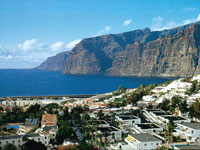
Photo credit:
Shopping in Los Gigantes
Uphill from the marina is the resort's commercial centre, with plenty of shops ranging from supermarkets to upscale fashion boutiques and a convenient pedestrian zone near the church. The nearby village of Masca also has a few independent souvenir shops that sell unique items like local pottery, liquor made from bananas or honey, and embroidered tablecloths and clothing. Los Gigantes is a good resort for shopping and the proximity of a number of other resorts and villages ensures there is plenty of variety.
Dining in Los Gigantes
There are quite a few restaurants and bars at the marina, and seafood is the local speciality (paella is always a good bet in the coastal regions of Spain!). While at the popular holiday destination of Los Gigantes, it's essential to sample the fine cuisine at Krishna's. El Rincon de Juan Carlos and Jardin del Sol also garner rave reviews from foodies and casual diners alike. Guests may not smoke indoors in most restaurants, but smoking is allowed on covered verandas and in marked areas.
Activities in Los Gigantes
Although Los Gigantes has a selection of bars and even nightclubs, it is a peaceful resort and does not have an energetic nightlife. Much of the live music and entertainment in Los Gigantes is provided by the hotels and restaurants. Visitors will hear jazz, salsa, rock music, and the local folk music called Tenderete. Most of the bars and clubs in the resort are centred in Santiago Bajo.
Things to be aware of in Los Gigantes
Los Gigantes is hilly, with narrow streets that can be difficult to traverse for people with mobility issues. Youngsters in search of a party may be disappointed with the sedate nightlife.
Torremolinos
Overview
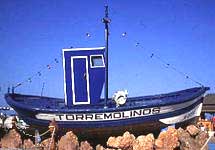
Photo credit: Jason Dixon
Shopping in Torremolinos
There is a great variety of shops in Torremolinos, ranging from international clothes stores and designer boutiques to lots of small touristy shops selling souvenirs. Good buys include the local jewellery, leather goods and the famous Spanish Lladro porcelain. For self-caterers, there is a good selection of corner shops and supermarkets stocking well-known international brands. Calle San Miguel is at the heart of the Torremolinos shopping scene: it is an attractive pedestrianised street, flanked by small shops and cafes and is a good place to sip sangria and people watch for those not interested in shopping. More extensive shopping can be found in nearby Malaga.
Dining in Torremolinos
Torremolinos is packed with restaurants catering for the tourist trade and menus, usually in a few languages, offer good international staple dishes such as fish and chips, steak, pasta and schnitzel. Popular options include Kate's Cottage and Bistro Europa. However, some excellent Spanish restaurants are also around, particularly those serving tapas. The best seafood restaurants are in the fisherman's district of La Carihuela, which has been relatively undisturbed by high-rise hotels and has retained its Andalucian coastal charm. The upmarket harbour at Puerto Banus is only ten miles (16km) along the coast and is packed with good restaurants overlooking rows of expensive-looking yachts. For something a little different try The Carvery (Italian), The Kathmandu Nepali Indian Restaurant (Indian), and Shang Hai Restaurante Chino (Chinese).
Activities in Torremolinos
The nightlife in Torremolinos can be fairly intense, with dozens of bars and clubs catering for all tastes and persuasions. A good place to start the evening is in one of the tavernas in Calle San Miguel or in one of the cafés and restaurants that line the promenade. Torremolinos is also home to the chiringuitos beach cafe/bars, focused in La Carihuela. The clubs start to open at around 10pm and the Palladium disco is a great favourite. The best selection of clubs is along Avda Palma de Mallorca. There is a big gay scene in Torremolinos centred on La Nogalera, where the clubs vary from the mainstream to drag bars. Exotic shows are a feature here and are popular with both the gay and straight visitors.
Things to be aware of in Torremolinos
Tourists are regularly pestered by salesmen selling everything from trinkets to timeshare apartments in Torremolinos. The centre of the resort is fairly run-down in places; the suburbs of Benalmadena and Fuengirola are cleaner, friendlier and cheaper.
Tossa de Mar
Overview
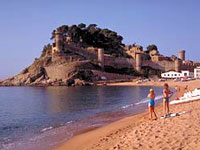
Photo credit:
Shopping in Tossa de Mar
Shopping in Tossa de Mar offers a selection of Spanish souvenirs, including ceramics, leather goods, and clothing. Most shops are open from 10am to 8pm, closing briefly for siesta in the afternoons. For true bargain hunters, the duty-free shopping of Andorra is only an hour away by car, and the wonders of Barcelona are also easily reached.
Dining in Tossa de Mar
The prices at restaurants in Tossa de Mar tend to go up the closer you get to the beach. With over 300 places to eat in Tossa de Mar, there are a range of cuisines to choose from, including tapas, traditional Spanish cuisine, and various international offerings. Tursia, La Luna, Restaurant Pizzeria Bar Lluis, and L'Ajustada all come highly recommended in Tossa de Mar for good food.
Activities in Tossa de Mar
Tossa de Mar doesn't have a wild nightlife culture for young singles; however, there are plenty of bars and restaurants for a more relaxed night out. Many restaurants host live music and stay open past midnight during the summer tourist season. Bars such as Ardilla or Tahiti are good venues to find Spanish music such as rumba or flamenco, and Trinquet is the place to go for acid jazz. Other places such as Chaplin's and The Mediterraneo are popular with British tourists.
Things to be aware of in Tossa de Mar
Tossa de Mar's popularity in summer means it can be extremely hard to find accommodation unless booked well in advance. During low season it can be very quiet, with not much of a nightlife.
Calis
Overview
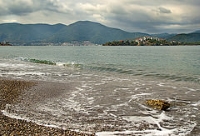
Photo credit: Tim Fields
The Calis beach is long and narrow, with a mix of sand and shingle, and, as in Dalyan, a population of loggerhead turtles gathers here to lay eggs at certain times of year. Calis is also a dolmus(minibus) or water-taxi ride away from neighbouring Fethiye for those seeking bigger crowds. The best way to enjoy a Calis holiday, however, is to grab a seat at a beachfront cafe with cameras at the ready, and enjoy a cocktail as the sun dips below the horizon.
Shopping in Calis
A little way out of town is a lovely market that takes place on Sundays, with the usual selection of very well priced fake designer items, as well as spices, teas and foods. There is also a small selection of shops selling beachwear, sporting equipment, and local handicrafts.
Dining in Calis
Calis has a variety of restaurants, with an emphasis on Chinese, English, and local Turkish cuisine. The Sultan Bakery is known for its great baklava, or travellers can visit the fish market in Fethiye and choose their own fresh seafood.
Activities in Calis
The nightlife in Calis is very laidback with a few late-night bars which host events such as foam parties, karaoke and salsa nights, but for a wild party tourists can head to nearby Fethiye. Like most resorts, the most popular clubs are located along the beachfront.
Things to be aware of in Calis
Calis is quiet, and not suited to those looking for a lively nightlife. It's best suited to families and older couples.
Lovina
Overview
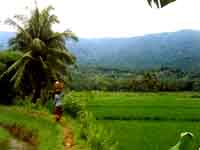
Photo credit: Judith Duk
Colourful Balinese boats take Lovina tourists out to see the sociable dolphins, most active at sunrise, and the reef-protected waters provide a calm environment for snorkelling. Situated between the main diving sites on the north coast of Bali, Lovina is a good base for diving excursions. The black-sand beaches are calm and good for swimming. Bali's only Buddhist monastery, Brahma Vihara Arama, is a few miles away and can be combined with a visit to the delightful Air Panas hot springs at Banjar, another great holiday attraction.
Shopping in Lovina
The holiday resort of Lovina is actually a string of small villages strung along the coast, centred on the main town, Kalibukbuk. Here there is a western-style shopping centre and a variety of souvenir shops, where plenty of Balinese beachwear and tourist necessities are available. For serious shopping make excursions to the south, and to the villages where local craftsmen produce stone and woodcarvings, and jewellery designs.
The most popular souvenirs from Lovina are the carved wooden dolphin statues, but don't believe the touts who try to convince you that they are ebony.
Dining in Lovina
Don't expect to find many gourmet establishments while on holiday in Lovina, but Kalibukbuk has plenty of good-value restaurants catering for the tourist trade, most of them serving up a combination of Western and Indonesian cuisine. Rijsttafel buffets are popular and special deals abound, as do 'happy hours'.
Activities in Lovina
In Lovina, the nightlife is confined to entertainment provided at the hotels, especially the highly entertaining shadow puppet shows. There are some cosy bars in town where you can enjoy a cocktail or a local Bintang beer and live music or karaoke while on holiday. Some even offer discos on Friday nights. There may not be a booming party scene, but there is fun to be found for those who prefer a more sedate night time experience.
Things to be aware of in Lovina
There are lots of hawkers on the beach in Lovina and this can become a nuisance to travellers.
Crested Butte
Overview
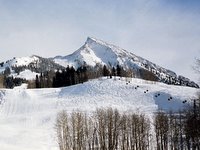
Photo credit: Larry D. Moore
Shopping in Crested Butte
Crested Butte has almost anything holidaying visitors could possibly want for mountain sports, including rental and repair shops. For other shopping needs the resort is quite limited, but there are some gift shops and clothing stores available for souvenirs. Avid shoppers may be a little disappointed, but the resort does provide everything visitors may need on holiday.
Dining in Crested Butte
There are fantastic restaurants offering everything for all nationalities of holidaymakers across the town. Offerings include sushi, seafood, vegetarian options, great steak and, of course, pizza.
Activities in Crested Butte
A small mountain, Crested Butte has a charm that relies on the friendliness of the regulars and holidaymakers who frequent the bars, pubs and breweries. Princess Wine Bar opens daily at 5pm and has a wide selection of award-winning wines, cognacs and single malt scotches and often has live entertainment in the evenings. Talk of the Town offers a variety of bar games, such as foosball, pinball, pool and video games, and of course a happy hour every afternoon, while The Eldo Brewery is a popular microbrewery with live music and dancing on weekends.
Things to be aware of in Crested Butte
Crested Butte is further out than other popular Colorado resorts, some 250 miles (400km) from Denver International Airport.
Skiing in Crested Butte
Although the reputation and renown of this resort is in the extreme skiing arena, there truly is something for all types. Most of the mountain is suited for intermediate skiers and riders but there is plenty of terrain suitable for beginners and experts as well. Crested Butte also has a terrain park, Canaan, with a number of jumps, tables and rails for beginners and intermediates. There is also a Superpipe at the top of Forest Queen, and a mini half pipe for beginners in the terrain park.
Davos
Overview
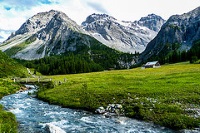
Photo credit: Robert J Heath
Shopping in Davos
Davos is a huge resort in comparison to the usual village-centred ski destinations in the Alps, and offers unrivalled shopping opportunities, with more than 100 shops, art galleries and boutiques ready and waiting to swipe eager visitors' credit cards in exchange for a plethora of goods, from tinkling cow bells to designer clothing. It takes hours to explore all the shops clustered mainly along the two main streets around the Davos Platz.
Dining in Davos
There are scores of restaurants in the greater Davos-Klosters area, offering a vast selection to suit every taste and pocket. When it comes to haute cuisine the best are located in the major hotels, and 24 of the finest hotels offer a 'dine around', where guests on half board can sample menus in other hotel restaurants. Around the Davos Platz there is an international selection of restaurants that ranges from simple cafes to gourmet restaurants offering everything from French and Italian menus, to Indian, Chinese and Thai. For cosy apres ski evenings and spectacular views, travellers should use the funiculars and cableways to head up to a mountain restaurant and sample homegrown local delights. The more upmarket restaurants require advance booking, and many Davos establishments close their kitchens early, around 10pm.
Activities in Davos
Davos offers evening entertainment to suit most tastes. Popular apres ski bars can be found at the foot of the Jakobshorn and Parsenn ski lifts and, after dark, there is a wide selection of bars and clubs in the town centre, centred around Davos Platz. Many clubs stay open until the early hours, including the Ex-Bar and Bolgenschanze in the centre of the Platz, and the Postli Club at the Morosani Posthotel. Davos also has a casino and cinema.
Things to be aware of in Davos
Davos and Klosters are not suited for those on a budget.
Skiing in Davos
The best-known and largest area in Davos is the Parsenn, offering intermediates and beginners miles of wide slopes that are ideal for smooth cruising. There are also advanced runs, steep drops and moguls that appeal to experienced skiers. Opposite the Parsenn, Jakobshorn, or the 'Fun Mountain', is the second largest area in Davos and has become one of the top snowboarding destinations in the world. Davos also boasts the second largest cross-country ski area in Switzerland, with miles of groomed trails available. The Davos-Klosters ski area also offers some of the best off-piste skiing in the world.
Lech and Zurs
Overview
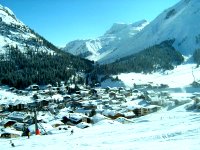
Photo credit: Wikicommons
Together with neighbouring Zurs, Lech is perhaps Austria's most exclusive ski resort. Between them, Lech and Zürs boasts dozens of four and five star hotels, but there are also options for more budget conscious skiers.
Despite its reputation for luxury, Lech remains a picturesque traditional Austrian village. The resort has sprung up around an old farming village set in a high valley, and even now the settlement is sometimes cut off from the outside world when there is heavy snowfall.
Innsbruck airport is just 1.5 hours from Lech and Zurs, while the drive from Zurich airport takes a little over two hours.
Shopping in Lech and Zurs
Shopping is surprisingly limited in Lech, and even more so in Zurs, considering both their reputations as fashionable resorts. Most of the shops are to be found on the Hauptstrasse, including major winter sports stores that sell all the latest branded equipment, as well as souvenirs, trinkets, and traditional Austrian clothing. Visitors will find everything they need in Lech, but it is not really a destination for shopping sprees. No doubt this lack of extensive shopping outlets helps to preserve the charming traditional atmosphere of the two alpine villages.
Dining in Lech and Zurs
There are an appetizing number of good restaurants to be enjoyed while on ski holiday in Lech. Some of the most popular are Hus Nr 8 and Rote Wand for traditional Austrian food, Don Enzo Due for pizza, and Fux for modern Asian fusion cuisine. Balmalp serves food such as pizza and ribs, and enjoys stunning views of the valley. Zurs has a similarly good restaurant scene, with numerous upmarket options.
Activities in Lech and Zurs
The apres ski in Lech is world famous and many holidaymakers staying in Zurs venture out to sample some of the atmosphere (there are regular buses connecting the resorts). The Eisbar, outside the Hotel Tannbergerhof is the most popular place to head for a gluhwein after a long day on the slopes. There's a small disco in the hotel too. The Krone Bar lures well-dressed clientele, as does the Hotel Arlberg. The champagne bar at the Hotel Montana is also a popular after-ski stop. The nighlife in Zurs is fairly quiet but there are a selection of bars and also a small disco. Those looking for a more rowdy nightlife may want to take a taxi to St Anton.
Things to be aware of in Lech and Zurs
Lech and Zurs are expensive by Austrian standards. There are also limited challinging pistes, although nearby St Anton has extensive sking for all standards.
Skiing in Lech and Zurs
Lech and Zurs offer some of the best intermediate skiing to be had in Europe. There may not be as many challenging pistes as in nearby St Anton, but there are extensive off-piste options.
Snow reliability is one of the main contributing factors to the success of this resort. There is a high annual snowfall and the highest lift station is at 2,811m. Lech is also home to the famous White Ring ski circuit, which takes skiers on a tour through the ski area.
Lech is linked by lifts and ski runs to the higher Zurs slopes, and a new gondola connects Lech to the pistes of Warth and Schrocken to the north, which doubles the available skiing area. Thanks to the new Flexenbahn gondolas, there is now also easy access to St Anton and other nearby Arlberg resorts.
There are plenty of excellent ski schools in Lech, Zurs and other ski resorts in the Arlberg area, but visitors should book early if they want to hire a private guide.
Cala Millor
Overview
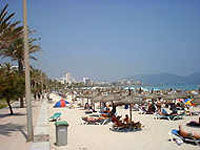
Photo credit:
Cala Millor is about 40 miles (70km) from the Son Sant Joan International airport near Palma, the capital, in the south of the island. The area, particularly favoured by German holidaymakers, is packed with shops, markets, entertainment venues, bars and restaurants to ensure non-stop fun in the sun. The resort is particularly well-suited for family holidays.
Shopping in Cala Millor
Holidaymakers will find that the pedestrian promenade that runs along the Cala Millor seafront is jam-packed with stores and stalls selling a multitude of souvenirs and tourist requisites, open until late in the evenings. Visitors will also find, however, that the selection is repeated over and over again in the different stores and variety is limited despite the amount of shops. A fun option for shopping enthusiasts is to head for Mallorca's markets where bargains such as lace tablecloths or leather goods can be picked up, after a bit of haggling. The closest markets to Cala Millor are Son Servera, held on Friday mornings, and Monacor on Mondays. Special buses are usually available for holidaymakers to reach the bigger markets, particularly those at Palma and Inca.
Dining in Cala Millor
There is a wide choice of restaurants scattered along the seafront promenade of Cala Millor, and around the fishing harbour at adjacent Cala Bona. Most are eclectic, serving a variety of dishes to cater for the tastes of hungry holidaymakers with others dedicated to international cuisine. Oxford Blue, Cafeteria Restaurante Bella Vista, Alahambra and Antonio Montoro are among Cala Millor's top-rated eateries for holidaymakers. Fast-fooders will find Burger King and KFC at hand.
Activities in Cala Millor
Nightlife in Cala Millor is essentially low-key compared to some of Spain's well-known, rowdy holiday hotspots. A great deal of the evening entertainment is hotel-based, but those who like to be out and about will find plenty of fun at the numerous British bars, such as Cheers, which offer a variety of pursuits from karaoke to quiz evenings or bingo. The younger set is catered for by a few discos, the largest being Palace Q, which play a mix of Spanish and international music. The club scene, however, is not as boisterous as that to which the 18 to 30 crowd may be accustomed.
Things to be aware of in Cala Millor
Visitors looking for a good party and clubbing-scene should look to other resorts as the nightlife is fairly limited in Cala Millor.
Cascais
Overview
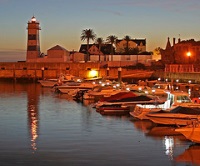
Photo credit: Francisco Antunes
Cascais town now hosts a plethora of elegant shops, bars and eateries set around colourful cobblestone walkways, to cater for the holidaymakers. Besides the lovely local beaches there are some other great sightseeing opportunities. Cascais' 16th century church has carved and gilded woodwork and some famous paintings, while the Cascais Amunicipal Museum is housed in a palace and has some interesting exhibits and illuminated manuscripts.
The Sea Museum contains everything maritime from model boats to fishermen's boots, and the 16th century Fort of Cascais offers a beautiful view and an open-air artillery museum. About two miles (3km) out of Cascais is a strange rock formation known as the Mouth of Hell, which is worth a look en route to the lovely beach of Guincho, a holiday favourite for surfers.
Shopping in Cascais
Shopping in Cascais' town centre is an enjoyable pastime, exploring the Rua da Raita pedestrianised street which offers numerous small shops selling local wares, including hand-embroidered linen and hand-painted tiles and other ceramics. Along the beachfront are the ubiquitous open-fronted stores and kiosks selling holiday requisites like buckets and spades, sunglasses and sunscreen. For local colour the place to be is on the Rua Mercado on Wednesdays or Saturday mornings when the farmer's market is held, selling fresh produce and plenty of other goods. Glitzy shopping is at the huge Shopping Cascais Centre, out of town on the highway to Sintra. There are two floors with hundreds of stores dealing mainly in clothing, accessories, furniture and household goods.
Dining in Cascais
Cascais is renowned for its quality dining, drawing gourmets from Lisbon and nearby Estoril. The main restaurant strip of Cascais is the walk-through Rua Frederico Arouca, and the lively Largo Luis de Camoes. Here you will find a wide choice of eateries, most with outside areas, from cafes to traditional taverns, serving both local fare and international cuisine. Fish restaurants abound; be warned it is said that one should not eat fish in Portugal on Mondays, because fishermen do not go to sea on Sundays! Specialities of the Estoril coast are fish stew, sole, dried codfish, lobster and crab. Spicy chicken dishes are also popular. Enjoy the reasonably priced good local wines. Popular restaurants in Cascais include the Michelin-starred Fortaleza do Guincho, and the local seafood at Restaurante B and B.
Activities in Cascais
The Cascais resort has a vibrant nightlife, offering everything from traditional Fado to wild dance clubs. Largo Luiz de Camoes Square is the hub of the hotspots, with a collection of bars and clubs. Most popular and lively of the clubs, Coconuts, is to the west of the town on the seafront, with a bar and dance floor. Other favourites include Baluarte, Ferdi's, O' Neills Irish Pub and Bally Bally Pub.
Things to be aware of in Cascais
Visitors staying near the centre of town may find it quite noisy.
Altea
Overview
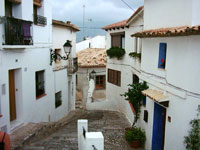
Photo credit: Wikipedia
Shopping in Altea
Quaint local shops can be found around town. They are mostly open until late in the evening, but closed for siesta in the early afternoon. From Easter until September there is an interesting market in the Altea town square, and it's great for buying local produce and gifts such as embroidered linen, leather goods, pottery and olive oil. The Altea market is open on Tuesdays and has become known as one of the best markets on the Costa Blanca. Visitors wanting a more comprehensive shopping experience should head to either Benidorm or the Sunday market at La Nuncia, just north of Altea.
Dining in Altea
Altea is unusual in that it has more local, paella-style eateries than pubs. The Hotel San Miguel gets good reviews for its food and has great views over the sea. El Castell in the old town serves some of the region's best pizzas, while La Maja is the perfect spot for a cooling cocktail or a stylish Mediterranean dish after a long day at the beach. Altea is home to family-run eateries rather than glitzy, upmarket restaurants, but many visitors consider this part of its charm.
Activities in Altea
Altea is a peaceful place and those in search of a party will likely be disappointed. All the nightlife is in Benidorm, a short trip by bus or car up the coast. Bar Plaza, on Altea's main square, has live music and jazz on summer evenings.
Things to be aware of in Altea
Altea is quiet and traditional and not ideal for those wanting a party scene close to town.
Saalbach
Overview
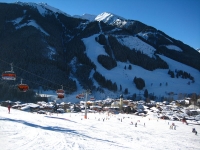
Photo credit: Simplon2010
Shopping in Saalbach
Hinterglemm is the best place to shop in the valley because its stores are frequented more by locals, who are averse to paying tourist prices. Saalbach's pedestrianised High Street has several attractive boutiques and shops where holidaymakers can enjoy a spot of shopping, but prices are higher.
Dining in Saalbach
On the mountain, rustic alpine restaurants serve up hearty local fare to skiers, while the valley towns bristle with restaurants, cafes and bars. Local Austrain favourites include wiener schnitzel and tiroler grostl, a Tyrolean hash made with with beef and potatoes.
Activities in Saalbach
So hectic is the apres-ski in Saalbach that it is surprising some holidaymakers can muster the strength to hit the ski slopes in the morning! Copious amounts of excellent local beer, schnapps and warming gluhwein flow in the mountainside inns and village bars, along with some loud music and good-natured gemuchtlikheid. Dancing on the tables is expected and drinking anthems with cries of prost! echo everywhere. Most parties get going even before the ski lifts close at 4pm, in the chalets above the villages. One of the most popular mountain bars is the Goasstall on the Hinterglemm side, which features indoor and outdoor bars and live music. Another favourite is the Spielberghaus, which is reached by snowmobile along a four-mile (6km) track through the forest. Revellers are then transported home on high-speed sleds. There are a dozen options for late night fun at hotel bars, beer halls, and clubs. Discos get going at around midnight and keep the pace until the early hours.
Things to be aware of in Saalbach
Saalbach can be extremely crowded over the Christmas season and the boisterous evening behaviour doesn't suit everyone. The resort is relativley low and south facing, so the snow is not a reliable as in other well-known resorts.
Skiing in Saalbach
Saalbach has access to a massive network of prepared pistes, which are well connected by an excellent system of modern lifts. The north side of the valley offers a variety of easy skiing for beginners, and there are plenty of ski and snowboarding schools in the area, providing tuition by professional English-speaking instructors. Intermediate skiers are also well catered for with an extensive area beyond the Reiterkogel. Schattberg Ost, Schattberg West, and Zwolferkogel offer some challenging north-facing slopes, with the north face of the Zwolfer providing a notably harsh black run. Nearby Leogang offers a remote, demanding ski area, reached from Vorderglemm by the Schonleitenbahn gondola. There are some spectacular off-piste powder runs on the north side of the valley. Saalbach is also extremely popular with snowboarders, with a massive terrain park reserved for boarding at Hinterglemm, and some half-pipes at Saalbach itself and neighbouring Leogang.
La Plagne
Overview
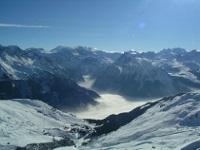
Photo credit: Ed Dowding
The high altitude La Plagne villages centre on apartment life; there are few hotels and its convenience makes up for its lack of charm. The highest complex at 2,000m, Aime La Plagne is considered to be the most convenient, with many of the best apartments. The lowest mountain village, at 1,800m, is the neo-Savoyard Plagne 1800. Belle Plagne, situated at 2050m, is one of the more attractive resorts, with traditional wood and stone buildings and a pedestrianised centre.
The largest complex, with the liveliest holiday atmosphere, is the original Plagne Centre, one of the first villages in Europe to be built to cater specifically for the skiing season. The lifts are near to the accommodation and visitors can generally ski to their door.
The three traditional villages within La Plagne ski area include Montchavin-Les Coches, which is just below the Vanoise Express cable car, Montalbert, which lies below Plagne Aime 2000, and Champagny, which is on the other side of the mountain and has its own smaller ski area.
La Plagne is one of Europe's best ski resorts for beginners and intermediate skiers, and with its self-catering apartments it is hugely popular with families. The resort is around two hours from Geneva and Lyon airports.
Shopping in La Plagne
Each complex of the purpose-built sections of La Plagne has holiday apartments, with supermarkets, restaurants and ski shops all interconnected by tunnels and walkways. The underground passages are reminiscent of a subway shopping mall.
Dining in La Plagne
Although large self-catering apartments dominate the purpose-built villages of La Plagne, the choices are endless for those who want to go out to eat. There are quaint local restaurants, both on and off the slopes, with delicious Savoyarde specialities on the menu, as well as quick and easy lunch stops offering toasties, pizza, pasta and burgers. There is also no shortage of bars offering an après-ski beer or vin chaud at the end of the day.
Activities in La Plagne
La Plagne is more of a family resort than a party destination, but there are nightclubs in La Plagne Centre and Belle Plagne, as well as plenty of bars that offer live music. There's a bowling alley in the centre of Belle Plagne, which is open late.
Things to be aware of in La Plagne
The La Plagne resort is not the image of a traditional village, with many high-rise buildings and purpose-built complexes. Waiting times at lifts can be lengthy.
Skiing in La Plagne
There is a huge amount of good skiing for all levels in La Plagne and the surrounding area, and as a high-altitude resort, the snow is as reliable as anywhere in Europe, particularly up on the Bellecôte Glacier, which goes up to 3,250m.
La Plagne is one of the best ski resorts for beginner and intermediate skiers and boarders, with literally hundreds of miles of pistes, but there is also plenty of off-piste terrain and challenging runs from the glacier for experts. As well as big, open slopes there are also runs between the trees, at Montchavin and Montalbert, and also over at Champagny.
The scenery and views are stunning and can be enjoyed by all ski levels from the highest point, where pistes for all abilities will lead even novice skiers safely down again. Intermediates will find more than enough to believe they are in skiing heaven, and beginners are well catered for with nursery slopes and ski schools adjacent to all the villages and plenty of blue and easy red runs. If visitors tire of the skiing in La Plagne, or simply want a change of scenery, they can take the Vanoise Express to Les Arcs.
Lake Tahoe
Overview
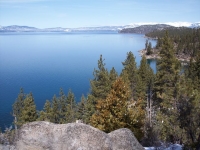
Photo credit: Sascha Bruck
Although the area's scenery and facilities draw visitors on holiday year-round, it is as a skiing and snowboarding destination that Lake Tahoe really thrives. Recently most of the popular resorts, with appealing names such as Alpine Meadows, Heavenly and Squaw Valley, have undergone extensions and face-lifts. The comfortable resorts, bolstered by the fact that Lake Tahoe guarantees 300 days of sunshine a year, 33 feet (10m) of annual snowfall, unrivalled scenery and more than 17,500 acres of terrain to explore, make it nearly irresistible for anyone contemplating a winter sports holiday in California.
For a holiday at Lake Tahoe, visitors can fly in to the nearby Reno-Tahoe Airport, or drive on all-weather highways from Reno, Sacramento, San Francisco and Los Angeles in just a few hours, for a dose of fun in the pure mountain air.
Shopping in Lake Tahoe
There is an abundance of shops in the holiday resorts and towns around Lake Tahoe, and it is easy to explore them all by making use of the free trolley shuttles and cheap surface transportation options in the area. Great bargains are to be had at the various factory shops in South Lake Tahoe, situated at the junction of Highway 50 and 89. The bustling Swiss-style Cobblestone Center in the centre of Tahoe City and The Boatworks Mall at Tahoe City Marina, North Lake Boulevard, are treasure-troves of interesting stores and galleries. Good buys in the area are gold and silver jewellery, Native American art, crafts, gifts and souvenirs, and of course, outdoor recreational clothing and equipment.
Dining in Lake Tahoe
With literally hundreds of restaurants and eateries to select from in the Lake Tahoe area, the main problem for hungry holidaymakers is what to choose. Most are well satisfied with the top quality restaurants in their particular resorts, but the options are unlimited if one decides to move further afield. A favourite in South Lake is Sprouts, the go-to spot for salads and sandwiches that are both healthy and delicious; if comfort food is what visitors crave, South Lake is also home to Mac Duff's Pub, serving up generous portions of fish and chips, burgers and general pub fare. On the north shore in Tahoe City is the casually elegant Christy Hill, featuring a spectacular view of the lake. With a varied menu of homey dishes, Fire Sign Cafe is a well-loved favourite for breakfast and lunch in Tahoe City.
Activities in Lake Tahoe
Lake Tahoe has much to offer for visitors who want to live it up, from gambling or shooting pool to watching a raunchy cabaret show. The numerous casinos, concentrated on the south shore, provide non-stop action way beyond the tables and slot machines, in satellite bars, clubs, restaurants and lounges. Himmel Haus in South Lake is a German beerhouse that serves up an impressive range of German and Belgian beer and wine, along with bavarian-inspired dishes. They also host multiple weekly events. One of the hottest Lake Tahoe clubs is Peek, in Harrah's Casino, offering great drinks, music and dancing till the early hours. Opal Ultra Lounge can be found at Montbleu Resort and is also a late night favourite.
Things to be aware of in Lake Tahoe
Unless travellers are approaching it from the East Coast, Lake Tahoe is a little tricky to get to.
Skiing in Lake Tahoe
Lake Tahoe's winter wonderland offers perfect powder, and groomed snow covers the slopes from November through to April. The snow can be enjoyed at any of 15 alpine and 13 cross-country ski areas, encompassing world-renowned ski resorts. At South Lake the best-known areas are Sierra, Kirkwood and Heavenly, all offering steep, deep and scenic runs; on the North Shore is Squaw Valley and Alpine Meadows. The total ski terrain of more than 17,500 acres offers hundreds of runs catering for all levels of skiers and boarders, from powder in the trees, moguls and open bowls to perfect corduroy cruisers. Some of the area's more famous runs provide adrenalin-pumping challenges for advanced skiers. All the resorts offer ski instruction and child-care facilities.
Pucon
Overview
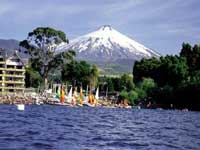
Photo credit: Jeferrer
In the winter months, skiing and snowboarding in Pucon are the major attractions, and the resort is one of the few places in the world where visitors can ski on a live volcano. Travellers should note, however, that although the conspicuous activity of the Villarrica Volcano is delightful in some ways, it also means that adventures on the slopes of the volcano are sometimes suspended due to the volcanic activity. The last serious eruption was in March 2015.
Shopping in Pucon
It's seldom a good idea to shop too extensively in a resort town, as the prices are generally higher, and the range more generic than in less commercialised towns and rural areas. In Pucon there are plentiful high-quality carvings, textiles and leather goods and the range is impressive but cheaper crafts can be found outside of the little town. There are a few charming little bakeries and some big supermarkets in Pucon for those choosing to self-cater.
Dining in Pucon
Hordes of hungry tourists have ensured a lively and diverse restaurant scene in Pucon. There are plenty of international staples available (foods such as pizza and burgers are popular all over Chile) but there are also some more authentic eateries offering local cuisine. It is possible to eat cheaply or to splurge, depending on budget.
Activities in Pucon
The nightlife in Pucon is usually lively, and the town has the reputation of having something fun to do 24 hours a day. Evenings out generally involve plentiful food and oversized beers and, although the nightlife is energetic, it isn't generally sophisticated. There are one or two more stylish venues though. Many bars and nightclubs are open only in summer (November to February), which is the peak tourism season; the town is much quieter during the winter months, though there is always somewhere to get a drink.
Things to be aware of in Pucon
Pucon can get crowded so accommodation should be arranged well in advance in the peak summer months.
Skiing in Pucon
Skiing in Pucon revolves around the Villarrica Volcano, making it one of the few places in the world where visitors can ski on an active volcano. Prior to the 2015 volcanic eruption, the resort boasted about 10 major runs, served by a number of ski lifts as well as several natural half pipes; however, the slopes were never opened in 2015 and it is unclear when the resort will once more function at full capacity. When the ski slopes are open, facilities for ski and snowboard equipment hire and a ski school are usually available. Apart from the off-piste options the resort is simple and the slopes are best suited to beginners and intermediates. The views from the slopes are sublime.
Soldeu
Overview
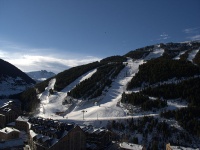
Photo credit: Albert White
The village is located in the greater Grandvalira region, which incorporates neighbouring Pas de La Casa and has four other resort bases in the eastern half of Andorra. During summer, Soldeu is a popular destination for hiking, mountain climbing, and even white water rafting. During the winter months, the pistes below Pic d'Encampadana are covered in snow, providing perfect conditions for skiers, snowboarders, and those who just enjoy the beauty of the frosted Pyrenees peaks.
Shopping in Soldeu
Despite the fact that Andorra is one of the few countries in the world that is blessed with duty free shopping, the resort of Soldeu is fairly limited when it comes to shops, with a sprinkling of small sports stores that provide equipment and a supermarket for supplies. Most shoppers head to nearby La Vella, located about 30 minutes away via public bus, to go duty free shopping.
Dining in Soldeu
Soldeu's restaurants and cafes offer world-class cuisine and the majority of them can be found sprinkled along the main street and throughout the village. With French, Spanish, Italian, and local Pyrenean fare to choose from, visitors will have a tough time deciding where to dine. The highly popular Fat Alberts serves a delicious fillet steak, while other establishments offer fantastic views and a la carte menus. There is a plethora of cosy cafes and small takeaways along the main streets selling everything from baguettes and sandwiches to slices of pizza and more.
Activities in Soldeu
Soldeu's nightlife is not as lively as neighbouring Pas de la Casa, but it does offer a number of fantastic bars and nightclubs providing plenty of after dark entertainment for holidaymakers. There are bars with live entertainment, with others showing sports events. Anyone looking for a night out after a long day on the slopes can head to Fat Alberts, where happy hour après ski drinks can be enjoyed, and live music and DJs keep the place going until the early hours. Barcode is another popular venue for those after a quieter après ski drink.
Things to be aware of in Soldeu
Holidaymakers who are hoping to experience a wilder nightlife with a greater option of bars and clubs should consider staying at the nearby Pas de la Casa resort. Shopping options are also limited.
Skiing in Soldeu
With its large number of red and blue slopes, Soldeu is best suited for beginner and intermediate skiers. There are good English-speaking ski schools, and easy nursery slopes for beginners to learn on. Soldeu is hugely popular with snow boarders; there are two permanent boardercross tracks and the legendary El Tarter Snowpark.
Marbella
Overview
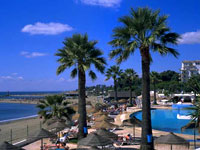
Photo credit: Spanish National Tourist Board
Shopping in Marbella
The best shopping is at the markets, which are a focal point of local life. Marbella has a good Monday market at Recinto Ferial de Arroyo Primero, and an antiques market on Fridays in the old town. Good buys in Marbella include Moorish pottery, designer clothing, and Andalucian crafts such as shirts and leather shoes. Tourists should expect to bargain hard on all items from fresh produce to Spanish tourist souvenirs and clothing.
Dining in Marbella
Eating out in Marbella tends to be pricey although there are plenty of good value fish and chips venues around the seafront promenade. Beach bars offer good pub grub and excellent views at sunset. Tapas is always a good bet, as is the local fish, particularly in paella. Visitors should avoid eating the widely touted Chanquetes (tiny, deep-fried baby fish) which are endangered.
Activities in Marbella
Marbella's best bars include Ana Marias, La Notte Piano Bar and Stones Music Bar. Clubs worth trying while on holiday in Marbella are the legendary Nikki Beach, long-standing favourite Dreamers Disco, Suite del Mar and Olivia Valere. Dress codes are the norm in Marbella, and entrance fees are often higher than those in Madrid and Barcelona. The Golden Mile in Marbella is the place to be seen and tourists in Marbella should expect to rub shoulders with the rich and famous including many well-known celebrities and even members of the Saudi royal family.
Things to be aware of in Marbella
Marbella can be expensive when compared to smaller towns on the coast; it has also grown into a busy and modern place, with little of the old world charm that attracted many visitors here twenty years ago.
Mazatlan
Overview
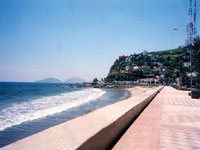
Photo credit: Judith Duk
The colonial old town centre is the heart of Mazatlán, where the busy main plaza, alongside the 19th-century cathedral with its blue and gold motifs, and the open-air market, are a hive of activity. The city emanates a combination of laid-back seaside charm and affordable luxury, its beaches lined with bars and outdoor cafés, and the sky above filled with colourful parasails. Sunbathers and hawkers compete for space on the city beaches, and fishing vessels and jet skis circulate in Mazatlán bay.
Shopping in Mazatlan
Mexico is a great place to shop for diamonds because the gems can be purchased here tax-free. The best place to seek out jewellery is Mazatlán's Golden Zone (Zona Dorada) tourist area. The streets of the Golden Zone are a paradise for greedy shoppers, where jewellery, designer clothes, seashell souvenirs and almost anything else imaginable can be found within the tiny boutiques and vast emporiums. The Mazatlán Arts and Crafts Center is a treasure-trove of handmade goods. Wandering the Central Market in Old Mazatlán is a colourful shopping experience, with busy street food stalls under bright umbrellas in front of little stores selling a hodge-podge of crafts, clothing and novelties. Away from the sea, on the Avenida de los Deportes, is a large shopping mall, La Gran Plaza, which has a supermarket stocking essentials. Shops generally open from around 10am and stay open until late.
Dining in Mazatlan
Shrimp in every guise is the mainstay of Mazatlán restaurants. A favourite spot for tasting this tempting crustacean is the tourist-oriented El Shrimp Bucket on Olas Altas, the original of the chain of restaurants that has proliferated throughout Mexico. Great cuisine here is not confined to shrimp, however: Asian and Italian restaurants abound, along with some superb authentic Mexican eateries. Favourites among these include Cenaduria El Túnel, near the Angela Peralta Theatre, famed for its chicken gorditas and the best pozole (pork stew) in town. There is a fairly good choice of dining options around the Plazuela Machado, including the upmarket al fresco Pedro y Lola. For a quick snack opt for a hotdog or taco from a street stall, or find a cheap meal at the Central Market where a few restaurants offer inexpensive daily specials.
Activities in Mazatlan
Mazatlán, like any busy seaside resort, has a lively nightlife with a plethora of dance, live music and drinking venues. Extremely popular are Mexican fiesta theme parties that are organised by the larger hotels. Most of the nightclubs and popular pubs are to be found in the Zona Dorada, offering a variety of music from chilled piano playing to lively local mariachi groups. One of the favourites for locals, offering sizzling Latin beats, is Mundo Bananas, on Avenue Camaron Sabalo. The young crowd tend to favour the Fiesta Land complex at the southern end of the Zona Dorada, which is packed with restaurants and lively clubs like Bora-Bora and Valentinos. Those whose tastes run to other than dancing will find plenty of sports bars, karaoke bars, cocktail bars, and brew houses in which to spend a fun, social evening.
Things to be aware of in Mazatlan
There are lots of hawkers on the beach in Mazatlan and this can become a nuisance to travellers. Don't stray too far from the tourist areas alone as travellers are easy targets for petty crime.
Plettenberg Bay
Overview
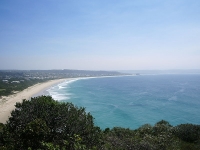
Photo credit: Hurkummer
The town - familiarly known as 'Plett' - is a favourite holiday destination for South Africans and foreigners alike with its unspoilt golden beaches, year-round Mediterranean climate, dramatic rocky Robberg Peninsula, and vibrant nightlife. The bay is a nursery for the endangered Southern Right Whales, which arrive each winter and spring to calve.
Shopping in Plettenberg Bay
Plettenberg Bay's shopping malls and a variety of shops provide everything that is needed by travellers, including clothing and speciality goods at several boutiques where souvenir-hunters can also find arts, crafts and antiques. Plett is by no means a shopper's paradise, but the town is well-equipped for self-caterers and holidaymakers.
Dining in Plettenberg Bay
There are plenty of dining opportunities in Plettenberg Bay, from beach pubs, bistros and deli's to five star cuisine and award-winning à la carte menus. Foodies will find Thai, Italian, fresh seafood, steak and a variety of other choices on offer.
Activities in Plettenberg Bay
Although Plett is a small town, the nightlife is fairly lively, yet laidback. Choices are somewhat limited. In summer most action takes place on or near the beach, beginning with sundowners in typical South African style at one of the lovely beach bars, but there are a few fun pubs and clubs for later evening entertainment with pool tables, live music and dancing. Travellers should note that Plett is one of a handful of South African coastal towns that draw massive crowds of school graduates at the end of the academic year (late November and early December), meaning that during this time the town is crowded and the nightlife is extremely frisky.
Things to be aware of in Plettenberg Bay
Plettenberg Bay is best avoided over the Christmas holiday period when prices are double, accommodation is impossible to find and everything gets very crowded.
Sandanski
Overview
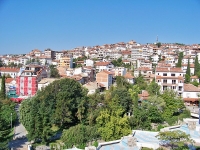
Photo credit: Infobgv
Sandanski is a small town in the Bistritsa river valley, with a population of around 30,000. The city centre is a beautiful place to walk around, with a number of restaurants, shops, hotels, art galleries and internet cafes. The town hosts several festivals throughout the year and is a point of departure to various attractions in the Pirin Mountains, including the sandstone pyramids in Melnik, the thermal hot springs at the Rupite volcanic crater, and the Rila Monastery.
Shopping in Sandanski
Shopping in Sandanski is concentrated in the city centre, with a number of shops, art galleries, and market stalls dotted around Macedonia Avenue. Popular Sandanski souvenirs include wooden toys and puzzles, local art, and clothes. There are also several ateliers who makes custom suits at prices far below those in other parts of Europe.
Dining in Sandanski
Eating out options in Sandanski include a range of sidewalk cafes and outdoor restaurants. Many of the hotels in the city offer good places to eat, and most of Sandanski's restaurants are clustered around the city centre, within easy walking distance.
Activities in Sandanski
Although renowned for its spa holidays, Sandanski boasts a surprisingly energetic nightlife, with a variety of clubs, lounges and bars to investigate.
Val dIsere
Overview
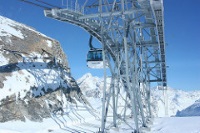
Photo credit: Pete Coleman
Shopping in Val dIsere
Val d'Isere has plenty to offer shopaholics on holiday, particularly those with large wallets wanting to look their best on the slopes. Prices are much more affordable towards the end of the season as shops clear the shelves for next year's look. There are mini-supermarkets and some wonderful delicatessens for those who are self-catering.
Dining in Val dIsere
There are dozens of restaurants in Val d'Isere, most serving up a first-rate food and many with a pricey menu. La Luge has cosy atmosphere and is good spot for dinner after drinks in bar of the adjacent Blizzard Hotel. It serves delicious home-cooked Savoyard specialties. Le Lodge is a more affordable option for a family meal; they do excellent steaks, pizzas, pasta and fondue at an excellent price. The Fondue Factory is a contemporary fondue restaurant that is an homage to Jean Claude Killy, the Olympic skier. La Baraque has good cocktails and a lively setting, often with live bands playing. It serves delicious Asian food, a refreshing change from the heavy food served in many Alpine restaurants. As is often the case, the smaller more intimate restaurants sometimes offer the best fare and it's best to ask a local for up-to-date advice. The same goes for the mountain restaurants. Le Peau de Vache is one of the best mountain restaurant, and is situated half way up La Face. Other good mountain restaurants include La Fruitiere and La Cucucina (both part of the Folie Douce), Eidelweiss and Etincelle.
Activities in Val dIsere
Val d'Isere has perhaps the most lively nightlife and apres ski scene anywhere in the Alps. For many people the Folie Douce is the first stop after skiing and their terrace is packed on sunny afternoons. It's been dubbed the highest club in Europe and has a resident DJ and band. Cocorico is situated on the nursery slopes, it also has great music and a lively atmosphere, and gets going around 5pm. Le Bananas and the Fall Line are more Val D'Isere institutions and popular pre-club venues, while Dicks Tea Bar has evolved from a pub into one of the most famous nightclubs in the French Alps, open between 11pm - 4am.
Things to be aware of in Val dIsere
Few Val d'Isere chalets are within walking distance of the lifts, so skiers have to make use of the efficient bus service. Val d'Isere is very popular and slopes get crowded during school holidays. The town developed quickly in the 1960s and 70s when there were few planning controls, and this is reflected in much of the town's architecture. However, since the 90s all new buildings have had to conform with traditional styles, in keeping with the ancient village that the town grew up around.
Skiing in Val dIsere
The combined area of Val d'Isere and Tignes offers a massive amount of skiing for all standards. The nursery slopes just above the village are free and a number of companies offer first-rate instruction. As standards improve, skiers can make their way up the slope to the wide choice of green and blue runs. The Solaise slopes can be reached by cable car from the village centre and offer a variety of exciting piste skiing for intermediates and beginners; experts can drop off the sides for some powder. The Bellevarde slopes offer some good high-altitude skiing including a 3,000-foot (1,000m) run down to La Daille. Skiers from all over the world flock to Val d'Isere for its vast expanse of off-piste skiing; whatever the visitor's standard, it's best to take a guide for safety and to help find the best powder.
Sun Valley
Overview
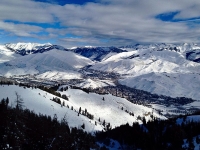
Photo credit: Chloé François
Sun Valley is built around Bald Mountain, known affectionately as 'Baldy' and considered by many to be the single best ski mountain in the country. The old stomping ground of Olympians Picabo Street and Reggie Crist boasts something like 3,400 vertical feet (1,036m), 14 lifts and 65 runs on 2,054 skiable acres. The widely varying terrain of 'Baldy' and neighbouring Dollar Mountain means skiers of all levels can hit the slopes. The ski and snowboard school offer clinics for all skill sets and ages. A wide range of accommodation is also available, from romantic retreats to spacious family options, including four mountain lodges, the original and elegant Sun Valley Lodge as well as village condominiums and cottages.
Shopping in Sun Valley
Shoppers and holidaymakers will find the latest designer fashions and the top brands in technical skiwear in Sun Valley Village, as well as skiing, snowboarding and mountain biking equipment and accessories. In addition to an art gallery, there are a variety of gift and souvenir shops. Free bus service to lively Ketchum and its shops is also available.
Dining in Sun Valley
Sun Valley's restaurants cater to every taste, from hearty Idaho fare to pizza to gourmet Mediterranean cuisine. Holiday visitors won't be disappointed. Those in a nostalgic mood can take the gondola up to Roundhouse, the first day lodge on Bald Mountain, built in 1939. A visit to Trail Creek Cabin is also a tradition, with its sunset views and three outdoor decks open year-round. Visitors can even find sushi in nearby Ketchum.
Activities in Sun Valley
Nightlife comes alive in Sun Valley during the winter months, when holiday visitors can enjoy the apres-ski socialising. The Duchin Lounge serves special hot-buttered rum that is a must-try. The Boiler Room is a popular nightspot, serving the obligatory American bar fare of nachos and chicken wings.
Things to be aware of in Sun Valley
Some skiers have found the tighter valleys of the ski areas to be a bit uncomfortable during busier times. Others have judged the trails to be slightly more difficult than their posted ratings. At times, there is a lack of natural snow.
Skiing in Sun Valley
Sun Valley is consistently rated in the top ten by Ski Magazine. Bald Mountain's seven high-speed quads, four triples and five doubles take skiers to a height of 9,150 feet (2,789m), and its terrain includes glades, bowls, bumps, groomers, tree skiing, and easy rollers. It is also famous for its lack of lift lines, allowing for more time on the slopes. Dollar Mountain's gentler, treeless slopes are perfect for beginners, and its tubing hill is popular with families. Snowboarders aren't neglected either, as Dollar Mountain has a 22-foot superpipe. Sun Valley also has one of the most extensive and well-maintained Nordic trail systems in the country. The Zions Bank Boulder Mountain Tour, one of the country's top cross-country skiing events, is held here each year.
Sugarloaf
Overview
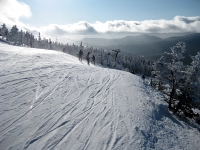
Photo credit: jon collier
Shopping in Sugarloaf
The largest town is Farmington, 39 miles (63km) away with a population of around 8,000, so it's no surprise that shopping is not a popular Sugarloaf pastime. The most popular souvenir is thermal underwear to cope with the occasionally icy weather.
Dining in Sugarloaf
There are some good quality restaurants right on the slopes of Sugarloaf. Bullwinkle's is great for lunch, and in the evenings offers a six-course meal at a secluded spot accessed by snow cat. At base lodge one can find Narrow Gauge Food Station, which offers decent enough food on the go. In town, visitors shouldn't miss The Bag and Kettle, home to Skiing Magazine's Best Burger 2008/9 and the famous Cheeseburger Soup. Another good bet for great food and apres ski entertainment is The Shipyard Brewhaus in the Sugarloaf Inn.
Activities in Sugarloaf
Sugarloaf's apres ski is a classic bar scene of the beer and sing-along variety, and most venues close relatively early at 1am. Some of the best apres ski is at the very top of base lodge in the Widowmaker Lounge, less sinister and a whole lot more fun than it sounds. Weekends are best when live music keeps the party going until late. Travellers should check out the restaurant 45 North inside the Sugarloaf Mountain Hotel for live entertainment nightly.
Things to be aware of in Sugarloaf
The resort is just over two hours from the nearest airport. It doesn't have the most exciting apres ski scene so party animals might be disappointed, as will avid shoppers. Sugarloaf can be a little expensive and gets very cold in February.
Skiing in Sugarloaf
There are 12 lifts in total, including two high speed quads, equating to around 19 720 skiers carried per hour. This resort probably has the shortest lift lines of any large US resort, a big plus over holiday season. Sugarloaf is famous for its challenging and super steep black diamond snowfields, although there are plenty of runs for beginners and intermediates too across the almost 160 named runs available. The ski school is excellent, though not cheap, and there are plenty of groomed runs on which to practice.
Sunny Beach
Overview
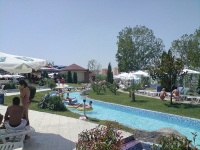
Photo credit: Wizzard
Shopping in Sunny Beach
Sunny Beach features several big shopping centres which provide plenty of opportunities for visitors to find clothes, souvenirs and food while on holiday. You'll find traditional Bulgarian souvenirs like leather and textiles, wooden toys and puzzles, and jewellery alongside touristy fare like t-shirts, sunglasses and postcards at places like the Royal Beach Mall in the centre of town.
Dining in Sunny Beach
More than 130 restaurants and taverns in the Sunny Beach holiday resort cater to foreign tastes with a wide range of cuisine for holidaymakers of all nationalities. Places to eat in Sunny Beach range from familiar British pubs for homesick tourists, to traditional Bulgarian mehanas, and the range of cuisines ensures there are options to suit all budgets.
Activities in Sunny Beach
Nightlife in Sunny Beach is varied and ranges from nightclubs, discos, casinos and bars, to cafés, folk-style spots and a variety of acts and entertainment in the local taverns. The nightlife in Sunny Beach is so varied and energetic that holidaymakers visit from surrounding resorts to make the most of the Bulgarian entertainment scene.
Things to be aware of in Sunny Beach
The Sunny Beach holiday resort can get very crowded during peak season with over 100 hotels and two large campsites accommodating thousands of visitors.
Vilamoura
Overview
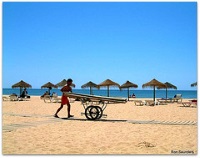
Photo credit: Ronald Saunders
The southern border of the Vilamoura holiday resort is host to a long, sandy beach, which is lined with quality hotels, self-catering apartments, numerous restaurants and shops, and a host of leisure facilities including a casino. Further inland, villas nestle in lush gardens between the golf courses. Vilamoura, which means 'Village of the Moors', is designed for pure pleasure for everyone, of any age or orientation. Nature has enhanced the resort with a temperate sunny climate and beautifully landscaped surroundings. Development has been environmentally friendly and tasteful.
Shopping in Vilamoura
Shopping arcades are an integral part of the Vilamoura holiday development, packed with designer boutiques, shoe stores, sport's outlets, perfumeries, tobacconists, jewellers and plenty more. Those wanting to seek out the local colour can make an expedition to the Saturday market in nearby Loule.
Dining in Vilamoura
From fine dining to fast food, Vilamoura has it all in dozens of restaurants, coffee bars, ice-cream parlours and cafés scattered throughout the resort, though many of the most popular places are near the Marina.
Activities in Vilamoura
Nighttime is fun time in Vilamoura, where bars, discos and live entertainment venues abound. Everything from traditional Portuguese Fado to striptease and karaoke is there to be enjoyed. Vilamoura's international Casino is the haunt of celebrities, offering nightly dinner shows in addition to gambling tables, slot machines and bingo rooms.
Things to be aware of in Vilamoura
Some of the prettiest areas in Vilamoura are not open to the general public, including privately-owned areas and exclusive resorts.
Vallnord
Overview
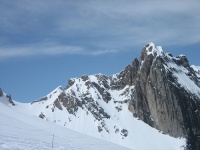
Photo credit: Jerome Bon
Pal and Arinsal, which are linked by cable car, form part of the largest ski area in Vallnord, offering very different types of skiing terrain, while the Ordino-Arcalis Valley area in the extreme northeast is highly popular with experienced locals for its off-piste skiing.
The summer months are also a great time to visit this mountainous resort, where activities such as mountain biking, horse riding, and fly fishing are highly popular. Most holidaymakers who visit Vallnord generally stay in Arinsal, but the town of La Massana also makes a great base as the gondola to Pal is nearby and Arcalis is located within close proximity, too.
Shopping in Vallnord
Like other ski resorts in Andorra, there are a few specialist shops, fashion boutiques, and sports stores scattered throughout the town. But since Vallnord is located just three miles (5km) from the capital of La Vella, many keen shoppers choose to head through to this mountain town for a day of duty free shopping, where items such as perfume, designer clothes, electronic goods, alcohol, and tobacco can be scooped up at bargain prices. With thousands of stores and boutiques, shopaholics can shop to their heart's content in one of the world's greatest shopping meccas.
Dining in Vallnord
Food and drink in Vallnord is much cheaper that in any other European resorts, and it's not surprising that eating out is a favourite pastime while on holiday here. There is a huge array of restaurants to choose from, offering all kinds of fare, from Italian and Mexican to Japanese and French, visitors will not be disappointed. Many of the finest restaurants in Vallnord are located in the very swish hotels, but there are also plenty of other eateries to choose from catering to all kinds of tastes.
Activities in Vallnord
The après-ski in Vallnord is lively, despite the resorts small size. With many local favourites and even some English and Irish pubs to choose from, Vallnord provides the perfect environment for a great night out after a long day on the slopes. In Vallnord, food and especially drinks are much cheaper than in other parts of Europe, making it the perfect destination to begin a night out at a restaurant, before heading out for a night on the town at one of the resort's many clubs, discos and bars until the wee hours.
Koh Chang
Overview
Photo credit: ONEBIGTRIP
Koh Chang Island is home to exotic flora and fauna, abundant marine life and untouched, colourful coral reefs, making it an attractive holiday destination for adventurers, hiking enthusiasts and scuba divers, and the beautiful scenery, friendly locals, quality restaurants and trendy nightlife make it appealing to everyone else!
There is an array of accommodation options for visitors on the island, ranging from simple beach huts and bungalows to upmarket villas, suites and apartments. Daily flights from Bangkok, Phuket and Ko Samui arrive at the airport in Trat, from where ferries are available to Koh Chang.
Shopping in Koh Chang
Most Koh Chang shops are located along the main road of each beach, and offer an assortment of souvenirs, beachwear, paintings, and sunglasses. The main beaches, such as White Sand Beach and Kai Bae Beach, also have shops such as Speedo and BSC. Klong Prao Beach has three villages and each one has its own shopping centre with small shops, convenience stores, tailors, banks and tour agents.
Dining in Koh Chang
There are a number of great restaurants on Koh Chang. White Sand Beach (Had Sai Khao) and Klong Prao Beach both have a few good Thai restaurants and interesting cafes, including vegetarian options. Many beachside eateries are scattered around the island and something tasty is never too far away. Visitors shouldn't be scared of trying some street food, as this is often the cheapest and sometimes the best option for backpackers and budget travellers alike.
Activities in Koh Chang
Koh Chang's nightlife ranges from pubs and beach bars to live music venues and vibrant nightclubs. White Sand Beach is the nightlife hub of the island and has some of the most popular venues on its southern tip. On Klong Prao Beach there are cafes and bars with pool tables, board games and big screen TVs, and the same can be said for Kai Bae Beach. The bars on Lonely Beach appeal to a younger crowd, as there is live music and an increasingly debauched atmosphere.
Things to be aware of in Koh Chang
Sandflies are a real irritation, as their bites cause itchy sores to develop.
Side
Overview
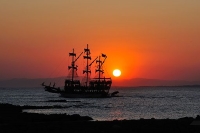
Photo credit: Martin Nikolaj Christensen
Shopping in Side
The shopkeepers in Side have a reputation for pestering tourists, especially in the city centre. Many shops will not display prices so be prepared to haggle. Busy streets that lead down to the sea are lined with souvenir shops selling typical Turkish handicrafts such as carpets, jewellery, and leather goods. Visitors can take a bus to the Manavgat market on Thursdays, which has the usual souvenir options such as t-shirts and leather goods. The main markets are fun and have a lively atmosphere, but the best deals can usually be found in quieter areas.
Dining in Side
Side has a variety of restaurants, ranging from Western style food to local delicacies such as dolmades and kebabs. Anatolia Cafe is a popular place for English breakfasts and roasts.
Activities in Side
Most of Side's nightlife is concentrated along the beachfront. There are a few lively bars and clubs, but they don't stay open very late.
Things to be aware of in Side
Side can be very crowded on weekends, when many local tourists visit.
Dalyan
Overview
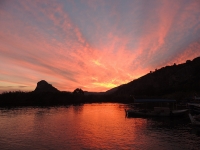
Photo credit: Gina Gleeson
The town is set on the winding Dalyan River that flows between the Mediterranean Sea and Lake Koycegiz, and on the other side of the river are the ruins of the ancient city of Caunos, dating back to the 3rd century.
A Dalyan holiday must is a boat trip to the 2.5 mile (4km) beach (about a 40-minute journey) that transports visitors through tall reeds, to 2,300-year-old Lycian cliff tombs and the ruins at Caunos, and finally to the large sandbar at the turtle beach in Koycegiz. A quicker, but less scenic ride is by dolmus.
Nearby thermal springs at Sultaniye, and the Dalyan mud baths are also not to be missed and make for an out-of-the-ordinary holiday experience. The surrounding wetlands are a haven for a variety of wildlife and birds, and the town is offset by a backdrop of pine-covered mountains and lush fields, making Dalyan a perfect destination for nature-lovers.
For those looking to party until dawn the busier holiday resorts such as Marmaris would be better suited, but for the more discerning traveller there are plenty of activities and excursions to enjoy, local delicacies to savour, and spectacular scenery to delight in while on holiday in Dalyan.
Shopping in Dalyan
The Dalyan local market on Saturdays provides an excellent way to pick up bargains while on holiday. As with anywhere in Turkey, haggling is key and there are unbelievable deals to be had. There are several small shops, including local arts, crafts, and carpet dealers, and there is also the usual range of very cheap but fake designer goods. There are also several mini supermarkets.
Dining in Dalyan
There are a number of restaurants catering for a range of tastes in Dalyan, including several that offer tasty traditional Turkish dishes. Unlike many resorts, this is not the place to look for British style food or McDonalds. Paradise Restaurant is the best place to go for fish and chips, though. Some favourites include La Perla and Simarik cafe. Riverside Restaurant has beautiful views of Caunos.
Activities in Dalyan
Dalyan is not the place to come on holiday for a buzzing nightlife, but there are several bars and a few clubs and many establishments have regular Turkish nights offering up a more traditional experience of belly dancing, traditional music, and special food.
Things to be aware of in Dalyan
Dalyan can be a bit more expensive than neighbouring holiday resorts and, as it is a more family-orientated resort, party animals looking for late nights and pumping clubs should head elsewhere. Mosquitoes can be a problem.
Nessebar
Overview
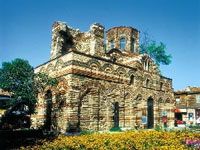
Photo credit: Bulgarian Tourism Authority
Shopping in Nessebar
Popular souvenirs from Nessebar include leather and textiles, wooden toys, and silver jewellery. The street markets in Nessebar's old quarter have a good variety of colourful mementos.
Dining in Nessebar
Nessebar has no shortage of restaurants, cafés and taverns for visitors to choose from on holiday. The most alluring restaurants are along Roussalka and Tsar Ivan Assen Streets on the southeastern tip of the peninsula. Fresh seafood and sea views are the order of the day!
Activities in Nessebar
Nessebar's nightlife is limited, but the mega-resort of Sunny Beach is just two miles (3km) away and offers an excellent nightlife for those seeking more entertainment than the quiet beach holiday can offer.
Things to be aware of in Nessebar
For modern amenities and a bigger variety of holiday accommodation it is necessary to stay in the new town on the mainland, which doesn't have the charm and atmosphere of the old quarter.
Ensenada
Overview
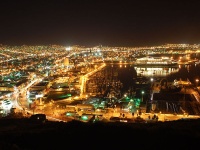
Photo credit: Gregg Erickson
The secret of Ensenada's success as a tourist magnet is simple: the resort town basically has it all. The weather is bright and sunny throughout the year, and the Pacific beaches are magnificent. These basic ingredients have been enhanced by some wonderful natural and man-made attractions, great restaurants serving up fresh seafood and local wines, and amiable local tour operators providing a huge array of outdoor recreational activities and excursions. Even the town's industry, which consists mainly of fishing, winemaking and canning, has become a lure for visitors, who can visit factories and wineries and liberally sample the delicious wares.
Shopping in Ensenada
The eyes of avid bargain-hunting tourists glitter when they see Ensenada's broad shopping avenues. The shops are literally bursting with a massive array of Mexican arts and crafts from elegant Taxcosilver jewellery in the boutiques of the Avenida Lopez Mateos to a selection of 'below $5' curios in the stores along First Street. Best buys to look out for in Ensenada are leather goods (bags, purses, jackets, belts etc.), hand-blown glassware, woodcarvings, and ceramics. Those who enjoy local colour can browse through the bustling Los Globos flea market where occasional treasures can be found. Due to its popularity as a cruise port, Ensenada offers great shopping opportunities, but it can be very expensive.
Dining in Ensenada
No matter what your taste in food, from hamburgers to haute cuisine, you will find it while on holiday in Ensenada. However, because of its seaside location and local fishing industry, nearly all restaurants offer some sort of fresh seafood on the menu, and most include traditional Mexican fare. Highly recommended is a visit to the fish market (known as the 'Black Market') where delicious and cheap fish tacos are sold at several stands. Lunches are best enjoyed at one of the myriad sidewalk cafes: relax and watch the passing parade of people along a leafy boulevard while sipping a glass of wine. When it comes to dining, the choice is vast. Manzanilla in the port area is a great place to try local cuisine. Those hankering for formal dining can enjoy award-winning French cuisine at El Rey Sol on Avenue Lopez Mateos. For a taste of the traditional, fun comes along with the food at Bronco's Steakhouse, which serves a great Mexican buffet at weekends.
Activities in Ensenada
Holidaymakers will enjoy the nightlife in Ensenada, which sizzles after dark, especially during weekends, with discos, karaoke bars and cantinas rollicking into the early hours. An unmissable night spot is Baja's oldest cantina, Hussongs, which was established in 1892 as a stage coach stop and is still partying today in traditional Mexican style. Tourists should spend at least a few hours at Hussongs, swigging margaritas as mariachis stroll the sawdust-strewn, rough wood floors.
Things to be aware of in Ensenada
Being something of a tourist Mecca, Ensenada tends to be more expensive than other towns in Mexico.
Overview
Koh Phi Phi
Overview
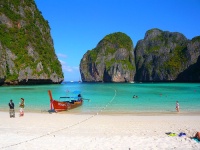
Photo credit: Eulinky
Phi Phi Don, the larger island, has idyllic tropical beaches lining its shores and Ton Sai Bay, the main tourist centre on Phi Phi, may be a little overdeveloped for some visitors wanting a relaxed beach holiday. Although overrun by tourists, the islands retain their spectacular quiet beauty.
Shopping in Koh Phi Phi
Koh Phi Phi's larger island of Phi Phi Don has plenty of souvenir shops, clothing stores and shops catering specifically to travellers' holiday needs. Local shops offer everything from jewellery and clothes to sports equipment. There are also mini-marts and a supermarket.
Dining in Koh Phi Phi
There is an abundance of dining possibilities on Phi Phi Don, the larger of the Koh Phi Phi islands, offering both local and international cuisine. Many restaurants are located on the beach, and there are also numerous food stalls selling pancakes and fruit shakes. Most restaurants are in Ton Sai, but each holiday resort has its own restaurant. Pee Pee Bakery has good sandwiches and cheap Thai food. Seafood buffets near the pier are the best place to find the fresh catch of the day, and Mama Resto is a popular option on Phi Phi Island.
Activities in Koh Phi Phi
Despite its small size, the nightlife of Koh Phi Phi is pretty legendary, and after sunset the sleepy island of Phi Phi Don comes to life with a selection of activities. There are parties at most beach bars and clubs, and bars offer anything from reggae to jazz music. The Reggae Bar is a longstanding favourite, with late night dancing, five different bars and pool tables. There are also fire shows on the beach, cabaret shows and Thai kickboxing competitions for variety.
Things to be aware of in Koh Phi Phi
There are no cars on Koh Phi Phi, so people with walking difficulties will find the hills and lack of transport trying.
Sao Miguel
Overview
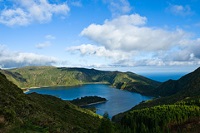
Photo credit: Peter Krimbacher
The São Miguel town of Ponta Delgada is the largest in the archipelago, and features a historic centre with pretty white-washed houses dating from the 17th and 18th centuries. There are numerous low-key holiday accommodation establishments and good restaurants. The island is famed for its delicious pineapples and intricate embroidery.
Shopping in Sao Miguel
São Miguel has a three-level shopping mall, Sol Mar, with several movie theatres in addition to shops. Popular São Miguel souvenirs include edibles like local cheese and tea.
Dining in Sao Miguel
There are a number of good restaurants, centred mostly in the towns of Ponta Delgada and Ribeira Grande. You best bet is to go for local cuisine, which is beautifully prepared by most of the restaurants in this region.
Activities in Sao Miguel
The nightlife in São Miguel is low-key and café-based, but there are a few lively bars in Ponta Delgada and Ribeira Grande that stay open quite late. Most of the night hangouts are low key establishment, often serving up live music and a few pool tables to keep guests entertained.
Things to be aware of in Sao Miguel
Avid partiers will find São Miguel's nightlife lacking.
Izmir
Overview
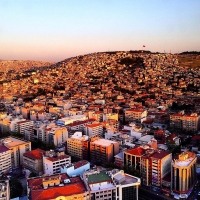
Photo credit: Mighty Travels
Lively and cosmopolitan, Izmir is also scenic thanks to its palm-lined promenades lining the bay, backed by graceful avenues with attractive horizontal terraces rising up the slopes of the surrounding mountains.
Visitors come to see the sights, haggle in the colourful bazaar, and dine on delicious meals at the many waterfront restaurants. Formerly known as Smyrna, Izmir is ancient and dates back to around 3,000 BC. But today it is thoroughly modern having been almost obliterated by a fire in 1922 and subsequently rebuilt.
There is some worthy sightseeing to be done in the city, such as the 19th century clock tower, the 18th century Konak Cami Mosque, and an archaeology museum. A must-see is the city's landmark public elevator, linking Mithatpasa Street with the summit of the hill at Halil Rifat Pasa, from where there is a stunning view across the city and the bay. The best way to enjoy Izmir is a balmy evening stroll or horse-drawn carriage trip along its promenade between Konak Meydan and Alsancak.
Shopping in Izmir
Like any modern city and holiday destination, Izmir has its share of shopping centres, and here the best stores are to be found lining the Kordon Promenades in Alsancak, Karsiyaka, and Cumhuriyet Avenue. Visitors, however, would do better to head for the atmospheric old district with its narrow streets and hidden doorways.
There are bustling markets in Konak Square and Kemeralty. There is a larger mall called the Forum in nearby Bornova. Shopping here is a fascinating experience, and travellers can buy anything from antiques and dried figs (for which Izmir is famous), to fine jewellery, hand-made shoes, and a variety of clothing.
Dining in Izmir
The holiday destination of Izmir is renowned for its many seafood restaurants. However, all tastes are catered for in this city, which is well supplied with extremely affordable and good eateries, particularly along the Kordon Boyu Promenade. The local speciality is the delectable fish Cipura. It's so popular that it is farmed and served up in dozens of city restaurants. It is best enjoyed grilled, with a salad of fresh greens and herbs and sprinkled with olive oil. Reputedly Izmir's top seafood restaurant is the Deniz, while for traditional Turkish, spiced up with belly dancing, head to Sini Sofrasi or Topcu'nun Yeri, a down-to-earth sidewalk cafe.
Activities in Izmir
Holidaymakers will find that the nightlife in Izmir can be as hectic or as sedate as they wish. Most of the after dark action for visitors is centred on the Kordon Boyu, Passport Pier, and Karsiyaka, where nightclubs and bars stay open until the early hours. 1448 Sokak in Alsancak has a number of clubs, and is a popular area for gay nightlife. More cultural entertainment is on offer too, such as performances of the Aegean Philharmonic Orchestra. The city is particularly lively during the annual International Arts Festival, which takes place between June and July.
Things to be aware of in Izmir
Visitors should be aware that temperatures can be extreme in the height of summer.
Tarifa
Overview
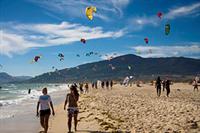
Photo credit: ardenswayoflife
Shopping in Tarifa
When it's time for shopping in Tarifa there are many options to choose from, but many of the tourist shops sell the same basic stock. The old town has a number of small boutiques and a multitude of surf shops selling all the most popular brands. The old town also has an indoor market where you can buy fresh produce and other food, including the catch of the day in the outdoor area. Tarifa also hosts a market on Tuesday mornings, which stocks tourist souvenirs, artwork, handicrafts and ceramics. You'll find many Tarifa souvenirs echo the region's Moorish heritage, with Moroccan lamps, pillows, shoes, and linens all being popular gifts.
Dining in Tarifa
Eating out in Tarifa is an adventure in Andalusian food, as the city has a mix of traditional restaurants, tapas bars, and cafes in addition to more cosmopolitan options like Italian, Moroccan, and French eateries. For the most authentic experience, simply wander through the old town and enjoy the local tapas and jerez (sherry). Cafe Azul, Cafe Mogador, Casa Juan Luis and La Trattoria are a few of Tarifa's most recommended eateries for holiday visitors.
Activities in Tarifa
Tarifa's nightlife is constantly buzzing. The city's bars are busy with the after-dinner crowd from 9am until 3am when they are forced to close by law. Popular options include Bar Almedina, which is set into the historic city wall, and the stylish Cafe del Mar Tarifa. The clubs take over where the bars leave off, carrying on the party until around 8am. These include the house venue Club New Rif, the historic La Ruina, and the stylish Carpe Diem. Tarifa attracts great live music as well, including Flamenco, samba, jazz, and its own particular brand of hip hop. Many of the hotel bars host live music performances.
Things to be aware of in Tarifa
Tarifa is a very windy holiday resort, perfect for kite surfing and windsurfing, but not always ideal for those looking for relaxing days on the beach.
Varna
Overview
Photo credit: Harrieta171
The 19th-century Cathedral of the Assumption of the Virgin is an impressive landmark, while the extensive ruins of the Roman Spa in the centre of town constitutes the largest ancient building in Bulgaria, dating back to the 2nd century AD. Varna is the main port for commercial and naval shipping and has a casual, cosmopolitan atmosphere with a Mediterranean charm created by the sunny climate, calm sea, beach promenades and red-tiled roofs, popular with holidaymakers.
Varna is the gateway to the nearby beach resorts, including Albena and the mega-resort of Golden Sands, and numerous scenic spots along the coast are within easy reach, such as the nature reserve at Kamchia and the crumbling rock formations and dramatic cliffs along the Balchik coast.
Shopping in Varna
Shopping in Varna is focused on the massive Varna Shopping Mall, which is one of the largest in Bulgaria. Its shops offer everything from souvenirs and beachwear to music and electronics. There are also shopping promenades located in Bul. Slivnitsa and its surrounding area.
Dining in Varna
Eating out in Varna includes a huge selection of informal cafes and good restaurants to choose from. You can enjoy mouth-watering seafood with your toes in the sand, sample traditional Bulgarian food, or try some Bulgarian wine at one of the upmarket restaurants. Those on a budget will find plentiful wallet-friendly options.
Activities in Varna
Like most holiday beach destinations, this Bulgarian resort town has a number of nightclubs and bars along the sand and in the city centre, contributing to a vibrant nightlife. Varna is a city and has all the amenities and entertainments one would expect.
Things to be aware of in Varna
Many of the buildings in Varna are uninspired Socialist-era architecture and look slightly run-down, and the city is cut off from the beach by a large garden.
Hisaronu
Overview
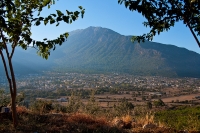
Photo credit: Chris Parfitt
Hisaronu is centrally located on the Turquoise Coast, within a short dolmus(local taxi) ride from the busy centre of Fethiye, the beautiful seaside resort of Oludeniz with its blue lagoon and crescent beach, and numerous sites of interest.
The town of Hisaronu itself is a bit of a hodgepodge of buildings, but the surrounding area offers a ruggedly beautiful landscape covered in pine forest, ideal for holidaymakers keen on walking, and a coast filled with secluded bays and coves accessed through winding forest paths. Being set at high altitude the town also has the advantage of being cooler and less humid than the coast, a pleasant refuge to retreat to after a day in the summer sun.
Shopping in Hisaronu
The main street of Hisaronu is well supplied with a variety of stores selling everything holidaymakers look for in Turkey, including fake designer wear, carpets, and leather goods. Haggling is expected and part of the shopping experience, and there is a beachfront minimarket that offers a number of bargains.
Dining in Hisaronu
Hisaronu has a veritable smorgasbord of restaurants to cater for the tastes of international tourists, including traditional English, sizzling pizzas, and spicy Mexican. Most are along the main street, including favourites such as the Shine Indian Restaurant and the Dragonara Chinese Restaurant. For traditional Turkish delights the Olive Tree is hard to beat, while Malibu offers a mixture of English and Turkish cuisine. Travellers shouldn't overlook the street vendors and their delicious kebabs.
Activities in Hisaronu
The nightlife of Hisaronu on the Turquoise Coast is legendary, its clubs and pubs rocking until the early hours during the summer season. Holidaymakers will find everything from Turkish-themed nights to British soccer, 60s discos, or full-on nightclubs. Most clubs are centred round the main street of town.
Things to be aware of in Hisaronu
During the summer months the beaches can be a little crowded so it's best to secure a spot early.
Pamporovo
Overview
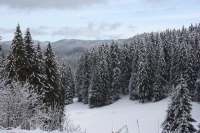
Photo credit: Okotuki
Shopping in Pamporovo
The main shopping centre in Pamporovo, containing mostly boutiques, souvenir shops and sports gear outlets, is attached to the Hotel Perelik and should amply satisfy the shopping urges of holidaymakers. There is also a shopping centre at Murgavets Hotel. Many stores sell traditional Bulgarian souvenirs, and there are a variety of shops that stock ski equipment.
Dining in Pamporovo
Pamporovo restaurants serve a wide variety of cuisine, but most holidaymakers favour the local folk taverns like the Chevermeto, where whole sheep are roasted over open fires and dancers in traditional costumes provide colourful entertainment. Lively pubs selling international staples like steak and pizza are numerous, and those looking for more upmarket dining will find a few restaurant options worthy of the fine Bulgarian wine.
Activities in Pamporovo
The nightlife in Pamporovo is lively and incredibly cheap, with plenty of options to choose from, whether you're the kind of holidaymaker who prefers sipping wine in a quiet bar, heading to one of the many pubs, or hitting the town until the early hours. Many of the most popular entertainment venues are attached to the big hotels.
Things to be aware of in Pamporovo
This is not a ski resort for experienced skiers, while there is the odd black slope, most of the skiing is gentle and unchallenging. There are plenty of pubs offering cheap booze and a good atmosphere in Pamporovo, but the après ski is not as lively as in other Bulgarian resorts.
Skiing in Pamporovo
Although Pamporovo offers skiing for all levels of experience, its nursery slopes are particularly good and beginners soon flourish. There are more than 100 well-qualified instructors available fluent in a variety of languages at the ski school centre. All the main runs start from the peak of the Snejanka at the TV tower. The most difficult ski piste is 'The Wall', a black run which offers an exciting challenge. Some great off-piste skiing and snowboarding is also on offer, but this is not really a destination for advanced skiers. Snow conditions usually excellent throughout the season.
Overview
Fernie Alpine Resort
Overview
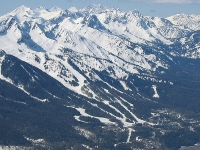
Photo credit: John Johnston
Its steep terrain has garnered a serious reputation and a certain mystique. It's the kind of resort that die-hard snowsport fans seek out to set their pulses racing. Tucked away as it is, over three hours from Calgary, perhaps the best part of Fernie is the lack of crowds with regulars trying to reserve its magic for themselves.
Skiers and snowboarders can enjoy uncrowded open runs and more than 2,500 acres (1,011ha) of skiable terrain. Those taking a break from the slopes can explore the picturesque town of Fernie, three miles (5km) from the resort, or indulge in some fireside drinks and a post-mortem of the day's runs.
Shopping in Fernie Alpine Resort
The resort of Fernie is by no means a celebrated shopping destination, but there are plenty of stores where holiday visitors can enjoy browsing (particularly on 2nd Avenue in downtown), including food, alpine sport stores, local arts, crafts and glassware shops, and jewellery and clothing stores.
Dining in Fernie Alpine Resort
Although relatively small and out of the way, there are plenty of dining options for holidaymakers to enjoy on and off the mountain, with Indian, Thai, Japanese, Mexican, and Italian cuisine to supplement the more traditional Canadian fare. There are both upmarket and more casual eateries on offer.
Activities in Fernie Alpine Resort
Fernie has a laidback, relatively quiet nightlife, so it's not for holidaymakers looking for a huge off-slope party. The Grizzly Bar is perhaps Fernie's most popular off-the-slopes hangout and attracts quite the crowd. Hosting thirsty skiers since 1962, visitors enjoy live music and dancing on weekends. There are some other venues selling cocktails and offering live music for visitors who are in search of some evening drinks and entertainment.
Things to be aware of in Fernie Alpine Resort
The skiing at Fernie is mostly aimed at advanced and intermediate levels, and can be a serious challenge for beginners. Those looking for serious nightlife, shopping, and extensive après-ski activities will be disappointed.
Skiing in Fernie Alpine Resort
Fernie offers some incredible snow conditions and can boast up to 29 feet (9m) of magical powder each year, with some of the steepest inbound terrain around. There is plenty of variety and terrain, although the resort is perhaps rather challenging for beginners.
A good idea is to take advantage of the free mountain tour to get orientated, as well as learning about potential avalanche zones. There is excellent snowboarding on offer too. Along with a half pipe and a terrain park, there is awesome natural terrain to explore. There are also plenty of ski schools for beginners, 10 lifts, and a vertical drop of 2,816 feet (858m).
Knysna
Overview
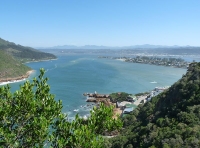
Photo credit: michael clarke stuff
The town has an interesting history, having started as a point of export for timber cut from the surrounding dense forests (which have been badly denuded as a result). In the early 19th century, Knysna was almost solely owned by the enigmatic character George Rex, who was believed to be the illegitimate son of King George III of England. Rex fathered 13 children and is a legend in the Knysna area.
The town features some quaint Victorian houses, a modern commercial waterfront development, a lovely sandy beach at Leisure Isle on the east side of the lagoon, and some good shopping for local arts and crafts in the crowded town centre. There are some lovely scenic drives and walking trails through the remaining indigenous forests in the area, and sampling Knysna oysters and locally-brewed Mitchell's beer while on holiday here is highly recommended. The best time to visit Knysna is during its annual Oyster Festival, held every July, which includes live music, food, sporting events, and of course oysters!
Shopping in Knysna
Knysna's three shopping malls have a variety of shops, and there are numerous local art, craft and curio shops in and around the town centre.
Dining in Knysna
In and around Knysna one will find a selection of fine restaurants, seafood taverns, pubs, coffee shops and eateries. The waterfront has a variety of restaurants, serving food like oysters and seafood as well as traditional South African fare. There are fine dining options and international fare includes Mexican, Italian, Moroccan and Asian.
Activities in Knysna
As evidenced by its popular food and music festivals, Knysna is an entertainment hub on the Garden Route and boasts a vibrant nightlife. This picturesque small town is home to more than 50 restaurants and pubs. There are also a handful of vibey dance clubs and live music venues. December and January is peak season in Knysna, with crowds of night-time revellers descending from along the coast; in the winter off-season the town is significantly quieter.
Things to be aware of in Knysna
In the peak summer holiday season, Knysna gets very crowded and accommodation is difficult to find. The national highway N2 passes through the centre of town and traffic jams are common.
Pas de la Casa
Overview
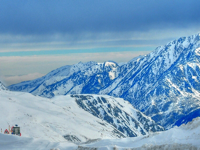
Photo credit: Victor Vic
Set at an altitude of 6726 feet (2050m), this lively resort town is linked to the nearby Soldeu resort and the wider Grandvalira ski area, providing miles of pistes suited to all levels of skiers and snowboarders. With its high altitude and good snow making facilities, snow conditions here are excellent and the resort rarely closes before April.
Pas de la Casa, or 'Pas' as it is fondly known by loyal regulars, can hardly be described as picturesque, consisting mainly of modern, unattractive box-like apartment blocks and hotels. But all the accommodation and facilities are conveniently situated near the slopes and provide all the trappings necessary for an entertaining winter holiday at affordable prices.
Shopping in Pas de la Casa
Pas de la Casa, like the rest of Andorra, stands out as one of the world's best duty-free shopping enclaves, its shopping precinct a gold mine of holiday bargains. There are, of course, sports shops for snow gear, but shoppers here also stock up on electronic goods, perfumes and cosmetics, designer clothing, and car and motorbike accessories, from tyres to leathers.
Dining in Pas de la Casa
With dozens of restaurants in and around Pas de la Casa, no one working up an appetite on the slopes need go hungry. Local cuisine is largely Spanish (with paella as a favourite) but there are plenty of French influences on the local menus. Most restaurants are family-run, with El Marselles being one of the favourites. There are some excellent mountain restaurants too, and many more cafes and restaurants in town offer everything from quick snacks to gourmet delights.
Activities in Pas de la Casa
Pas de la Casa stands out as the liveliest ski resort in Andorra, keeping the young crowd partying throughout the night with throbbing music and cheap drinks. Local bars can often extend happy hour to extremes.
Things to be aware of in Pas de la Casa
The village is not much to look at and can become quite rowdy in the evenings, and at weekends it's busy with traffic and weekend crowds from France. Pas de la Casa is not the ideal destination for a family holiday with young children, and advanced skiers will find more interesting skiing in the Alpine resorts.
Skiing in Pas de la Casa
Skiing and boarding in Pas de la Casa caters for all standards. With its good ski schools and gentle slopes, the resort is particularly suited to beginners and intermediate skiers. There is some good off-piste skiing above Grau Roig, but advanced skiers will find few challenging on-piste slopes. The resort is popular with snow boarders.
Cortina d Ampezzo
Overview
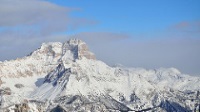
Photo credit: Manuel Bierbauer
Many rarely make it to the slopes as they'd prefer to enjoy the restaurants and shops, and to wander through the streets in their finery, partaking in the passeggiata, which is the traditional Italian early-evening stroll. This leaves the slopes wonderfully empty for those who come to ski. Cortina is a two-hour drive from Venice or Innsbruck.
Shopping in Cortina d Ampezzo
Cortina offers some of the best and most upmarket shopping of any European holiday ski resort through a number of clothing boutiques and plenty of spots selling ski and snowboarding equipment, which during summer focus on mountain biking needs. Shopping is one of the perks of a holiday in Cortina, fuelling the resort's fashionable reputation.
Dining in Cortina d Ampezzo
Cortina is all about traditional Italian fare and holidaymakers can enjoy delightful, cosy restaurants offering good times and great views. Must-eat local dishes include the classic casunziei (beet-filled pasta envelopes sprinkled with poppy seeds) and canederli (bread dumplings). Both fine dining and more casual options are available. Eating out in Cortina tends to be expensive, but the quality of food is generally high.
Activities in Cortina d Ampezzo
Cortina is easily as popular for its amazing nightlife as it is for its skiing. There are glamorous nightclubs and bars, which see the fashion brands and furs on parade, as well as some more basic and unpretentious apres-ski venues. However, the nightlife mostly revolves around classy wine bars instead of the karaoke venues normally found at mainstream resorts.
Things to be aware of in Cortina d Ampezzo
Cortina can get crowded with day visitors during peak periods and is quite expensive as Italian resorts go. Snow reliability can vary.
Skiing in Cortina d Ampezzo
There is skiing for all standards at Cortina, with some fantastic groomed runs for beginners and intermediates, and a scattering of challenging slopes for experts. The skiing is fragmented, with three separate unlinked ski areas. The Faloria-Cristallo ski area is closest to the town, and can be accessed via cable car rather than bus. However, at just 1225m this is not a ski-in, ski-out resort. As in much of the Dolomites, the snowfall is not that reliable, but the resort has good snow-making facilities and it's almost guaranteed that there will be snow on the pistes.
Although Cortina's popularity means the town can become busy, the slopes are generally surprisingly uncrowded and, when it does snow, there's less competition for virgin powder than in other well-known resorts. The Hidden Valley, accessed from the Lagazuoi cable car, is one of the world's most beautiful ski runs. While not particularly challenging, it winds down the mountain through stunning scenery to the river valley above the hamlet of Armentarola.
Telluride
Overview
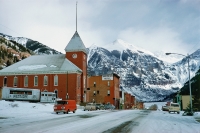
Photo credit: Chuckcars
Telluride sports a dozen or so blocks of quaint Victorian homes and clapboard storefronts, around a pedestrianised core. A unique feature of the twinned towns is the three-stage gondola system, which provides the only access to high altitude Mountain Village. Visitors take the swift, scenic and free ride to the elegant, contemporary resort town, marvelling at the panoramic views of some of Colorado's most magnificent mountain peaks. While Telluride provides the picturesque historic atmosphere, Mountain Village, founded in 1987, provides modern recreational and accommodation options for discerning guests, with luxury hotels and condominiums, sophisticated boutiques, eclectic restaurants, a championship golf course, conference centre and world-class spas. The attractive, upmarket modern facilities and stunning setting have ensured that Telluride/Mountain Village is not just a winter sports destination with eminently attractive ski slopes, but popular all year round as a mountain holiday destination. It is easy to see why the Ute Indians in days of yore cherished this valley and its guardian peaks as sacred territory.
Shopping in Telluride
For those who regard shopping as an essential part of a fun holiday, Telluride and Mountain Village have great pleasure in store. The element of surprise is what makes shopping in the pedestrianised town centres so enjoyable, because browsing among the numerous speciality shops and one-of-a-kind boutiques will turn up some interesting and unique buys. The resort is largely devoid of the regular chain retailers, outlet stores and strip malls. Instead it is packed with galleries of original art and sculpture, gift and jewellery stores sporting hidden treasures, antique stores, trendy clothing boutiques, and of course a host of sports shops with the latest gear and equipment.
Dining in Telluride
You name it, you can eat it while on holiday in Telluride, from intimate supreme cuisine establishments to buzzing family diners or cosy corner coffee shops. Recommendations are difficult with such a spread of excellence to choose from but, in Telluride town, first for formal dining is 221 South Oak, mere steps from the gondola station, with a menu that changes daily and a deserved reputation for fine food and wine. There are plenty of family-friendly options serving up pizza, burgers and other favourites too. Up in Mountain Village the fare is enhanced by the views from most restaurants.
Activities in Telluride
Aprs-ski in Telluride tends away from wild partying, but this does not mean the nightlife is dull. The West End Bistro at The Hotel Telluride is one of the more popular options; it's where skiers sip their drinks to the tune of background music, ensconced in leather chairs before a roaring fire.
Things to be aware of in Telluride
The terrain can be quite challenging and timid skiers and beginners will struggle with some of the slopes.
Skiing in Telluride
The Telluride ski area offers 1,700 acres of lift-served terrain, 24 percent of which is perfect for beginners, the rest equally divided to suit intermediate and advanced skiers. Beginners soon gain confidence on the Prospect Bowl's long, gentle runs, which is why the resort is renowned as being perfect for novices. Intermediates can stroke their ego too, rock 'n rolling down runs such as Sandia, Magnolia and Stella that will make them feel like experts. Telluride's signature run is named See Forever, which is what happens as skiers glide down the two miles (3km) of mountainside. Awesome views are the order of the day too for the experts, who can take on daring snow highways such as The Plunge, or opt for a choice of double-diamond backcountry experiences.
St Moritz
Overview
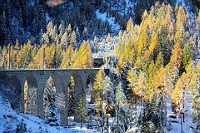
Photo credit: trombone65
Consisting of two villages, St Moritz-Bad on the lake and St Moritz-Dorf on the hillside above, its romantic setting in the wildly beautiful corner of the southeastern Swiss Alps is a combination of forests, mountain and lake that has twice hosted the Winter Olympics. A St Moritz holiday guarantees some of the most reliable and abundant winter snowfall in the country, and the miles of downhill runs offer some of the finest intermediate skiing anywhere.
The St Moritz area also encompasses a network of cross-country ski trails, legendary toboggan and bobsled courses, and an Olympic ski-jump. The spa section of this exclusive and exciting town, St Moritz-Bad, offers the long-time tradition of mineral baths, mud baths and spa therapies for a relaxing spa holiday. The nightlife on a St Moritz holiday is renowned as the most energetic and expensive of all the alpine ski resorts.
Shopping in St Moritz
With its reputation for style and elegance, St Moritz inevitably draws the elite of the world to its winter sports season and caters for them in its shops as well. Hundreds of designer boutiques are crammed into the resort leaving shoppers on a St Moritz holiday overwhelmed by the number of choices representing international brands and trends. Even the less well-heeled can indulge in pleasure simply by window-shopping.
Dining in St Moritz
In line with its promotional tag as being 'on top of the world', St Moritz does not lack for gourmet fare. A variety of delicious international cuisine is on offer in elegant formal restaurants, romantic rustic rendezvous, chic cafes and snow bars. Even the several pizzerias here are elegant, wood-panelled edifices with upholstered chairs, where the traditional base and toppings become a work of gastronomic art. Elegant fare can be had at popular eateries such as Talvo and White Marmite.
Activities in St Moritz
A refined new casino is the latest addition to St Moritz' renowned nightlife and entertainment scene, which encompasses close on 30 other nightspots ranging from hot nightclubs to cosy hotel bars, and discos to demure cigar bars. Bobby's Pub is a popular English-style bar, and the posh Badrutt's Palace Hotel offers a disco for those bent on dancing.
Things to be aware of in St Moritz
St Moritz contains some hideous block buildings and lacks the classic Swiss 'chocolate box' charm, especially during the summer. There are no proper beginner slopes at resort level and there are very few blue (easy) runs in the area. Spread over several unlinked mountains, the ski terrain is vast and transport is needed between most areas. The holiday resort is exclusive and very pricey.
Skiing in St Moritz
The St Moritz area has five major holiday resorts in the immediate vicinity, which can all be accessed by a general ski pass. Due to the altitude of between 5,906ft and 10,827ft (1,800m to 3,300m) the area is fairly snow sure, but there are also extensive snowmaking facilities available. St Moritz is ideal for intermediate skiers and snowboarders, as about 70 percent of the terrain is suited to the intermediate level.
Each of the four larger mountains also has challenging terrain for advanced skiers, a favourite being the famous Diavolezza-Morteratsch Glacier and the long steep runs from the summits of Lagalb and Diavolezza. The Corviglia-Piz Nair ski area is the most convenient and can be accessed by foot from most hotels in St Moritz.
Piz Nair is the highest skiable peak in the area at 10,030ft (3,057m) and is suited to more advanced skiers and snowboarders, while Corviglia has many broad intermediate runs. Corviglia is also the most versatile area for all abilities with slopes high up for beginners. The St Moritz Ski School for skiers and boarders is ranked as one of the top in the world, and has highly trained instructors for all levels.
Sidari
Overview
Photo credit: C messier
Shopping in Sidari
Visitors will find plenty of shopping along the main strip, where there are many souvenir shops selling quality merchandise. The island is noted for its gold and silver jewellery, leather goods, painted ceramics and olive-wood items.
Dining in Sidari
Sidari has many restaurants offering anything from authentic Greek fare to Western staples. Many of the most popular restaurants are on the beachfront.
Activities in Sidari
Sidari has a range of bars and nightclubs. Visitors can expect lots of action, particularly during the peak tourist season.
Things to be aware of in Sidari
Sidari's main strip can become quite noisy due to bars and clubs closing late. The area's lack of cultural and historical attractions puts many travellers off.
Zermatt
Overview
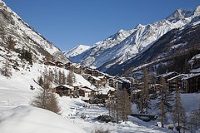
Photo credit: Kosala Bandara
The village of Zermatt can only be reached via a spectacular cog railway from the valley below. Its network of super-efficient cable cars, gondolas and cog railways is one of the best in the country, and it connects to three separate ski areas and to altitudes of over 12,000ft (3,600m). Twenty-one of the 36 lifts also operate during the summer to cater for the busy hiking and climbing season.
There are also plenty of non-skiing holiday activities in Zermatt, which include superb views, some of the best mountain restaurants worldwide, and a raucous nightlife to keep everyone entertained. The Matterhorn Museum commemorates the tragic first ascent of the Matterhorn in 1865 and the many lives claimed by 'the killer mountain', as well as telling the story of Zermatt.
Shopping in Zermatt
Switzerland is renowned for high-quality products, and most of them are on offer in the dozens of classy shops that line the main street of Zermatt. Options include fine Swiss watches, classic Swiss army knives, and T-Shirts bearing an image of the mighty Matterhorn; cuckoo clocks and fluffy toy animals abound, as well, and there is enough jewellery to stock a treasury. Being a ski and climbing resort, Zermatt also boasts several stores offering the latest in equipment and outfits, and there are also numerous designer clothing boutiques.
Dining in Zermatt
The holiday hub of Zermatt excels particularly in the area of fine dining, but those who prefer something a little more basic can also find McDonalds in the Main Street. The most charming dining experiences are offered at the mountain restaurants in little villages (such as Sunnegga, Rothorn and Findeln) surrounding the town, where quaint chalets have been turned into gourmet kingdoms, and view sites topped with terraces offer hearty snacks and warming drinks. The mountain restaurants specialise in luncheons, and reservations are advisable.
In Zermatt itself there are plenty of restaurants throughout the town. Regarded as one of the best is the Rotisserie La Broche in the Zermatterhof, and its prices match its elegant and flawless reputation. Part of the Zermatt experience is to enjoy a traditional Swiss fondue (either meat or cheese). The Stockhorn Grill Room is highly recommended for fondue, as is the Cafe Du Pont set at the south end of the main street. Homegrown lamb is another local speciality, prepared in a variety of delicious ways.
Activities in Zermatt
The evening fun begins when skiers are wending their way down the slopes heading home, stopping off to warm up with schnapps or a mug of hot spiced wine in one of the cosy mountain stubli. In Zermatt itself, restaurants tend not to open too early, so before dinner drinks are called for at one of the multitude of bars hidden away in the village alleys, or the firelit pubs in the hotels. To dance off the effects of dinner later there are discos aplenty. The hottest spot in town is the Post Hotel, which has a disco and a jazz bar.
Skiing in Zermatt
Abundant snowfall, high altitudes and the glacier area of the Klein Matterhorn allow Zermatt to offer some of the finest skiing in Europe, and glacier skiing can be enjoyed well into the summer. The high and extensive terrain stretches across three individual mountains and mainly caters for intermediate and experienced skiers. The resort is best known for its excellent powder skiing, although off-piste areas and unofficial runs should only be explored with a guide, due to sudden drop-offs and avalanche risks. Intermediate skiers have a wide range of slopes to enjoy around the Zermatt-Matterhorn Ski Area and it is possible to ski across all three mountains in a day. Klein Matterhorn is reached by the highest aerial cable car in Europe, which provides access to a snowboard half pipe and one of the longest ski runs in Europe, an exhilarating slope with breathtaking views that drops all the way down to the village.
Jackson Hole Mountain Resort
Overview
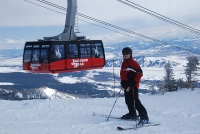
Photo credit: Enricokamasa
Shopping in Jackson Hole Mountain Resort
The square in Downtown Jackson is where holiday visitors should head for any kind of serious shopping atmosphere. There are no malls, but surrounding the square are a variety of shops from fine art and hat shops to a range of speciality shops. Those looking for recreational equipment and outdoor gear will be in their element among the skiing, snowboarding, climbing and hiking shops both in Jackson and Teton Village. Holidaymakers in Jackson Hole will enjoy browsing through everything from elk antler chandeliers and cowboy boots to Oriental rugs and American Indian craft stores.
Dining in Jackson Hole Mountain Resort
On-mountain restaurants offer breakfasts and lunches for hungry skiers and snowboarders; Casper Restaurant offers the largest variety of food and has some of the best fare on the mountain, as well as superb views over the valley. For a winter dining experience with a difference, the Solitude Cabin Dinner Sleigh Ride offers a horse-drawn sleigh ride along an alpine trail at Teton Village and a four-course meal at Solitude Cabin. The valley offers many restaurants ranging from fine dining to BBQ cookouts. The Snake River Brewing Company in Jackson Hole has an excellent and affordable menu as well as internationally acclaimed microbrews, while the Mangy Moose Restaurant provides a fun and family friendly, western experience with good food and fine wine.
Activities in Jackson Hole Mountain Resort
The number one après ski establishment is the Mangy Moose Saloon in Teton Village, with live entertainment for holidaymakers to enjoy, as well as good food. Another favourite spot to kick off the evening is at the Snake River Brewing Company with excellent microbrews. There are plenty of bars, saloons and cowboy cafes in the valley to provide a place to drink, meet friends, dance or play a game of pool.
Things to be aware of in Jackson Hole Mountain Resort
Families are not well catered for as the skiing and snowboarding is best suited to experts and there are limited beginner and intermediate trails.
Skiing in Jackson Hole Mountain Resort
With a vertical drop of more than 4,000 feet (1,220m), Jackson Hole Mountain Resort is better known for its challenging terrain best suited to expert skiers and snowboarders. The steep, demanding topography on Rendezvous Mountain is deservedly famous for its chutes, couloirs, bowls and glades, and can only be reached by two 63-passenger Aerial Tram cars. Thousands of acres of backcountry skiing are also available. Après Vous Mountain is the intermediate mountain with 2,100 vertical feet (640m) of groomed runs and open bowls offering exciting skiing on more friendly slopes, and also has gentle beginner slopes at its base. The Mountain Sports School has private and group ski or snowboard lessons, children's programmes and alpine and backcountry guides.
Ixtapa
Overview
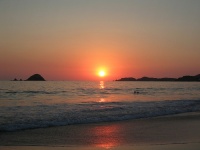
Photo credit: RussBowling
Ixtapa is home to the all-inclusive luxury resorts, international restaurants, and upscale shopping most people associate with Mexican beach holidays. The neighbouring town of Zihuatanejo has a very different character, and has become known as a quaint backpackers' hotspot with picturesque winding streets, lots of art galleries and folk appeal, small boutique hotels, and traditional seafood restaurants. The proximity of this more bohemian beach hangout offers visitors a change of scene and mood and more options for dining and accommodation.
With breathtaking views, sugary white beaches, offshore tropical islands, two world-class golf courses, exciting scuba diving and snorkelling opportunities, mouth-watering restaurants, and a pulsating nightlife, Ixtapa is fast becoming a popular choice for holidaymakers looking for the perfect beach holiday in Mexico.
Shopping in Ixtapa
There is a good selection of shops available throughout Ixtapa, from boutiques and famous brand and designer names and jewellery stores to specialist shops and craft markets selling local wares. Ixtapa Boulevard is the place to go for shopping centres and stores, as well as the artisan market where popular buys include huaraches(handmade leather sandals), wooden sculptures, art, jewellery, furnishings, beachwear, sarongs and traditional masks. Those looking for the quintessential Mexican souvenir need look no further than Tequila Por Favor,Zihuatanejo's first liquor store, which offers an amazing variety of tequila, fine spirits, and Cuban and Mexican cigars.
Dining in Ixtapa
With some of the most picturesque and romantic beach-side settings, those looking for a night of wining and dining will find there is no shortage of quality restaurants and eateries in Ixtapa. For some of the best seafood around, try 4 Hermanos, and for bit of spice, look no further than Deborah's Chili Beans on Ixtapa Boulevard. For a more familiar dinner, head to Porto di Mare for a bit of Italian fare.
Activities in Ixtapa
The nightlife in Ixtapa is second to none with a good selection of restaurants, bars, clubs and discos to keep you partying into the early hours. Sip a cocktail under the tropical overhang at La Playa Bar in the heart of Zihuatanejo. Head for the world renowned restaurant-cum-disco on Ixtapa's beach, Carlos 'n' Charlie's, to enjoy some of the finest BBQ ribs and dancing. Or head to Bandido's for live music from Wednesday through Saturday. Senor Frog's and Christine on Ixtapa Boulevard see the DJs spin a mix of pop and disco to keep the party going.
Things to be aware of in Ixtapa
There are a lot of peddlers and hawkers along the beach in Ixtapa which can become a nuisance for travellers.
Overview
Puerto del Carmen
Overview
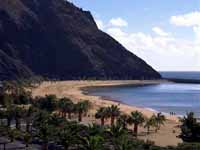
Photo credit:
Shopping in Puerto del Carmen
Puerto del Carmen is stuffed with shops of all kinds, from duty-free electrical stores and stalls along The Strip targeting holidaymakers, to the excellent clothes shops and boutiques in the Old Town. The Sunday Market in Teguise is worth a visit: as well as the usual tourist tat and holiday souvenirs visitors will find a variety of locally produced goods from pottery to tablecloths. Puerto del Carmen is perhaps the best Lanzarote resort for shopping.
Dining in Puerto del Carmen
There are hundreds of restaurants to suit all holidaymakers' tastes and wallets in Puerto del Carmen, the most popular including La Bottega Della Pasta, Casa Bodeco's, Bodega, and Chiquito. Most restaurants are on The Strip, serving everything from local cuisine to fast food, as well as Chinese, Mexican and Indian food. There are many fine restaurants near the harbour in the Old Town. Those wanting to get out of Puerto del Carmen for the evening can take a taxi to the old capital, Teguise. It has a lovely atmosphere in the evening and a few good restaurants.
Activities in Puerto del Carmen
Puerto del Carmen is the main nightspot on the island and its population swells most evenings as tourists from other holiday resorts come to enjoy its bars and clubs. There are loads of good English, Irish and Scottish bars in the New Town along The Strip. The Centre Atlantico has a number of cocktail bars and can be a good spot to start the evening. The Hippodrome is also here but more serious clubbers may prefer Caesars. There are also several live music venues and karaoke bars, while the Star Bar provides great family entertainment.
Things to be aware of in Puerto del Carmen
Whilst water is safe for cleaning teeth and washing food, it is very high in mineral content and can cause bad stomachs. Bottled water should be used for drinking. There are lots of people trying to sell tourists everything from trinkets to timeshare apartments; if you are not interested avoid getting into a conversation.
Paguera
Overview
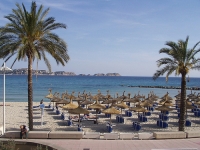
Photo credit: -Greg
Shopping in Paguera
Paguera features El Bulevar Street, which is a long stretch of shops behind the pedestrian promenade where holidaymakers and shoppers can splurge on designer clothes, jewellery, leather goods and other Spanish holiday souvenirs. Visitors should be sure to explore the boutiques and smaller shops in the side streets along El Bulevar. There is also a lovely market at nearby Andraitx on Wednesday mornings that is worth exploring.
Dining in Paguera
In Paguera, the top-rated restaurants for holidaymakers include La Grita, Casa Rustica and La Gran Tortuga. The resort offers a number of different restaurants with a variety of fare; many cater for the German palette, though some offer local dishes and excellent Spanish seafood. There are also various sidewalk cafes and bistros along the promenade.
Activities in Paguera
Paguera has a good range of bars, and although many cater to German holidaymakers, there are British style pubs available too. There are some low-key discos, a number of live music venues and a few nightclubs, but although it is a lively resort Paguera's nightlife pales in comparison to the neighbouring resorts of Magaluf and Palma Nova. These party resorts are only a hop and a skip away though, so those in search of fun after dark shouldn't struggle to find it.
Things to be aware of in Paguera
Paguera can get highly congested and parking space is limited. Many of the hotels are up on the hills behind the town centre, which can pose a problem for those with disabilities, the elderly and parents with pushchairs.
Salou
Overview
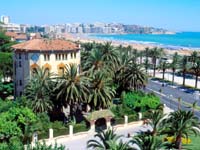
Photo credit: Provincial Government of Tarragona Tourism Board
Shopping in Salou
There is a good selection of souvenir and fashion stores in Salou, and holidaymakers who want to enjoy more extensive shopping can hop on a train and travel to the renowned shopping paradise of Barcelona, just 40 minutes away. Self-caterers will easily find all they need within the resort and there is a flea market in the old town centre of Salou on Mondays.
Dining in Salou
Eating out is relatively cheap and although many places cater to holidaymakers and British palates with international stables and pub grub, there are also plenty of good Spanish seafood restaurants and traditional tapas bars. There are Chinese and Italian restaurants as well for those wanting some variety.
Activities in Salou
Holidaymakers looking for a good night out in Salou will find plenty of fun bars, including popular options like Christy's Irish Bar, 007 Bond, Double Scotch or Charlie Chaplin's. The nightlife is varied, with flamenco venues, nightclubs and discos, but it may still be a a bit quiet for those meaning to do some serious partying. Luckily, Barcelona is under an hour away by train and well worth a visit for an energetic and atmospheric night out.
Things to be aware of in Salou
The beaches in Salou can get very crowded in July and August; however, quieter beaches and empty coves can be found nearby.
Playa la Arena
Overview
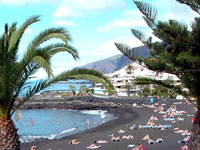
Photo credit: LosGigantes.com
Shopping in Playa la Arena
Duty-free shopping is one of the big attractions of a visit to Tenerife. The best mall for consumer goods is in the nearby town of Los Gigantes, although the Commercial Centre in town has a decent range of shops as well.
Dining in Playa la Arena
Many international restaurants and tapas bars line the well-developed promenade at Playa la Arena. British-style pub food is widely available. It is worth sampling some of the delicious Canarian dishes, such as salty new potatoes boiled in sea water, baked with a spicy mojo sauce. The variety of restaurants in the three connected resorts is more than sufficient for all budgets and tastes. Some of the restaurants and bars close in winter when the resort empties out.
Activities in Playa la Arena
Although there are many bars and cafes, proper nightclubs are few and far between in Playa la Arena, and most after dark entertainment is limited to what the all-inclusive hotels offer their guests. It is a peaceful, family resort which is not well suited to those seeking an energetic nightlife. However, there are some popular party resorts nearby, such as Playa de las Americas.
Things to be aware of in Playa la Arena
This area is very hilly and therefore challenging for people with walking difficulties or parents with prams. The sea can have strong undercurrents so take red flag lifeguard warnings seriously.
Overview
Kavos
Overview
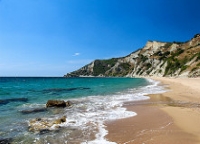
Photo credit: Alex Alishevskikh
Shopping in Kavos
Shopping in Kavos is mostly limited to souvenirs. Visitors who want more to choose from can catch regular buses to Corfu Town, which has excellent gold, lace, leather, silver and ceramic items. Self-caterers will find essentials at mini-markets.
Dining in Kavos
Most tourists choose to eat in their apartments, but those who are looking for a night out will find a wide choice on the menu, from local delicacies to seafood, curries and traditional English pub grub.
Activities in Kavos
Kavos is one of the top party destinations in Greece and is crammed full of bars and clubs with music, dancing and karaoke. All sorts of day and night-time entertainment is available, from booze cruises to foam parties, themed club nights, and resident DJs. Most of the activity is centred on the main strip, where bars lure in early drinkers with happy-hour deals.
Things to be aware of in Kavos
The nightlife in Kavos is famously vibrant and the resort is probably not ideal for families or those seeking a relaxing holiday. Pushy touts come from far afield to steer travellers to clubs and can be a source of free drinks if handled well. Visitors should watch out for pick pockets.
Overview
Magaluf
Overview
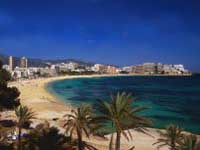
Photo credit: Jason Dixon
Shopping in Magaluf
The promenade and streets in the centre of Magaluf are lined with dozens of shops selling beachwear, souvenirs and other Spanish vacation souvenirs geared towards holidaymakers. Better shopping can be found in Palma, an easy taxi or bus ride away. Every Monday there is a market in Calvia, six miles (10km) inland; good buys here include porcelain, jewellery and leather goods. There is also a popular market in Inca each Thursday for those who want to go farther afield. There are good supermarkets for shopping in Palma Nova and Magaluf, that stock all the well-known international brands, as well as local produce. Most things are good value, particularly alcohol and cigarettes.
Dining in Magaluf
Magaluf is a resort favoured by young budget holidaymakers, and it therefore has an abundance of fast food outlets. Those in self-catering accommodation find they are never very far from a familiar name like McDonalds, Burger King or Pizza Hut. The resort also has a wide selection of restaurants, the majority catering to British tastes. There are several restaurants that offer Sunday roasts and other favourites like bangers and mash, fish and chips and shepherd's pie. For variety there are Indian, Chinese, Mexican, Italian and even some Spanish restaurants too.
Activities in Magaluf
It is the pulsating nightlife that brings holidaymakers to Magaluf, and therefore there is no lack of bright lights after dark, with the party swinging into, and beyond, dawn every night. Most start the evening in one of the plethora of bars and move on to dance or themed parties hosted by top DJs in the numerous clubs along the famed Punta Ballena strip. Touts line the strip seducing customers into their establishments with special offers on drinks and cocktails. The most renowned of Magaluf's clubs is the massive BCM, which uses around three million gallons of bubbles to cover its floor on its famous foam party nights. Other well-known names are Carwash, Bananas and Boomerangs. A popular alternative to drinking and clubbing is an evening at the Pirates Adventure themed dinner and show.
Things to be aware of in Magaluf
Magaluf is geared mainly for young Brits looking for a loud and lively holiday; it's not a great destination for those after peace and tranquillity. Although it has improved in recent years, the skyline of Magaluf remains characterised by 1960s and 70s apartment blocks and the resort is packed with salesmen; the street vendors are best avoided but the 'PRs' outside the bars and restaurants can be worth chatting up as they offer free drinks. Visitors should be aware of the pickpockets on the beach at night.
Benidorm
Overview
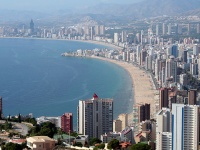
Photo credit: po.psi.que
Remnants of Benidorm's historic past are now well hidden, but tucked into the Casco Antiguo section are the ruins of a castle built in the 14th century to fend off Berber pirates. Benidorm's spectacular sunsets are best viewed from the castle's mirador(balcony). The place to see and be seen in the town, however, is the Playa de Levante, a two-mile (3km) boardwalk lined with trendy cafés and bars. Benidorm is a wildly popular resort with all the amenities one would expect.
Shopping in Benidorm
The streets of Benidorm are lined with gift shops catering for people on holiday and the supermarkets are fully stocked with well-known brands. Prices in the holiday resort are comparatively cheap, particularly alcohol and cigarettes. There is an open-air market every Wednesday and a rastro (car boot sale) every Sunday next to the railway station. The town of Altea is worth a visit on Tuesdays for its outdoor market or simply for a leisurely stroll along the promenade, while Alicante is a good destination for shoppers in search of some more sophisticated shops.
Dining in Benidorm
Top-rated restaurants in Benidorm include Paneil's, China Garden, India Gate, Mme Butterfly, The Vagabond and Witches Bistro. All the major fast food restaurants are also available and the old harbour is the best place to try out the local cuisine. Benidorm has a wide range of restaurants catering to all budgets.
Activities in Benidorm
Benidorm is one of the biggest nightspots on the Med with something to suit all preferences. There are loads of bars hosting live shows, quizzes, bingo, karaoke and drag shows, and lots of live bands playing everything from Abba to ZZ Top. Those looking for a party in Benidorm should go to Wheeltappers, Sinatras, the Palladium or the Stardust Benidorm. It is one of the best resorts in Spain for those seeking out a fun and varied nightlife.
Things to be aware of in Benidorm
Benidorm is not a good choice for those wanting an authentic, or peaceful Spanish holiday, but for those looking for entertainment and nightlife it can't be beaten. The resort abounds with hundreds of persistent touts trying to sell tourists everything from trinkets to timeshare apartments. There are also insistent promotions staff outside the bars and restaurants, but these may be worth chatting up as they sometimes offer free drinks.
Overview
Belle Mare
Overview
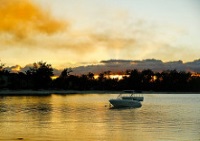
Photo credit: Natesh Ramasamy
Shopping in Belle Mare
There are small local supermarkets nearby where visitors can buy basics like snacks and bottled water (which tends to be expensive at the hotels), and there are hotel shops selling souvenirs and the like, but there is no real shopping scene at Belle Mare Plage. Everything travellers need should be available, but those wanting holiday shopping sprees may need to travel further afield to get them.
Dining in Belle Mare
Visitors to Belle Mare Plage are spoilt for choice when it comes to dining options. The Constance Belle Mare Plage hotel has seven restaurants, some of which offer elegant fine dining and others simple meals to be enjoyed on the beach. There are a variety of cuisines and budgets to choose from. All different dietary requirements are catered for. It is even possible to take cooking classes at the resort - and Mauritian food is worth learning about!
Activities in Belle Mare
The nightlife at Belle Mare Plage is limited to the variety of restaurants and bars affiliated to hotels and the entertainment offered by them. It is not considered a party resort. However, for those in search of some nighttime fun, Trou d'Eau Douce, a short way up the coast, has some livelier bars.
Laganas
Overview
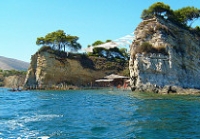
Photo credit: zolakoma
Shopping in Laganas
Visitors will find everything from grocery stores to hundreds of souvenir shops. Good buys include jewellery, leather goods, designer clothing and local crafts. The fresh bread and sweet pastries from local bakeries are particularly good.
Dining in Laganas
Laganas is awash with a huge range of restaurants, including snack bars and fast food outlets. Cuisine ranges from Greek dishes at local tavernas, to curry and pizza.
Activities in Laganas
Laganas is packed with party people on summer nights. Reputable DJs are frequent visitors and play through to the small hours and beyond. Dance clubs, pubs, cocktail bars and karaoke bars are all part of the experience.
Things to be aware of in Laganas
Laganas is one of the biggest and busiest resorts in Greece and is complete change of pace from the quiet, traditional Greek island experience. The beach is always jam-packed in the height of the season and the resort is continually full of noise and commotion. Many visitors have complained about over-insistent touts outside clubs and restaurants, and some have reportedly been misled on the quality of their accommodation. The resort doesn't offer watersports because of the nesting loggerhead turtles on the beach.
Corralejo
Overview
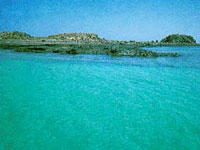
Photo credit:
Shopping in Corralejo
Corralejo is not a bad shopping destination, if visitors can drag themselves off the beaches and out of the restaurants. The main street, Calle General Franco, is flanked with shops selling everything from radios to surfboards, and sunscreen to luxury watches. There is a good craft market on Saturdays at the Caleta de Fuste where tourists can bargain for souvenirs.
Dining in Corralejo
While in Corralejo, recommended eateries for holidaymakers include El Bribon, The Point Restaurant, El Pescador and the Taverna Los Piratas Bar Tapas. Individual eateries may come and go, but the waterfront promenade boasts numerous restaurants and cafes, many in charming converted historic houses, and as the resort expands the variety only increases. Corralejo's restaurants offer a wide choice, from good old English fish and chips to Mexican tacos or Indian curry. There is also a smattering of eateries serving up traditional Canarian cuisine and fresh seafood.
Activities in Corralejo
Most of the bars and restaurants in Corralejo are on the main street, Calle General Franco. There is a variety of bars and clubs, with everything from sports bars and karaoke to dance clubs and live music venues. The high street and town square have a number of quieter restaurants and lounges. The clubs close around 1am, but the bars often stay open later. Grab a copy of the free Fuerteventura Grapevine magazine for event listings and a nightlife guide.
Things to be aware of in Corralejo
Corralejo can be quite expensive and travellers on a budget should take this into account before booking a holiday. Families should be aware that the beach area around Playa de Pozo is popular with nudists, and that there are sometimes strong ocean currents.
Megeve
Overview
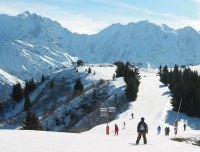
Photo credit: Leo-seta
Shopping in Megeve
Megève is the shopper's paradise of ski resorts. There are a number of chic boutiques and antique shops along the narrow cobbled streets, including clothing shops and art galleries mixed with ski equipment stores and souvenir shops. Foodies will be tempted by the delicious crèmeries, pâtisseries and boulangeries.
Dining in Megeve
There are a number of high-end restaurants in Megève, with more than a few Michelin stars between them, but there are also some cheaper options offering simple French and international fare.
Activities in Megeve
Megève has a few lively bars that make its nightlife fun and relaxed. There are nightclubs in the centre of town, and a number of bars that stay open until nearly 4am. Bars and clubs in Megève tend to be highly priced and, even when there is no entrance fee, drink prices can be exorbitant.
Things to be aware of in Megeve
Megève is not a budget ski resort and prices can be high. Advanced skiers will find few challenges on the slopes in the immediate area and the snow can be unreliable. Traffic to the resort can get very congested at weekends and in peak season.
Skiing in Megeve
Megève is fairly uninspiring for experienced skiers, but world-class resorts Chamonix and Argentiere are within striking distance, and so it still makes a good base, especially if there are non-skiers in the group. Megève itself has 186 miles (300km) of marked trails with 81 lifts, two snow parks and a half-pipe for snowboarders. The facilities are all very good, and snow coverage is generally reliable, with snow cannons on hand to make up for Mother Nature's occasional failure to provide. Chamonix is a forty-minute drive from Megève.
Moraira
Overview
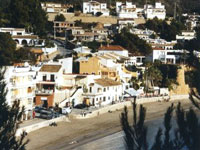
Photo credit:
This beach resort is easily accessible, being equidistant (about 62 miles/100km) by motorway from both Alicante and Valencia airports. For those who enjoy a taste of the high life, it is also within easy reach by car or bus of the busier, glitzier Costa Blanca resorts of Javea, Calpe and party-mad Benidorm. The countryside around the holiday destination of Moraira offers some lovely scenery dotted with unspoilt villages to explore.
Shopping in Moraira
There are no large supermarkets and shopping malls within the confines of the holiday resort of Moraira itself, but these can be found not far away in the approaches to the town and surrounding suburbs. In the main avenues of old Moraira, shoppers are well catered for with all manner of boutique stores selling local arts and crafts, souvenirs, holiday gear and bric-a-brac. The most fun to be had shopping, though, is at the Friday weekly market where the wares range from fresh fruit to leather goods, pottery and rugs. Good buys include wicker furniture, handbags and wrought iron objects. Serious shoppers can make expeditions to the larger resorts and towns nearby. The street market in Teulada, a few miles inland, is worth a visit.
Dining in Moraira
Despite being relatively small, central Moraira is equipped with numerous good quality restaurants, several of them Michelin starred, offering great value for money. Being a fishing community with an active fishing fleet that brings home a catch each day it follows that fresh seafood forms the base of the local cuisine, and many of Moraira's restaurants offer this in delicious abundance. For a budget meal, Visitors should look out for the menu del dia (menu of the day) offered by many restaurants, usually consisting of different courses with wine and coffee for a set price. 'Workman's specials' also feature on some menus, offering good value. Most Spanish bars serve tapas selections during the day, good for a satisfying local snack meal. Those with diverse tastes will find a variety of international cuisines among the local establishments, from English fish and chips to Greek delights, and Indian curry to pizza.
Activities in Moraira
The nightlife of Moraira is considered sedate compared to some of the larger and flashier Spanish resorts, but the town buzzes happily after dark. Many of the restaurants offer live entertainment of some description, including flamenco dancing and karaoke, and there are one or two open-air dance venues. The main club for youngsters is the Costa Sur, just outside of town, which offers a range of entertaining evenings with foam parties, striptease and the like. Other Moraira nightlife options include Saxo Disco and the music pumping Algas Beach Bar. Those who holiday in Moraira during the months of April, June, July and November will catch lively fiestas full of local colour and tradition. Calatalud Drive in the old town is generally closed off during summer and fiesta nights.
Things to be aware of in Moraira
There are no huge nightclubs or discos in Moraira and the clubbing scene is fairly low key when compared with other Spanish beach resorts in the Costa Blanca region.
Tavira
Overview
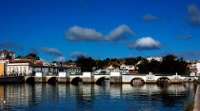
Photo credit: David Boocock
There are some attractive churches (37 of them to be exact) to see on holiday in Tavira, including the Church of the Misericordia with a beautiful Renaissance door and carved high altar. Not many of the buildings pre-date the devastating earthquake of 1755, which destroyed much of the Algarve, but the town was painstakingly rebuilt with many fine 18th century buildings.
Tavira flanks both banks of the river, which are linked by a Roman bridge. Along the coast and on an island opposite the town (reached by ferry) are some beautiful isolated sandy beaches, well worth visiting while on holiday in the area.
Shopping in Tavira
Tavira is well equipped with utilitarian supermarkets for self-caterers on holiday, and many souvenir shops selling cork items, lace, embroidered goods and shell art. There is an upmarket handcraft shopping centre called "Old Market" for discerning shoppers. The town has a fresh produce market daily.
Dining in Tavira
Like most of the holiday resort towns on the Algarve, Tavira is a food-lovers haven, especially for those who enjoy seafood. There are numerous restaurants along the quayside and riverbank, serving excellent cuisine at reasonable prices.
Activities in Tavira
There are bars and cafés aplenty in Tavira, though the town is not famous for its nightlife. Docas, near the central market, has number of lively bars. Arco Bar mixes up some great cocktails, or for a more chilled out evening The Poet, in the middle of town, always attracts a good crowd. Patrick's is popular with expats, and UBI is a sleek bar located in a former tuna factory.
Playa del Ingles
Overview
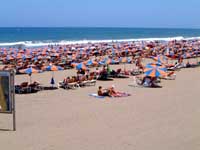
Photo credit: canaryforum
Shopping in Playa del Ingles
There is a fine choice of shops in Playa del Ingles where visitors on holiday can indulge in some duty-free delights, including cheap electrical shops and stalls selling imitation designer gear and African curios. The shopping is mainly confined to the dozen or so shopping centres and each centre has its own distinctive character. Visanta is best for duty-free electrical goods as they offer a European guarantee and refunds if visitors change their minds about something. Yumbo is the biggest and most popular shopping centre in Playa del Ingles and also houses the Tourist Information Centre. Five minutes away are the Kasbah and Metro centres, but the widest selection of quality designer wear is in nearby Plaza Maspalomas. Travellers should be aware that some salesmen can be quite aggressive. It's best to haggle hard and remember that the shop next door probably sells the same thing. The San Fernando Market is held every Wednesday and Saturday morning, offering the same sort of stuff.
Dining in Playa del Ingles
The best eateries in Playa del Ingles include Taberna La Cana for fantastic Spanish seafood, Tapas Bar Capaco for their great tapas selection, and Restaurante Hong Kong for something different. Fast food (including McDonalds), Chinese, Italian and local cuisine are all available, as well as rows of restaurants serving something with chips.
Activities in Playa del Ingles
Playa del Ingles is packed with bars, pubs and clubs, especially in the Kasbah centre, which is home to the famous Cream and Pascha nightclubs, both of which pump out the best in dance music until the early hours. Chinawhites is also immensely popular. Still in the Kasbah, the Hippodrome, Havana and Sugar, a small cocktail bar, are good places to start the evening. The English and Irish centres are also lively and entertaining. The Yumbo centre is orientated towards the gay scene at night and Rickys Cabaret Bar has regular drag shows; the centre is also popular with families looking for a less hectic evening. There are quieter bars along the promenade and a casino on the edge of town.
Things to be aware of in Playa del Ingles
Visitors should be aware that there are lots of steps from some hotels and apartments to the beach, and that the centre of the Playa del Ingles holiday resort can be very noisy late into the night. The resort is also full of salesmen and touts which can be an annoyance.
Puerto Rico
Overview
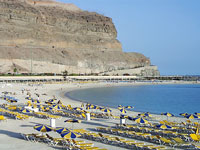
Photo credit:
Shopping in Puerto Rico
Puerto Rico boasts three large shopping and entertainment malls, the largest being the Centro Civico, where visitors can buy literally anything. There is everything from banks and boutiques to florists and fishmongers, and dozens of duty-free stores selling electrical goods, photographic equipment and perfume at great prices. The other two centres are Agua La Perra and Europa, and both have good selections of restaurants, souvenir stores and beachwear shops, and at least one supermarket. Opening hours for shops and supermarkets in the centres are about 9.30am to 10pm in the peak summer months. The largest market on the island is at Arguineguin, only 10 minutes away by taxi, and is open every Tuesday. This is a good place to test your bargaining power; hagglers should start negotiating at about half the asking price.
Dining in Puerto Rico
Like most holiday resorts on the Canary Islands, Puerto Rico has various top-rated eateries, including Caballito de Mar, Le Petit Lyonnais, Ma Bakers and El Brasero. The restaurants and fast food outlets cater for a wide range of tastes. Here visitors can dine on anything from fish and chips to haute cuisine. Most of the restaurants are in the Centro Comercial and those who like to dine overlooking the beach will find some good restaurants on the west side of the bay.
Activities in Puerto Rico
Puerto Rico has a few discos and many good bars, but cannot compare to the Gran Canarian party resorts of Playa del Ingles and Las Palmas. Nevertheless, there is plenty of fun to be found after dark in the Puerto Rico and Europa centres, and many of the hotels offer entertainment.
Things to be aware of in Puerto Rico
Puerto Rico is built on steep cliff sides and most apartment blocks are reached via long stairways. Those with difficulty walking should ensure they find accommodation on the level. The holiday resort is full of touts and 'promotions staff' from various restaurants and shops vying for business. They can be overly insistent and should be dealt with firmly but politely.
Estoril
Overview
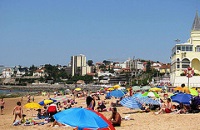
Photo credit: Enrique A Sanabria
Shopping in Estoril
Shopping is limited in Estoril, mainly confined to mini-market grocers serving the locals with a few craft shops and vendors along the beachfront. Souvenirs are available but for a real shopping spree while on holiday, visitors have to head for the large Cascais Shopping Centre a few miles away.
Dining in Estoril
The Estoril resort has a modest selection of restaurants serving both local dishes and international fare, but most tend to be rather upmarket and expensive. There are some laid-back cafes around the casino, and casual eateries along the promenade. For a superb dining experience one cannot beat the Four Seasons in the Palácio Hotel, Rua do Parque, where the gourmet menu extends from sole meneure to wild boar cutlets. An excellent fish restaurant, next to the casino, is the Costa do Estoril, a good place to indulge in the Portuguese favourite codfish.
Activities in Estoril
The main drawcard after dark in Estoril is the famed casino, which not only caters for gamblers and slot machine addicts, but also offers a flashy cabaret show. When it comes to clubs and pubs, the options are better in nearby Cascais.
Things to be aware of in Estoril
Estoril is a sedate seaside destination, not suited to children or young party animals.
Caleta de Fuste
Overview
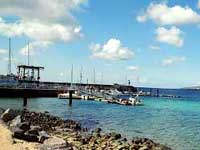
Photo credit:
Shopping in Caleta de Fuste
Caleta de Fuste is a well-equipped tourist hub with a decent selection of shops and boutiques. There is a new shopping complex near the golf course which has a cinema and bowling alley as well as some good shops. Tourists will be able to find all they need and indulge in some recreational shopping if the urge takes them.
Dining in Caleta de Fuste
The long main street of the town is lined with low-rise buildings containing several restaurants and bars, which provide a good selection for tourists. Caleta de Fuste's top-rated eateries include Fado Rock Steak House and Risto Pizza La Torre.
Activities in Caleta de Fuste
The resort has a varied nightlife, with after-dark entertainment including live music, dancing venues and activities like karaoke. For a good night out in Caleta de Fuste, stop in at Mappy's Bar. If visitors want to partake in the nightlife, it is a good idea to ensure that their accommodation is close to the town centre, as the ever-expanding nature of the resort can mean they are staying quite far from the entertainment hub.
Things to be aware of in Caleta de Fuste
Those who want to explore the island will find the resort conveniently situated, but the lack of reliable public transport can be frustrating.
Belek
Overview
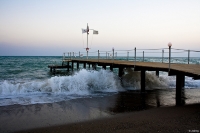
Photo credit: Jane M
Many Belek hotels have their own strip of private beach and some holiday visitors never leave the comforts of their seaside accommodation. Belek is, however, close to a number of interesting sites and there are several exciting activities on offer.
The ruins of the Roman town of Perge is an interesting excursion, as is the well-preserved ancient amphitheatre at Aspendos; its acoustics have stood the test of time and it still plays host to the occasional concert.
From Belek, jeep safaris into the mountains are another popular holiday outing, as are boat trips, watersports, and visits to nearby Manavgat waterfalls and the thermal baths at Pamukkale. Scuba diving, white-water rafting, horse riding, and more are also on offer to visitors on holiday. The town of Belek itself is compact and has a small shopping centre and some souvenir shops and some cafes to enjoy on holiday.
Kadriye has more to offer in the way of street markets and nightlife, but day trips to busier towns such as Alanya or Antalya are also available. Belek is the perfect holiday resort for golfers and those seeking lazy days lounging on a beach or by a swimming pool.
Shopping in Belek
Most of the large Belek hotels have shops selling curios and holiday souvenirs, and the town has some lively street markets that are the perfect place to sample freshly cooked food and do a spot of gift shopping. There is also a huge bazaar every Saturday where shoppers can haggle to their heart's content. Holiday makers can head to the old town of Antalya for more extensive shopping.
Dining in Belek
There is a limited choice of restaurants in Belek with most holiday visitors eating in their hotels, but the village of Kadriye is just two miles (4km) away, and easily reached by dolmus, and has a selection of shops, bars and restaurants. The nearby city of Antalya, 22 miles (35km) away, offers many restaurants that serve up some of the best of local Turkish food. Adana Ockbkbasi is a restaurant in Belek well worth a visit for its special Turkish fish and kebab dishes. Coco Bar, which serves the tastiest lamb shish kebabs around and has a cosy open-air terrace, is rated as one of the friendliest restaurants in town by tourists and locals alike.
Activities in Belek
The nightlife in Belek is largely limited to the large hotels, many of which have their own nightclubs, bars, and entertainment. There are one or two popular clubs, however, including the large Club 29 on the waterfront.
Things to be aware of in Belek
Many shopkeepers can hassle visitors who enter their stores. Those who are not interested should give a polite but firm 'no'.
Koh Tao
Overview
Photo credit: Queix
Although tourist development has exploded in recent years, turning Koh Tao's traditional dirt-road villages into a montage of holiday resorts, souvenir stalls and restaurants, there are still plenty of unspoilt spots both on the coast and inland. The main beach is Sairee Beach, stretching about one mile (2km) along the west coast, offering a range of reasonably priced holiday accommodation, dive centres, restaurants, beach bars and other facilities.
Shopping in Koh Tao
No-one could describe Koh Tao as a shopping destination, but most of the essentials required on holiday are available, including basic medicines, sun screen, swim suits, sarongs, snorkelling equipment and so on. Most of the little stalls and stores lining beachfronts and main roads carry craft souvenirs made of shells or bamboo, and there is plenty of local jewellery available. There are a few supermarkets and market stalls with a good range of foodstuffs.
Dining in Koh Tao
Not too many years ago, no one in Koh Tao would have heard of pizza or pancakes. Today, international cuisine has taken over the island and it is possible for visitors to find anything they fancy, from Tex-Mex to French baguettes or good old English steak and kidney pie. This has not been at the expense of local authentic Thai food, however, which is still available everywhere from simple street stalls to beachfront terraces.
There are dozens of restaurants, new ones opening all the time, many offering open-air barbecues and grills. Some current favourites are the Cafe del Sol grill house, with a French chef serving up delectable steaks and homemade Italian dishes; the Greasy Spoon (Mae Head), delighting Brits with full-on English breakfasts and hefty portions of fish and chips, bangers and mash, and the like; and the open-air Eagle View on a hill top near Shark Bay, offering Thai cuisine with a spectacular view.
Activities in Koh Tao
For a relaxed, idyllic island, Koh Tao has a surprisingly buzzing nightlife. When the sun sets the parties start, usually at bars and clubs right on the beach. Most of the action takes place at the main centres of Mae Had and Sairee, but there are many impromptu theme parties happening, usually advertised in shop windows or via word of mouth. Sand sculptures, crazy games, fried chicken, bucket cocktails and fire-jugglers are usually all part of the party scene. Those who prefer a more sedate evening can retire to a pub for a game of pool or darts, or sip cocktails in a laid-back lounge to the tune of some modern classics.
Things to be aware of in Koh Tao
Visitors should check the tide as often as possible, as it can be so low during a full moon that getting past the reef to snorkel can be a problem.
Alcudia
Overview
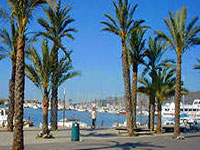
Photo credit:
Shopping in Alcudia
Alcudia doesn't have a distinct shopping district: shops selling buckets and spades and tourist trinkets line the beach road and the other small shopping areas dotted around the resort cater mainly to holidaymakers. The satellite resort of Playa de Muro has an upmarket mall with some nice boutiques and the port area has a selection of designer shops. The supermarkets are good, stocking all the well-known brands along with cheap alcohol and cigarettes. The local market opens on Tuesday and Sunday mornings and the market in Inca, 15 miles (24km) inland, opens on Thursdays. Good buys include the porcelain and leather goods, but it is a good idea to bargain hard.
Dining in Alcudia
Most restaurants in Alcudia cater to holidaymakers and unadventurous palates, with plenty of fast-food joints and cafés. There are also a few Italian, Indian, and Chinese restaurants. The better restaurants are mostly in the port area, where diners can find some decent Spanish, French, and seafood restaurants within a lovely harbour setting. Alcudia's recommended restaurants include Garlanda, Rancho Chico, Bistro Mar, and Nova Marina, as well as Cas Capella and Casa Galega.
Activities in Alcudia
Alcudia has lots of bars, pubs and discos catering for most tastes but this is not the resort for holidaymakers after some serious clubbing; for a bit of dancing, try the Mentra Disco. Many of the hotels offer in-house entertainment ranging from flamenco dancing demonstrations to stand-up comedy.
Things to be aware of in Alcudia
The resort of Alcudia is not known for its architectural merit; its skyline is dominated by 1960s style apartment blocks. To the relief of many, Alcudia is not the resort for party animals; those looking for some serious clubbing should head for the south of the island.
Sitges
Overview
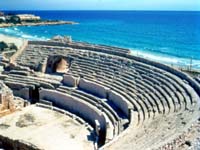
Photo credit: Provincial Government of Tarragona Tourism Board
Shopping in Sitges
Shopping in Sitges generally revolves around a number of small boutique shops and a range of designer stores such as United Colours of Benetton, Lacoste and Adolfo Dominguez. Most shops in Sitges are located along Calle Major and Calle Francesc. Shops are open from 10am until 8pm with a siesta break at around 2pm. Supermarkets in Sitges stock all the groceries and food items that holidaymakers would need for a fun beach vacation. Buying your groceries from shops located close to the beach is more expensive, while the larger supermarkets towards the back of the town are more reasonably priced. Many visitors to Sitges prefer to shop at the local markets, such as the food market next to the train station.
Dining in Sitges
Sitges has a fine selection of restaurant options and perhaps the most difficult part of dining out in the resort is choosing from the long list of fine dining options available. Mezzanine on Carrer de Espalter, Fragata and La Salseta have all garnered rave reviews. As with most Spanish coastal towns seafood and tapas are the dishes of choice, but diners should be wary of ordering seafood on a Monday as the catch may not always be fresh.
Activities in Sitges
Sitges caters for all tastes but the gay community is particularly prominent and the local Gay Pages booklet publishes a monthly list of some of the most hip and happening pink parties and clubs in Sitges. Other popular nightspots include Trailer, for its weekly foam parties, Organic and Atlantida. There are numerous pubs and bars to choose from. Being so close to one of Europe's top party cities, many Sitges holidaymakers choose to party in Barcelona on weekends, particularly on Saturday nights.
Things to be aware of in Sitges
During the peak summer season, and Carnival at the beginning of year, Sitges can be crowded and expensive. Those travelling at this time will need to book well in advance. Sitges is also one of Europe's premier gay holiday destinations and there are many nude beaches; visitors of a more conservative disposition and those with young children should bear this in mind.
Tignes
Overview
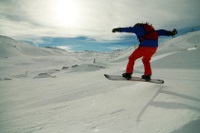
Photo credit: Gergely Csatari
Tignes is made up of three villages: Val Claret is the highest and is situated at the foot of the glacier; Tignes Le Lac, with its stunning setting on the lake, is the largest; and the modern Tignes Le Lavachet is further down. Two small villages below, Tignes Les Brévières and Tignes Les Boisses, are directly linked to the ski area and provide a more traditional atmosphere with charming chalets, narrow streets and picturesque churches. All five villages are connected by a free bus service.
Shopping in Tignes
With more than 150 shops, holiday visitors wanting to shop till they drop will be able to find almost everything in the resort area, from upmarket French boutiques to sports equipment and tourist items. Markets offer homemade goods with a traditional French flavour.
Dining in Tignes
Many restaurants in Tignes cater to the different tastes and budgets of all holidaymakers, with a wide selection of international cuisine and local Savoyard fare, from American-style fast food, pizzerias and a taste of Mexico to crèperies and chicken cordon bleu.
Activities in Tignes
The nightlife in Tignes is relatively quiet, and those seeking a more active scene will have to head to neighbouring Val d'Isère. Numerous bars and cafes cater to the off-the-slopes crowd, and several discos shake until the early hours, but the village authorities do not tolerate wild partying in the streets and general rowdiness is likely to bring on a large fine or a visit to the local jail. Tignes Le Lac and Val Claret are the liveliest villages.
Things to be aware of in Tignes
Tignes is a purpose-built resort and those seeking a traditional French-chalet style atmosphere may be disappointed. The resort is popular and prices are accordingly high. The nightlife and après-ski action is limited.
Skiing in Tignes
The ski area is large and varied, with terrain suitable to all levels of skiers and snowboarders. Val d'Isère is known for its fantastic off-piste and has good lift access. The Grand Motte glacier, at 11,335 feet (3,455m), has a wide variety of runs, from beginner slopes to challenging off-pistes for experts.
Beginners will also find plenty of nursery slopes in the villages and some nice easy runs in Val d'Isère; most beginner trails are lower down and therefore less favourable during the summer skiing season, although snow machines are used. Longer green runs are available in the Val d'Isère area, with special lift tickets offered. Skiing and snowboarding schools teach all levels in private or group lessons.
Intermediates have a large choice of groomed runs in both Tignes and the Val d'Isère area, with Bellevarde offering some challenging runs. Expert skiers and boarders have some of the best off-piste skiing in France at hand and an assortment of steep, narrow slopes, cliffs and deep gullies to choose from. The Aiguille Percée downhill course is famous in this area, but avalanches are prevalent; other well-known runs are Lavachet Wall, and the Double M. For those who enjoy the challenge of moguls there are some excellent runs at Tovière.
Whistler Blackcomb
Overview
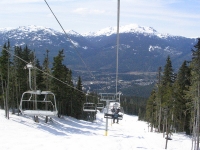
Photo credit: trec_lit
The village of Whistler lies cradled in a valley between two mountains, Whistler and Blackcomb, that rise up 5,280ft (1,609m) to provide more than 8,100 acres of prime mountain terrain, including 12 alpine bowls and three glaciers.
There are more than 200 marked ski trails to enjoy while on holiday at Whistler Blackcomb. In fact, the state-of-the-art facilities at Whistler provided the cross-country, biathlon, Nordic combined and ski jumping venues for the 2010 Winter Olympics.
The resort offers cutting-edge lifts that can carry 60,000 skiers per hour to jump-off points throughout the area. With two million visitors coming on holiday to Whistler Blackcomb every year, such lift capacity becomes a necessity. Skiers and snowboarders flock here from the world over, not for the weather (which can often be wet and foggy), but for the exceptional variety of skiing.
The village of Whistler is set around a cluster of small lakes and is British Columbia's fastest-growing municipality. It boasts a quaint village atmosphere and offers shopping areas and après-ski restaurants bordered by squeaky-clean streets. In summertime, Whistler Blackcomb is a popular holiday destination when the focus shifts to outdoor activities such as mountain biking, hiking and fishing.
Snowfall is rare in the city of Vancouver, but is more than adequate for the ski slopes on the Coast Mountains to the north where Whistler is situated. As with all Canadian ski resorts, Whistler can get bitterly cold so go prepared for the occasional blizzard.
In general though, temperatures are moderate throughout the winter season, rarely dipping below 12°F (-10°C) in the valley and 5°F (-15°C) on the peaks during the coldest part of the year. The average daily alpine temperature during most of the winter months is 22°F (-5°C).
Shopping in Whistler Blackcomb
If the glare of the snow becomes a bit too much while on holiday in Whistler Blackcomb, take time out to explore the shopper's paradise which is the village of Whistler. In the quaint plazas of Whistler Village, Upper Village, and Village North nestle about 150 attractive shops, boutiques, and art galleries, open seven days a week. Warm interiors beckon with a wide variety of merchandise, from native artwork and jewellery to high fashion for label lovers.
Dining in Whistler Blackcomb
Comfortable and casual are the keywords for dining while on holiday in Whistler Blackcomb, with a choice of more than 80 top-class restaurants offering a variety of cuisines covering the flavours of the world. There are options from luxury fine dining to small bistros and cafés.
Activities in Whistler Blackcomb
Whistler rocks with some of the best nightlife in British Columbia. Visitors on holiday in Whistler Blackcomb can browse the options presented in the holiday resort's news magazine, The Pique, which provides updated bar and nightclub listings every Thursday.
Live music, pool tables, sports bars, and even comedy clubs can be found in Whistler, in the collection of nightclubs, cocktail bars, and pubs. Whistler's public transportation system runs until about 3.30am to accommodate the nightlife crowd.
Things to be aware of in Whistler Blackcomb
As with all Canadian ski resorts, Whistler Blackcomb can get very cold so go prepared for the occasional blizzard. The resort can be overrun with young partygoers around the holidays, and shops and accommodation can be expensive.
Skiing in Whistler Blackcomb
Both the Whistler and Blackcomb mountains offer a huge variety of skiing for all standards of skiers. Generally, Whistler has more scenic alpine bowls while Blackcomb has more tree runs. Beginners will particularly enjoy the Green Line, a very long, gentle run from the upper terminal of the 7th Heaven Express in Blackcomb.
Whistler and Blackcomb also offer a massive choice of on- and off-piste skiing for intermediate and advanced skiers and snowboarders. Experts will be challenged by the black-diamond chutes running off the back of the Horstman glacier below the Mile High summit. Due to the crisp temperature, powder skiing in Whistler is often touted as the best in the world. Whistler and Blackcomb are very family friendly with child-minding services and all-day ski lessons for children.
Flaine
Overview
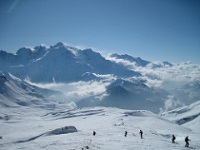
Photo credit: Kai Hendry
Consisting of concrete apartment blocks built on three levels along the slopes, at an altitude of 5,250 feet (1,600m), in the centre of a natural bowl, this, the youngest resort in the French Alps, may not sound particularly appealing. Flaine may not conform to the archetypal image of the Alpine village, but it has been architecturally designed for comfort and convenience, and visitors are amazed at how the buildings blend in with the limestone of their surroundings. The three levels, Flaine-Foret, Flaine-Forum and Flaine-Front de Neige, are connected by elevators and pedestrian trails. The centre is car-free, with restaurants, bars and services grouped around two central shopping plazas. All activities are either close and easily accessible, or in the resort centre. There is also a cultural centre where classical and jazz music events are scheduled, a library and an art gallery. Though not exactly a fashionable destination, Flaine is increasing in popularity, particularly as a family ski resort, and caters very well for children.
Shopping in Flaine
Cleary holidaymakers do not come to Flaine to shop, but to ski, as none of the resorts sport designer boutiques or glitzy malls. Shopping arcades contain the necessities for visitors; those who find they need sunglasses or gloves, will easily find some, but those set on fashionable shopping sprees will be disappointed. There is a supermarket and bakery for self-caterers, and services such as a post office and hair-stylist. Serious shoppers will have to save their credit cards for a spree in Geneva on the way home.
Dining in Flaine
Most holiday visitors to Flaine come on package deals, which include dining in the hotel, but for those who want a change of scene, Flaine has about two-dozen establishments offering a variety of typical French cuisine, traditional fondues, or pizza and snacks.
Activities in Flaine
Being primarily a family holiday resort, Flaine is not a hectic party spot. Après ski can be enjoyed at The White Pub (formerly The White Grouse), which has a good atmosphere, and at some low-key disco and karaoke establishments.
Things to be aware of in Flaine
While the skiing is great for novices and intermediates, experts might find the slopes lack challenges. Although the scenery is magnificent, Flaine lacks the charm and atmosphere of a traditional Alpine resort.
Skiing in Flaine
The majority of Flaine's marked ski runs are suited to intermediate skiers, but there are also some challenging adventure trails for experts. The breathtaking view from the cable car station atop Les Grandes Platieres gives a perspective on the variety of terrain, lifts and trails spread out in three directions. Flaine is connected by a system of lifts to the more traditional resorts of Les Carroz, Morillon and Samoens, offering altogether a huge ski-circus of 78 lifts and more than 160 miles (257km) of trails. There are 16 black, 54 red, 47 blue, and 15 green pistes, along with a 'hot' snowpark for snowboarders (the Jam Park), and about 40 miles (64km) of cross-country. There are several excellent ski and snowboarding schools available for beginners, and excellent nursery slopes close to the resort. The altitude virtually guarantees good snow coverage from December to May.
Bavaro
Overview
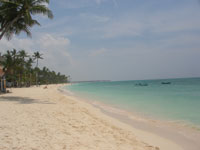
Photo credit: elainedewindt
Shopping in Bavaro
There are three main shopping centres where shopaholics on holiday in Bavaro can spend, among other things, their time. Bavaro Shopping Centre is the main place to look for clothing, while the Plaza Bavaro offers almost everything from boutiques, gift shops, souvenir shops, jewellery stores, pharmacies and beach clothing stores. Palma Real Shopping Centre is a great place to buy cigars, and outside many of the hotels are flea markets where Bavaro locals can be found peddling their wares.
Dining in Bavaro
Most of the hotels and holiday resorts in Bavaro offer an array of eateries; some even have up to six or seven à la carte restaurants. A few restaurants can be found on Plaza Bavaro serving some wonderfully exotic Dominican fare. Bavaro Cortecito has plenty of other options for those looking to escape their hotels for the evening, Captain Cook's being the most frequented. When the moon is full, head on over to the Jellyfish Restaurant on Bavaro Beach where live entertainment can be found.
Activities in Bavaro
Like most things in Bavaro, the nightlife is mostly concentrated in the hotels and holiday resorts, although the nearby town of Cortecito sees some of the most dedicated party-goers in its clubs. Disco Mangu is one of the most popular clubs and a favourite for people to let loose and dance the night away while on holiday. Plaza Bavaro also offers some wonderful bars ideal for relaxing and enjoying a pint.
Things to be aware of in Bavaro
The hotel nightlife leaves a lot to be desired and party-animals are warned that Bavoro may be a little boring. It is geared more towards couples and older travellers.
Puerto Costa Maya
Overview
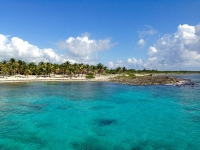
Photo credit: jeff covey
Shopping in Puerto Costa Maya
Passengers alighting from cruise ships in Puerto Costa Maya are carried by shuttle to the Mayan-inspired port complex, which boasts 70,000 square feet (6,503sq m) of shops and a bazaar. On offer are a wide variety of typical Mexican holiday souvenirs, especially local crafts, as well as designer perfumes, leather goods, and jewellery. The bazaar stallholders expect bartering to take place.
Dining in Puerto Costa Maya
The Puerto Costa Maya port complex contains some fast food outlets and eateries, but visitors docking here who want to enjoy a leisurely local meal can take a stroll into the fishing village of Majahual, where there are several small, rustic restaurants along the beach serving up Mexican favourites, as well as delicious lobster and fresh fish. For something a little upmarlet, try Leaky Palapa Restaurant. The Krazy Lobster offers cheap and delicious seafood right on the beach.
Activities in Puerto Costa Maya
As it is mainly a cruise destination, visitors to Puerto Costa Maya tend to be day-trippers who do not spend evenings at the port. Those who find themselves overnighting will no doubt be staying in a beach cabana in Majahual, where the only entertainment is to sip margaritas in an unsophisticated open-air beach bar under the stars. This lack of a nightlife scene is considered an advantage by some holidaymakers.
Things to be aware of in Puerto Costa Maya
Puerto Costa Maya can sometimes experience hurricanes and tropical storms. Hurricane season runs from June to November and visitors to the region during this time should take care to check weather and storm forecasts.
Copper Mountain
Overview
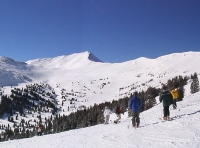
Photo credit: DebateLord
Shopping in Copper Mountain
There are shops located throughout the villages of the Copper Mountain holiday resort, selling a variety of ski and snowboarding gear, clothing, jewellery and souvenirs. A number of outdoor equipment stores sell everything necessary for hitting the slopes, and a number of clothing brands are represented. Those looking for souvenirs will also find plenty of handicrafts and trinkets on sale.
Dining in Copper Mountain
While on holiday in the Copper Mountain resort, there is something for every taste. There are some fine dining options for special occasions but budget travellers will also find an array of hearty eateries selling reasonably priced food.
Activities in Copper Mountain
Although not the best holiday resort for nightlife in the Rocky Mountains, Copper Mountain has a few bars and clubs that will be sure to meet apres-ski needs.
Things to be aware of in Copper Mountain
Copper Mountain can get very busy over the Christmas and New Year holiday period and over Spring Break.
Skiing in Copper Mountain
The Copper Mountain holiday resort has a lot to offer skiers and riders of all levels. Towards Union Creek are the beginners' slopes where the ski schools heads out to teach newcomers, or those simply in need of a refresher course, on the gentler green runs. The Village at Copper is more suited to intermediate skiers and riders, while nearby the East Village hides some of the black and double black runs for advanced skiers and riders. There are four bowls: Copper, Union, Spaulding and Resolution, for the confident and experienced.
Roses
Overview
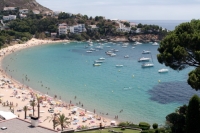
Photo credit: In Praise of Sardines
Shopping in Roses
Most of the shops in Roses are concentrated near the beachfront area. There are a few good markets around the town centre selling locally made holiday souvenirs such as jewellery, leather goods, and fabric. The best market is held in Roses every Sunday. Although not considered a shopper's paradise, Roses certainly provides everything holidaymakers may need on a resort holiday.
Dining in Roses
For many years Roses was famous for the celebrated El Bulli restaurant, generally considered one of the best restaurants in the world, but it has sadly closed. There are, however, still a number of good restaurants in Roses, which has a reputation as one of the better resorts as far as eating out is concerned. There are several traditional eateries serving excellent local Catalan cuisine; try the suquet de peix, a stew made from fresh fish and shellfish. The area around Xines Mulan has a range of cuisine from Mexican to Chinese food, and some steak houses.
Activities in Roses
Roses' nightlife is bustling, with every option from live flamenco music to thumping house clubs. New Orleans, in Avenida Clot dels Franquets Nord, is home to the most clubs, and popular venues include Octopussy, Picasso, and Chic. Roses hosts regular fiestas and festivals, on almost a monthly basis. The resort can be noisy at night due to all the revelry, but those wanting a quieter holiday can get accommodation a little further out from the central party hub.
Things to be aware of in Roses
Some neighbouring beaches are nudist beaches and families travelling with children should take this into account before booking a holiday.
Ocean City
Overview
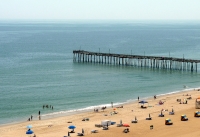
Photo credit: OC Always
With more than 10 miles (16km) of white sandy beaches and pounding surf, Ocean City presents itself as an attractive holiday resort, dominated by the famous old boardwalk that is lined with shops, bars and restaurants, flashing neon signs and holiday condos. Among the ice-cream stands and all-night fast-food franchises are hotels dating back to the 1920s. The fishing pier at the end of the Ocean City boardwalk has an amusement park with a huge Ferris wheel. There are plenty of activities including boating and deep-sea fishing, mini-golf courses, tram rides as well as the beaches.
To escape the holiday crowds in Ocean City, the Assateague Island National Seashore is a 37-mile (60km) stretch of wild and undeveloped beach and marshland that extends into Virginia. Little brown and white ponies are the only inhabitants that roam the dunes and graze in the grassy marshes. The main roads and paths can be crowded in summer with people coming to see the legendary wild ponies, but a short way off the main routes will bring the peace one may be looking for, but clouds of mosquitoes tend to plague even the most intrepid explorers.
Shopping in Ocean City
For avid holiday shoppers, Ocean City's 20-block Boardwalk and the town's Gold Coast Mall are the stuff of dreams, bursting with speciality and boutique shops, as well as a number of brand name factory outlets. Souvenir shopping is particularly enjoyable with a host of fascinating things to seek out and take home. Golfers are well advised to check out the local golf shops where bargains are to be had.
Dining in Ocean City
Ocean City prides itself in tempting the taste buds of all ages and persuasions in keeping with its affordable family holiday image, but the gourmet's choice in this resort is irresistible fresh seafood including clams, mussels, oysters, crab and lobster. The city has more than 22,000 restaurant seats, most of them al fresco with views of the Bay, and that is without the take-away and delivery joints, many of the restaurants touting 'all you can eat' banquets, and dinner cruises.
Besides delicious seafood visitors can take their pick of a gamut of international flavours like Chinese, French, Italian and Mexican. Recommendations include Smoker's BBQ Pit for ribs and chicken, On the Bay Seafood for Maryland crabs, and the the award-winning Fager's Island Restaurant with its spacious outdoor decks.
Activities in Ocean City
After the sun sets, Ocean City's Boardwalk and the Ocean Highway lights up as party-seekers explore the hundreds of clubs, pubs and bars offering a wide variety of attractions from hot deejays to live entertainment and dancing.
Things to be aware of in Ocean City
Ocean city is urbanised, a little noisy and can get extremely crowded during the summer months. Not the best holiday resort for those looking for some peace and quiet.
Sunday River
Overview
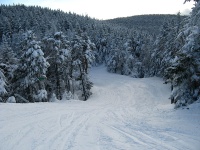
Photo credit: Ams100272
Shopping in Sunday River
The shopping in the nearby town of Bethel just seven miles away (11 km) away is enough to meet most shopaholics' requirements. The main street is the place to go where almost 30 shops, boutiques and specialist stores line the sidewalks. Visitors can head to Sunday River Alpacas for scarves, gloves and beanies made from warm and cosy Alpaca wool, while Mt. Mann Jewelers is the place to buy jewellery made from gemstones mined locally in Maine.
Dining in Sunday River
The dining out scene in Sunday River offers plenty of variety and between the slopes and the nearby town of Bethel, holidaymakers will find everything from pizzerias and burger joints to fine dining and sushi. The on-mountain restaurants are serviced by the resort trolley system, while the access road and Bethel eateries are serviced by the Mountain Explorer shuttle, making dining out for holiday makers a joy. Visitors can head to Camp for comfort food and Maine specialities done with a sophisticated twist, while Sliders offers sweeping views of the Jordan Bowl and is one of the most popular dinner eateries in the resort.
Activities in Sunday River
Sunday River's apres ski is a classic bar scene with many of the lodge bars being the local hangouts. The Foggy Goggle is the place to go for live music, good beer and delicious food after a long day on the slopes; the Barker Pub in Barker Mountain Lodge is a great local's spot where skiers can enjoy a drink on the deck overlooking the Barker and Locke Mountains; and the Shipyard Brew Haus at White Cap Lodge features entertainment throughout the entire season.
Things to be aware of in Sunday River
Many skiers may feel that Sunday River does not live up to the standard of nearby Sugarloaf, and the abundance of families and children might not appeal to those looking for a more singles-friendly resort.
Skiing in Sunday River
Sunday River features 135 trails spanning across eight interconnected mountain peaks, which are serviced by 18 lifts. The terrain is suited mostly to intermediates and beginners, particularly Barker Mountain, Aurora, Spruce and North Peak. Advanced and expert skiers head for Oz or White Cap located at the eastern end of the resort, which features some of the resort's most challenging runs like White Heat, or Obsession. Jordon Bowl, which boasts Sunday River's most stunning scenery, is suitable for all skill levels and features some of the resort's best runs.
Breckenridge
Overview
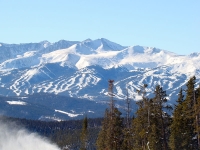
Photo credit: Ahodges7
Shopping in Breckenridge
Avid shoppers are extremely well catered for in the historic town of Breckenridge and holiday makers with a view to spend won't be disappointed. Although downtown Breckenridge is fairly small, with the main street less than a mile long, there are more than 250 shops and boutiques offering a vast array of goods, from log furniture to wigs! A good percentage of the stores offer sports goods and outdoor clothing, so visitors have a wide choice from which to equip themselves for the slopes. Speciality, jewellery and gift shops also abound, along with a crop of galleries, pure pleasure for browsing if visitors want to take home a genuine Stetson, Navajo rug or one of hundreds of trinkets, novelties, paintings or pots.
Dining in Breckenridge
Holiday visitors will find that eating out is essential in Breckenridge because there are just so many good options to choose from. Those craving Alpine fare will enjoy the fondue and rosti potatoes at the Swiss Haven, while any sweet tooth will be well satisfied with the delicious desserts for which The Hearthstone is renowned. There are several fine dining establishments, but cheap meals are also available.
Activities in Breckenridge
Apres-ski in Breckenridge is a feast of fun, with the evening usually kicking off in one of the many lively bars and restaurants, which offer happy hour specials. Nightlife establishments come and go but there is always somewhere to dance the night away at Breckenridge. For a change of pace visitors can enjoy a production at the Backstage Theatre, which offers a programme of live shows through the season.
Things to be aware of in Breckenridge
Because of the high elevation of the resort and its mountains, ranging from 9,603ft to 12,999ft (2,927m to 3,962m), some people may suffer from the effects of altitude sickness and require a few days of inactivity to acclimatise. The north and east facing slopes are prone to high wind-chill factors.
Skiing in Breckenridge
The high altitude of the slopes means abundant, long lasting snow. While Breckenridge is largely a paradise for intermediate skiers and snowboarders, there is terrain suited to all levels from beginners to expert skiers. Peak 8 and the area between Peaks 9 and 10 is excellent for beginners, with a variety of long, flat trails, and Peak 7 has gentle, but more difficult runs to progress to. Intermediates can enjoy moguls, wide-open bowls and miles of groomed trails, while the steep canyon between Peaks 8 and 9 is one of the expert slopes for advanced skiers, along with Lake Chutes, tree skiing on Peak 9 and Horseshoe or Imperial Bowl. The longest trail in the area is Four O'Clock, a four-mile (6km) run.
Roquetas de Mar
Overview
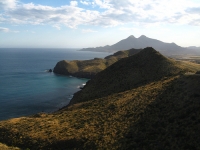
Photo credit: Hector Garcia
Shopping in Roquetas de Mar
Shopping in Roquetas is aimed at tourists, with the usual souvenir options like postcards, t-shirts, and beachwear. There are a few markets worth visiting, particularly the Thursday open-air market.
Dining in Roquetas de Mar
Costa de Almeria is known for its fresh produce and seafood, and the port of Roquetas de Mar receives its fresh catch every morning. Visitors will find many great seafood restaurants and tapas bars on the promenade. There are a variety of international restaurants to suit tourists' tastes, but a great way to sample local cuisine is at one of the many tapas restaurants. British and American staples are easily found and the selection of restaurants should be more than sufficient for all tastes.
Activities in Roquetas de Mar
There isn't much of a nightclub culture in Roquetas de Mar, but the hotels offer a variety of entertainment for a low-key night out, including live music and shows. The Teatro Auditorio hosts classical music and dance performances. A few hotels have their own discotheques, including the dancing rooms at the Sabinal and Zoraida hotels. The Bull Ring also offers live entertainment. M25 is a popular British themed sports pub for tourists.
Things to be aware of in Roquetas de Mar
Jellyfish tend to visit the shores of Roquetas de Mar which can make swimming and water activities difficult; the town has tried to put buoys and netting up to stop the jellyfish but tourists should still take precautions. Entertainment and nightlife is very low key.
Kos Town
Overview
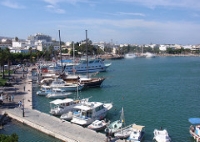
Photo credit: Kees Wielemaker
Shopping in Kos Town
Kos Town is the major shopping destination on the island. Visitors will find a number of souvenir shops, as well as markets selling spices, olive oil, and seashells. Popular souvenirs include jewellery and leather goods.
Dining in Kos Town
Kos has many restaurants clustered along the waterfront and around the main square, ranging from traditional Greek to Italian and Chinese.
Activities in Kos Town
There are bars, pubs and tavernas scattered all over Kos Town, but the aptly named 'bar street' is the place to go at night. The party lasts until dawn in the warmer months and offers an eclectic mix of music, from local bouzouki orchestras to thumping electronic beats.
Things to be aware of in Kos Town
The nearest sand beaches are several miles from town, and the nightlife can be overwhelming for tourists looking for a quieter holiday.
Borovets
Overview
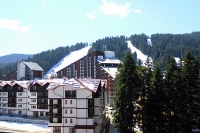
Photo credit: Biser Todorov
Shopping in Borovets
The busy shopping street in front of the Rila Hotel is a beehive of open-fronted small shops, with a colourful market atmosphere, selling all sorts of goods from ski gear to souvenirs. The prices here much lower than elsewhere in Europe.
Dining in Borovets
Most people go to Borovets on a package holiday, staying in a self-catering apartment or at one of the big hotels that have their own bars and restaurants. Those looking for a change of scenery will find that there are plenty of excellent restaurants in town serving international cuisine and traditional Bulgarian dishes, along with delicious local wines. There are also British-style pubs, burger bars and pizza restaurants. The mountain restaurants offer traditional warming stew and fast food alike.
Activities in Borovets
Every night is party time when it comes to Borovets' nightlife, as it has a reputation for being one of the hotspots on the European ski circuit and a popular destination with lively holidaymakers. The fun is fuelled by the fact that drinks are cheap, there are long happy hours, and sometimes drinks are even offered for free. All the bars, clubs and discos serve well-known international brands as well as local beers like Astika, Zagorka and Kamenitza. Beware the national drink, rakia: it is a rather strong variety of plum brandy and not for the faint of heart.
Things to be aware of in Borovets
Borovets is perfect for those seeking a fun skiing holiday on a tight budget, but don't expect Three-Valleys sophistication. There are few challenging slopes for advaced skiers, and there is limited off-piste skiing. Borovets can appear almost abandoned in the summer, though there is good hiking.
Skiing in Borovets
The ski slopes are divided into two main sectors, with the Markoudjik sector offering the best skiing above the tree line, including the highest ski point reaching 8,333ft (2,540m). Borovets has a total of 22 miles (35km) of ski pistes, and has recently installed new lift facilities with lighting and sound systems, which allows for night skiing and snowboarding. The resort also boasts modern snowmaking machines ensuring that conditions stay excellent. Snowboarders enjoy the Rotata half-pipe with a vertical drop of 1,050ft (320m), suitable for advanced riders at its upper end and beginners at the lower end. The Borovets ski schools have an excellent reputation, with professional English-speaking instructors.
Squaw Valley
Overview
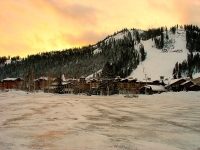
Photo credit: Rennett Stowe
Shopping in Squaw Valley
Skiing and snowboarding needs will be taken care of in shops that include Squaw Valley Outfitters and The North Face. There are other smaller grocery stores offering enough for all self-catering needs and several other novelty stores include Black Diamond Wine Exchange, and Double Diamond Jewelry, selling liquor, candles and shiny stones. Granite Chief ski shop can handle all tuning and waxing needs. Megalithic shopping mall, The Village At Squaw Valley, will cover all remaining shopping needs.
Dining in Squaw Valley
There are any number of restaurants to suit just about all visitors' tastes and budgets at Squaw Valley. Graham's at Squaw Valley remains an outstanding fine dining option while the Fireside Pizza Company serves some of the best pizza in Tahoe. Focusing on Northern Californian cuisine, Six Peaks Grille inside the Resort at Squaw Creek offers picturesque views, attentive service and a cosy atmosphere. Sandy's Pub serves up hearty comfort food and is the perfect spot for watching sport. Le Chamois and Loft Bar is the place to go for lunch after a morning on the slopes or for an apres-ski beer at their legendary bar.
Activities in Squaw Valley
Not known for its apres-ski scene, Squaw Valley has a few worthwhile nightspots of the down-to-earth variety. For an authentic local scene, travellers should check out The Loft Bar. Long-time favourite The Auld Dubliner is a great place to savour a few pints after a hard day on the slopes and was originally a pub built in Ireland until it was dismantled and brought all the way to the US.
Things to be aware of in Squaw Valley
Squaw Valley can get quite busy over the Christmas and Spring Break periods.
Skiing in Squaw Valley
At 9050 feet (2760m) above sea level and spread across six peaks and 4000 acres of terrain, there are enough runs for every level of skier and snowboarder at the resort. In total there are 112 different runs totalling 485 miles (782km). Unusually Squaw Valley does not mark trails on its piste map relying instead on a graded lift markings. The resort attracts plenty of expert skiers, who are drawn to cliffs and chutes that rival some of the best found across the continent. Squaw Valley also offers the best nightskiing in Tahoe.
Taba Heights
Overview
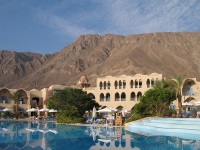
Photo credit: Marc Ryckaert
Taba Heights offers a relaxed yet luxurious retreat thanks to its simple yet characteristic Bedouin camps boasting remarkable views of the sea and surrounding mountains, as well as clear views of Saudi Arabia and Jordan. Taba Heights is truly the perfect destination for a lazy beachside holiday.
Shopping in Taba Heights
Though there are a few shops worth visiting for gifts, and it is easy to find snorkelling and beach equipment, Taba Heights doesn't offer much of an overall shopping experience for holidaymakers.
Dining in Taba Heights
Taba offers a fairly wide variety of cuisine for visitors to enjoy, ranging from Tuscan to all sorts of Asian, with many a seafood restaurant gracing the area's selection of hotels. There are also pubs and grills.
Activities in Taba Heights
Taba Heights does not offer diverse nightlife venues but it does have a 24-hour casino as well as nightly entertainment programmes featuring local talent.
Things to be aware of in Taba Heights
The beach is quite stony and it is recommended that visitors take beach shoes and dive shoes for the coral reefs in the sea. Some of the hotel shops sell them, but they tend to be overpriced.
Cadiz
Overview
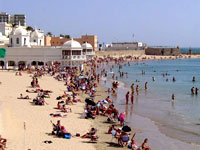
Photo credit:
Shopping in Cadiz
Cadiz is an ancient city and a popular holiday destination with all the shopping opportunities one would expect. Some great shops can be found on Calle Pelota, Calle Compania, Calle San Francisco and the Plaza de Candelaria. A great place for quality Andalucian items such as ceramics and leatherwork is Belle Epoque, close to the Museo de Cadiz. For incredible local foods, travellers should go to Hecho in Cadiz. There are excellent food markets at Mercado Central de Abasto (the Central Market), La Merced and San Jose where high-quality wine, sausages, and cheeses can be bought.
Dining in Cadiz
The city boasts numerous great restaurants and a wide variety of cuisines, catering to all budgets and palettes. They say that Cadiz is home to the best fried fish in the world, and the best in town can reputedly be found at Las Flores Freideria on Plaza Topete.
Activities in Cadiz
Cadiz has a lively nightlife scene, with something for everyone, from laid-back beach bars serving tapas and ambient music to all-night clubs. The foundation for most evenings out is laid by tapas and sundowners, and the practice of botellón, which involves buying your own alcohol and drinking while strolling the plazas or the beach. The main nightclubs are on Playa Victoria beachfront, and tend to open around 10pm. The most popular club in town, from 4am when it opens, is El Hoyo on Calle Manuel Rancés.
Things to be aware of in Cadiz
Cadiz is a well-developed city and a hugely popular tourist destination and is therefore not suitable for those wanting a quiet holiday or looking to experience a traditional Spanish village.
Maspalomas
Overview
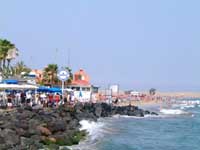
Photo credit: canaryforum
Shopping in Maspalomas
The main shopping centre in Maspalomas is the Faro 2 complex, full of designer stores and boutiques. Varadero Shopping Centre is another popular place to shop in Maspalomas. The surrounding area is crammed with shopping complexes of similar ilk, about a dozen in all, the biggest and best known being the Yumbo Centre in neighbouring Playa del Ingles.
Dining in Maspalomas
Maspalomas cuisine is best experienced at Pizzerria Piz Paz, Escalerita, El Palmeral or Velero Casa Antonio. Maspalomas has restaurants aplenty, most very reasonably priced, offering a variety of international cuisines. Many of the restaurants provide live entertainment in the evenings and double as bars. Visitors can enjoy live music or DJs while trying out a range of different foods from pizza and pasta to Chinese, seafood and Tex-Mex.
Activities in Maspalomas
On holiday in Maspalomas, it is a good idea to make sure you join the locals in a traditional afternoon siesta in order to take advantage of the nightlife, which is lively but sophisticated. The holiday resort offers a plethora of entertaining bars with karaoke, jazz, salsa, and live bands to spice things up, or themed pubs with happy hours. A good selection of bars can be found in the Maspalomas Plaza. There are a variety of clubs and discos, two popular dance spots being found in the Holiday World amusement park. Most Maspalomas nightclubs only get going after midnight, and offer free entry, although drinks can be expensive. Those out for a real time on the town, however, will prefer to head for neighbouring Playa del Ingles where the hottest spots are, including the well-known Joy and Cream clubs.
Things to be aware of in Maspalomas
The Maspalomas Dunes are a haven for naturists, so be prepared to see plenty of naked bodies on the sand. The beach, particularly the sunbed area, becomes extremely crowded during the height of the summer holiday season.
Blanes
Overview
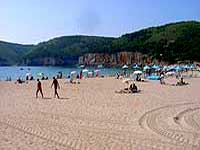
Photo credit: Spanish Tourist Board
Shopping in Blanes
There are more than 700 shops in Blanes, from boutiques and supermarkets to small, traditional retailers. The Monday morning market at Passeig de Mar is the best place to buy souvenirs and various cheap clothing. Every afternoon, local fishermen sell off the day's catch here. The daily Municipal Market in Mas Enlaire is also worth a look for groceries and fresh produce. Blanes offers a variety of shopping opportunities and provides everything visitors may need.
Dining in Blanes
There are more than 150 restaurants in Blanes, many located along the promenade. Locals tend to frequent the smaller eateries behind the promenade for authentic Spanish fare. Travellers should try the tapas at Cafe Terrassan near the corner of Passeig de Dintre, widely considered the best in town. In general, fresh seafood is the best bet to order, as are local Catalan dishes. There is also plenty of international food on offer though.
Activities in Blanes
Although Blanes is not known for its nightlife, there are several British-themed pubs and some decent bars that stay open till late, especially in the summer months. For quality nightlife visitors should head up the coast to Lloret. That being said, at the end of July each year Blanes hosts the Costa Brava International Fireworks Contest, when the seaside town comes alive with fiestas lasting late into the night.
Things to be aware of in Blanes
On peak summer days the beach and promenade gets very crowded.
Golden Sands
Overview
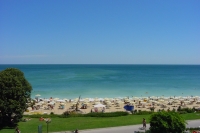
Photo credit: Chlempi
Shopping in Golden Sands
Visitors can enjoy browsing in the numerous shopping arcades and outdoor bazaars while on holiday in Golden Sands. While Golden Sands' shopping opportunities are fairly commercial, most of the hotels have large gift shops and some authentic Bulgarian crafts can usually be found among the usual tourist beach resort merchandise.
Dining in Golden Sands
Golden Sands has a range of restaurants, cafés, snack bars and local tavernas that serve a wide variety of first-class international cuisine, as well as traditional Bulgarian dishes, mostly at reasonable prices. In addition to Bulgarian cuisine, Chinese restaurants, Irish pubs, and eateries selling international staples like pizza and barbecue can be found. Bulgarian wine and brandies appear on most menus.
Activities in Golden Sands
Golden Sands' nightlife features a wide range of beach bars, discos and nightclubs where holiday visitors can keep the action going until the early hours. A casino will satisfy the gambling spirit and there is always a variety of shows and entertainment to be had, ranging from live music and deejays to floor shows, cabaret, and a go-go bar.
Things to be aware of in Golden Sands
Golden Sands is a large tourist complex and one of the biggest on the northern Black Sea Coast. For this reason it is a little characterless and visitors can miss out on what Bulgarian life along the Black Sea is really about amid the commercial attractions.
Vail
Overview
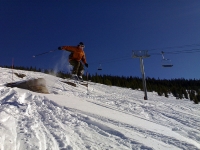
Photo credit: Mark DeVries
The Austrian-styled village of Vail is a neat concentration of trendy shops, restaurants and nightlife, all within easy reach of the hotels, inns and lodges, and never more than a five-minute walk from the slopes. There is a lift system that provides access to a backcountry experience with trees and peaceful ungroomed terrain. The ski season lasts from November to early May, but the resort remains open for summer holiday activities such as hiking, mountain biking and fishing.
Shopping in Vail
With more than 200 shops to choose from, there is plenty to keep shoppers off the slopes on a Vail holiday. Shops range from speciality boutiques and art galleries to sporting equipment and jewellery, and from souvenirs to fine clothing stores. Self-caterers will easily find everything they need.
Dining in Vail
More than 120 Vail restaurants offer everything from award-winning cuisine to local family favourites, from French, Italian, Asian and American fare to fast food, bakeries and delis. One of the top restaurants in the Vail Valley is Sweet Basil.
Activities in Vail
The nightlife and apres-ski on a Vail holiday is energetic and vibrant. There are sports bars with big screen televisions and billiards, and a few quality live music venues. Local hotspots include The Bully Ranch, and a spot on the deck of The Red Lion.
Things to be aware of in Vail
Vail is more expensive than many other holiday resorts, but has a lot to offer visitors for the price. The enormity of the area means that getting between chosen runs takes time and often runs on different parts of the mountain are linked by flat trails, which makes it frustrating for snowboarders.
Skiing in Vail
Vail Mountain is a giant that offers three different mountain skiing experiences for different levels of ability, and over 120 named trails. An enormous front face of long, smooth slopes is perfect for cruising, with runs for every level. For intermediates there is a wide variety of groomed runs, the longest of which is almost five miles (8km) long, from Flap Jack to Riva Ridge. The seven world-famous Back Bowls consist of miles of undefined open terrain and panoramic vistas, and are strictly for advanced and expert skiers, excellent on powder days. There are numerous beginners' areas as well as special family skiing areas around the mountains and a ski and snowboard school for learners or those wanting to advance to the next level. The resort reliably receives an average of about 27 feet (8m) of light powder snow each year.
El Arenal
Overview
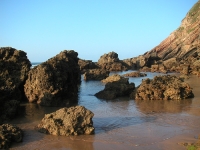
Photo credit: vistaspain
Hiring a car is an excellent way to explore the rest of the island and take in the sights while on holiday, but many choose simply to enjoy their hotels and the entertainment they provide. There are regular busses to Palma, with all its urban attractions.
Shopping in El Arenal
The resort has all the usual tourist trappings, and there are shops enough for visitors to buy anything they might need as well as souvenirs, but those who want quality shopping sprees should take the short journey to Palma (busses depart every 15 minutes or so), where the best shopping on Mallorca can be enjoyed. There are some touts on the beaches of Arenal selling 'genuine' watches and other branded items which are almost certainly fake.
Dining in El Arenal
El Arenal is dominated by German tourists and expats and has developed a genuinely German character, with many of the bars and restaurants demonstrating this. There are tapas bars, seafood restaurants, pizzerias and burger joints (including international chains such as Burger King), as well as Chinese restaurants. The variety of restaurants ensures that everybody should find what they are looking for, but those expecting numerous authentic Spanish eateries may be disappointed.
Activities in El Arenal
El Arenal's social highlight is probably Woody's Bar, but there are a host of lively resort bars and clubs that will keep you dancing until the early hours. There are also a number of British and German-style pubs and the balnearios, 16 small beach huts that run from El Arenal to C'an Pastilla, many of which have been turned into beach bars. El Arenal is a popular party resort, particularly in the summer months, when the festivities tend to continue till dawn.
Things to be aware of in El Arenal
Although the close proximity to Son Sant Joan International Airport is convenient it does mean that visitors sometimes hear aircraft noise. This in combination with the energetic nightlife make the resort ill-suited to those looking for peaceful holidays.
Can Picafort
Overview
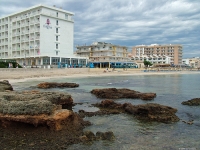
Photo credit: Rover75 !
Pedestrian-friendly, with a promenade perfect for evening strolls, the resort has become popular with those seeking a quiet beachside getaway, and hotels provide much of the resort's entertainment. There are several bars, restaurants and nightclubs, however, as well as plenty of shops and an excellent market on Fridays. C'an Picafort is right next to Son Baulo, which has its own beach, shops and restaurants and is a popular holiday destination in its own right.
Shopping in Can Picafort
C'an Picafort is not a shopper's paradise, but there is a good variety of little gift shops and visitors should be able to find everything they require on holiday. Most shops face onto the paved road lining the beach. The Caprabo shop on the Carreterra d'Arta-Port d'Alcudia road sells all things British for those missing the luxuries of home. Market days are Tuesday and Sunday, and while the market is small if visitors are prepared to bargain hard they can pick up some great souvenirs.
Dining in Can Picafort
There are numerous British-themed pubs and eateries, and an equal number of German and Scandinavian restaurants catering to the large number of visitors from those countries. For fine dining try Es Turo which is housed in a centuries-old building. The most popular style of eating for locals and visitors alike is tapas, provided at any café in town.
Activities in Can Picafort
Although not generally considered a party hub, C'an Picafort does boast some nightclubs as well as some fun bars, and the hotels tend to provide vigorous entertainment schedules for those keen to take part. The longest running nightclub at the resort is Skau which is open every night during the summer season. Another nightlife hotspot in C'an Picafort is the western-themed bar Charly's.
Things to be aware of in Can Picafort
There are few worthwhile attractions in town and for those wanting more than a beach-based holiday C'an Picafort can be a bit dull.
Meribel
Overview
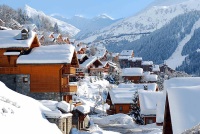
Photo credit: Jean Maurice Gouedard
Shopping in Meribel
Meribel is stuffed with lots of good-value ski shops and those with more expensive taste can ski over to Courchevel 1850. There are plenty of mini-supermarkets for self-caterers as well as a fine selection of bakeries and delicatessens.
Dining in Meribel
There are some seriously good restaurants for skiers to enjoy in Meribel, both on the mountain and in the resort. It's best to get local advice on arrival and to book early for the better restaurants. There's more choice for those happy with a simple fondue and nice carafe of local wine. Visitors should try Aux Petits Oignons for it's welcoming atmosphere and homely food, or Tsaretta Spice for some tasty Indian food.
Activities in Meribel
The nightlife in Meribel is not as wild as in some holiday ski resorts, but there's still plenty going on. Dick's Tea Bar is the best-known nightclub and the queues can be long. Meribel-Mottaret has few choices and closes up for the night earlier.
Things to be aware of in Meribel
Meribel is quite spread out and much of the accommodation is far from the slopes, meaning visitors need to queue for a bus. The main resort is quite low and it is often not possible to ski to the main village.
Skiing in Meribel
The Trois Vallées ski area is one of the best and most extensive in the world (10 times larger than Vail, the largest ski resort in the States), and Meribel is in the middle, between Courchevel and Val Thorens. Meribel has a vast choice for beginner and intermediate skiers, and those with more experience will want to test out the slopes in Courchevel and Val Thorens. Snowboarders will find lots of challenging slopes and couloirs and, when the snow is good, there is some excellent off-piste skiing.
Flic en Flac
Overview
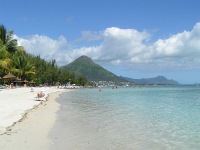
Photo credit: Diggnet
Shopping in Flic en Flac
Tourists will find plenty of little souvenir shops and stalls along the beach and there is a big supermarket for self-caterers. Many hotels have their own shops. There is also a pharmacy, an internet cafe, and a shopping centre.
Dining in Flic en Flac
There is a large selection of restaurants in and around Flic en Flac, with some impressive high-end hotel restaurants as well as plenty of local options for budget travellers.
Activities in Flic en Flac
Flic en Flac is one of Mauritius's most developed and popular resort areas and the nightlife is more exciting than most of the smaller, more secluded resorts. There are a number of popular bars and even a casino, many of the hotels have their own clubs, and Port Louis is just a 30-minute drive away. However, Flic en Flac is not yet as big a party resort as Grand Baie and those in search of a pumping holiday clubbing scene may still be disappointed.
Overview
Puerto Mogan
Overview
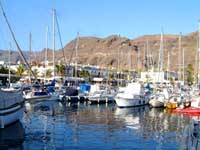
Photo credit: canaryforum
Shopping in Puerto Mogan
Puerto Mogan has all the shops that you would expect from a holiday resort in the Canary Islands, but they are generally a little more arty-crafty and sell less of the rubbish that you usually find in souvenir shops; there is less quantity and more quality in Puerto Mogan than at many other resorts. Every Friday morning there is a large market in town, which is aimed at locals as well as tourists and sells everything from fresh fish to football shirts.
Dining in Puerto Mogan
While there is no shortage of fast food stalls and restaurants offering full English breakfasts in Puerto Mogan there are also a few restaurants offering good Canarian cuisine, wines and cheeses. Puerto Mogan is best known for its excellent seafood restaurants serving locally caught fish. Some top choices include Restaurante El Castillo for paella or tapas, La Bodeguilla Juanana for great Canarian cuisine, and Casito Mediterraneo for some of the freshest fish in town. Most restaurants are located around the harbour.
Activities in Puerto Mogan
While there is a disco or two and many restaurants offer some sort of entertainment, most visitors come to Puerto Morgan on holiday for peace and relaxation. The nightlife is limited and sedate and those in search of a party will need to travel to a more energetic resort.
Things to be aware of in Puerto Mogan
Visitors should be aware that there is some building work going on in Puerto Mogan, but this is mostly towards the back of the resort; it is worth checking that there is no building site near your accommodation. Those looking for large nightclubs and dance music will need to make the short trip to Playa del Ingles.
Faliraki
Overview
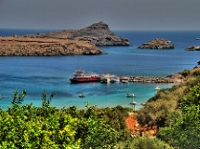
Photo credit: Francesco Sgroi
Shopping in Faliraki
Visitors can find everything a holidaymaker needs in Faliraki, from local crafts to toothpaste, and shops stay open till very late during warmer seasons. Serious shoppers can head to Rhodes Old Town and haggle for bargains in the narrow, cobbled streets. Good buys include leather bags and sandals, rugs, gold and silver jewellery, and ceramics.
Dining in Faliraki
Faliraki has a huge variety of restaurants, from traditional Greek tavernas to Chinese. Prices range from cheap to reasonable; fast-food bars abound, staying open until the wee hours.
Activities in Faliraki
Bar Street and Club Street in Faliraki live up to their names and reputations as a paradise for young clubbers and pubbers. The areas have many dance floors and watering holes, with renowned international DJs often gracing party goers with a set. For many guests at Faliraki resort, the vibrant nightlife is a significant drawcard.
Things to be aware of in Faliraki
Faliraki has received some bad publicity in recent years because of the rowdy, drunken behaviour of some young holidaymakers. Travellers who want a peaceful beach retreat should consider other resorts.
Grand Baie
Overview
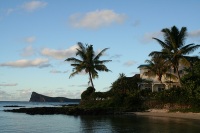
Photo credit: Selene Weijenberg
Shopping in Grand Baie
Outside of Port Louis, Grand Baie is the best shopping destination on the island and visitors will find plenty of shops and stores selling souvenirs and local arts and crafts. There are supermarkets for the self-caterers.
Dining in Grand Baie
Grand Baie is bursting with restaurants and bars and there are a variety of cuisines on offer to suit a variety of budgets.
Activities in Grand Baie
The nightlife is a big drawcard for Grand Baie, and definitely the best to be found in a Mauritian resort. The clubs and bars buzz until the early hours during peak season.
Sharm el-Sheikh
Overview
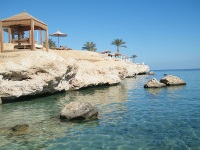
Photo credit: Mr Rosewater
Numerous dive sites are within reach of Sharm el-Sheikh, including the huge drop-offs at Ras Mohammed in the extreme southern part of the peninsula, the Straits of Tiran, various wrecks, and about 28 sites located along the coast that are accessed by boat. Naama Bay has a gently sloping sandy bottom, is ideal for dive classes, and provides diving and snorkelling opportunities for all levels without having to use a boat or car to get there.
Besides excellent diving and snorkelling, which are the main activities for holidaymakers in Sharm el-Sheikh, there are plenty of watersports available for visitors who feel like doing more than just soaking up the sun. Add a vibrant nightlife with casinos, discos and nightclubs and one can't complain of boredom!
Shopping in Sharm el-Sheikh
Avid shoppers will find a variety of goods in the old market and Sharm El-Sheikh's malls, where shops sell both foreign and local products, including jewellery, leather goods, clothing, pottery and books. Naama Bay offers a more upmarket shopping experience at the Naama Centre, where shopkeepers are less inclined to bargain but everything from souvenirs to scarves can be found.
Dining in Sharm el-Sheikh
There are a huge variety of dining options between Sharm el-Sheikh's two tourist districts of Old Sharm and Naama Bay, from hotel restaurants and international fast food chains such as KFC, to local eateries and fresh fish. Every cuisine from Mexican to Japanese is represented in Sharm el-Sheikh.
Activities in Sharm el-Sheikh
Sharm el-Sheikh's casinos, discos, pubs and bars cater to those ready to party the night away while on holiday. Entertainment ranges from dance clubs to informal hangouts.
Things to be aware of in Sharm el-Sheikh
Shopkeepers and hawkers can become a nuisance but a polite though firm 'no, thank you' should ward them off. Travel authorities currently urge extreme caution when travelleing in the Sinai region; excursions into the desert to places such as St Catherine's Monastery may not always be possible.
Big Sky
Overview
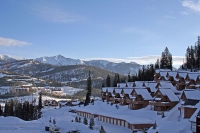
Photo credit: Jim
Shopping in Big Sky
Holiday visitors will find that there are enough shops offering ski and snowboard rentals and associated ski equipment purchases, notably Big Sky Sports, as well as gift and souvenir shops with some unique Montana-made oddities and grocery stores for the self caterers. Visitors should head to the Mountain Mall or Mountain Village for the largest selection of stores.
Dining in Big Sky
No one will go hungry while on holiday in Big Sky, as a number of restaurants are available. While there are a few Mexican and Asian options, most Big Sky eateries specialise in American fare such as steak, burgers, and pizza. Popular restaurants include Buck's T-4 Lodge and Restaurant, the Rainbow Ranch Lodge Restaurant, Olive B's Big Sky Bistro, and The Riverhouse.
Activities in Big Sky
The apres-ski atmosphere in Big Sky, though not the the wild party many other ski resorts offer, does have a few pubs and bars that stay open. However, the nightlife only really picks up from Thursday to Saturday. Scissorbills has some great happy hour specials, while the Carabiner Lounge is a quieter venue worth relaxing with a good drink.
Things to be aware of in Big Sky
Big Sky is a family-friendly resort and even though there is a variety of nightlife available, those looking for a more raucous ski holiday should perhaps look elsewhere.
Skiing in Big Sky
The resort offers mountains to suit all levels of skiers and snowboarders. With over 5,512 acres to enjoy, 4,350 vertical feet of fun, 220 trails, 400 inches of snow annually, Big Sky is home to the greatest slopes in Montana. Lone Mountain is perhaps the most famous and at over 11,000 feet has enough variety for all. Andesite Mountain suits the intermediates, while Flat Iron Mountain arguably has more diversity than Lone Mountain; the backcountry skiing is particularly good at Big Sky. The terrain park has all the usual suspects: boxes, rails, ramps, and slides for all enthusiasts as well as for those starting out.
Lake Louise
Overview
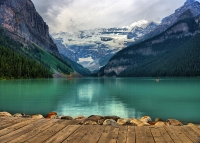
Photo credit: Edwin van Buuringen
With plentiful natural snow and an extensive snowmaking system, skiing is guaranteed at Lake Louise from mid-November to mid-May, and it has the reputation of offering some of the best powder skiing in the world.
The pretty village nestling in the Rockies provides every amenity required by visitors, and a wide choice of cosy accommodation and dining options. Shuttle buses and an efficient system of interconnecting lifts provide easy access to the slopes.
Putting all this together with the spectacular scenery and pristine terrain, you have the recipe for a snowy wonderland. It's not surprising that Lake Louise has been dubbed a diamond in the wilderness and remains such a popular resort destination.
Shopping in Lake Louise
Lake Louise's shopping precinct is the Samson Mall, located in the lower part of the village. It offers many shops for holidaymakers to browse, with competitive prices and no provincial sales tax on purchases.
Here, and in nearby Banff, shoppers will find an eclectic selection of goods, including brand name clothing, winter sports clothing and equipment, art and handcrafts, souvenirs, jewellery, and photographic goods.
Look out for unique Lake Louise paintings by local artists, beadwork by native peoples, and jewellery set with Alberta's ammolite gemstone. Another unusual souvenir many visitors take with them is a bottle of water from the lake itself, which is crystal-clear and clean enough to drink.
Dining in Lake Louise
The resort offers a number of restaurants and bars in the village itself, and several eateries with terraces and spectacular views on the nearby slopes, serving everything from ethnic cuisine to famously tender Alberta beef.
There are family restaurants, cosy cafés, and elegant eateries to choose from. Line dance lessons and sleigh rides are offered in some of the rip-roaring cowboy-style eateries, along with barbecued beef, baked beans, and homemade pies. Gourmet Canadian cooking and fine wines take centre stage at some upmarket restaurants.
Staples like pizza, pasta, and hamburgers can be found in a number of casual eateries. For scenic dining, ride the Lake Louise sightseeing Gondola to the Whitehorn Terrace where the deck affords a breathtaking view of the lake and surrounding peaks and glaciers.
Activities in Lake Louise
Après ski in Lake Louise does not mean wild partying. But there are plenty of more subdued yet enjoyable ways for holidaymakers to wind down after a day on the slopes. Many local bars and eateries offer entertainment like live music, a little dancing, karaoke, limbo competitions, pool tables and darts, shuffleboard, or big screen television. Guided night ski tours and sleigh rides are also on offer. However, most visitors are content to settle down in front of a roaring fire, nursing a cognac and rehashing the day's adventures.
Things to be aware of in Lake Louise
Skiing at Lake Louise can be quite expensive.
Skiing in Lake Louise
Lake Louise offers a perfect mix of beginner, intermediate, and advanced terrain for skiers and snowboarders. The unique layout makes both easy and challenging runs down from every chair possible, on a choice of 113 groomed runs, as well as limitless off-trail adventures and acres of open snow bowls.
The efficient lift system also means minimal queue times. Private and group lessons for all levels of skiers and snowboarders take place daily, but reservations are necessary for the busy Christmas and Easter season. Snow conditions are excellent, but snowmaking is possible on about 20 percent of the runs if needed.
Overview
Overview
Los Penitentes
Overview
Photo credit: Eugenia Federicci
The resort may be smaller than many of its Argentinean counterparts, but it features ski schools, a kindergarten, a shopping centre, a variety of restaurants, a snow garden where parents can leave their kids for the day, and a disco to heat things up on those cold winter nights. The ski season at Los Penitentes lasts from mid-June to August.
Shopping in Los Penitentes
There isn't the largest variety of shopping in Los Penitentes and travellers looking to splurge will do better in the nearby city of Mendoza. There are, however, a few small shops selling souvenirs, sporting goods and the like, and the local shopping centre is a good place to indulge in some retail therapy.
Dining in Los Penitentes
Los Penitentes offers plenty of eateries for foodies of all persuasions. Several restaurants offer great international cuisine and excellent value for money, while restaurants located on the mountain allow skiers take a much-needed break and enjoy a steaming cup of hot chocolate.
Activities in Los Penitentes
There is not much nightlife in Los Penitentes, but a few hotels offer occasional shows and disco nights, while a few pubs and bars are dotted around the resort. Young travellers looking for a night of partying and drinking best head to one of Argentina's other ski resorts.
Things to be aware of in Los Penitentes
Los Penitentes is fairly quiet. Travellers looking for wild nightlife should look to other ski resorts in Argentina for a more lively holiday.
Icmeler
Overview
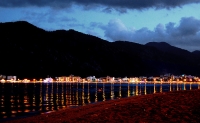
Photo credit: Yulia Savenkov
Icmeler's package holiday aura is tempered by its scenic setting, with steep hills clad in pine forests plunging into the turquoise waters all around the town. Unlike its close neighbour of Marmaris just a few miles south, Icmeler has a relaxed village atmosphere, while lacking none of the modern amenities.
The resort is scrupulously clean and well maintained, from its regularly raked shingly sand beaches to its litter-free promenade. The town is also resplendent with well-kept gardens, which soften the lines of the dozens of hotel and apartment blocks.
Shopping in Icmeler
Icmeler does have a central shopping mall, which is adequate for acquiring essentials and holidaymakers can have a pleasant browse for souvenirs. For more local flavour, there is a market on Wednesdays where bargain hunters and hagglers can test their skills. Serious shoppers, though, would be better advised to take a short dolmus ride into nearby Marmaris where it is possible to shop for hours, especially in the fascinating covered bazaar of the old town.
Dining in Icmeler
Icmeler is well-supplied with restaurants of all sorts, but most holidaymakers particularly enjoy local specialities such as guvec, a clay-pot casserole, or tasty kebabs, washed down with some Turkish wine or raki, the traditional aniseed spirit. A good choice for Turkish cuisine is the Turkish House in Turunc Road, where the food is served up to the tune of traditional music. For good steaks a favourite is the Love Boat at the Devamli Hotel. For variety the menu at the Majestic Restaurant is a mix of Chinese, Indian, and Italian.
Activities in Icmeler
Icmeler is not a clubbing holiday resort but there are plenty of pubs, which keep hopping with a lively atmosphere until the wee hours. The nightlife may be low key, but those who want something more frenetic have only to grab a dolmus and ride a short distance to Marmaris, where the pace is hotter; some of the bars have discos, karaoke, and live shows. Like many resorts, the more popular bars are clustered by the beachfront.
Things to be aware of in Icmeler
The beach in Icemeler is shingle and travellers should be aware of this before booking their holiday.
Overview
Overview
Krabi
Overview
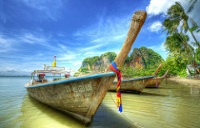
Photo credit: Mike Behnken
Shopping in Krabi
Krabi town has a good selection of shopping for those who want to sample the wares in the region. Along with the 'same same' merchandise sold in street stalls across Thailand, the typical t-shirts bearing the logos of Heineken, Guinness and the likes, one can also find more unique items in Krabi, including handmade pottery and locally produced home ware. Apart from the street stalls, Krabi has a modernised shopping mall in the centre of town selling high-end fashion labels in the top levels of the building and knock-off brands on the ground level and in the basement. This mall has an interesting coming together of top-end fashion and cheap replicas both in the same store, though shoppers should be wary if the bargain seems too good to be true, as that usually will be the case.
Dining in Krabi
Krabi has many dining options, both for those who want to experience the local cuisine and for those who prefer a 'Western' food menu. From Italian pizza to Greek seafood, Krabi has a variety for the hungry visitor. For where there is a beach in Thailand, there is inevitably food. In Krabi, travellers can literally eat with their toes in the sand, as many restaurant are right on the beach, and what better way to round off a day of activities than sitting down to some fresh seafood and a cold beverage while watching the sun go down over the Andaman sea? But if visitors truly want to eat like locals, Krabi town has a nightly food market that springs to life around 5pm every evening. This is where visitors will find the cheapest and often the most delicious food in Krabi, and where they can sit side by side with Thais, as they and their families huddle around the food carts for dinner and a beer.
Activities in Krabi
Night time is when Krabi comes alive. Many markets around Krabi set up only at night, when the heat of the day has subsided and locals begin to wander around the streets after hiding from the sun all day. Night markets, especially weekend markets, are a vibrant and colourful meeting place for both visitors and locals. The beautiful sights and smells of the food vendors delight the senses, as strange and wonderful items are dished up for willing buyers. After dark is also the time the beachside bars turn on their fluorescent lights and turn up their music. With so many bars lining the beaches, it is often hard to decide where to go, as visitors begin to slowly drift towards their respective spots to catch the sunset, accompanied by a randomly chosen, multi-coloured cocktail. As the night moves on, a younger crowd often filters into the scene, drawn in by the music, which becomes progressively faster, and the potential of an all night party, signified by the gradual gathering of bodies in the said venue. While Krabi town is not specifically known for big parties, the close by Ao Nang beach is a verified hotspot for all-night revelry, and with many clubs to choose from along the main strip, visitors will have no problem finding a party scene in line with their specific mood.
Playa de las Americas
Overview
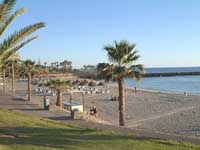
Photo credit: canaryforum
Shopping in Playa de las Americas
There is a vast array of shops in Playa de las Americas and holidaymakers can indulge in the delights of duty-free shopping in the numerous electrical stores and clothing shops. Shoppers should be aware that salesmen can be quite aggressive. It's best to bargain hard and remember that the shop next door probably sells the same stuff. The supermarkets offer most of the well-known brands, many imported to cater for the British tourists. Those in the mood for some haggling should go shopping in Las Americas Torviscas Market (Thursday and Saturday from 10am); there are great bargains to be had and it's perfect for presents, but shoppers should get there early as it can get very crowded. A trip to Santa Cruz (one hour by bus) is worthwhile for those looking for designer clothes.
Dining in Playa de las Americas
Playa de las Americas has top-rated restaurants in which holidaymakers can dine. There are restaurants in las Americas catering for every taste; along the seafront are dozens of fast food stalls and restaurants advertising English breakfasts and Sky TV, and international dishes of all varieties are also offered including Indian, Chinese, Italian, and excellent tapas and local Canary Islands cuisine. Many of the better restaurants are located in the Torviscas areas and in the neighbouring resort of Los Cristianos. There are also some nice restaurants overlooking the marina in Puerto Colon.
Activities in Playa de las Americas
With more nightclubs than some British cities and some of the best nightlife in Tenerife, las Americas is a honey pot for those looking for more of a nocturnal holiday. The area known as The Patch is the best place to start the evening as most of las Americas' bars are located within easy walking distance. The Patch also has a fine choice of nightspots and most bars have a happy hour or two. The most popular are Rags and Linekers, dance bars that play a good mix of Pop, R&B, Dance and 80s party music. Many of the bars also have good live music. Later on, the Veronicas complex and the Starco Commercial Centre are the places to head to for a good party. The streets are packed with revellers until the early hours, particularly during the busy summer months. Tramps is the largest club on the island and very popular. There are also two casinos at the resort.
Things to be aware of in Playa de las Americas
The resort is built on the side of a hill and many apartments require a steep walk up from the beach. The accommodation near the centre can be very noisy until the early hours. There are hundreds of touts trying to sell everything from trinkets to timeshare apartments. It's best to be firm but polite and avoid getting into a conversation with them. There are promotions staff outside the bars and restaurants who are also quite insistent, but it can be worth chatting them up as they sometimes offer free drinks. Visitors should be aware of con artists.
Saddleback
Overview
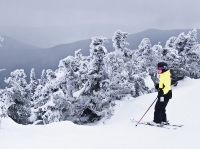
Photo credit: Jack Flanagan
Shopping in Saddleback
There is not much shopping in the actual resort of Saddleback and holidaymakers will have to head to Rangeley to quell their urge to splurge. There is a good selection of shops along the main street including book stores, specialist sports stores and the Alpine Shop, which carries a nice range of clothing as well as interesting household goods and some sporting equipment.
Dining in Saddleback
Those looking to eat out will have to head to nearby Rangeley where a good range of restaurants lines the main street. Here, holidaymakers can either choose to grab a quick take-away and head back into the mountain, or enjoy a leisurely dinner at one of the local pizzerias, barbeque spots, cafes or fine dining restaurants.
Activities in Saddleback
The apres ski in Saddleback is pretty limited but there's entertainment in the Swig-N-Smelt Pub upstairs in the base lodge from time to time. It closes relatively early most nights however, leaving those looking for something a little more upbeat heading down to the nearby town of Rangeley for a more hip and happening nightlife scene along the picturesque main street, where everything from lazy pubs to upbeat bars can be found.
Things to be aware of in Saddleback
Marketed as more of a family resort, apres ski leaves a lot to be desired and party animals might be left disappointed.
Skiing in Saddleback
With 66 run and glades, including the largest in the east, there are slopes catering to all kinds of skiers. Beginners have a choice of 25 trails on the lower section of the mountain where skier traffic is low, intermediates can carve on up to 19 trails in the middle section, and 22 trails cater to the advanced and expert skiers on the upper part of the mountain on runs such as Muleskinner, Dark Wizard,and Nightmare Glades.The Freerider Terrain Park is located on the Wheeler Slope and includes a variety of terrain, rails, jumps and ramps; the Gee Whiz terrain is the perfect place for younger riders and beginners to hone their skills; and although the ski school is quite pricey, it's a great way for beginners to improve their skills.
Verbier
Overview
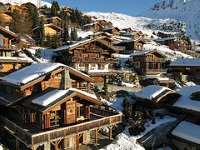
Photo credit: Leo-setä
A sophisticated network of cable cars and gondolas connect all the holiday resorts in the region and provide access to 102 miles (164km) of marked pistes. Verbier is the primary ski resort of French-speaking Switzerland, attracting advanced skiers and snowboarders to its demanding slopes and unlimited off-piste opportunities.
Although quaint in appearance, a holiday at the Verbier resort offers all the modern comforts and facilities of a major resort, with some of the finest cuisine in the region and a raucous nightlife that combines English-style pubs and French cafes. Much of Verbier closes down over the summer but, despite this, it can also be a great summer destination of magnificent scenery, good weather and wonderful walks; during this time it is popular with paragliders and mountain bikers.
Shopping in Verbier
The shopping while on holiday in Verbier is excellent, although expensive. Visitors will find a range of boutiques and clothing stores, as well as ski wear and equipment.
Dining in Verbier
A wide choice of restaurants caters to the international crowd on a Verbier holiday, with over 60 superb restaurants offering anything from traditional cuisine to Japanese and American fare. The Al Capone, Le Grenier and La Marmotte restaurants are well known for their good quality food, beautiful views and friendly staff. Local specialities such as fondues, raclette and rosti are served in traditional establishments such as La Channe Valaisanne, Vieux Valais and Le Carrefour. Vegetarians are well catered for as well. Fer a Cheval is a great pizza restaurant that is popular with regulars and is within walking distance from the main ski lifts. The main square is surrounded by cafes, patisseries and coffee shops.
Activities in Verbier
Verbier has one of the wilder and more exciting nightlife scenes among the European winter ski resorts. The road running from the main ski lift to the town centre is the heart of the apres ski action and there are plenty of bars and cafes around the town square. The Pub Mont-Fort is a popular apres-ski spot with the English holiday crowd, as is Big Ben Pub. The Offshore Cafe is a trendy spot for cocktails before dinner, while Bar'Jo and King's Bar are also quite popular. A variety of nightclubs stay open and busy until 4am. The Farm Club is perhaps the most famous nightspot in Verbier; it remains popular with Verbier old-timers and is the choice for many celebrities. Regular guests keep their own bottle behind the bar and are waved past the long queue. Coco Club is one of the most popular venues in Verbier; The New Club and Ice-Box Club are also trendy party places.
Things to be aware of in Verbier
Verbier's holiday accommodation, restaurants and ski passes are expensive and queues for the lifts can be long during the holidays. The snow reliability is fairly good in Verbier and it's usually possible to ski down to the village, but as with all European ski resorts, weather conditions are unpredictable and it can be cloudy.
Skiing in Verbier
Verbier, and the smaller holiday resorts of Nendaz, Veysonnaz, Thuyon and La Tzoumaz are all linked by one ski pass, which offers skiers and snowboarders one of the largest skiable areas in the Alps, including 102 miles (164km) of pistes of all standards. Verbier itself offers pistes for various levels of skiers and snowboarders. Advanced and intermediate skiers seek the resort's most famous slopes on the intimidatingly steep Mont Fort and the off-piste routes from Mont Gelé to Tortin and La Chaux. Verbier is also renowned for its vast amount of challenging off-piste skiing and demanding mogul runs, which are sought after by expert skiers and snowboarders. Beginners are also well catered for on a Verbier holiday with excellent ski schools, nursery slopes in the centre of the village and a wide variety of blue (easy) runs on Savoleyres and Lac de Vaux.
Calas de Mallorca
Overview
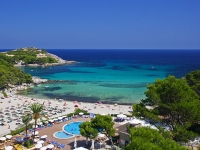
Photo credit: Max "
Shopping in Calas de Mallorca
Calas de Mallorca has the usual selection of tourist shops near the hotels in the Centro Commercial. There is a Sunday morning market in nearby Felanitx that has a selection of souvenirs, including good examples of local pottery. The prices are high, especially for tourists, so be prepared to bargain if you want a good deal.
Dining in Calas de Mallorca
Calas de Mallorca has great restaurants for holidaymakers to enjoy, the best of which include C'an Gusti, Cosme Oliver Pila, Explotaciones Hoteleras Edama and Jose Noguera Julia.
Activities in Calas de Mallorca
The resort is not known for its nightlife. There is a small collection of bars and restaurants in the Centro Commercial. While most of Calas de Mallorca's nightlife is hotel-based, there are a few live music venues and one or two clubs of which Jupiter's and Tiffany's have received positive reviews.
Things to be aware of in Calas de Mallorca
Public transport is limited and unreliable. The beaches have strong undercurrents and are not suitable for weak swimmers. Calas de Mallorca is not frequented by the single 18 to 30 age set.
Bodrum
Overview
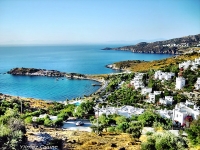
Photo credit: Yilmaz Oevuenc
Bodrum is a mustering point for local boats offering tailor-made daytrips to nearby islands or the pristine beaches and seaside restaurants along the magnificent coastline. From its position between the two harbours, the 15th century crusader Castle of St Peter dominates every part of the town, now home to the fascinating Museum of Underwater Archaeology. The other Bodrum holiday attraction is the Mausoleum of Halicarnassus, the crumbling remains of one of the Seven Wonders of the Ancient World.
As Turkey's leading seaside holiday destination, Bodrum is packed with foreign visitors in summer. Yet it remains unspoilt and retains its charming Turkish character, perfecting the balance between authenticity and tourist comforts. Here, exotic bazaars, the wailing cry of the muezzin, and ancient history seamlessly blend with popular water sports, sunbathing, and a nightlife that is notorious throughout Turkey.
Shopping in Bodrum
Like everywhere in Turkey, shopping on a Bodrum holiday is quite an adventure. Dozens of shops line the busy narrow streets from the bus station down to the marina. Touts and vendors offer a variety of local goods, from carpets, leatherware, and kilims to fake designer clothing, and gold and silver jewellery.
Look out for Turkish meerscewhaum pipes and onyx. There is an extensive colourful craft market in operation on Tuesdays, and a fruit and vegetable market on Fridays. Bargaining is expected and it is customary to haggle down to about half the asking price. In Bodrum, some shops stay open late at night, some even all night.
Dining in Bodrum
Warm, sultry evenings in Bodrum are best spent dining on fresh seafood or local specialities in one of the numerous restaurants. There are plenty of familiar cuisines, such as Italian, Thai, Chinese, Mexican, and European.
Renowned as the top place in town for typical Turkish is Denizhan, a little out of town between Konacik and Ortakent, and easily reached in a dolmus or taxi. For excellent Aegean dishes, especially lamb, Epsilon in the old town is hard to beat. The best pizza in Bodrum is served up with a view on the rooftop terrace of Sunger Pizza, while a good blend of Mediterranean and Californian cuisine can be enjoyed at La Jolla Bistro at Xuma Beach.
Also very popular is the Secret Garden, near the Marina, where cooks prepare gourmet Mediterranean fare with flair. The Backpacker Bar & Grill caters to the expat crowd with traditional English food.
Activities in Bodrum
The nightlife on a Bodrum holiday is frenetic and varied, offering not only western-style decadent clubs but also the chance to sample local parties. Travellers can visit one of the meyhanes where the crowd joins in with the local artists, singing, dancing, eating, and drinking. There are several of these local nightclubs on the road to Konacik and Ortakent.
Most of the bars in Bodrum's mile long Bar Street offer belly dancing shows, live music, and outdoor seating (often on the beach) with a view of the illuminated castle. For clubbers, the main place to be is Halikarnas, one of the biggest and swankiest open-air clubs in the world, where the entrance charge may be high. There are plenty of other clubs, even one on a catamaran that sets sail late at night and takes the party out to sea until the dawn.
Things to be aware of in Bodrum
Bodrum beaches are shingled and can become very crowded during the height of the summer holiday season. The city's narrow streets become clogged with tourists, day and night, during peak periods. Women have complained of sexual harrasment.
Overview
Puerto de la Cruz
Overview
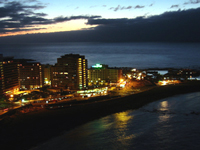
Photo credit: Tenerife Resorts
Shopping in Puerto de la Cruz
Puerto de la Cruz is a shopper's paradise and holidaymakers won't be disappointed. The 'free port status', which the island enjoys, allows imports from all over the world. There are a large variety of goods available from the many hundreds of shops, often at good prices. Electronic items of every description, photographic gear, perfumes and alcohol are especially cheap. Travellers should be aware that cheap goods can sometimes be tacky, low-quality or counterfeit. The Martianez mall is a favourite with tourists wanting to splash out on clothes, shoes and gifts.
Dining in Puerto de la Cruz
For a fine culinary experience while on holiday in Puerto de la Cruz, try La Casona, Meson los Gemelos, Regulo or La Ganania. The many restaurants in the resort offer up a variety of dishes and many different cuisines can be found. The Plaza de Charco is lined with restaurants and cafés and it is the perfect place to enjoy a meal, tapas or just a drink and watch the world go by.
Activities in Puerto de la Cruz
Holiday visitors should be sure to visit the most popular bars in Puerto de la Cruz, including Friagata, Molly Malones, Color Café and Azucar. There is, however, a wide range of bars and clubs on offer, with some staying open into the early hours of the morning. Puerto de la Cruz's nightlife is special in that it is still geared towards locals more than tourists and therefore has an authentic Spanish flavour which the purpose-built resorts usually lack.
Things to be aware of in Puerto de la Cruz
In recent years muggings and other street crimes have started to become a problem. Thefts from cars, especially cars left overnight and cars left in what appear to be deserted scenic locations, have become a major problem. Travellers should not leave valuable items in an unoccupied car.
Gstaad
Overview
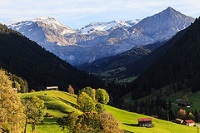
Photo credit:
Shopping in Gstaad
Gstaad's main shopping street is Hauptstrasse, which has a large selection of stores and boutiques that offer wares from the latest fashions and exclusive sporting goods to jewellery and pastry shops. Stores cater mainly for the wealthy.
Dining in Gstaad
Visitors to Gstaad are spoiled for choice when it comes to restaurants. A large number of establishments have been awarded with Gault Milau points for outstanding cuisine, such as Restaurant Le Grill at the Palace, while about 70 others offer everything from traditional specialities to Asian, Italian, fish and grills.
Activities in Gstaad
After skiing many people gravitate to one of the bars at Dorfstrasse for a beer or cocktail. The GreenGo bar and nightclub at the Palace Hotel is the place to be seen and is the centre of Gstaad's nightlife. Richi's Pub is a popular meeting spot for locals, and is a favourite among sports fans for watching sporting events. The more elegant Rialto bar also hosts live music in winter.
Things to be aware of in Gstaad
Gstaad has a reputation for being an exclusive ski destination and is expensive even by Swiss standards. The skiing might be a disappointment for expert skiers, and snow coverage is unreliable due to the relatively low altitude.
Skiing in Gstaad
There is excellent skiing and snowboarding for beginners and intermediates in and around the Gstaad town centre but, for more challenging runs, it's best to make use of the Gstaad Super Ski Region pass, which is valid for about 155 miles (250km) of prepared runs spread over six different ski areas. The pass provides access to the ski areas of Chateau d'Oex, Rougemont, Saanen, Schonried, Saanenmoser, Zweisimmen, Lauenen and Gsteig, which are all accessible by train. Intermediate skiers are the most spoilt for choice, as a huge variety of blue and red runs are available near Gstaad, while the Diablerets glacier has snow most of the year and some challenging skiing and snowboarding for the advanced, as well as heli-skiing. Advanced skiers will also find off-piste possibilities in the Saanenmoser and Schonried area. There is an excellent ski school in Gstaad, and there are many others in the Gstaad region.
Overview
Turunc
Overview
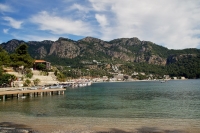
Photo credit: ivabalk
Shopping in Turunc
Turunc also has a large range of shops, offering the usual fake designer goods, leather items, souvenirs, and jewellery, as well as a chance for holiday makers to improve their bargaining skills at the market on Mondays. The atmosphere is more laidback than some towns, but haggling is still a must if travellers want a good deal. Popular souvenirs include honey, Turkish delights, and 'evil eye' charms.
Dining in Turunc
Most restaurants in Turunc offer both Turkish and English food. Fish and lamb are local specialties, and sweet and savoury pancakes in the tea gardens are pleasant. Bondjuk is popular for its lamb kleftikos and live jazz music, and Sahin is a well-known steakhouse.
Activities in Turunc
There are a few lively bars and clubs in Turunc, but nothing stays open very late and the town is not well-suited to anyone looking for a party.
Things to be aware of in Turunc
The resort doesn't have much in the way of a nightlife.
Keystone
Overview
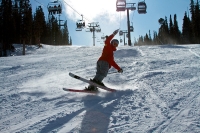
Photo credit: Zach Dischner
Shopping in Keystone
In the three Keystone villages there are shops catering for all ski and snowboarding needs while there on holiday. However, for anything else the resort is quite limited. A few stores rent out ski equipment and sell resort memorabilia, and there are also a couple of clothing, jewellery and souvenir stores in Keystone. General stores sell products for self-catering holiday visitors, and the nearby town of Dillon has a small shopping complex with more variety. The town of Frisco, further on, has a wider selection still.
Dining in Keystone
Keystone boasts some of the best restaurants in the area, with a variety of dishes, ranging from seafood to steak, to enjoy on holiday. Top restaurants include Keystone Ranch, Ski Tip Lodge and Alpenglow Stube. An unusual option is to have dinner on a horse drawn sleigh ride, departing from Dercum Square. It is advisable to make all reservations in advance. For the budget conscious, take-away pizza is always a good option after a hard day on the slopes.
Activities in Keystone
Although not as well known for its nightlife as nearby Breckenridge or Vail, Keystone has its share of bars spread across the resort. Visitors will find sports bars and a few venues offering live music; there may not be great variety, but it is always possible to find an atmospheric bar for a few drinks.
Things to be aware of in Keystone
Over the Christmas period and Spring Break, the Keystone holiday resort and mountains can get overcrowded. The nightlife and shopping is not as good as many of the other nearby resorts.
Skiing in Keystone
Between the three mountains at Keystone there are a variety of runs to suit everybody from the greenest beginner to the most advanced. Dercum has most of the green and blue runs for the beginners, while North Peak and The Outback have blues, blacks and moguls for those who enjoy the extra challenge. For park-lovers, A51 Terrain Park has enough pipes and rails to keep them happy. And come 5pm, when most other ski resorts shut their mountains and head to the bars, Keystone keeps Dercum and A51 open until 9pm, offering the largest area for night skiing in the whole of Colorado.
Skanes
Overview
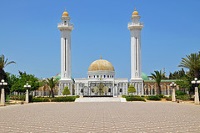
Photo credit: Dennis Jarvis
The historic city of Monastir retains its ancient air of having been Tunisia's holiest place, and an important strategic stronghold that was once used as a base by Julius Caesar. Just a few miles from the centre of Monastir lies the extravagant stretch of grand hotels that have been built along the coast in the area known as Skanes. These magnificent architectural delights are set in acres of lush gardens, most of them encompassing their own patch of well-maintained sandy beach.
The Skanes hotels are well connected to Monastir and other nearby resort towns, such as Sousse, by a tourist road train and a plethora of taxis. Monastir also has the advantage of having its own international airport. Parasols and umbrellas pepper the beaches, along with the stands of local vendors and watersports equipment renters.
Shopping in Skanes
Like everywhere in Tunisia a great deal of fun can be had haggling for bargains in the local medina. Monastir and Skanes are also well supplied with modern shopping centres catering to tourist needs.
Dining in Skanes
Most dining in Skanes is confined to the hotel restaurants geared towards holidaymakers. But those wanting a change of eating venue are spoilt for choice in nearby Monastir, particularly around the marina and its adjacent shopping centre.
Here, restaurants, cafes, pizza parlours, and snack bars abound. Most of these establishments are aimed at European tastes and alcohol is served. Many even happily accept Euros in payment. Those wanting to try genuine local fare won't have to venture far and can enjoy the spicy dishes served with unleavened bread at far more affordable prices.
Activities in Skanes
Holidaymakers will find that the nightlife in Skanes mainly centres on live entertainment and dancing provided 'in house' by the various hotels.
Things to be aware of in Skanes
Vendors and shopkeepers often pester tourists to buy their wares. There is little for children to do apart from enjoying the sandy beaches.
Overview
Ayia Napa
Overview
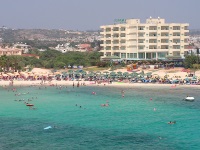
Photo credit: Paul167
Located in the centre of the market garden area of the island, Ayia Napa also boasts a string of superb golden sandy beaches and vestiges of its cultural heritage. There's a Venetian-decorated monastery fronted by a 600-year-old sycamore tree, and a quaint harbour filled with colourful fishing vessels. Just a few miles from Ayia Napa, the resort of Protaras is more restrained and suited to family holidays. Both resorts have excellent beaches, the most famous being Fig Tree Bay.
Other popular beaches include Nissi Beach and Nissi Bay, two miles (3km) west of Ayia Napa; Cape Greco to the east, where the challenge is to leap from the rocks into the sea; and Konnos Bay, just past Cape Greco, where there is a beach cafe and speedboats for hire.
Shopping in Ayia Napa
Shopping in Ayia Napa is pure pleasure for locals and holidaymakers alike, with real bargains to be had, particularly on designer goods. High-end watches, sunglasses, clothing, cameras, and jewellery are available at cheaper prices than in the United Kingdom. Shops and boutiques are generally small and friendly, opening until 11pm every night except Sundays.
The local handcrafts make for good souvenir shopping, and include beautiful embroidered Lefkara lace, original ceramic pottery, artistic silver jewellery, baskets, woven and silk goods, and high-quality leatherwear. Major credit cards are accepted everywhere.
Dining in Ayia Napa
Variety is the spice of life when dining out in Ayia Napa, where countless restaurants specialise in a host of cuisines from around the world. Everything from the romantic and traditional to fast food and pub-grub is on offer. Whether it's a Big Mac or fish 'n chips, Chinese or classic French, travellers won't have to go far to find it.
Visitors are well advised to try the Cypriot fare, particularly in the delightful traditional tavernas clustered around the harbour. Highly recommended is the typical Cypriot meze platter, made up of between 15 and 30 island dishes. Other local specialities include taramosalata, tzatziki, moussaka, stifado (beef or veal stew), afelia (pork in red wine), and loukoumades (doughnuts dipped in syrup).
Activities in Ayia Napa
Holidaymakers in the resort soon learn that it's essential to plan an afternoon siesta if they are to make the most of the sensational nightlife for which Ayia Napa is world-renowned. The Cypriots' appreciation for the good life and good times comes to the fore after sunset, with bars, discos, nightclubs, and bouzouki clubs open well into the early hours of the morning.
Most hotels have their own nightly entertainment, with a resident band and Greek nights when folk dancing is offered. The resort's clubbing scene is legendary, with big name deejays appearing frequently at some of the popular clubs.
Things to be aware of in Ayia Napa
Generally Ayia Napa is clean, well ordered, and favoured by all types of holidaymakers. Those who do not enjoy noise and bright lights, however, are advised to stay clear of the central monastery square area, which is where most of the popular nightclubs are situated. The main clubbing season is between June and September, and during this period the resort is packed with young people from all over Europe.
Older holiday makers may prefer to enjoy the resort during the shoulder months (April, May, October and November), when the weather is still good, the sea relatively warm, but the tempo slower. The island can be windy, but the geographic locations of the surrounding beaches means that it is possible to find a sheltered beach even on windy days. Nissi Beach tends to be overcrowded, but there are other beaches within easy reach where it's possible to enjoy peace and quiet.
Alanya
Overview
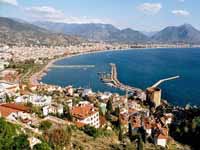
Photo credit: Vitalis Eichwald
The southern part of the town is the most tourist-orientated, although, fortunately, a height-restriction has limited the sprawl common to resort towns. There is, however, the usual collection of resort-style hotels and tourist-orientated fare in Alanya. The harbour is a hub of activity, particularly at night, and when tired of relaxing on the beach, there are several sites such as the Damlatas Caves, Alanya Castle and the Red Tower to visit.
Alanya is also backed by the pine-forested Taurus Mountains and while on holiday there, a half hour's drive out of town allows visitors to enjoy spectacular views, as well as the charm of small, rural villages where life continues much as it always has.
Shopping in Alanya
Alanya has a range of good shops, and part of the fun for visitors is perfecting their haggling skills. Barring food items, bargaining on everything is expected and patience is key. One can usually expect to get prices marked down by 30 to 50 percent. Touts can get annoying and it is best to avoid shops with aggressive salesmen. Alanya offers some excellent jewellery stores, as well as leather goods and clothing stores, a local market, and the usual tourist tat. Hookahs (water pipes) and tobacco are popular souvenirs from Alanya, as well as Turkish tea sets.
Dining in Alanya
Alanya has a large range of restaurants, catering for a variety of tastes, from traditional Turkish food to McDonalds. Some favourites include Memos, serving traditional Turkish dishes such as a delicious Ottoman stew, and Big Ben's for more English-style breakfasts and Sunday roasts. Visitors should try a kebab or mezze platter, followed by a cold Efes beer for an authentic Turkish experience. If travellers eat from street vendors, they should remember that they can haggle the price of their meal; haggling is frowned upon in restaurants and grocery stores, however. Local specialties such baklava and thick, sludgy Turkish coffee are highly recommended.
Activities in Alanya
Much of Alanya's nightlife is centred on the harbour, but several more locally frequented bars and clubs can be found tucked away in the side streets. Many of the clubs close relatively early, but a free shuttle ferries serious partiers to Auditorium, an enormous venue that stays buzzing until the wee hours and is away from the town centre. Other favourites include Robin Hood, and Bistro Bellman. Several venues also provide more traditional entertainment such as belly dancing, fire shows, and traditional music.
Things to be aware of in Alanya
Alanya is a popular holiday resort and can get very noisy and crowded. The busy main highway runs through the resort, and causes pollution, noise, and congestion. An ancient lava field just below the water line can be hard to negotiate while swimming.
Morzine
Overview
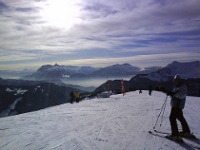
Photo credit: Bonnie Craven Francis
Shopping in Morzine
Holidaymakers will find a variety of local handmade goods and typical French souvenirs displayed in shop windows in Morzine, such as traditional Savoyard pottery, sculpted objects made from the local wood and slate, mountain cheeses and salted meat. There are also clothes boutiques and sports shops.
Dining in Morzine
Morzine specialises largely in fully catered chalet-style holidays, but for those looking for a night out there are a variety of options available. Traditional fare such as raclette, fondue, berthoud or diots can be found in a number of establishments. Meals are well accompanied by local wines.
Activities in Morzine
Après-ski is generally low-key and relatively calm, but several bars and discos in Morzine offer a bit of after-hours entertainment for holidaymakers keen on a big night out. There are a variety of bars and English-style pubs, though many close as early as 8pm, and a couple of nightclubs that stay open late. Most clubs are closed around 2am.
Things to be aware of in Morzine
The low altitude of the resort means that resort-level snow is rare and there may be a wait at the lifts to access the mountains.
Skiing in Morzine
The unlimited ski area of the Portes du Soleil offers slopes for all levels of skiing and snowboarding at the foot of the Dents du Midi and the Dents Blanches, with wonderful panoramic views. The terrain covers about 404 miles (650km) of marked runs, making it the largest ski area in the world. Both Morzine and Avoriaz have nursery slopes next to the resort, while intermediates have a playground of vast proportions in the Morzine area as well as throughout the Portes du Soleil circuit. Advanced skiers and boarders will find more than 20 black runs, endless off-piste and some of the biggest moguls in the world on the legendary 'Wall' at Avoriaz. Avoriaz is also one of Europe's top snowboarding destinations. Ski schools offer lessons to all ages from three years up, for all levels.
Palma Nova
Overview
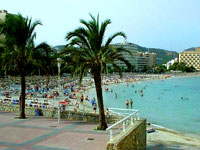
Photo credit:
Shopping in Palma Nova
Holidaymakers who prefer not to stray too far from their accommodation and the beach will be able to find all they need in the commercial centre of Palma Nova, which is liberally sprinkled with convenience stores, souvenir shops, gift shops, camera and electrical goods stores, a chemist and clothing outlets. For variety it is easy to take a stroll across to neighbouring Magaluf, which has even more tourist-oriented retail outlets. Serious shoppers can catch a bus or taxi into Palma, Mallorca's capital, which is famed for its excellent shopping, or visit one of the lively markets in the nearby towns and villages. For anything from gifts and souvenirs to delicious cheeses, olive oil and lively bargaining banter there is a weekly market held in nearby Andratx every Wednesday.
Dining in Palma Nova
Palma Nova has some of the best restaurants on Mallorca. Great eateries in this Spanish resort town include Maritimo, Natalies, Real Dion, Modigliani and the unimaginatively named Palmanova. The long promenade that stretches along the three beaches of Palma Nova is lined with dozens of good restaurants offering British, Chinese, French, Italian and Mexican cuisine. The resort also bristles with fast food outlets of all descriptions. Several Spanish bars serve up tapas snacks during the day, and of course there are plenty of seafood eateries to choose from in Palma Nova.
Activities in Palma Nova
Some of Palma Nova's bars have discos, live acts or TV (football and UK soaps) for holidaymakers to enjoy. Palma Nova and Magaluf have virtually merged, making the choice and range of nightclubs and bars even greater. In Palma Nova itself, tourists wanting a pub-type bar should go to Willows, while those after music bars and clubs can choose from Banana Joes, Papis and Ruby Tuesdays. Magaluf is the more party-orientated resort and has a more energetic nightlife.
Things to be aware of in Palma Nova
Palma Nova, although not as busy as Magaluf, is a close second. Beaches and streets can be crowded and congested in peak season, and this is not the place to seek out peace and quiet. Clubs often have touts or reps encouraging patrons to choose their establishment; these PRs are sometimes seen as a nuisance.
Overview
Overview
Oludeniz
Overview
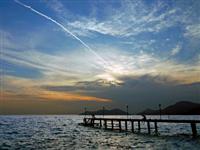
Photo credit: Kenneth Barker
Shopping in Oludeniz
Oludeniz has several souvenir shops sprinkled along the Belcekiz beach seafront, and many of the resort hotels and holiday apartment complexes boast their own gift stores. For honest to goodness shopping, however, travellers should catch a dolmus into nearby Hisaronu or Fethiye, where it is possible to haggle for bargains. Good buys are leather goods, carpets, jewellery, as well as knock-off designer sunglasses and watches.
Dining in Oludeniz
No-one need go dissatisfied in Oludeniz, no matter what their taste in food, and if they do manage to exhaust the holiday resort's possibilities, there is always Hisaronu just a few kilometres inland with a vast array of restaurants. Some recommendations are Blue Star Pide and Sultan Ahmet, both offer good Turkish cuisine; and the Belcekiz Beach Club A la Carte for an exclusive Mediterranean night out.
Activities in Oludeniz
Nightlife in Oludeniz is more low-key than in the nearby holiday resorts, concentrated more on chilling out in beachside bars than frenetic clubbing. Those looking to party the night away can take a short trip to Hisaronu, or a little further to Fethiye, and find plenty of action. Among the most popular seafront bars are Buzz Beach Bar, the Sugar Shack, and Crusoe's. Most of the local resort establishments offer live evening entertainment for guests as well.
Things to be aware of in Oludeniz
Many visitors have complained about overzealous touts becoming a nuisance, and prices in the resort town have risen in recent years, making it rather expensive by Turkish standards. The weather tends to be extremely hot and humid in the height of summer and mosquitoes can be a nuisance.
Hania
Overview
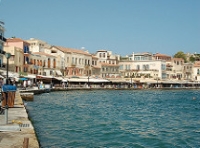
Photo credit: Gorka Palazio
Shopping in Hania
Holidaymakers should visit Hania's Municipal Market for good dining and souvenirs, and the famous Leather Street (Stivanadika) for leather items. Shoppers will also find many craft and jewellery establishments around the city.
Dining in Hania
Visitors will find many cafes, tavernas and restaurants around the harbour. The city also has a number of traditional establishments in the market area.
Activities in Hania
Hania has a number of clubs, with some quietly gay-friendly options.
Things to be aware of in Hania
The pavements in Hania are very narrow, so strolling along the streets can be a bit hazardous.
Beaver Creek
Overview
Photo credit: Jlfdz
The resort includes three villages with mountain access from all. The Beaver Creek Village is the heart of the resort and has plenty of shops and restaurants in its surrounds, whereas Bachelor Gulch and Arrowhead are more secluded but with great access to the slopes. Beaver Creek is part of Vail Resorts and ski packages can include access to Keystone, Vail, Breckenridge, and Heavenly (California), all of which (excluding Heavenly) can be accessed via an efficient transport system in the Summit County Area.
Shopping in Beaver Creek
Apart from offering a wide selection of skiing and snowboarding gear, shops in Beaver Creek sell jewellery, clothing, furniture, arts and crafts and much more, throughout the villages. A number of ski apparel and equipment centres provide all the necessary ski paraphernalia, a variety of gift shops offer Beaver Creek memorabilia, and boutique stores offer everything from fine wines to Swarovski Crystal.
Dining in Beaver Creek
There is something for every taste and price tag in Beaver Creek, and for any time of day. Restaurants are located all across the resort and on the mountain. A meal on the mountain may well be worth the price and what better way than arriving on a sleigh to a five-course meal at Beano's Cabin! In addition to some superb fine-dining options, there are plenty of delis, pizza parlours and burger establishments spread across and up the mountain for an in-between snack or light lunch.
Activities in Beaver Creek
Beaver Creek, though not renowned for an incredible nightlife, does offer quieter, more sophisticated evenings at the Beaver Creek Chophouse. The Coyote Cafe is another popular option, with locals as well as visitors.
Things to be aware of in Beaver Creek
The Beaver Creek resort is pricey compared to others in the area.
Skiing in Beaver Creek
Beaver Creek skiing conditions are often excellent thanks to the efficiency of resort handlers in maintaining the slopes. In 1989, the resort hosted the World Ski Championships, and it offers a variety of levels for beginners, intermediates, and even expert skiers. The resort also keeps park-lovers entertained with three parks, including a beginners park, Park 101, and Moonshine for those who can handle the rails, tables and half-pipes. Beaver Creek also boasts two bowls, Rose and Larkspur, creating a playground for advanced skiers and riders.
Los Cabos
Overview
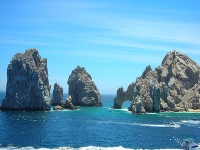
Photo credit: Lisa Andres
Los Cabos is an area made up of the two resort towns of San José del Cabo and Cabo San Lucas, sitting at either end of an 18-mile (29km) stretch of exquisite beaches sprinkled with exclusive luxury holiday resorts and championship golf courses, known locally as the Resort Corridor. San José del Cabo is the older and more traditional of the two resorts with the unhurried pace of a colonial Mexican village. Cabo San Lucas started as a simple fish ing village and is now one of the favourite beach holiday destinations of the elite, with high quality luxury services and an energetic nightlife. The majority of visitors base themselves in San Lucas or the Resort Corridor. Just offshore is the area's landmark and an impressive natural wonder, Los Arcos (The Arches), a beautiful, wave-sculpted rock formation.
Shopping in Los Cabos
There are shops galore in the two towns and along the Resort Corridor, and shoppers will not be disappointed in the variety of clothes and shoes, gifts and souvenirs, furniture, jewellery, leather goods and speciality stores. Cabo San Lucas has the largest selection of shops, and also has imported American goods, an artisan's market and dozens of boutiques to explore while on holiday.
Dining in Los Cabos
There are numerous restaurants in Los Cabos offering a wide range of fare from Italy, France and North America, as well as some excellent local Mexican cuisine. Seafood is understandably popular and is offered by almost every style of eatery. Diners can choose between fine dining, local restaurants with dancing and live music, bistros, and casual eateries. The tourist-orientated Resort Corridor has a vast variety of fine dining options, while simple Mexican cuisine is best found in either San José or San Lucas. One of the best places to sit elbow-to-elbow with locals is Marisquería Mazatlán, which serves simple and delicious seafood.
Activities in Los Cabos
The after dark scene in Los Cabos is mainly located in Cabo San Lucas, which has a livelier atmosphere than the relatively laid-back San José and attracts a younger, more energetic crowd. The most popular nightclubs are El Squid Roe, Cabo Wabo, Zoo Bar & Dance, and The Giggling Marlin, while many hotels have popular clubs and bars. For a quieter evening out, there are also numerous places to enjoy soft music and a romantic atmosphere.
Things to be aware of in Los Cabos
Los Cabos can sometimes experience hurricanes and tropical storms. Hurricane season runs from June to November and visitors to the region during this time should take care to check weather and storm forecasts.
Puerto Vallarta
Overview
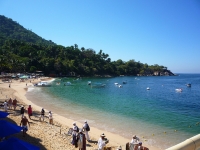
Photo credit: Jonathon McDougall
Puerto Vallarta's luxury hotels, restaurants, bars, and shopping centres have spread out along the coast on either side of the original town, allowing Puerto Vallarta to grow as a holiday destination without sacrificing its colonial charms. With more than 250 restaurants, visitors to Puerto Vallarta are spoilt for choice when it comes to dining out in this charming city. In Puerto Vallarta tourists will find a cosmopolitan hub which nevertheless boasts the simple pleasures of a Mexican village. Outdoor recreation is limitless in Puerto Vallarta, especially considering the diversity of watersports available, including scuba diving and snorkelling, while whales and dolphins inhabit the bay and can often be seen on organised boat trips.
Shopping in Puerto Vallarta
Even serious shoppers won't be disappointed by the variety of shops in Puerto Vallarta, which line almost every downtown street and range from speciality stores and shopping centres to outdoor markets and art galleries. No other holiday resort destination in Mexico can offer a better shopping experience than Puerto Vallarta. It has developed a reputation as an art centre and there is an abundance of local arts and crafts, such as pottery, ceramics and hand blown glass. Boutiques stock an array of shoes, traditional Mexican sandals and clothing, while the main flea market is the place to bargain for inexpensive handicrafts, clothes and souvenirs.
Dining in Puerto Vallarta
As the culinary capital of Mexico, and host to the annual Gourmet Dining Festival every November, foodies will be in paradise while on holiday in Puerto Vallarta. It is home to some of the best restaurants in Mexico, and offers thousands of places to dine ranging from award-winning venues and family-run restaurants to coffee houses and relaxed beachside cafes. A wide range of international cuisine is available, from Italian to Japanese and French, with the eclectic Daiquiri Dick's coming out tops and La Ola Rica serving popular pizzas and coconut shrimp. For traditional local Mexican fare, visit El Arrayán in the centre of town.
Activities in Puerto Vallarta
The nightlife in Puerto Vallarta offers something for everyone. There are nightclubs and all night discos, strip bars, live music clubs, bars serving up sundowner cocktails, restaurants that bring on bands after the food has been cleared away, folkloric dancing and Mexican fiestas, and hotel bars where visitors and locals alike gather over a drink for a chat at the end of the day. The centre of the nightlife is the Malecon strip where the vibrant atmosphere suits the young and the young at heart. The South Side features a variety of alternative entertainment, including gay bars and strip shows.
Things to be aware of in Puerto Vallarta
During the warmer months of May to August insects and mosquitoes can become a problem in Puerto Vallarta so be sure to bring plenty of repellent with you.
Aspen
Overview
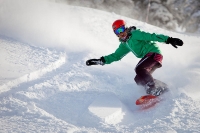
Photo credit: Jeremy Swanson
Shopping in Aspen
Whether travellers are on an Aspen holiday for the winter sports or just to be seen (or both), they will have to schedule quite a large slice of their time to the resort's other main activity, which is world-class shopping. Unfortunately, prices are high, but that should not deter even the most budget-conscious browsers from 'just looking'. The retail options extend from home-grown stores offering handcrafts to high-fashion designer boutiques, jewellery to die for, antiques and collectibles, and even a unique pet's paradise where animal lovers can outfit their pooches in style. Those who do not come well prepared can, of course, also find trendy ski-wear at local upscale outlets such as Gorsuch, where celebrities flock for the latest in mountain style.
Dining in Aspen
All that crisp, cold air and exercise ensures that Aspen's visitors are a hungry bunch, but even the heartiest appetites go well satisfied in the resort, which has a huge range of restaurant offerings, from takeaways to gourmet fine dining. Some recommendations include the eclectic Woody Creek Tavern, where the burgers are sought after by some celebrity regulars; and the Kenichi sushi den, with its lively, buzzing atmosphere.
Activities in Aspen
Apres-ski is a vital part of any winter resort holiday, and Aspen pulls out all the stops to ensure its visitors an unrivalled night out on the town. Sophisticated social spots abound, from comfy cigar bars to trendy cocktail lounges, while the younger set will find live music venues such as Belly Up to enjoy artists from around the globe.
Things to be aware of in Aspen
A top-rate ski resort, the quality is reflected in the prices at Aspen and, as such, it is not the right resort for those seeking a budget ski vacation. It can also get rather crowded.
Skiing in Aspen
Aspen is regarded by many as America's prime winter holiday resort, with downhill skiing providing its lifeblood since 1936. The Silver Queen Gondola transports skiers to the top of Aspen Mountain, above the town, to take on the expert and intermediate slopes. Two miles (3km) west of town the Buttermilk area provides novice and intermediate runs, while farther out, at Snowmass and Aspen Highlands, families can enjoy a variety of types and levels of snow fun. Cross-country trails snake through the national forest.
Port El Kantaoui
Overview
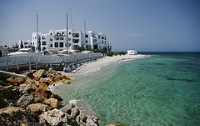
Photo credit: Eugenijus Radlinskas
The El Kantaoui Complex is built around a modern marina and can accommodate more than 300 vessels, most of them moored by millionaires. Its complex of hotels centres on the cobblestone streets of the perfect reproduction of a typical medieval medina, abuzz during the day with souvenir hunters. In the evening, the action switches to the bars and cafes opposite the marina. The entire town has been termed a 'tourist ghetto' and is indeed a delightful and highly successful one, enhanced by its Mediterranean location and Moorish flavour.
Shopping in Port El Kantaoui
Like the entire resort, the shopping centre and model 'souk' in Port El Kantaoui is geared to holidaymakers, stocking mainly souvenir items with prices higher than elsewhere in Tunisia. Bargaining for goods is an entertaining experience, however. For better bargains and a more realistic Tunisian bazaar experience, travellers should take an excursion to nearby Sousse.
Dining in Port El Kantaoui
El Kantaoui bristles with excellent restaurants serving all sorts of cuisine, and holidayakers will not be disappointed. Most of the best restaurants front the Marina in the form of high-class, sophisticated eateries, serving up traditional specialities and local favourites. Prices are modest by European standards, but higher than elsewhere in Tunisia.
Activities in Port El Kantaoui
Nightlife is low key, but most holidaymakers can find something to their taste, whether it be simply lingering over a delicious meal, sipping drinks at a waterfront cafe, or enjoying the in-house entertainment at one of the hotels. There is also a casino about five minutes away.
Things to be aware of in Port El Kantaoui
Port El Kantaoui is often extremely crowded and more expensive than the other holiday resorts in Tunisia. There are no facilities here for budget travellers because most hotels are top-rated establishments.
Puerto Santiago
Overview
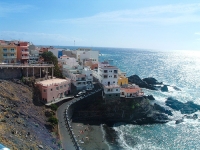
Photo credit: Flickr: computerjoe
Shopping in Puerto Santiago
There is no shopping district in Puerto Santiago, but there is an assortment of shops that cater for tourists. Shopping on the island of Tenerife is tax-free, so it is possible to find good deals on cigarettes, perfume, alcohol, electronics, and other goods. Although Puerto Santiago is not a shopping hub, there is a larger variety of shops in neighbouring resorts like Los Gigantes. A unique souvenir from Tenerife is the locally-produced sweet rum called Ron Miel.
Dining in Puerto Santiago
There is the usual assortment of international restaurants in Puerto Santiago, but the local Canarian eateries and tapas bars are the best. Try some of the delicious traditional dishes, such as roast chicken in banana cream or 'wrinkly potatoes' in the local mojo picón sauce. One of the most popular restaurants in Puerto Santiago is Pancho, while TJ's Entertainment Bar serves pub food like sandwiches and pies and is also well-loved.
Activities in Puerto Santiago
Most of the entertainment in Puerto Santiago is provided by the hotels. The nightlife is fairly laid back and many bars close at midnight. After dark entertainment usually consists of relaxed drinks and drawn-out meals. However, those wanting to dance the night away can make the short trip to one of the other nearby resorts, such as Playa de las Americas, which offer more of a party scene. The proximity of Puerto Santiago to such nightlife hubs allows visitors the best of both worlds: the peaceful, quiet resort atmosphere, and the fun Tenerife nightlife.
Things to be aware of in Puerto Santiago
The ocean currents around Tenerife can be very strong and swimmers should be cautious and pay attention to warnings from lifeguards.
Kalkan
Overview
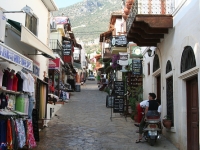
Photo credit: Jack
Narrow twisting streets, historic Ottoman architecture, shuttered windows, and white-washed houses, as well as sweeping views over the harbour and sparkling bay, are all part of its unique character.
The genuine friendliness of Kalkan locals is a welcome change from the hassle experienced in most holiday towns. Untouched by mass tourism, Kalkan is small, unspoiled and laidback, but still has plenty to offer.
Holidaymakers can enjoy beautiful beaches, boat cruises, and watersports, or take in ancient Lycean history. Kalkan also boasts the highest number of restaurants and bars per square metre on the Turkish coast, and is renowned for its rooftop venues.
Shopping in Kalkan
Kalkan's Thursday market is a great place to pick up souvenirs and mingle with the locals to get a true reflection of Kalkan life. Gold and silver jewellery, Turkish kilims (handwoven rugs), and a traditional blue-coloured glass 'evil eye', said to ward off evil spirits, are the main buys when enjoying a little retail therapy in the streets of Kalkan. Many of the shops stay open till at least midnight. Other popular purchases are tailor-made suits and other clothing.
Dining in Kalkan
There is a high concentration of restaurants in Kalkan, most of which are peppered around the centre of town. There are over 100 restaurants ranging from trendy and market eateries to local lokantas (tavernas), and even rooftop restaurants, which offer breathtaking views over the harbour and serve a variety of cuisines, including traditional Turkish, locally caught seafood, and many classic Mediterranean favourites, while local meze (similar to tapas), cheese, and trout are popular features on restaurant menus. There are a number of eateries offering international cuisine, but visitors should note that they come with an international price tag.
Activities in Kalkan
Kalkan's nightlife will keep all types of visitors busy. With plenty of restaurants, cafes, bars, and nightclubs to enjoy, the town comes to life after dusk. Travellers can head to one of the many rooftop terrace bars for sundowners, listen to a gypsy band while sipping on the local aniseed drink, 'raki', smoke a hookah pipe and recline on Ottoman-style cushions, or enjoy the local ladies putting on a belly dancing show.
Things to be aware of in Kalkan
Kalkan can often be packed with British tourists and the main beach is shingle, so shoes are advised for beach excursions. However, water depth drops off close to the shore, meaning travellers won't have to walk over the pebbles for long.
Playa Blanca
Overview
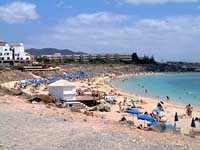
Photo credit: canaryforum
Shopping in Playa Blanca
There are good supermarkets in Playa Blanca that sell all the well-known brands, and holidaymakers will find that although the choice is not as good as in Puerto del Carmen, there are a fair number of electrical duty-free stores and other shops geared towards tourists near the harbour. For designer clothes most tourists in Playa Blanca head to the stylish Marina Rubicon. It is possible to get good bargains in the electrical duty-free stores, but shoppers should remember that they can't take purchases back to the shop once they've left the island. They should check everything works and that all batteries, cables and plugs are included; that there is a European guarantee, not an Asian one; and that all electrical items have a CE stamp. The busy Sunday Market in Teguise is worth the journey for the most dedicated shoppers; as well as the usual tourist souvenirs and holiday gifts, a variety of locally produced goods are on sale, from pottery to tablecloths.
Dining in Playa Blanca
La Bocaina and Casa Pedro top the list of highly recommended restaurants in Playa Blanca. While La Cocina de Colacho, El Horno de la Aguela and Romantica all garner rave reviews from tourists and locals alike. There's a huge choice of eateries on the main promenade, which at night bustles with activity. The promenade overlooks the beach and harbour and the lights of Fuerteventura can be seen on the horizon. Restaurants serve anything from Chinese, Indian or Italian to seafood and local dishes. Some restaurants will not accept credit cards.
Activities in Playa Blanca
The nightlife in Playa Blanca is fairly limited, with entertainment after dark mostly restricted to the shows organised by the hotels. There is a kids disco and some sedate live music in some of the bars and restaurants, but those after some serious partying will need to head to Costa Teguise or Puerto del Carmen, half an hour away by car.
Things to be aware of in Playa Blanca
While water is safe for cleaning teeth and washing food, it is very high in mineral content and can cause bad stomachs. Bottled water should be used for drinking. There is still some development going on in Playa Blanca and it is worth checking if there is a building site outside your accommodation before booking.
Overview
St Anton
Overview
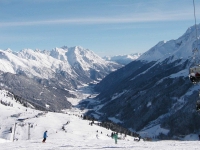
Photo credit: Johnfmh
Shopping in St Anton
Shopping along St Anton's pedestrianised main street is quite laid-back, with plenty of cosy bars and cafes where shoppers can rest their feet. St Anton's shops tend to be expensive but the quality of merchandise is good. There are numerous ski shops, as well as jewellers, antique stores, and clothing boutiques.
Dining in St Anton
Dining out in St Anton is a diverse and satisfying experience, with everything from burgers to vegetarian meals on offer at establishments that keep cooking until well after midnight. For five-star dining in St Anton, try the luxury hotels such as Raffl's St Antoner Hof or Alte Post. Exhausted skiers wanting a hearty meal can seek out traditional Austrian fare. Some of the best in St Anton is served up at the Sporthotel, where a variety of sausages can be savoured with an accompaniment of potatoes and sauerkraut, all reasonably priced. Game and dumplings also appear on most St Anton menus. Fondue can be enjoyed at the Montjola, one of the oldest restaurants in the area.
Activities in St Anton
The club and bar scene in St Anton is very lively, and less expensive than some of the other European ski resorts. The legendary Krazy Kanguruh Bar on the mountainside, and the MooserWirt Bar, are both usually packed with skiers and snowboarders after a day on the slopes. Alcohol flows freely to the tune of rock and hip hop in St Anton. The night is long at the numerous other discos and clubs, but for those seeking something more sedate there are quieter, more sophisticated bars in the St Anton hotels.
Things to be aware of in St Anton
St Anton's south-facing slopes can get slushy by the end of the day, particularly in spring, and the lower beginner slopes can get quite crowded.
Skiing in St Anton
St Anton is the largest ski resort in the Arlberg ski area, which also includes Lech, Zurs, and the village of St Christoph and St Jakob. The combined Arlberg ski area offers hundreds of miles of groomed runs and ski trails for skiers and snowboarders.
The most prominent point in St Anton is the Valluga summit from which runs one of the best and longest intermediate ski slopes in Europe, taking skiers all the way down to the valley floor. There are many more choices for intermediate skiers on holiday in Lech and Zurs, which also offer some of the best off-piste skiing in Europe.
Thanks to the Flexenbahn cable car, it's now much easier to get from St Anton to Lech and Zurs. Due to their north-facing slopes and position at the end of the valley, Lech and Zurs offer reliable snow and comparatively uncrowded slopes.
The best skiing for beginners is in St Christoph or Rendl. There are two ski schools in operation, run under the same umbrella, both employing hundreds of instructors and guides with a solid reputation for excellent tuition and service.
St Anton is also known for having some of the best snowboarding terrain in Austria, with a vast array of natural obstacles, steep powder fields, and drop-offs providing thrilling free-riding. Gampen, Kapall, and Rendl are recommended for boarders and Rendl has a terrain park.
Koh Pha Ngan
Overview
Photo credit: Micha Schmidt
The site of Koh Pha Ngan's legendary parties is the crescent-shaped beach of Haad Rin on the island's south-east corner, which is besieged by up to 30,000 people from around the world at full moon each month. As dusk falls thousands of lamps are lit on tables along the beach and the music is cranked up, sending party-goers into a frenzy under the rising orb of the moon.
Visitors on holiday in Pha Ngan generally stay in one of about 200 thatched bamboo bungalows that line the island's beaches and are let out for a pittance. Those after more luxury can choose from the many holiday resort hotels. Wherever visitors stay, the holiday is wiled away pleasantly with snorkelling, swimming or relaxing on the white sands.
Facilities in the Koh Pha Ngan town of Thong Sala are limited, but there is a bank, a police station, a clinic and pharmacy. Motorcycle taxis can be waved down or mountain bikes hired to explore the more remote beaches, though some beaches can only be reached by sea. Water taxis are available in the town.
Shopping in Koh Pha Ngan
On Koh Pha Ngan, most shops and kiosks are in Thong Sala and Haad Rin, and stock a range of cheap clothing and novelties, mostly aimed at holiday backpackers. Local handicrafts are plentiful, particularly batik. There are some photo shops and small supermarkets, including a couple of 7-Elevens.
Dining in Koh Pha Ngan
There are plenty of storefront restaurants along the streets of Koh Pha Ngan's main town, Thong Sala, and along the beachfront at Haad Rin, and they're ideal for a quick and tasty meal. Most serve a mix of Thai and western dishes, but street vendors are the cheapest option for local snacks. One of the most popular gathering places on the island is the Outback Bar on Thong Sala's main street, which has a vast menu, pool tables, and a large screen TV showing satellite news and sports events. Another popular eatery is the Same Same restaurant at Ban Tai, which offers basic favourites such as burgers, pizza, pasta and steaks, as well as Thai dishes.
Activities in Koh Pha Ngan
While on holiday, most nights in Koh Pha Ngan's remote bungalow resorts are fairly peaceful, with a few beach bars playing music to serenade the incredible sunsets. At full moon, however, Haad Rin is the place to be, when a dozen or more sound systems blast, and the beach becomes packed with thousands of hedonistic party animals. Along with visiting top class DJs, the entertainment is enhanced by jugglers, fire-eaters and frenzied dancers of all descriptions, while beach traders keep everyone fed and lubricated. The notorious Pha Ngan Full Moon parties are the ultimate experience.
Things to be aware of in Koh Pha Ngan
Mosquitoes can be a nuisance during the dry and rainy seasons, so visitors should be sure to pack plenty of mosquito repellent.
Protaras
Overview
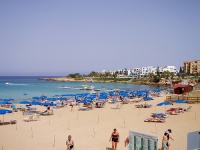
Photo credit: Glen Bowman
Protaras is actually a town built on a piece of flat, scrubby land expressly for the purpose of catering for British holidaymakers. Just adjacent to the village of Paralimni, Protaras consists mainly of a grid of restaurants, nightclubs, and shops surrounded by numerous hotels and holiday apartment blocks. The hodgepodge of architecture and concrete can get blistering hot in the summer sun.
While Protaras lacks a genuine Cypriot atmosphere, it has the magnificent golden Blue Flag beach, which stretches for 10 miles (16km) or so, shelving gently into the crystal clear Mediterranean. And further up and down the coast, there is a choice of secluded coves and inlets for those wanting more privacy.
Shopping in Protaras
The shops in Protaras may look a little tacky, but they provide everything required by holidaymakers, from beach paraphernalia to souvenirs. There are several hundred retail establishments in the resort, including supermarkets, clothing stores, and jewellers.
Serious bargain hunters are advised to take a bus or taxi to nearby Agia Napa, where there is an abundance of stores selling tax-free designer goods. Local jewellery and leather goods are also good souvenirs from Protaras.
Dining in Protaras
Protaras has dozens of restaurants and fast food outlets, mainly catering for the usual tourist fare of pizza, curry, burgers, and the like. Many local establishments are run by British expats, while the many open-air seafood restaurants are ideal for local fare. For Cypriot specialities, visitors should try Bambos, which serves a mix of local and international dishes, or the Nicolas Taverna, renowned for delectable kleftiko.
Activities in Protaras
The main street of Protaras awakens at night as the many discos, bars, pubs, and clubs turn up the volume, drawing in the crowds and holidaymakers up for a party. Many establishments offer live entertainment or karaoke, and the clubs feature English deejays and laser lights. There are only a few nightclubs, and serious all-night clubbers prefer to travel to Ayia Napa for the evening. Recommended for an entertaining evening of dancing is Sfinx, the bar at the end of the main road.
Things to be aware of in Protaras
Protaras resort is not aesthetically pleasing or scenic, and the nearby village of Paralimni is also far from a quaint, authentic Greek Cypriot town. Young clubbers may be disappointed in the nightlife, which is more family-oriented, but there is the option of travelling to nearby Ayia Napa.
Acapulco
Overview
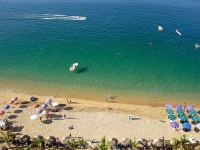
Photo credit: Andrew Gatt
Shopping in Acapulco
One of the pleasures of a holiday in Acapulco is shopping for souvenirs, of which there is a plentiful, varied selection gathered from all over Mexico. Handmade leather goods, locally made textiles, beautiful pieces of silver jewellery, bright and lovely ceramics, and even inspiring paintings by local artists are just some of the things on offer in the markets, stores and beachfront stalls. The older areas of Acapulco have a number of well-priced tailors and quaint souvenir shops. A good spot to indulge in some bargain hunting is the open-air artisan's mall opposite the Plaza Bahia, where it is possible to do a little haggling for arts and crafts. The native-made goods may be appealing, but just as desirable for avid shoppers are the many upscale boutiques selling well known designer labels which pepper the streets of the Zona Dorada (Golden Zone), also dubbed Mexico's 'Sunset Boulevard'. As far as modern malls go, Acapulco's biggest, complete with food court and cinemas, is Le Gran Plaza, situated on the Costera.
Dining in Acapulco
Acapulco's scenic setting around a picturesque bay allows for some magical and romantic dining opportunities in a multitude of restaurants while on holiday. Cuisine of all sorts is on offer, the quality generally very high and the prices reasonable. Some of the best restaurants use a fusion of styles and cuisines to create something unique and special, like the Kookaburra, with its spectacular terrace views of Acapulco Bay, creating delicious French dishes prepared with Mexican ingredients. Mexican seafood is a top favourite with visitors, a fact well exploited by most establishments, like the El Amigo Miguel off the main town square, where delicious shrimp and grilled red snapper medleys are specialities of the house.
Activities in Acapulco
Flashing lights, pumping music and boundless energy are the characteristics of Acapulco's frenetic nightlife, which centres on the clubs and discos of the main strip and Las Brisas. Clubs like the renowned Palladium, where the legendary 'silver man' fire dancer performs in the early morning hours, make Acapulco a hot favourite destination for young spring-break revellers from the USA. Those looking for a more Latin experience head down to Ninas, a traditional Mexican salsa club where the locals burn up the dance floor. For visitors interested in seeing some authentic Latin American Salsa dancing, head to Salon Q, 'the cathedral of salsa'. Disco Beach on Costera Aleman is well known for its popular Friday night foam parties. Mandara up on the side of the mountain, with its panoramic views of Acapulco by night, is one of the best places to end your evening and wait for the sun to rise before another day on the beach. Most of the dance clubs open at 11pm, close at 6am, and charge a fairly steep entrance fee, but this often includes 'all you can drink'. Those taking a break from dancing can enjoy bar-hopping along the Costera, which is lined with numerous exuberant open-air watering holes.
Things to be aware of in Acapulco
There is often an oily layer on the seawater of Acapulco from the use of jet skis. Visitors to Acapulco are strongly advised to avoid the resort during America's spring break in mid-March as hoards of student revellers descend on Acapulco for spring break mayhem and partying.
Matagorda
Overview
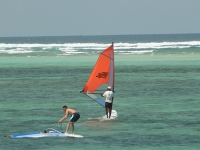
Photo credit: dougwoods
Shopping in Matagorda
Holidaymakers can take full advantage of the fact that Puerto del Carmen, Lanzarote and the rest of the Canary Islands enjoy a special duty-free tax status. Cigarettes, alcohol, perfumes and petrol are much cheaper than in mainland Spain and the rest of the EU. Matagorda has a two-storey shopping centre containing a supermarket and souvenir stores, but for a real shopping spree holidaymakers prefer to descend on neighbouring Puerto del Carmen, which is bristling with a variety for shops from duty-free electrical stores and designer boutiques to stalls selling 'tourist tat' such as beach buckets, spades, umbrellas and souvenirs along the main strip. The nearby town of Teguise hosts a vibrant Sunday market, which is fun to visit.
Dining in Matagorda
Most of Matagorda's restaurants are situated in the central commercial area around a square, where holidaymakers can browse the displayed menus before deciding on their preferred cuisine for the evening. The choice is wide, ranging from Chinese and Greek to British and Japanese, with the usual pizza, pasta and grill houses thrown in. Most visitors rate it as a plus that Matagorda lacks the presence of 'PRs', reps or touts trying to lure diners into their establishments. Those who want a more extended choice or a livelier dining scene can simply take a walk or taxi ride to explore the nightlife and restaurants of larger Puerto del Carmen.
Activities in Matagorda
Holidaymakers will find that although Matagorda is not lacking in waterfront pubs and bars, most offering some form of evening entertainment, generally nightlife in Matagorda is rather low key. Younger visitors looking for a taste of nightlife in Spain or a more vibrant night out opt to travel a short distance to the rollicking clubs and bars of 'The Strip' in neighbouring Puerto del Carmen.
Things to be aware of in Matagorda
Holidaymakers seeking bargains in Matagorda in electrical and photographic goods must be cautious and check their purchases before leaving the shop/stall. Many visitors have been ripped off. It is prudent to ensure that the guarantee on electrical items is a Worldwide or European guarantee as unscrupulous shops may try to sell products with only Asian guarantees to European visitors.
Aswan
Overview
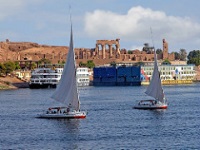
Photo credit: Dennis Jarvis
A picturesque city, Aswan's attraction as a holiday destination lies not so much in its historical sites, as in the peacefulness of a felucca cruise at sunset, a visit to the colourful market (Sharia el-Souq), or dinner at one of the floating restaurants on the Nile. Aswan is a perfect base from which to visit the magnificent Sun Temple of Ramses II, Abu Simbel, which is one of the most famous attractions in Egypt.
Shopping in Aswan
There is plenty of shopping to be done in the various markets of Aswan, from looking for shoes and clothes to seeking out choice jewellery and leather goods. Sharia as-Souq is a popular market in Aswan, where the touts have a reputation for being less pushy than in most of Egypt. Haggling is the best way to get the cheapest price, and it is wise to be cautious when buying jewellery, as many fake pieces can be mistaken as authentic.
Dining in Aswan
There is endless appeal in dining on the edge of the Nile. Aswan fully capitalises on this with numerous riverfront restaurants and even floating restaurants. There is traditional Egyptian fare available of course (and Egyptian fare tends to be cheap and plentiful) but also a lot of international cuisine. The 1902 Restaurant, in the Old Cataract Hotel, is reminiscent of an ancient tomb and serves French cuisine and local fish. It played host to such dignitaries as Winston Churchill and King Edward VII's brother on its opening night and is still one of the top restaurants in Aswan.
Activities in Aswan
Aswan's nightlife can't compete with Cairo or Luxor's, but there is plenty of fun on offer nonetheless. Night shows are popular in the city and the dramatic light and sound shows are a good introduction to Egyptian folklore and history. There are regular live music performances on offer and night cruises on the Nile also make for lovely after-dark activities. There are many more conventional nightlife options though, with bars and pubs and even the odd disco to investigate.
Things to be aware of in Aswan
Aswan can become quite touristy and overcrowded during peak season.
Limassol
Overview
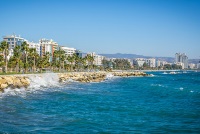
Photo credit: Sergey Galyonkin
Today, it's Cyprus's second-largest city with around 200,000 inhabitants. Many people travel to Limassol to enjoy its lovely beaches, sidewalk cafes, and lively nightlife. Visitors can take an evening stroll on the seafront Akti Olympion, followed by a visit to a traditional bouzoukia tavern for live music. The Old Town radiates from the fishing harbour, with narrow streets lined with shops and boutiques.
The foothills of the Troodos Mountains lie north of the city and offer charming country walks that meander through friendly villages. A quick drive to the Kourion, only nine miles (15km) away, also offers historic sites such as the House of Achilles, the Altar of Apollo, and Curium Beach.
Shopping in Limassol
Travellers in Limassol looking to satisfy their urge to splurge will be pleased to know that there is plenty to whet their appetite when it comes to shopping. There are, of course, the ubiquitous western-style shopping malls where stores such as Debenhams and Carrefour will cater to their every need.
The main shopping areas in Limassol are on Agiou Andreou Street and Makarious III Ave, where everything from clothing and footwear to leather goods and jewellery can be found. Travellers can head to the cobbled streets of Ayios Andreas and Anexartisias for a more historic and traditional atmosphere of trendy little boutiques and specialist stores that line the streets and lanes away from the modern city.
They should also bargain at the local markets that take place every Saturday and scoop up some great buys. Best buys in Cyprus include sea sponges and loofas, and these are available at most tourist shops and markets, though shoppers should be prepared to splash out on these bathing accessories. Another great buy is Lefkara Lace and other lace products. However, for real shopaholics, the centre of Nicosia is the best place to spend a day indulging in the local wares and goods.
Dining in Limassol
Restaurants are varied in Limassol and there is something for everyone. Everything from expensive tourist traps to places popular with locals is on offer. Both moussaka, an eggplant and potato-based dish, and kleftiko, a traditional hearty lamb meal, are ubiquitous, as too is the simple and affordable kebab. There are budget establishments and more upmarket venues, while western chains such as McDonalds, KFC, and Burger King are all present.
Things to be aware of in Limassol
Those who are looking to explore ancient ruins and learn about the fascinating history of Cyprus may be disappointed when travelling to Limassol. It's more renowned as a holiday destination of lovely beaches, buzzing nightlife, and luxury resorts, though those who remain interested in the country's intriguing past can visit places such as the acropolis of Kourion.
Coral Bay
Overview
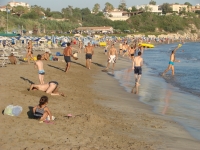
Photo credit: TomasNY
There's something for everyone, with boats lazily drifting across the sea, jet skis flying over the waves, and scuba diving trips to discover the secret world beneath the blue surface of this Blue Flag beach. On dry land, visitors can be equally pampered at the various coastal hotels or explore the surrounding landscape on various hikes and excursions around the Akamas Peninsula.
For those who are more culturally inclined, there are many ruins to explore that illustrate the rich ancient history of nearby Paphos. Roman villas are begging to be discovered while the large necropolis of the Tombs of the Kings should always be on the bucketlist when travelling to Cyprus.
Shopping in Coral Bay
Shopping in Coral Bay is not about sprawling shopping malls and extravagant boutiques. Instead, retail therapy is confined more to the charm and magic of small arts and crafts stores, and traditional markets.
Dining in Coral Bay
There are numerous restaurants and eateries in and around Coral Bay, with dishes sure to oblige every palate. Whether it's the fresh seafood found at Molos or the unique interiors of the Armonia Restaurants, there's a veritable feast of options and guests will be satisfied with the glut of both local and international menus. Various bars offer ideal cocktails and beverages to watch the sun set on the gorgeous Mediterranean waters. One may feel transported to another time and place, whether it's on the broad terraces of the Dionyssos Bar or socialising in the Odyssey Bar and Nightclub.
Activities in Coral Bay
There isn't much of a nightlife in Coral Bay, but what is available sits mostly on Coral Bay Avenue, affectionately known as 'The Strip'. Bars stay open quite late, with closing time sometimes well after midnight. While there aren't massive parties, entertainment is still varied and enjoyable, ranging from traditional Cypriot music to modern dance shows and band sets.
Things to be aware of in Coral Bay
Those wishing to learn about and discover the ancient history of Cyprus won't find it in Coral Bay. Indeed, this resort is all about Mediterannean fun in the sun, coupled with luxury and relaxation. However, the city of Paphos is only 6km away and contains the Paphos Archaeological Park, complete with the necropolis called the Tomb of the Kings, as well as the acropolis of Kourion.
Paros
Overview
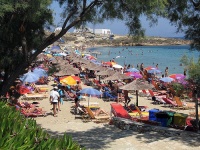
Photo credit: Allan Henderson
Paros' many ferry connections are perfect for exploring famous islands and attractions nearby, such as Antiparos, which has an interesting chapel cavern and more lovely beaches.
Shopping in Paros
Paros was famous during the Classical Age for the white marble quarried within its borders. Today, souvenir hunters may find some beautiful marble work on the island, as well as shells, leather work, embroidery and wooden sculptures. Parikia is the best place for shopping on the island and has the usual tourist shops and grocery stores, and lovely art in the town's galleries.
Dining in Paros
While Paros has a good variety of places to eat out, the best establishments are traditional and seafood is often the best choice. Visitors can easily find a place to smash plates with locals if the mood takes them.
Activities in Paros
Though Paros is too relaxed for its nightlife to compare to destinations such as Mykonos, its summer season is fairly action-packed. Bars, clubs and traditional Greek music and dancing are on offer, and Naoussa village and Santa Maria Beach are particularly popular for their party scenes.
Things to be aware of in Paros
Paros can get very crowded and may not suit those seeking peace and relaxation.
Bandos
Overview
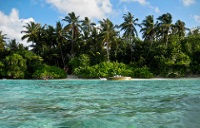
Photo credit: Shayan Sanyal
There is plenty to do in Bandos for active holidaymakers, including scuba diving, sailing, windsurfing, and game fishing. The resort has facilities that include tennis and squash courts, swimming pools, saunas, gyms, and a salon and spa.
The nightly entertainment is perhaps not lively enough to satisfy younger vacationers looking for a party. Yet Bandos is a great destination for romantic getaways and honeymoons and hosts weddings frequently. It's both peaceful and beautiful, making it ideal for families too.
Shopping in Bandos
Bandos has a boutique outlet, a souvenir shop, and a jewellery store at the resort. Visitors should be able to find all they need for their stay but the shopping is still limited. Those who want to experience the Maldivian markets should take a boat ride through to Malé where there are ample shopping opportunities and souvenirs will be far cheaper than at the resort.
Dining in Bandos
Bandos has several good restaurants, from buffets to 24 hour eateries. There are also several bars which serve seafood, snacks, and drinks, made all the more special because visitors can dine under the stars. For those with a more discerning palate, there are even some marvellous fine dining restaurants for those special occasions. The restaurants cater for all dietary needs, although guests are encouraged to inform the resort of their special needs before their arrival to ensure that they are well catered for.
Activities in Bandos
Nighttime entertainment is limited at Bandos, which caters mainly to couples and those seeking a peaceful island retreat. There are nightly events like karoake, live music concerts, buffets on the beach, cultural shows, traditional dance lessons, discos, and movie screenings, but there is no clubbing scene. Those looking for a party on holiday would have a better time elsewhere.
Things to be aware of in Bandos
Bandos is primarily a family resort and some guests complain that the children at the resort can be disruptive.
Zakopane
Overview
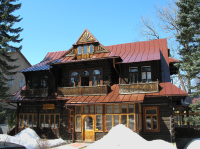
Photo credit: Mathiasrex
Shopping in Zakopane
Shopping in Zakopane is centred on the main street, Krupowki, which is lined with restaurants, shops, stalls and street performers, creating a fun, traditional atmosphere. Popular souvenirs include items such as oscypek (smoked goat's cheese) and ciupagas (long, thin traditional axes). There are plenty of ski stores where visitors can buy or hire equipment before hitting the slopes.
Dining in Zakopane
Zakopane boasts a variety of restaurants and there should be something to cater to all budgets and tastes. Tuberoza, which serves up traditional eastern European fare on Pilsudskiego street, is one of the most popular restaurants in the town, and the Trattoria Adamo offers a tasty range of Italian food. There are plenty of fun bars for après ski drinks.
Activities in Zakopane
Zakopane has a vibey nightlife with numerous bars and a few great dance clubs. Some of the night spots are uninspiring tourist traps but the big clubs attract party people from as far away as Warsaw. Krupowki street is the main drag, but it is worth exploring a bit to find less touristy options.
Things to be aware of in Zakopane
The popular ski slopes can get crowded and the ski lift infrastructure is rather old-fashioned.
Skiing in Zakopane
Zakopane's slopes are fast becoming legendary within Europe's skiing and snowboarding community. Featuring good snow conditions, splendid views and a real youthful energy among its staff members, your experience at Zakopane is guaranteed to be fun and rewarding. The most popular slopes at Zakopane ski resort are Kasprowy Wierch, Nosal and Gubalowka, and tourists are warned that they will be better off purchasing their ski passes in advance, to avoid long queues on the popular downhill courses. The slopes are best for beginners, with a number of ski schools operating, but there are a few rewarding runs for the more advanced. Cross country skiers will be delighted with the picturesque trails in the forests surrounding the town.
Garmisch-Partenkirchen
Overview
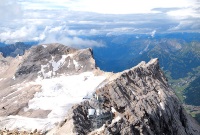
Photo credit: Tiia Monto
Shopping in Garmisch-Partenkirchen
There are more than 450 shops in Garmisch-Partenkirchen, including some trendy boutiques, sports equipment outlets, and plenty of tourist shops selling local handcrafts like traditional Bavarian costumes. Visitors should not struggle to find souvenirs and anything else they might require on a ski holiday.
Dining in Garmisch-Partenkirchen
Garmisch-Partenkirchen is consistently ranked highly for its restaurants, bars and nightlife and the resort is full of charming German architecture and has an old-world feel which makes it atmospheric. There's a lot to choose from for apres-ski drinks and socialising and there are facilities to entertain teenagers and children as well.
Things to be aware of in Garmisch-Partenkirchen
Some of the ski lifts are a bit old but generally the facilities are good.
Skiing in Garmisch-Partenkirchen
Garmisch-Partenkirchen is not the best place for novices, but intermediate and advanced skiiers will find plenty to enjoy with both classic and glacial runs in the area. There are about four black pistes, 25 red pistes, 10 blue pistes and three green pistes to enjoy and with pistes above 2,500 metres snow is assured throughout the season.
Kuramathi
Overview
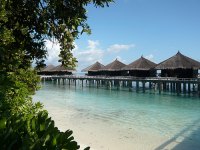
Photo credit: flickrtickr2009
Shopping in Kuramathi
Kuramathi is one of the larger Maldives resorts and has more in the way of shops and facilities than the smaller resorts. There are a few boutiques on the island where visitors can buy souvenirs and gifts and indulge in a bit of retail therapy.
Dining in Kuramathi
Kuramathi has three main buffet-style restaurants, some á la carte restaurants and six bars. There is also a coffee shop and the option of dining privately on the beach or in a pavilion. The range of cuisine should cater for all dietary needs and preferences.
Activities in Kuramathi
This large resort has more in the way of nightlife than many other resorts in the Maldives, with lots of nightly entertainment in the various bars and restaurants. Kuramathi hosts beach discos under the stars, a lot of live music concerts, and fun activities like movie nights. There is plenty of opportunity for socialising should you so desire, but it is also possible to get away from the organised entertainment if you want a more peaceful and private experience.
Things to be aware of in Kuramathi
Kuramathi generally receives rave reviews from guests, but it may be too big and crowded a resort for those seeking privacy and romance.
Equator Village
Overview
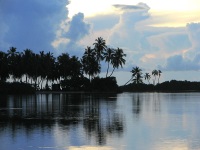
Photo credit: Hussain Didi
The main resort, Equator Village, offers a variety of watersports including scuba diving, deep sea fishing, sailing, and snorkelling, and a number of land-based activities like squash, tennis, bicycling, volleyball, and more. The resort has a coffee shop, disco, and spa. What sets Equator Village apart is its unique cultural aspect.
Shopping in Equator Village
There is a souvenir shop outside the hotel but Equator Village is not a shopping destination. Those keen to trawl the local markets can ask for advice on where to go at the reception, and enjoy an authentic Maldivian shopping spree.
Dining in Equator Village
Although very scenic, this resort doesn't have the culinary scope of many of the luxury resorts in the Maldives. There is one main restaurant which serves international staples and various Asian cuisines, and room service is only available if guests are sick. There is also a bar which is perfect for relaxing cocktails.
Activities in Equator Village
Like the restaurant scene, the nightlife at Equator Village is simple and understated, the main entertainment consisting of a disco dance once a week.
Things to be aware of in Equator Village
Equator Village is not a luxury resort and gives more of a taste of the 'real Maldives' than most, which appeals to some visitors and displeases others.
Dahab
Overview
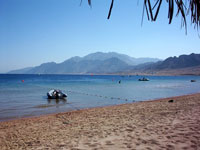
Photo credit: SailorInTO
Dahab lies on the deepest section of the Great Rift Valley that extends down through Africa, making for dramatic underwater scenery with steep drops, valleys and canyons. Most of the diving is accessed from the shore, reached by taking a pick-up truck to the beaches stretching in either direction of the town. Some of the superb diving and snorkelling sites nearby include the Blue Hole, one of the best in the Sinai region, and the Canyon, but only TEC-divers are allowed to dive the deeper sections of such formations.
Shopping in Dahab
Travellers should bargain hard to get classic Egyptian souvenirs such as hookahs, carpets, lamps, cotton shirts and silver jewellery. They should also watch out for papyrus paintings made from banana leaves. In general it's best to settle on 50 percent of the opening price and, if in doubt, stroll to the next stall where they will most likely sell the same merchandise. Bedouin handicrafts such as embroidered fabrics are good buys in Dahab. A good place to pick up general supplies is Ghazala Supermarket at the southern end of Masbat.
Dining in Dahab
Dahab has a wide range of good quality yet inexpensive restaurants. Seafood is the key ingredient, freshly caught and served simply. The Bedouin-style restaurants on the beach are very popular as guests sit at low tables with cushions close to the sand.
Activities in Dahab
Dahab is not really known for its raucous nightlife. Most evenings are spent by the waterfront restaurants, or in the resort bars where live Bedouin music is common.
Things to be aware of in Dahab
The Blue Hole is considered one of the most dangerous dives in the world and unless the diver has completed technical dive training it should not be attempted. Travellers should watch out for scams relating to accommodation and transport. Taxi drivers routinely overcharge so it's always best to agree on a price before departure. Although Dahab is considered safe, the Sinai region outside of the major resorts can be dangerous.
Golf del Sur
Overview
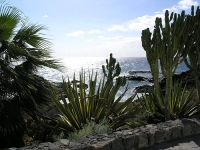
Photo credit: Michel;n
Shopping in Golf del Sur
Like everything else at the resort the shops are dominated by golfing needs, but San Blas has some interesting shops, and the large and popular neighbouring resorts also boast all the usual souvenir shops and holiday boutiques.
Dining in Golf del Sur
Restaurants in Golf del Sur and San Blas include some traditional Canarian eateries and plenty of international fare for foreigners. While in Golf del Sur, holidaymakers should be sure to taste the culinary pleasures of The Lobster Pot.
Activities in Golf del Sur
Golf del Sur is not a party resort but it is a lively one with some great bars and one nightclub, Taboo's, which plays a mixture of dance and house music and is frequented by a refreshing variety of people. The golfing clubhouses also do a booming trade, especially in the peak summer months.
Things to be aware of in Golf del Sur
Planes taking off and landing at the nearby Tenerife South Airport can be a bit noisy for visitors.
Bretton Woods
Overview
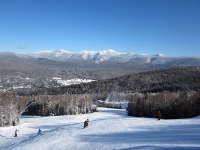
Photo credit: Storylanding
Shopping in Bretton Woods
Bretton Woods' shops cater to visitors' every need. Whether it's golfing gear, snowboarding or skiing apparel that's been forgotten and needs purchasing or just memorabilia, it's not hard to find at the resort. TreeTop Sports has everything any sports man or woman may need when out on the slopes, and much more. There are shops for essential items too.
Dining in Bretton Woods
There are a variety of dining options for those visiting the resort. Restaurants such as the Latitude 44 Restaurant, the Slopeside Restaurant and Pub, and Lucy Crawford's Food Court are all popular choices as they are located in the Bretton Woods Ski Area. Further out at the Omni Mount Washington Hotel is Stickney's Restaurant, which is a great place to enjoy a meal after a day of activity. Booking at Stickney's is essential.
Activities in Bretton Woods
As there is no real town in Bretton Woods, there are limited apres ski offerings and those available are focused in the hotels, particularly the iconic Mount Washington Hotel, which is nearby and hosts events and activities for all ages.
Things to be aware of in Bretton Woods
There are limited apres ski offerings at Bretton Woods, which may be a disappointment for those looking for entertainment throughout the evenings.
Skiing in Bretton Woods
The 464-acre park of Bretton Woods has a total of 102 trails with nine lifts, making it an incredibly large resort capable of satisfying visitors' skiing needs. The trails are fairly evenly mixed for all skill levels, with great facilities for beginning skiers.
Sinaia
Overview
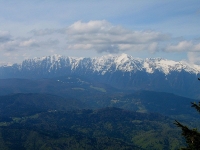
Photo credit: Gabriel
The Sinaia ski resort has more than 20 ski slopes served by nine ski lifts. The longest ski slope is two and a half kilometres. The resort offers great skiing, for beginner, intermediate and expert skiers; there are six blue runs, four red and 11 black. The highest ski slope starts at an altitude of 6,500 feet (2,000m), while the lowest one starts off at 2,800 feet (850m) above sea level. Sinaia ski lifts operate from 8:45am until 4pm on every day of the week except Mondays. Ski equipment is available for renting at Sinaia for those that do not have their own equipment. Using the ski lifts costs two euro and skiers have to purchase all their tickets at the start of their day on the slopes. The resort also boasts other attractions such as a 17th-century monastery with original frescoes, and the small Pelisor Palace.
Shopping in Sinaia
Shopping in Sinaia is limited to a selection of handicraft, jewelry, souvenir and clothing stores. The town has a selection of open air markets where tourists and holidaymakers can shop for mementos and trinkets. For visitors taking a break from the slopes, head to the Monastery Open Air Market, the Peles Castle Marketplace or the Democracy Market, which all sell a selection of handmade goods, souvenirs, postcards and artisan objects. The town also has a number of food markets, such as Unirii Market and the Monastery Open Air Market, which are great for photographic opportunities or a quick snack. Shoppers can also choose from the small boutique shops scattered throughout the town.
Dining in Sinaia
Sinaia has a selection of restaurants ready to cater to the many skiers and sightseeing visitors to the town. Most of the restaurants are concentrated in the central area of the town, although there are one or two eateries a short walk from the centre. Bistro La Teleferic is great for a warm meal after a day on the ski slopes while the unique Forest Restaurant cascades down the hill behind the Ioana Hotel. Cucina Sofia offers excellent Italian food, while Taverna Sarbului has a great selection of local Romanian cuisine.
Activities in Sinaia
Nightlife in Sinaia tends to be concentrated around Casino Maxim. The Casino was built 1912 and designed by architect Peter Antonescu. It has a selection of gambling facilities as well as a bar. There are also a couple of pubs in the centre of town. Visitors can drop in at the Old Nick Pub for a post-slopes drink or the Irish House for a Guinness. The main street through the centre of town also has a selection of nightclubs and late night drinking spots.
Things to be aware of in Sinaia
One of the only negatives associated with Sinaia is related to skiing. The Sinaia ski resort still uses an antiquated and impractical method of paying for ski passes. Visitors must buy all their tickets at the beginning of the day and hand in one ticket each time they use a ski lift. This involves guessing how many times you will use the ski lifts in one day. Also, keep in mind the ski resort does not offer as many modern conveniences as those in Western Europe.
Skiing in Sinaia
Sinaia offers excellent high-altitude skiing opportunities, situated at an elevation of 6,500 feet (2,000m). The slopes can be accessed from town via a cable car to Cota 1400, and then by cable car or chairlift to Cota 2000. The pistes at Sinaia are located on two sides of the mountain, with the most difficult (and spectacular) slopes on the east side toward the city. The west side, facing Sun Valley, has runs well-suited to beginner and intermediate skiers. Sun Valley also has some good cross-country skiing trails, originating from the Dorului Hut at the end of the chairlift line. The ski season in Sinaia starts in December and can last until May, though snow is often unreliable toward the end of the season.
Nissaki
Overview
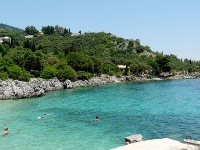
Photo credit: anybookers
Shopping in Nissaki
Nissaki has a couple of gift shops and supermarkets. Visitors will find a wider choice of shopping at the nearby resorts of Kassiopi or Ipsos, which are only a short bus trip away.
Dining in Nissaki
There are a handful of great family-run restaurants that serve tasty local dishes. Visitors can expect good service and a warm welcome.
Activities in Nissaki
There are a few tavernas within the village. Visitors who want a livelier evening can head to the larger resorts of Ipsos or Kassiopi, which are a few miles away.
Things to be aware of in Nissaki
Travellers who want a livelier nightlife may prefer one of the larger resorts in Corfu.
Banyan Tree
Overview
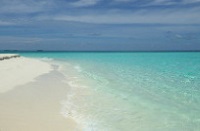
Photo credit: Laika AC
Banyan Tree is an eco-friendly resort, and offers marine biology and conservation lessons in addition to more conventional activities like dolphin safaris, spa treatments, canoeing, sailing, fishing, waterskiing, and windsurfing. A quiet and secluded resort, Banyan Tree doesn't offer much in the way of nightlife, but has some child and family-friendly programmes. It primarily attracts couples looking for a romantic retreat.
Shopping in Banyan Tree
Banyan Tree has a shopping gallery which works in partnership with locals to offer visitors beautiful souvenirs, including things like aromatherapy oils, ceramics, clothes, and hand-crafted goods. The shopping is limited but the goods are of a high-quality. Those who want to go on real Maldivian shopping sprees should take excursions to Malé to enjoy the sprawling markets of the capital.
Dining in Banyan Tree
Banyan Tree offers a number of dining options, including a selection of private dining treats that allow guests to eat romantically on the beach or at their villa. At the main restaurant, there is local Maldivian fare and quality international cuisine to enjoy, while fresh seafood dinners are always available.
The open-air bar serves divine cocktails, light meals and snacks. All dietary needs are accommodated, and if you have special needs it is best to notify the resort in advance to be sure they cater for you properly.
Activities in Banyan Tree
Banyan Tree hosts weddings and themed parties for guests upon request and the resort can hustle up a lovely festive atmosphere, but generally Banyan Tree is not known for its nightlife. Those in search of a clubbing scene or raucous party resort will be disappointed. Sunset cruises, live music concerts, and traditional dancing nights are held regularly and the night-time entertainment is fun and laidback.
Things to be aware of in Banyan Tree
Request rooms away from the bar and closer to the dive centre, which is the quieter side of the resort.
Attitash
Overview
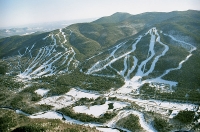
Photo credit: Attitashmountain
Shopping in Attitash
Attitash has a few good shops to enjoy, but for those in search of some ski or snowboarding apparel, they need not look further than Attitash Sports, which is a full-service ski shop offering jackets, snowpants, helmets, goggles, backpacks, and much more. There are two Attitash Sports shops, one in the Main Base Lodge, their flagship store, and another at the Adventure Center. Visitors need not worry should they forget their gear, Attitash has them covered.
Dining in Attitash
There are a few restaurants to choose from, although there is a greater selection of restaurants and meal options a mere 15 minutes away in Jackson or North Conway.
Activities in Attitash
Apres ski options in Attitash are fairly limited, though there is the Ptarmigan's Pub, which offers two full bars, dining, and live music every Saturday afternoon.
Things to be aware of in Attitash
Apres ski options are limited and serious party animals might be left disappointed.
Skiing in Attitash
The runs are fairly evenly divided between beginner, intermediate and advanced, meaning they cater to skiers of all skill levels. Snowboarders will enjoy the terrain park, which has over 1,700 feet (518m) of ramps, jibs, table tops and air hits, and 10 rails.
Lindos
Overview
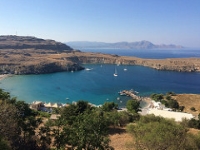
Photo credit: tracy the astonishing
Shopping in Lindos
Lindos is a labyrinth of winding, picturesque streets, where visitors can get happily lost for hours browsing quaint little shops. The area is great for souvenir shopping and some simple resort stores cater to tourists.
Dining in Lindos
Lovely rooftop bars and restaurants characterise the town's dining scene, and sunset meals are a must. Restaurants cater to a number of tastes and budgets.
Activities in Lindos
Lindos has many bars though the party scene is toned down. Visitors who prefer peaceful, music-filled nights will enjoy themselves.
Things to be aware of in Lindos
Younger travellers who are set on partying may be disappointed by the fairly sedate nightlife. The area can get very crowded in summer, like all popular Greek resorts.
Rhodes Town
Overview
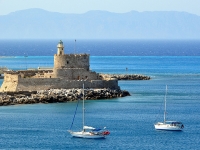
Photo credit: xlibber
Shopping in Rhodes Town
Rhodes Old Town offers some exciting shopping, with the area's charming old streets complementing the traditional wares on offer in shops and stalls. Traditional jewellery and pottery, antique goods and modern souvenirs are popular purchases, as are foodstuffs such as good Greek wine and traditional Greek olive oil. Rhodes New Town has plenty of high-end and designer shops.
Dining in Rhodes Town
Visitors will find everything from the quaintest traditional eateries to Starbucks, and can indulge in fine dining or keep things budget-friendly.
Activities in Rhodes Town
This is one of the most popular islands in Greece and its rich nightlife features bars, dance clubs and bouzouki clubs, particularly in Rhodes New Town. Faliraki resort also has a famous party scene and is very close to Rhodes Town. Its atmospheric Old Town has many great restaurants and venues offering traditional entertainment.
Things to be aware of in Rhodes Town
Rhodes Town gets crowded during summer. It's also infamously labyrinthine, so navigation can be a little confusing.
Cala San Vincente
Overview
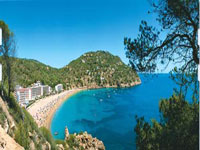
Photo credit:
Shopping in Cala San Vincente
There is not much in the way of shopping on offer in Cala San Vincente besides the basics, but the nearby town of Pollensa offers a greater selection and a lovely Sunday market, as well as several historic buildings. There are also regular buses to Inca and Puerto Pollensa.
Dining in Cala San Vincente
Cala San Vincente is one of the smallest resorts on the island and also one of the most resiliently authentic. Tourism doesn't seem to have had much of an impact on the village and the selection of restaurants is not impressive. However, there are some charming local eateries and seafood restaurants, and some of the hotels have good restaurants.
Activities in Cala San Vincente
There is no nightlife to write home about, and after-dark entertainment is mainly limited to drinks and dinner. This tranquil atmosphere will delight some but won't suit those in search of a party.
Things to be aware of in Cala San Vincente
Cala San Vinvente offers little in the way of amenities for children. There are few places to shop without going to neighbouring resorts.
Cocoa Island Resort
Overview
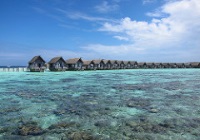
Photo credit: William Woon
A host of other recreational activities can be enjoyed on the island, including yoga, meditation, hiking, and more. A fairly small resort on a private island, Cocoa has 33 suites built above the water. The resort is most popular for couples and small groups of adults, but it does welcome families as well.
Shopping in Cocoa Island Resort
There are no real shopping facilities at the resort, just the bare minimum of souvenirs and local handicrafts. The Maldives aren't really a popular shopping destination and if guests want to go on a spree the only real place to do it is in the capital, Malé, which is conveniently close to the Cocoa Island Resort.
Dining in Cocoa Island Resort
Cocoa Island has a fine-dining restaurant, a good bar, great room service, and allows guests the option of dining romantically on the beach. Although the resort doesn't have the variety of restaurants that some others do, the food is of a high-quality and shouldn't disappoint.
Activities in Cocoa Island Resort
Cocoa Island is not a party destination and the nightlife is limited. Each villa has speakers and a dock for music so guests can listen to music to their heart's content. There are some live music and dancing events for evening entertainment.
Things to be aware of in Cocoa Island Resort
If you are travelling with kids, be sure they are competent swimmers because the accommodation on Cocoa Island is all directly over the water. There is no real nightlife to speak of.
Mount Washington
Overview
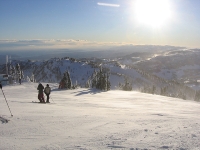
Photo credit: Marcin Chady
The resort is also set in a spectacular location, looking out across the Strait of Georgia with vistas of the Sunshine Coast and the peaks of the Coast Mountains. Nearby Comox Valley hosts many of the holiday visitors to Mount Washington in its variety of hotels, motels and B&Bs, all of which offer special ski packages during winter months. The ski resort is located 20 miles (32km) northwest of Courtenay on Vancouver Island, about three hours' drive from Victoria.
Shopping in Mount Washington
Shopping in Mount Washington is very limited, with only a few stores at the resort concentrating on general goods and sporting supplies. Those in search of fashion brands and luxury items may be disappointed.
Dining in Mount Washington
There are a few restaurants in Mount Washington, with options including sushi, sandwiches, steaks, burgers, and other mainstream fare. Be sure to try the local coffee from Beavertails, which is renowned.
Activities in Mount Washington
Mount Washington doesn't have much of a nightlife, with only two or three bars to choose from. These venues can get busy on weekends but overall the resort is geared more toward families than young singles looking for a party.
Things to be aware of in Mount Washington
Mount Washington is a small resort with no real village, so there is a lack of shopping, restaurant, and nightlife options.
Skiing in Mount Washington
Mount Washington is one of Canada's best ski resorts in terms of the runs available, with its nearest competitor being Whistler on the mainland. It is known for reliable snowfall, with an average of 30 feet providing a blanket of powder to glide on. The resort has slopes catering for a range of difficulties, varying from gentle beginner runs to challenging black diamonds and professional runs.
Koh Lanta
Overview
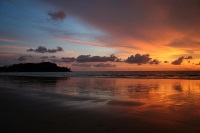
Photo credit: Steven Belcher
The island is a great place for travellers looking for a beach holiday away from the parties and crowds of Phuket, and is popular with slightly older tourists who populate the resorts and bungalows that line the beaches.
There are plenty of things to see and do on Koh Lanta, including exploring the Khao Mai Kaew Caves on foot or elephant-back, visiting the orchid nursery farm at Long Beach (Pra Ae Beach), and sunning on the beaches of Klong Dao, Kor Kwang, and the beautiful Kantiang Bay. Visitors can also get a taste of the culture of Koh Lanta by visiting Lanta Old Town and the Sea Gypsy Village.
Shopping in Koh Lanta
Koh Lanta is not as popular with shoppers as perhaps Bangkok or Phuket, but all the essentials travellers need and more are available on the island. The most popular shopping spot on the island is the night market near Saladan pier. This market sports everything from locally made clothes to delicious treats out of a hot wok. Many cafes and small shops cater for quick purchases and street vendors are popular around the pier for curios and trinkets. Travellers will also find the odd bargain on locally produced goods.
Dining in Koh Lanta
A fairly large island compared to many of the southern Thai outcrops, Koh Lanta has a good variety when it comes to restaurants. From the luxurious eateries in the top resorts, to the lonely street vendor operating from their mobile cart, the food around Koh Lanta is delicious no matter the location or facility. It seems that everyone is a chef on Koh Lanta, as around every corner one finds a sizzling wok cooking beautifully fresh ingredients or blending together some of the islands freshly picked mangoes, bananas and coconuts for a brilliantly refreshing smoothie on those scorching tropical days. But Koh Lanta is not all about the street food, although it is almost always surprisingly good and remarkably cheap. The island also offers some very fine eateries that serve up both wonderful local and international cuisine. And the best thing about a good restaurant on Koh Lanta is that the view is more often than not a breathtaking vista of the bright blue Andaman Sea.
Activities in Koh Lanta
As one of Thailand's more 'family friendly' islands, Koh Lanta is not known for its all night parties, such as visitors might find on its near neighbour, Koh Phi Phi. However, this does not mean that Koh Lanta does not have any nightlife to speak of, as many of the beaches, including Phrae Ae (Long Beach) and Klong Dao, are lined with seaside bars that serve as perfect spots for a sundowner to watch the magnificent Koh Lanta sunsets, and often begin to come to life after dark. If visitors are looking for more of a club scene, Saladan Pier would be a good bet, as would various places along the northwest coast of Koh Lanta.
Things to be aware of in Koh Lanta
Although the roads are negotiable, the many potholes and dirt patches can be dangerous when exploring the island by scooter.
Big Bear
Overview
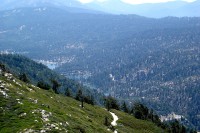
Photo credit: jcookfisher
Big Bear's two major ski resorts, Bear Mountain and Snow Summit, offer 33 individual pistes served by 12 ski lifts, and their position 4,920 feet (1,500m) above sea level ensures there is plenty of snow. There are a good variety of ski runs, especially for intermediates, and snowboarders are catered for with a terrain park featuring more than 150 jumps and 80 jibs.
Big Bear is also an all-around resort, however, drawing crowds keen on fishing, hiking, camping, mountain biking, boating, waterskiing and horseback riding. The city of Big Bear has family entertainment such as cinemas, bowling, and arcades, and offers a mix of restaurants and a buzzing nightlife to keep everyone entertained.
With so many attractions so close to the greater LA area, it's no wonder that Big Bear is Southern California's most popular ski resort.
Shopping in Big Bear
Shopping in Big Bear is certainly a must for anyone interested in a unique shopping experience. Travellers cn take a break from the slopes and spend an afternoon strolling around the town in The Village, the main shopping hub in Big Bear, browsing the collections of quaint boutiques, speciality stores and gift shops. Shoppers will find something to suit their taste in a space where art, decor, fashion and the natural environment are celebrated.
Dining in Big Bear
Big Bear offers a large variety of restaurants for any tired and hungry slope-enthusiast. With both gourmet and home-style options, every diner is satisfied by the many cuisine options including Chinese, Italian, Indian, Thai, American and more. The Captain Anchorage is very much an establishment, with patrons coming back for its good food time and time again. For those in search of dinner and a show, The Cave is the place to go for concerts, comedy and entertaining events scheduled throughout the year. With many places to choose from, visitors to Big Bear certainly won't go hungry.
Activities in Big Bear
Nightlife in Big Bear is comfortable and laid-back. Visitors won't find high-end clubs, only bars and restaurants offering entertainment. For anyone looking for a good time apres-ski, chances are Murray's Saloon and Eatery will provide it in the form of pool tables, karaoke and a well-stocked bar. Also firm favourites among visitors are Nottingham's Tavern as well as Whiskey Dave's. For good craft beer and a chance to unwind, The Big Bear Lake Brewing Company is also a firm choice, offering gastropub food and a comfortable, relaxed environment.
Skiing in Big Bear
Big Bear offers both skiing and snowboarding. Bear Mountain offers visitors the largest beginner area in the region and also more than ample area for advanced skiers and riders. The Silver Mountain and Bear Peak ensures some of the steepest terrain. The 200 acre 'winter playground,' as they like to call it, offers upwards of 130 beginner to advanced features. Snow Summit also boasts a magnificent resort of offerings, giving visitors an ideal experience if in search of a relaxed and laid-back skiing holiday.
Samoens
Overview
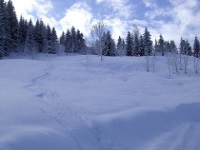
Photo credit: skiology
Dining in Samoens
There are more than 25 restaurants in this little resort, offering a variety of cuisines and ranging from expensive to budget.
Activities in Samoens
There isn't much nightlife to speak of in Samoens, but Covey's Irish Pub is popular with expats.
Things to be aware of in Samoens
As a smaller resort there are fewer skiing amenities and visitors cannot ski directly back to the village.
Skiing in Samoens
Skiiers of all skill levels will find something to suit them in Samoëns; the vertical rise is steep, which is great for the more advanced but there are gentler slopes for beginners and it is not a bad resort for families with varying skill levels. The longest run is the eight mile (14km) Les Cascades, a blue route from Grandes Platières to Sixt via the lovely Lac de Gers. Experts will enjoy the Gers bowl, with a 2,624 foot (800m) drop of untracked skiing. Eighty percent of the slopes are north facing, so they hold the snow well.
Baros
Overview
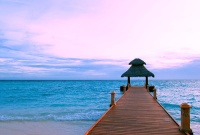
Photo credit: Nattu
There are a number of restaurants to choose from and while there is little in the way of nightlife, the resort is known for its excellent selection of wine. Activities in Baros include scuba diving and snorkelling, and the resort has its own spa.
Baros is an award-winning and perpetually popular boutique resort, great for couples looking for a peaceful island holiday. One of the things that sets Baros apart is the superb service from all the staff on the island, while the luxury villas ensure privacy and comfort.
Shopping in Baros
Baros has a small boutique selling souvenirs and local handicrafts but the shopping facilities are very limited on the island. Those keen on an authentic Maldivian shopping experience should take an excursion to the nearby capital to explore the colourful markets.
Dining in Baros
Baros has a range of dining options, all with very accommodating staff that pride themselves on being happy to prepare meals on request for guests. Baros boasts three restaurants and two bars and the resort is particularly proud of its fine-dining establishment. Apart from the great restaurants, guests are welcome to request private meals almost anywhere on the island, making the opportunities for romantic outdoor dining limitless.
Activities in Baros
Like many of the luxury resorts in the Maldives, Baros doesn't market itself as a party destination. Although fun social activities and cultural shows are organised regularly for the entertainment of guests, Baros is ultimately somewhere that people visit to enjoy privacy, peace, and romance. The island has a sedate nightlife.
Things to be aware of in Baros
The lack of nightlife may be a drawback for some and the resort doesn't really cater for children.
Adra
Overview
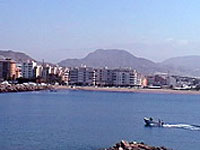
Photo credit:
Shopping in Adra
Apart from a couple of tourist shops selling suntan lotion and beach-themed souvenirs, there is no shopping to speak of in Adra. There are, however, frequent markets and the daily ritual of bargaining over the fishermen's catches. Those who fancy a shopping spree should make the short trip to Almeria.
Dining in Adra
Head to the tapas bars on Paseo de los Tristes in the town centre and along the beachfront. This is probably the tastiest and most authentic food in town. Restaurants are few and far between, and tend to be fairly expensive. Fresh seafood is the speciality. The cost of living in Adra is unusually low for Spain, and it is relatively cheap to buy fresh produce if visitors don't mind doing their own cooking.
Activities in Adra
Adra has no nightlife to speak of, although it is less than one hour away from Almeria where there are some clubs and bars for nighttime revelry.
Things to be aware of in Adra
Although for many the laid-back and down-to-earth atmosphere of this sleepy resort town is its main appeal, Adra can be a little quiet and uneventful for those holidaymakers looking for a party.
Nafplion
Overview
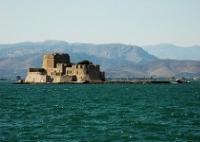
Photo credit: Pug Girl
Shopping in Nafplion
The old part of town has some delightful shops, where items range from touristic kitsch to elevated art. Visitors will enjoy searching the area for souvenirs. Nafplion also has several decent malls and grocery stores for self-caterers, and markets that offer local crafts and produce.
Dining in Nafplion
Visitors will find traditional Greek dishes at establishments along the bustling harbour or in the grand Venetian-style square called Plateia Syntagmatos. Other dining options include fast food and a variety of international cuisines.
Activities in Nafplion
Nafplion's vibrant nightlife has a fairly broad scene, meaning visitors can choose between partying and relaxing over sundowners or romantic meals. Some of the town's best establishments lie in the harbour area or perch dramatically on the cliffs.
Things to be aware of in Nafplion
Although it has been described as a prettier, cleaner and quainter version of Athens, things can get fairly chaotic in Nafplion during the summer months, particularly as it's a very popular weekend excursion for the Athenians themselves.
Hakuba
Overview
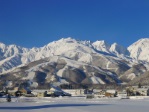
Photo credit: Ski Mania
It played host to the 1998 Winter Olympics as part of the Nagano prefecture, and some of the facilities are still in use, including the Hakuba Ski Jumping Stadium and the Hakuba Olympic Village Memorial Hall.
With a variety of après ski activities, Hakuba is a fun place off the slopes as well. There are a number of good restaurants serving both Western and Asian cuisine, and many hotels have relaxing hot spring baths. The main nightlife area in Hakuba is in Echoland.
Hakuba is also a popular summer resort and is a good place for outdoor activities like hiking, mountain biking, paragliding, rock climbing, and whitewater rafting. Day tours to Matsumoto Castle are a popular excursion.
Shopping in Hakuba
Although Hakuba has all the souvenir shops and gift stores and convenience stores that tourists might need for basic holiday shopping, it is not an impressive destination for big brands or fashion shopping and even the ski equipment shops are not exactly up-to-date with fashionable gear. Visitors should therefore not expect exciting shopping sprees, but will be able to enjoy some local crafts and produce and find some lovely souvenirs.
Dining in Hakuba
There are well over a hundred restaurants in the Hakuba Valley with plenty of traditional Japanese cuisine to sample and lots of international varieties as well. The best areas to seek out good food and ambience are Wadano Village, Echoland, and the area around Hakuba Station.
There are some upmarket restaurants for a tasty splurge or romantic evening but also plenty of wonderful budget eateries where visitors can enjoy simple and tasty Japanese food, international pub grub, and other Western favourites.
Activities in Hakuba
Hakuba boasts that it has the best après ski drinks scene and nightlife of all the ski resorts in Japan and there are indeed many bars, pubs and watering holes to choose from. The resorts in the area attract a young crowd as well as families and the atmosphere in the evening is often very festive and sociable. Those in search of a good party will probably find one. Echoland, Wadano, Happo, and Goryu all have numerous bars.
Things to be aware of in Hakuba
With so many options, the ski slopes can be a bit overwhelming and it may be difficult to find your way around in the beginning.
Skiing in Hakuba
Averaging 36 feet (11m) of snow per year, Hakuba is known for its reliable winter weather. The resort has more than 200 runs with a wide variety of difficulty, offering ample skiing options for beginner, intermediate, and advanced skiers. Over 100 ski lifts and five gondolas operate daily throughout the season, which runs from December to April, and night skiing is available until 10pm.
Huvafen Fushi
Overview
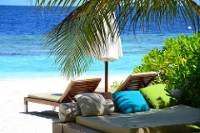
Photo credit: Simon Clancy
The private resort island in the Maldives caters to the luxury end of the market and is located in the North Malé Atoll, about 15 miles (24km) from the airport. Forty-three modern bungalows surround the lagoon, each one with a private pool along with modern comforts such as plasma TV screens and private bars.
What sets Huvafen Fushi apart as a resort is the special touches: the ocean bungalows have glass floors while the spa features the world's first underwater massage treatment rooms. The island seems to always take luxury and novelty one step further.
Shopping in Huvafen Fushi
There is a boutique at the resort selling some local arts and crafts for souvenirs and things like swimwear and sarongs for those who don't come prepared, but shopping is very limited. As with most Maldivian resorts, guests are encouraged to visit the capital if they want to go on shopping sprees.
Dining in Huvafen Fushi
Huvafen Fushi prides itself on its extensive wine cellar, making it a good choice for those who love their tipple. There are three restaurants on the island and the menus are heavily influenced by Vietnamese, Italian, Japanese and modern Asian cuisine, as well as local flavours. One of their restaurants, the aptly named Raw, serves only raw cuisine, another specialises in seafood, and the third in top quality international meals. All dietary needs are catered for.
Activities in Huvafen Fushi
This is not a party resort and the nightlife is limited to organised cultural events and live music concerts.
Things to be aware of in Huvafen Fushi
The resort has received some poor reviews for service, although nobody can fault it on luxury.
Costa Ballena
Overview
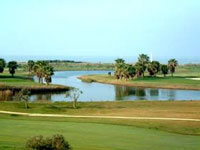
Photo credit: costadelaluz
The town itself comes pretty close to paradise and while on holiday visitors can enjoy beautiful surroundings dotted with lakes, orchards and parks, uninterrupted stretches of beach, and numerous fun activities and cultural excursions.
Shopping in Costa Ballena
Costa Ballena is not known for its shopping opportunities, but there are some boutiques and souvenir shops in the hotels and along the beachfront, and the little villages surrounding the resort - seemingly quite untouched by tourism - host craft and fresh produce markets.
Dining in Costa Ballena
The hotel restaurants, where visitors tend to eat, offer the usual international fare and are nothing to write home about. However, there are some more upmarket options and excursions into the surrounding countryside will unearth glorious vineyards and village eateries offering traditional Andalusion food and wine.
Activities in Costa Ballena
Costa Ballena is primarily a family resort and although there are some beach bars and discos the majority of nighttime entertainment is organised by the hotels and is likely to disappoint young party animals in search of a clubbing scene.
Things to be aware of in Costa Ballena
Although generally wonderful for families, Costa Ballena's lack of a pumping nightlife may discourage young singles.
Paradise Island
Overview
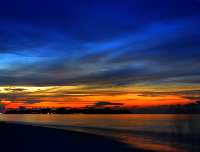
Photo credit: Ibrahim Iujaz
Shopping in Paradise Island
There are one or two shops near the reception but Paradise Island doesn't aim to be a shopping destination; the shops are sufficient to provide cameras and beach gear you may need, and some souvenirs. For a real Maldivian shopping spree hit the capital, Malé.
Dining in Paradise Island
Paradise Island has three main restaurants, a coffee shop and some bars. The dining experience is very scenic, and the chance to have a private meal in a beautiful setting shouldn't be missed. The resort is not as famed for its food as some others, but the selection is more than satisfactory and there's something for everybody.
Activities in Paradise Island
The main bar at Paradise Island has a disco dancefloor and is open 24 hours a day. The resort also hosts various forms of entertainment, featuring lots of live music and some dancing.
Things to be aware of in Paradise Island
Although it's a knock-out destination, Paradise Island is expensive and doesn't offer quite as much as some of the other luxury resorts.
Kurumba
Overview
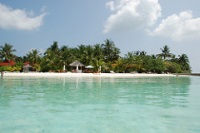
Photo credit: Abdullah Nergiz
The accommodation in Kurumba is private and secluded, consisting of luxury bungalows scattered throughout the 48-acre circular island, connected by shaded paths. The island is quiet with little in the way of nightlife, although there are seven excellent restaurants serving everything from French and Italian cuisine to Japanese, Indian and Lebanese.
Shopping in Kurumba
Kurumba doesn't have much in the way of shopping and sells only a selection of souvenirs and gifts. However, the resort's proximity to Malé, where there is plenty of shopping, makes it one of the best resorts for those itching to buy Maldivian crafts.
Dining in Kurumba
Kurumba has an impressive variety of restaurants and bars, offering more than the average resort. A whopping eight restaurants offer guests a selection of cuisines including Japanese, Italian, Indian, Tunisian, Moroccan, Chinese and, of course, Maldivian. There are also several bars and the option of ordering room service, or arranging a private romantic meal somewhere on the island.
Activities in Kurumba
This popular resort has a vibrant nightlife, organising discos, traditional dancing nights, live music concerts, karaoke evenings and much more to entertain guests keen for a party on the beach.
Things to be aware of in Kurumba
The resorts close proximity to the airport is an advantage but also means there is more ocean traffic in the area; the rooms that face away from the airport are generally quieter.
Waterville Valley
Overview
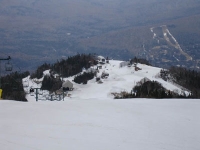
Photo credit: Jrclark
Shopping in Waterville Valley
There are some great shopping options in the Valley. Jugtown Country Store offers everything from fine wines and specialty beers to fresh produce, cheeses, and deli meats, while there is also an ice cream parlour, a toy shop (Toad Hall Toys), and a book shop (Bookmonger). There are also a few athletic shops such as White Mountain Athletic Club Pro Shop, which stock technical gear and accessories for a number of different activities. What's more is visitors can purchase some memorabilia at merchandise stores such as 1829 Outfitters and Dreams and Visions Gifts, which offer all sorts of wearable items.
Dining in Waterville Valley
There are a variety of dining options for those at Waterville Valley. All restaurants are located within walking distance from valley lodging. Visitors should ry La Tasse Cafe or the Coyote Grill, both popular choices, or the Olde Waterville Pizza Company. These are only a few of the options available to skiers of the Waterville Valley Resort.
Activities in Waterville Valley
The apres ski options in Waterville Valley will please all but the most avid partiers. A family-friendly resort, those after a night of extensive partying won't find it here. A laid back atmosphere is the order of the day.
Things to be aware of in Waterville Valley
For those interested in a range of apres-ski options, Waterville does offer a lot. However, the resort prides itself on being a family-friendly option, so it may not be the first choice for young people in search of a few great bars and a club or two.
Skiing in Waterville Valley
Waterville Valley's 52 trails cater most to intermediate skiers, so it's best that visitors know the basics if they are to make the most of the resort. However, there are some trails for true beginners, and a more limited selection of expert trails. Visitors will also find a terrain park for snowboarders and many miles of cross-country trails.
Shiga Kogen
Overview
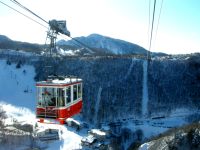
Photo credit: Meg Yamagute
One pass gives skiers access to all resorts and the free shuttle transport between them. Shiga Kogen hosted a number of events in the 1998 Nagano Winter Olympics and the facilities are good. There is an impressive variety of terrain and great snow quality.
While most of Shiga Kogen's visitors are Japanese, international visitors are beginning to discover the attractions of this ski destination, which is good for families and usually has pleasantly uncrowded slopes. There is a variety of accommodation on offer and enough bars and restaurants - both Japanese and international - to make aprés ski drinks fun and sociable.
Shopping in Shiga Kogen
You would struggle to go on a shopping spree in Shiga Kogen as the little shops and stores are spread out between the various villages and hotels and don't stock an exciting variety of goods. Visitors should be able to find all the basic goods they may need and some simple souvenirs, but that is the extent of the shopping scene.
Dining in Shiga Kogen
The variety of hotels in Shiga Kogen ensures a wide range of dining options, with plenty of both local Japanese fare and international staples for the less adventurous.
Activities in Shiga Kogen
Shiga Kogen is not known for its nightlife and the resort is not suited to young party animals, but there is a great variety of restaurants and bars and the atmosphere is pleasantly relaxed and friendly. The best nightlife in the area takes place in the hot spring resort towns of Shibu Onsen and Yudanaka Onsen. Visitors should be aware that most of the best restaurants and bars are hidden away within hotels, thus some exploration is needed to find them.
Things to be aware of in Shiga Kogen
Shiga Kogen isn't popular with Westerners, and the lack of nightlife may be a disappointment some. The villages are really a just collection of hotels, with few shops, bars or stand-alone restaurants.
Skiing in Shiga Kogen
Shiga Kogen is made up of 19 different interlinked ski areas. It offers some of the best skiing in Japan for all levels, although it's best suited for beginner and intermediate skiers, with miles of gentle cruising slopes. There are some lovely runs though the trees, but off-piste skiing is banned in most areas. The ski season in Shiga Kogen lasts from late November to early May, and night skiing is available in some areas of the resort until 9pm in good weather.
Punta Cana
Overview
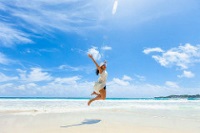
Photo credit: Trip & Travel Blog
The area has beaches and balnearios which face both the Caribbean and Atlantic, and it has been a popular tourist destination since the 1970s. The name Punta Cana refers to the cane palms in the region that has been used as roofing for centuries. Attractions in and around Punta Cana include the Manati Park, with its performing dolphins and sea lions, and an authentic replica of an ancient Taino village. Apart from the beautiful beaches, there are also plenty of activities to keep visitors busy in Punta Cana.
Shopping in Punta Cana
Punta Cana has a variety of fantastic places to go shopping. No matter what you're looking for, whether it's American-style shopping malls or authentic Dominican markets, you're sure to find it while shopping in Punta Cana. It's also important to note that in Punta Cana, many places are cash only. Even places that accept credit cards will likely give you a discount of some kind if you're willing to pay in cash.
Dining in Punta Cana
A holiday in the Dominican Republic would not be complete without a tour of its fantastic restaurants. From high-class venues run by famous chefs to establishments that focus on Asian, French or Mexican cuisine, the resort's diverse restaurants are not to be missed. There are some beatiful venues on the water and seafood is often the food of choice for visitors, since the seafood is more often than not freshly caught and excellently prepared in restaurants around Punta Cana.
Activities in Punta Cana
The Punta Cana nightlife is something truly special to behold for those who would like to see the wild side of the Dominican Republic after sunset. There is a great range of venues for all kinds of visitors, from relaxed beachside bars, to super clubs with a high-class Vegas feel, as is located in the Hard Rock Café in Punta Cana. Each night has something different going on, from shows to live music, so it is best to coordinate your nightly plans with your hotel to make the most of the events that happen in the area.
Things to be aware of in Punta Cana
Service is not always up to standard of other highly reputable resort areas and the built up feel of the resort does detract from the local flavour.
Kani
Overview
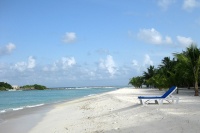
Photo credit: Leon Brocard
Shopping in Kani
There is a resort shop selling some souvenirs and things like swimwear, but those hankering for Maldivian shopping sprees will have to travel to Malé to enjoy the local markets.
Dining in Kani
Kani has two restaurants and two bars and caters well for the whole family with a good mixture of luxury and simplicity. Every day the resort ensures that some low-calorie meals are prepared for those who don't want to splurge, and all dietary needs are accommodated.
Activities in Kani
The resort is good at keeping visitors of all ages entertained, but it is not a party destination. The restaurants and bars stay open late enough for some nighttime fun and various music concerts and cultural evenings are organised.
Things to be aware of in Kani
This resort is active and can be noisy; it may not be ideal for visitors seeking peaceful and romantic seclusion.
Furano
Overview
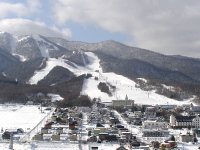
Photo credit: wakimasa
The Furano Ski Area is divided into two areas: the Kitanomine zone, open from mid-December to late March; and the Furano zone open from late November to early May. Both areas have a range of accommodation, restaurants, and après ski options, all just minutes away from the town of Furano by shuttle.
The town of Furano offers many cultural attractions, including ancient shrines and temples along with theatres, spas, shopping markets and locally-produced cheese, wine, and ice milk. Visitors should be sure to visit the town's many museums, cafes, and galleries.
Shopping in Furano
Furano is comprised of several small farming towns around a municipal centre. The region is known for its picturesque lavender fields and vineyards as well as for its powdery snow, and visitors can enjoy an array of locally-produced goods like wine, carrot juice, and cheese.
There are a number of hotel shops and grocery stores selling this produce but the best place to go shopping for souvenirs in Furano is Ningle Terrace where you can find a charming collection of craft shops in small log huts. Here you will find local artists, glass makers, and jewellery crafters.
Dining in Furano
There is a wide variety of eating out options in Furano, with a few restaurants a short stumble from the slopes and many different restaurants in town. There are plenty of great sushi restaurants, many eateries selling simple international staples, French, Italian, and Chinese restaurants, and a number of pubs and karaoke bars to keep holidaymakers entertained.
Activities in Furano
Although there is not much of a clubbing scene, Furano has plenty of bars, pubs, and restaurants which promise visitors a spot of night-time revelry. The Furano Tourism Association is very proactive and often organise a number of interesting cultural events, such as traditional Japanese music performances, which are usually free of charge and allow tourists to interact with locals and enjoy Japanese culture. There are also theatres and art galleries to be investigated.
Things to be aware of in Furano
There have been some complaints about groups of foreigners becoming too rowdy on the slopes.
Skiing in Furano
The slopes in the Furano Ski Area offer good skiing opportunities for all levels. The slopes are divided in to two zones: The Furano zone and the Kitanomine zone. There is a family ski area at the base of the Furano zone, and first timers are warned that there are no beginner courses from the top of the Kitanomine Gondola. The Furano Ski School is located at the base of the Kitanomine zone.
Arenal d'en Castell
Overview
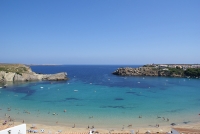
Photo credit: Farid Fleifel
Shopping in Arenal d'en Castell
Arenal has a small commercial centre with a few decent supermarkets and gift shops, but it is no shopper's paradise. Neighbouring Es Mercadal has a lovely Sunday market worth exploring while on holiday. Visitors should be able to find everything they need in the way of basic supplies and souvenirs, but designer stores are thin on the ground.
Dining in Arenal d'en Castell
Arenal has a good selection of restaurants, including pizzerias, pubs and seafood restaurants, and a variety of budgets are catered for. There are a number of bars and restaurants along the beachfront, and a snack bar towards the eastern end of the beach which is ideal for sundowners.
Activities in Arenal d'en Castell
Arenal d'en Castell is not a nightlife hub and there are no nightclubs; however, there are some fun bars which stay open until late in the summer months, and many of the hotels offer nighttime entertainment.
Things to be aware of in Arenal d'en Castell
The lack of a party scene may disappoint those in search of a vibrant nightlife.
Las Caletillas
Overview
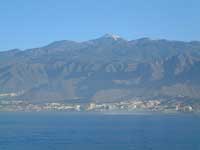
Photo credit:
Playa de Las Teresitas, just up the coast from Las Caletillas, provides a change of scenery and golden sandy beaches for those who aren't quite comfortable sunning themselves on the remnants of a volcanic eruption. Of course, the bustling Santa Cruz is close by and if one hires a car, there are various areas of interest to explore on this part of Tenerife, such as the small town of Masca, the historic village of La Laguna with its market and attractive cathedral, or La Orotava (boasting an embroidery school). A great day out is a trip to the Teide National Park where visitors can enjoy a cable car ride up Spain's highest mountain, the volcanic Mount Teide. Although it may not be a hotspot, Las Caletillas is the perfect holiday destination in Spain for those seeking a more authentic Canaries experience and a truly relaxing Tenerife getaway.
Shopping in Las Caletillas
Las Caletillas is a perfectly self-contained resort with just the amount of shops tourists might need for basics and souvenirs and the like. There is a supermarket for self-catering supplies. However, those who want a more comprehensive shopping experience should venture into the neighbouring village or make the short drive to Santa Cruz.
Dining in Las Caletillas
There are a handful of bars and restaurants at the resort itself, with a notable, and natural, emphasis on seafood. There is more choice in restaurants in Candelaria and of course a broad selection in Santa Cruz.
Activities in Las Caletillas
Las Caletillas has some wonderful spots for sundowners and a few drinks while listening to gentle live music, but it is not a party resort and there are no real nightclubs. Tourists won't have to go far to find a vibrant nightlife though, and can venture into Candelaria, to Playa de las Teresitas, or into Santa Cruz for more energetic entertainment after dark.
Things to be aware of in Las Caletillas
The sea can get a bit rough and the pebbly beach will not be to everybody's taste.
Les Deux Alpes
Overview
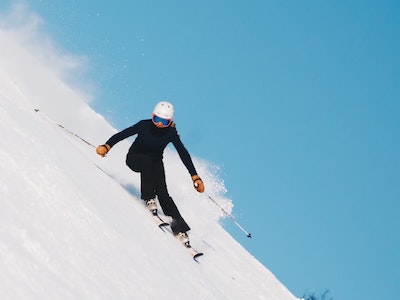
Photo credit: Nicolai Berntsen
Shopping in Les Deux Alpes
The resort offers a range of stores for those looking for the latest ski fashion and local souvenirs. For those who are self-catering, there are a few supermarkets, as well as a selection of boulangeries and patisseries.
Dining in Les Deux Alpes
Les Deux Alpes has a wide choice of reasonably priced family-owned restaurants serving everything from rustic wood-fired pizzas to fondues and other mountain specialities. Those prepared to splash out on a gastronomic treat can book at table the Michelin-starred Le P'tit Polyte in the Chalet Mounier. There's also a selection of mountain restaurants, including Le Diable Au Coeur, with its spectacular mountain views and gourmet cuisine.
Activities in Les Deux Alpes
Les Deux Alpes has a lively apres-ski scene, with a variety of bars, pubs, and nightclubs. Pano Bar is one of the most lively apres-ski venue, it is situated at the mid-station of the Jandri Express and offers live music and entertainment every afternoon. Le Saloon is also a popular apres-ski spots, along with The Windsor Pub and Smithy's Tavern. L'Avalanche is probably the most popular nightclub in the resort, for those looking to carry on partying after the bars have shut.
Things to be aware of in Les Deux Alpes
Les Duex Alpes is not a pretty resort and is dominated by purpose-built apartment blocks and hotels. Advanced and intermediate skiers may find the skiing limited, and beginners won't enjoy the busy and icy slopes down to the resort and are advised to take a lift down. Few properties are ski-in, ski-out.
Skiing in Les Deux Alpes
Les Deux Alpes has over 200km of ski slopes, suitable for all levels of skiers and snowboarders, but it is particularly popular with families and beginners due to the many gentle blue slopes on the Glacier du Mont de Lans, the largest skiable glacier in Europe. The resort is known as being 'upside down' as the easiest runs are found higher up the mountain while the harder slopes run down to the village. There are a handful of red and black slopes, and the surrounding area also offers amazing off-piste opportunities.
News about
- This Is the New Way to Cruise the Mediterranean
-
Lunching on fresh fish and sipping ice-cold rosé in a cove where private yachts anchor to play in the turquoise waters off of Sardinia, it was hard to believe I was traveling on a sister ship to the one that took me through the notoriously rough Drake Passage and a blizzard with
- Getting Around Sardinia, Italy
-
Despite being the Mediterranean's second largest island, Sardinia is relatively compact, measuring roughly 300km (186mi) north-to-south and 125km (78mi) east-to-west. You can cross the entire island in a few hours, though sinuous two-lane roads and limited rail and bus connections can make short distances more time-consuming to cover than you might expect. Traveling with your own car
- Sardinia's mysterious beehive towers
-
Expecting not to find much more than a pile of big stones, I followed the sign off the motorway into a little car park and there it was, rising from a flat, green landscape covered in little white flowers, with a few donkeys dotted around: Nuraghe Losa. From
- This region in northern Italy wants to pay you to visit—here’s what to know
-
If collecting $15,000 to up and move to Sardinia is too much of a commitment right now, why not get paid to just travel to one of the most beautiful regions in Italy instead? Friuli-Venezia Giulia, in the far northeast of the country, is covering transportation costs to the
- Introducing city kids to nature in the hinterlands of Sardinia
-
For many people around the world, Sardinia is synonymous with spiagge, the powdery beaches on the Emerald Coast. First developed in the 1960s, this glitzy destination in the island’s northeast
- Special Luxury Hotels In Italy To Know About For 2022
-
These family-owned luxury properties, ranging from the Alps to Amalfi and Sardinia, part of the newly expanded Autentico collection, want to help you have an unforgettable stay.
- Inside the Glamorous Italian Hotel Where Sports Stars Celebrate Championships in Private Pool Villas
-
Italy's Manuel Locatelli just celebrated his Euro Cup victory at Sardinia's Hotel Pitrizza, but he wasn't the first star to choose the ultra-private luxury villas for a special getaway
- 9 Once-in-a-lifetime Trips to Book for 2022
-
2022 is the year of the bucket-list vacation, from the beaches of Sardinia to the restaurants of Kyoto
- Italy penalizes tourists who remove sand and shells from the beaches of Sardinia
-
More than 40 tourists have to shell out fines totaling nearly $3,650 for removing beach sand and shells from the Italian island of Sardinia
- Airline resumes flights to Italy (but turns around when airport's shut)
-
We're all pretty excited about being able to travel again -- but German airline Eurowings might be more eager than most. The low-cost carrier resumed services from Düsseldorf to Sardinia, Italy, on Saturday -- but was forced to turn around at its destination because Olbia Airport is
- Porsche drivers stuck after Google Maps error
-
Unspoilt beaches at the foot of steep cliffs, romantic winding roads, and plenty of mountain wilderness -- Italy's Mediterranean island of Sardinia has it all. But some tourists are finding the combination a little too difficult to take. Authorities in Baunei, in Sardinia's eastern province of Ogliastra, have launched an appeal to visitors, telling them not to rely on Google Maps to get around the area
- This Historic, Greek Island Wants to Pay Young Families to Live and Work There
-
A lot of people have fantasized about running away to an idyllic island, but very few actually get the opportunity. Until now, that is. According to the Los Angeles Times, the Greek island of Antikythera is looking for new residents to come live on its beautiful and historic shores. Much like the various towns in Italy, Sicily, and Sardinia that have launched special programs to
- Cycling Tours, Once for the Hard-Core, Now Offer E-bikes
-
On a cycling tour along the coast of southwest Sardinia, Kathleen Robinson thanked God she was riding an electric bike up the winding heights. But she wished she’d had a class beforehand on the proper etiquette. She didn’t realize that the hum of her motor would annoy some of the traditional cyclists on the tour, a nor was she certain whether to spin in the
- Italy Is Offering a Massive Tax Break to Retirees Who Move to Sicily, Sardinia or Calabria
-
The project aims to repopulate rapidly declining regions. If you’d prefer to put your IRA toward limoncello and a charming Italian casa di campagna rather than taxes, you might be in luck
- Seven Poor Decisions We Only Make on Holiday
-
You’re on holiday. Your defenses and standards are down. Thus, in the name of entertainment, are you prey to Sardinian folk troupes, museums of latticework and alcoholic drinks which turn out blue. You’d never fall for these at home.
- The Secret to Cheap(ish) Sardinia
-
Picture the Aga Khan, anchored between Corsica and Sardinia in his luxury yacht.
He stands on deck, beguiled by the emerald waters that would give the Costa Smeralda its name and thinks: “Here is where I will build my resort.”
Thusly; tourism to Sardinia was born.
- Air Italy: Sardinia's Meridiana Aims to Become Italy's New National Airline
-
The new Air Italy, which is part-owned by Qatar Airways, aims to replace Alitalia, the bankrupt flag carrier that is in the process of being auctioned off in parts to other European airlines
- The secret behind Italy's rarest pasta
-
It's so difficult and time-consuming to prepare, that for 300 years only the women of a single Sardinian family knew how to make it
- The 10 best beach holidays in Italy
-
Our experts' pick of the top 10 beach and seaside holidays in Italy for 2015, including the best spots for families, watersports and relaxation, in destinations such as Sicily, Tuscany, Sardinia, Puglia and Ischia
- In Sardinia, an Affordable Family-Run Farm Stay
-
The farm and guesthouse Agriturismo La Sorgente provided a glimpse into Sardinia’s rural past and still rural present
- A Tour of Sardinia, Full of Discoveries
-
The Frugal Traveler finds hospitality hiding everywhere in the island’s rugged landscape
- The 20 best Mediterranean islands
-
The best Mediterranean islands for family, luxury, beach, culture, walking and romantic holidays, with information on resorts and hotels in Sardinia, Santorini, Crete, Cyprus and Ibiza
- Sardinia: An island of mad dogs and playboys
-
As new flights begin to northern Sardinia, David Ryan discovers how the other 2 per cent live on this beautiful outpost
- Cagliari: Take a cultural break from the beach
-
Sardinia may be blessed with a pristine white-sand coastline but, says Sarah Barrell, lingering in its lively capital – rich with Phoenician ruins and colourful street art – will leave you feeling just as blissful
